Early Views of Santa Monica
Historical Photos of Early Santa Monica |
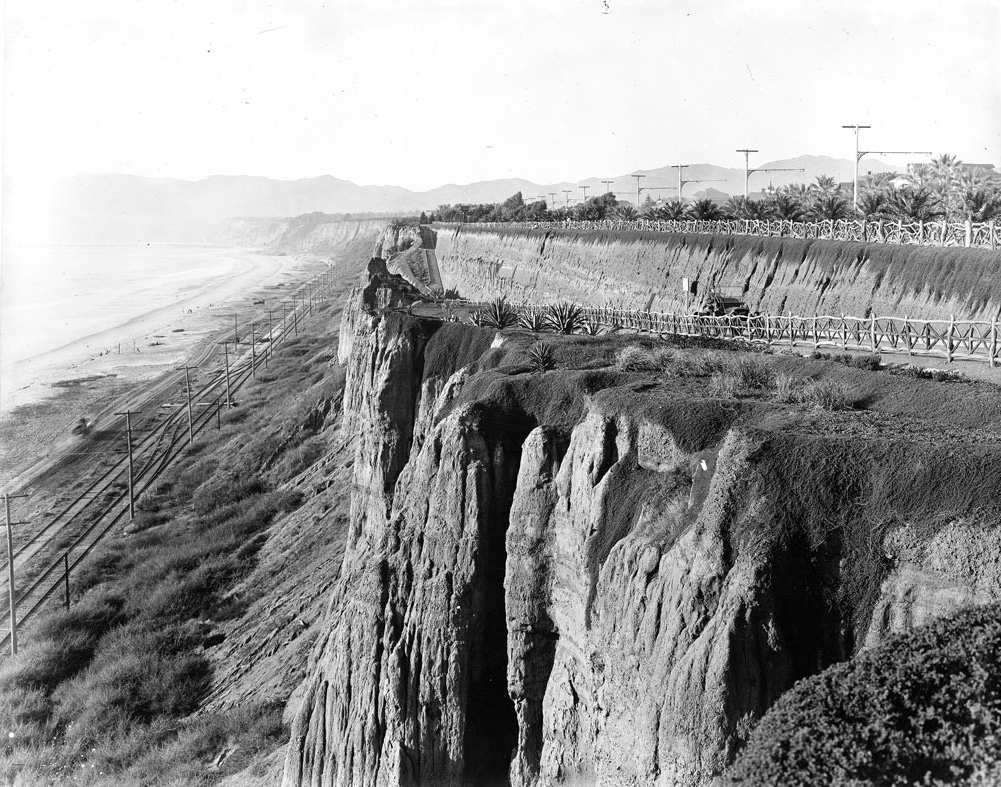 |
|
| (ca. 1905)* - View of the Santa Monica shoreline from Palisades Park. The tracks of the Los Angeles & Independence R.R. run where Pacific Coast Highway is today. To the right, a motorcar ascends an early version of the California Incline. |
Historical Notes Footpaths like the Sunset Trail and stairways like the 99 Steps preceded it, but the California Incline was the first automobile shortcut over Santa Monica’s ocean bluffs. When it opened around 1905, the bluff top was still called Linda Vista Park and the new dirt road down the cliff was known as Linda Vista Drive. It was one of three planned inclines designed by City Engineer Thomas H. James to improve access from the park to the beach. At the base of the bluffs the Los Angeles and Independence Railroad tracks and Beach Road run where Pacific Coast Highway sits today, carrying passengers and freight north to the Southern Pacific Long Wharf. This view shows how the first California Incline quickly became the main shortcut between Ocean Avenue and the shoreline just as Santa Monica was beginning to adapt its landscape to the age of the automobile. |
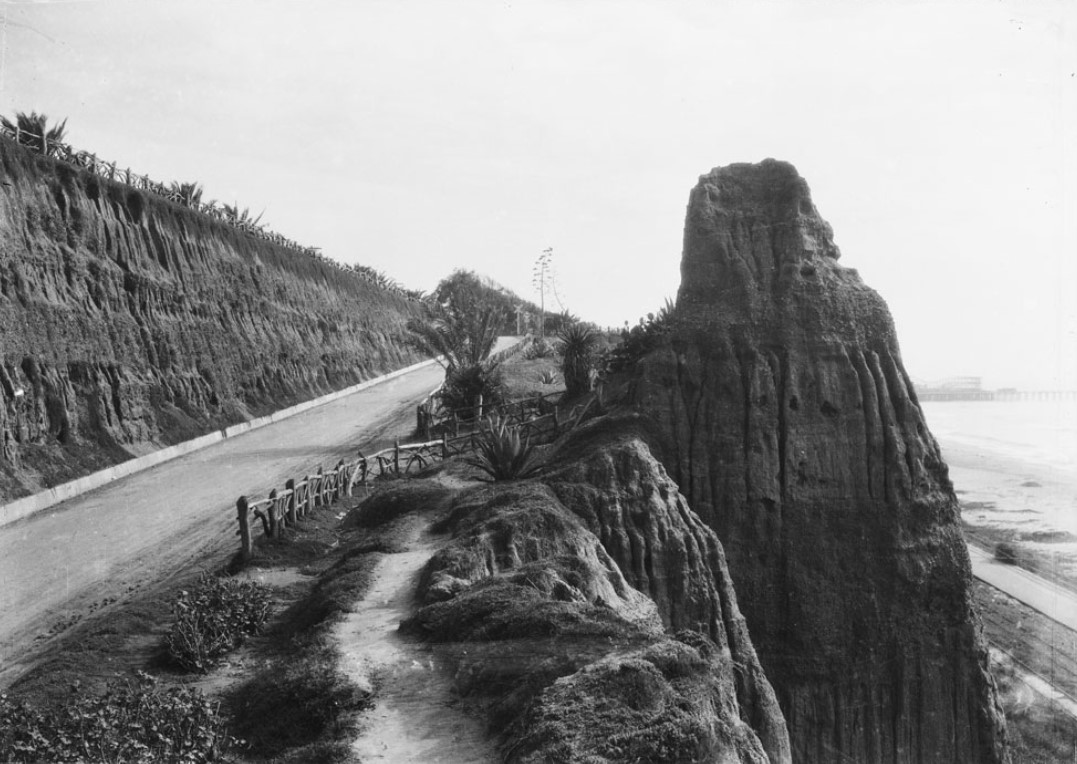 |
|
| (ca. 1905)* - Early view looking up the California Incline leading from the coast highway to the palisades. There is a walking path to the right of the road. |
Historical Notes In this early view the California Incline is still an unpaved dirt road cut straight into the face of the bluff. A simple walking path on the right gives pedestrians their own route up the grade while wagons and the first motorcars share the narrow roadway. The rustic railings at the top edge of the cliff were part of the city’s first efforts to make Linda Vista Park safer while still allowing visitors to walk right to the brink for a full view of the ocean. The image captures the moment when Santa Monica’s seaside resort town began to reshape its steep shoreline for regular traffic rather than only for recreation. |
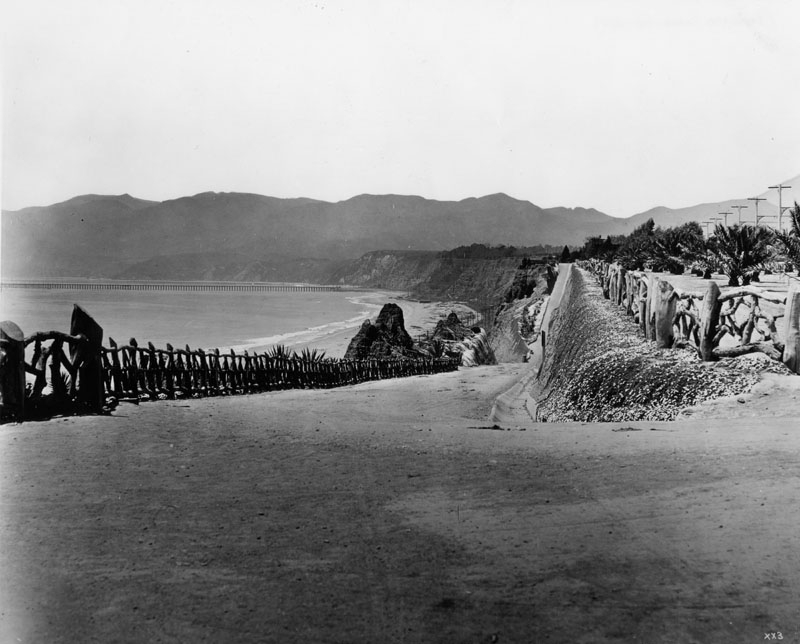 |
|
| (ca. 1905)* - View shows a wooden fence along an unpaved California Incline with the Long Wharf seen in the background. The Santa Monica mountains are in the distance. Linda Vista Park (later Palisades Park) is on the right. |
Historical Notes The rough post-and-rail fence along the edge of the incline is the signature look of early Linda Vista Park, later renamed Palisades Park. Senator John P. Jones and the Santa Monica Land and Water Company had donated this bluff-top land to the city in the 1890s so it could remain a public promenade above the sea. Far out in the water stands the Southern Pacific Long Wharf, at that time advertised as the longest wharf in the world at more than four thousand seven hundred feet, serving as Port Los Angeles before San Pedro Harbor was chosen as the region’s main port. The view reminds us that the California Incline originally connected not just to a local beach road but to a deep-water port that briefly competed to be Los Angeles’s primary harbor. |
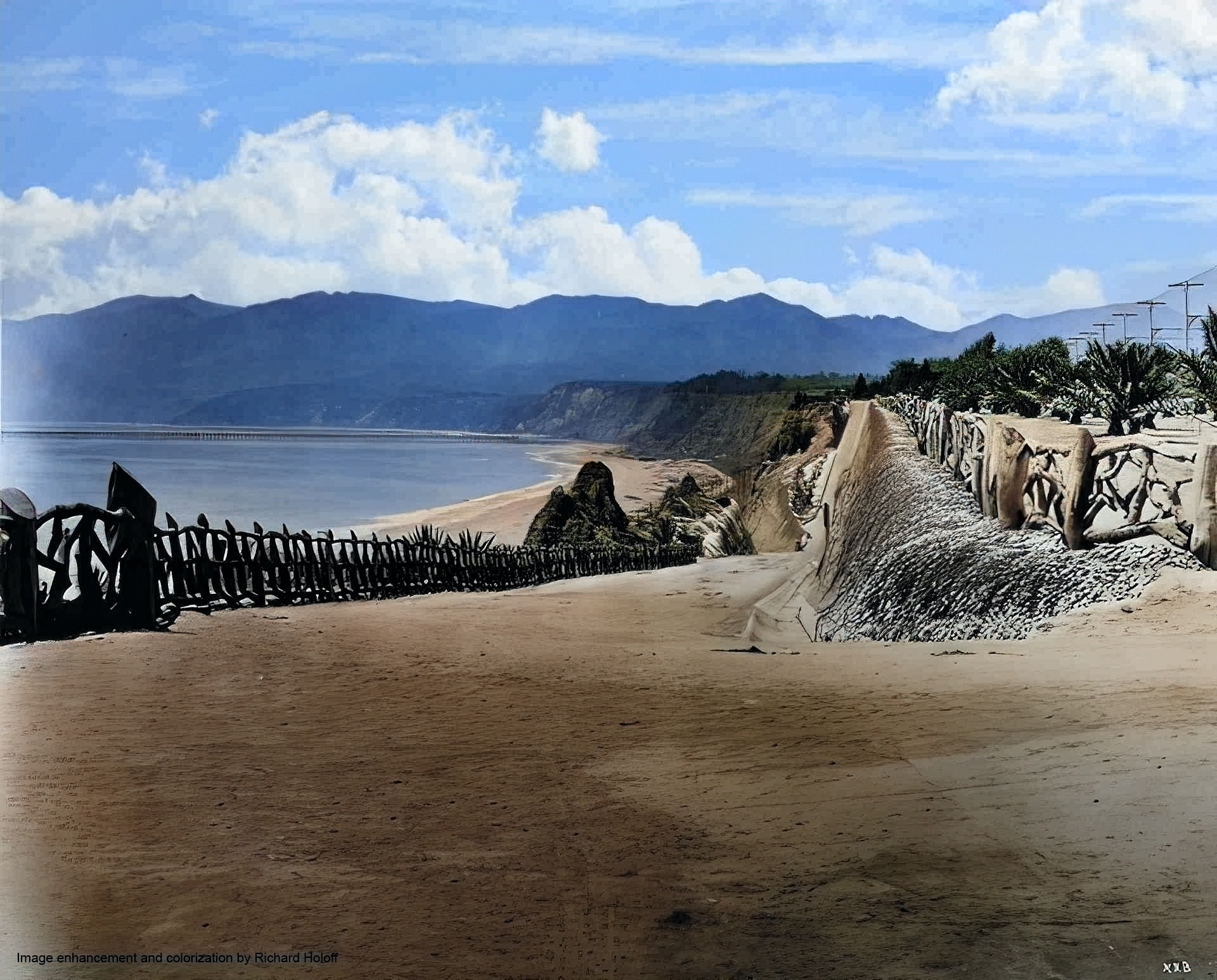 |
|
| (ca. 1905)* - View shows a wooden fence along an unpaved California Incline with the Long Wharf seen in the background. The Santa Monica mountains are in the distance. Linda Vista Park (later Palisades Park) is on the right. Image enhanced and colorized by Richard Holoff. |
Historical Notes This colorized version is based on the original black-and-white photograph of the unpaved incline and rustic fence with the Long Wharf in the distance. While the added color helps modern viewers imagine the tones of the sandstone bluffs, the green plantings in the park, and the blue of the Pacific, the underlying scene is the same early automobile era Santa Monica. It shows how quickly the city embraced the dramatic setting of its bluffs by framing the new road with hand-built fencing and plantings rather than heavy masonry, keeping the landscape informal even as it was being engineered. |
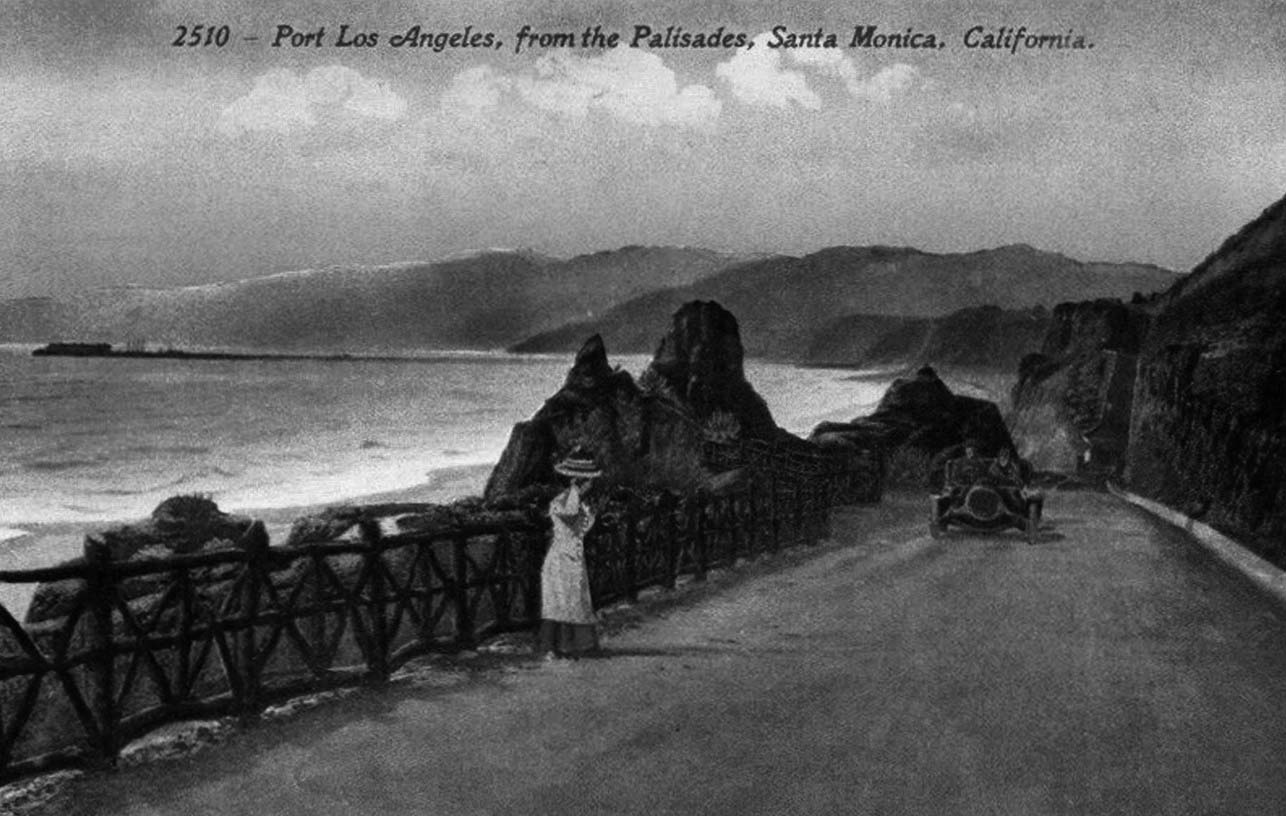 |
|
| (ca. 1910)* – Postcard view showing a woman standing on the California Incline watching a car as it makes its way up the grade. The Long Wharf can be seen in the background. |
Historical Notes By about 1910 automobiles were a regular sight on the California Incline, sharing the grade with horse-drawn vehicles and pedestrians. The woman standing at the edge of the road illustrates how the incline itself became a vantage point, offering sweeping views of the bay and of the Long Wharf still jutting into the ocean to the north. The wharf, completed in the 1890s for the Southern Pacific Railroad, was already losing its role as a major port after San Pedro was selected as the official harbor, but it remained a dramatic feature of the skyline for visitors driving or walking the incline. |
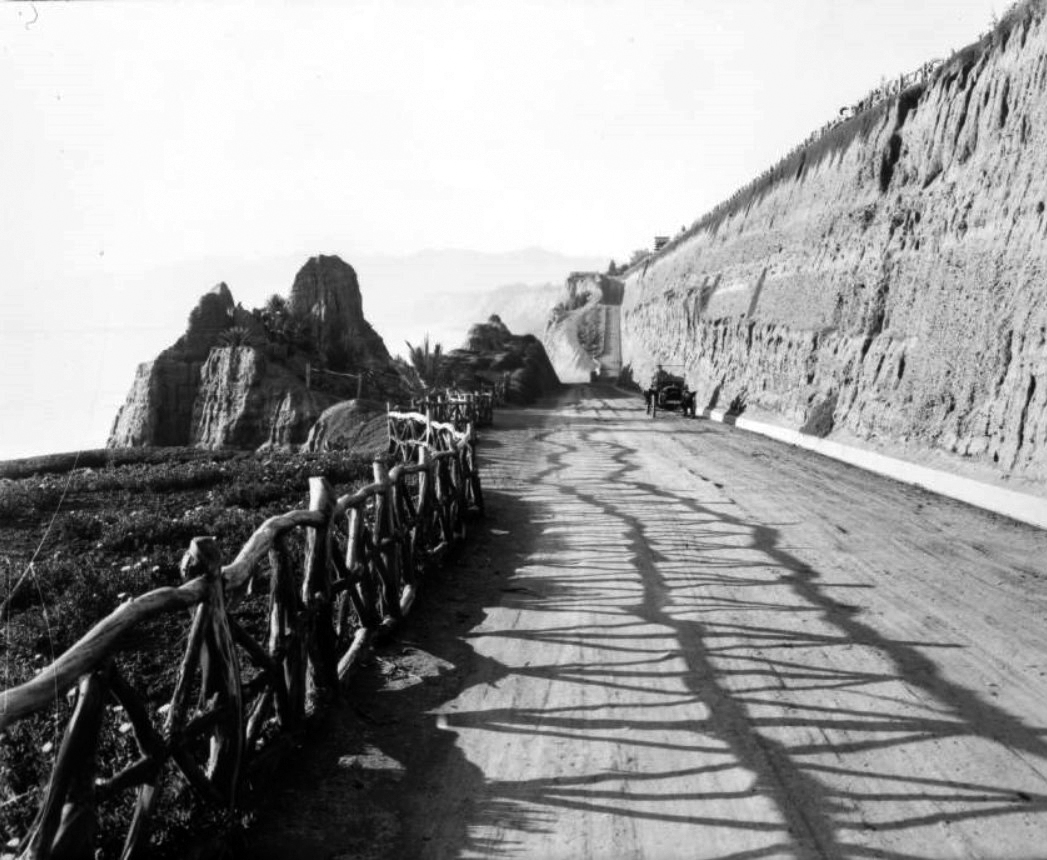 |
|
| (1910s)* – View showing an automobile driving south up the California Incline in Santa Monica. The rustic fence is on the left, and the bluffs on the right. Note the pedestrian trail at center-top. |
Historical Notes This view shows how the California Incline looked after a few years of regular use. The dirt surface is more defined, the rustic fence along the outer edge continues the style of Palisades Park above, and an automobile climbs the grade with the high bluffs rising on the inside. Above the road, a separate pedestrian trail can be seen cutting across the slope, giving walkers their own route between park and beach. Together these features show how Santa Monica tried to balance early car traffic with pedestrian access long before modern ideas about complete streets and shared corridors. |
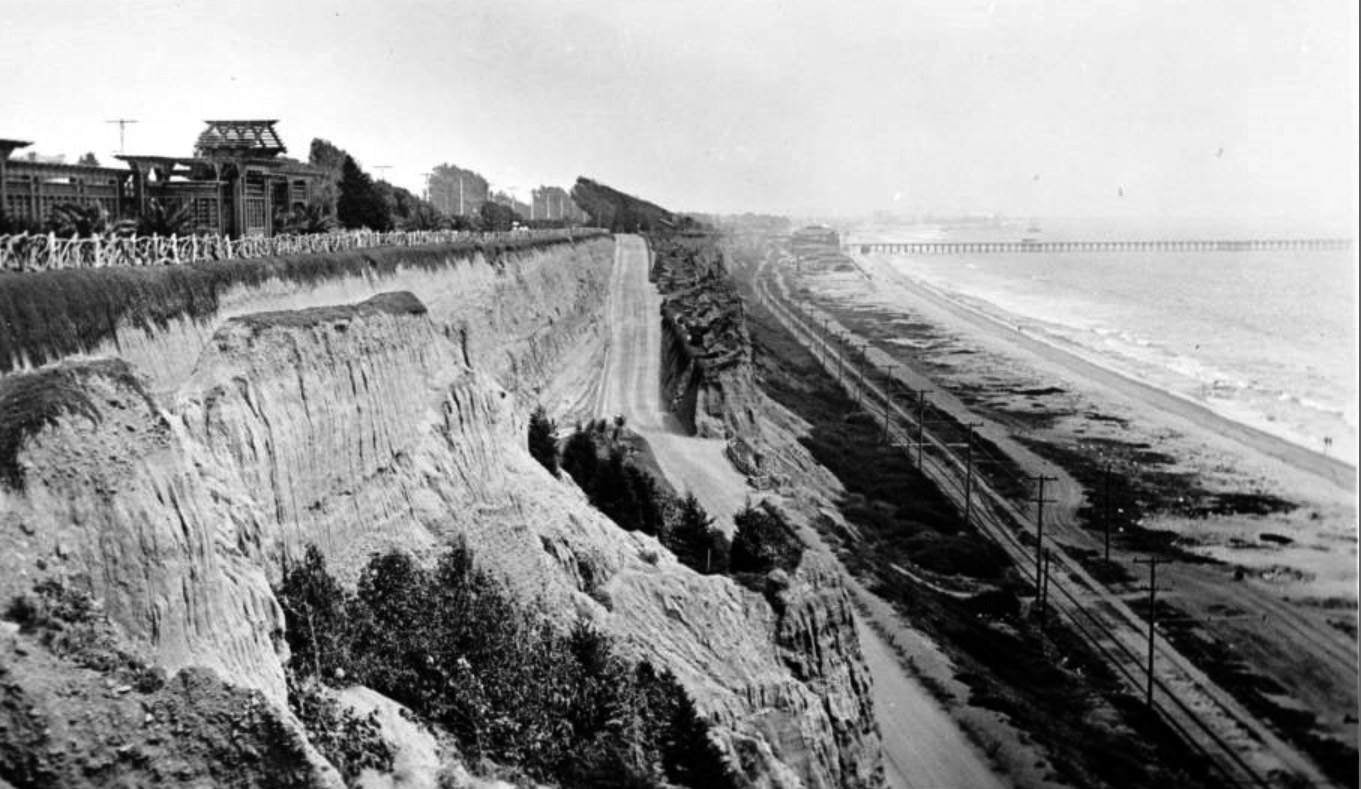 |
|
| (ca.1910)* - View showing the Santa Monica coastline, looking south from Linda Vista Park (later Palisades Park). The palisades are at left and are a line of steep, rocky cliffs. A twisted wood fence runs along the top edge of the cliff, and several wooden structures can be seen beyond the fence. A wide unpaved road runs up the face of the cliffs at center. At right, the ocean is visible. A set of railroad tracks and Beach Road (later Roosevelt Highway and the Pacific Coast Highway) can be seen at center, running parallel to the shoreline down to where Santa Monica Municipal Pier (1909) juts out into the water. |
Historical Notes From the bluff top the new road down the cliff stands out as a wide diagonal cut, while Beach Road and the Southern Pacific tracks trace the shoreline below toward the newly built Santa Monica Municipal Pier of 1909. This image makes clear how the California Incline was part of a layered system of movement: trains and wagons on the beach road, pedestrians and carriages on the pier, and people strolling behind the twisted wooden fence along the edge of Linda Vista Park. The view south also hints at the rapid growth that would soon fill the beachfront with bathhouses, beach clubs, and amusement piers at Ocean Park. |
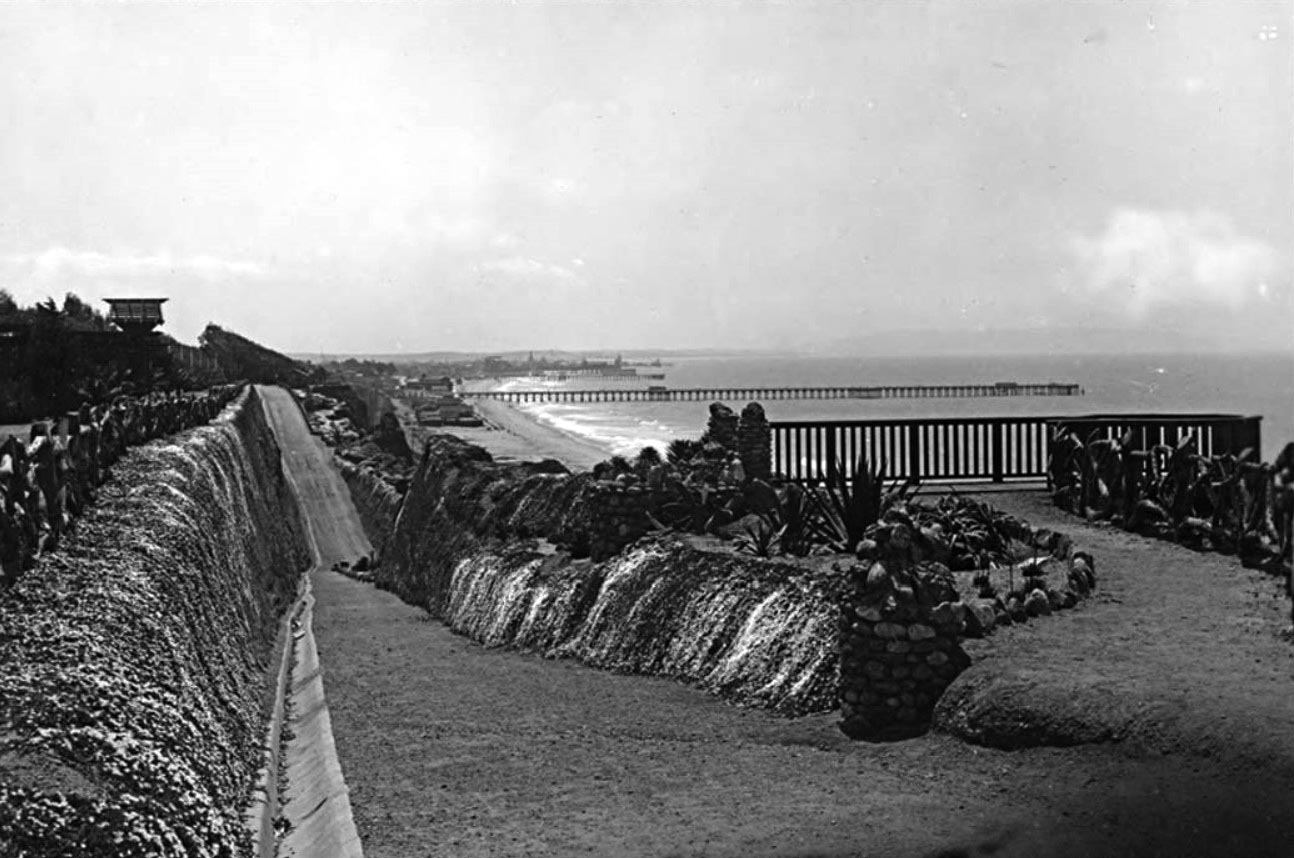 |
|
| (1910s)^ - View from Palisades Park looking down a pedestrian trail that intersects the California Incline road, with the beach, and Santa Monica Pier and Ocean Park amusement piers in the background. Note the observation deck at right. |
Historical Notes Here the focus shifts from the roadway to the people using the bluffs themselves. A narrow pedestrian trail descends from Palisades Park and meets the California Incline, giving walkers a direct route down to the sand. In the distance the Santa Monica Pier and the busy amusement piers of Ocean Park line the horizon, showing how popular the shoreline had become as a regional playground. The small observation deck along the trail is another reminder that the bluffs were treated as a scenic overlook as much as a transportation corridor. |
 |
|
| (ca. 1905)* - View looking down the California Incline road in Santa Monica towards the beach and railroad tracks. The Southern Pacific Railroad ran steam engines along these tracks between Los Angeles and the Long Wharf (seen in distance at left). A few telephone poles can also be seen, as well as the wagon trail that ran alongside the railroad tracks. |
Historical Notes Seen from partway up the grade, the California Incline drops onto Beach Road, where a set of Southern Pacific tracks runs toward the Long Wharf. At this date steam trains still served both the wharf and passenger stations along the bay, while wagons used the dirt track beside the rails. The telephone and telegraph poles that line the right side of the image show how fast communication technology arrived at the shore, even before the road itself was paved. The photograph captures a transitional moment when heavy rail, wagons, and the first automobiles all converged at the foot of the same cliff. |
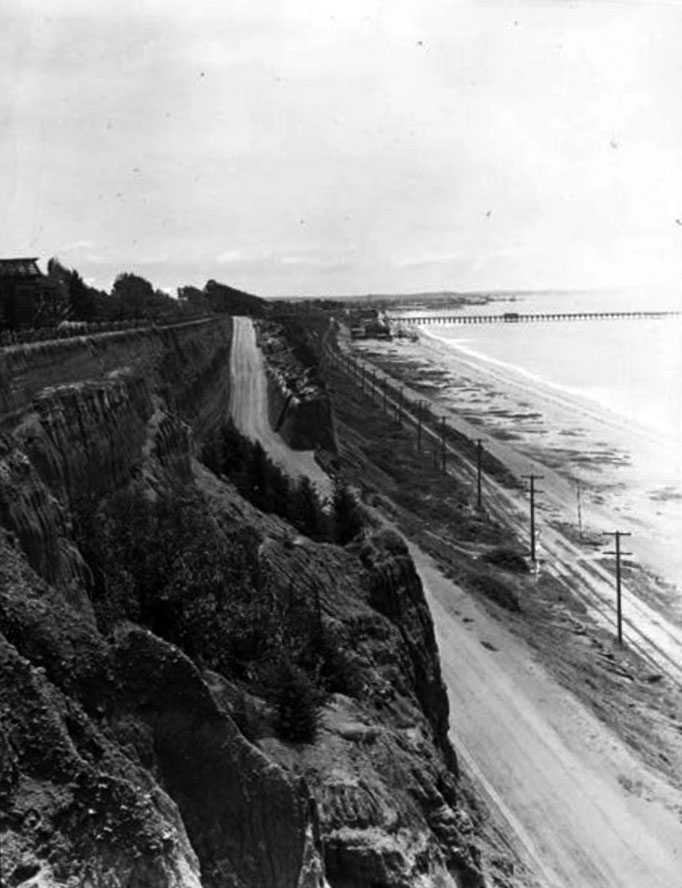 |
|
| (ca. 1910)^ - View looking south at the California Incline road coming down from the bluffs to the beach, in Santa Monica. The Santa Monica Municipal Pier (1909) is in the distance. Railroad tracks can be seen running along the beach road below. |
Historical Notes Looking south, the California Incline appears as a straight ribbon descending to the beach where trains and vehicles travel along the coast road. The Santa Monica Municipal Pier, opened in 1909, is visible in the distance with its early utility-pier structure later joined by pleasure piers and amusement attractions. This image helps place the incline within the larger geography of the bay, showing how it funneled traffic not only to the open beach but also directly toward the growing entertainment district around the pier. |
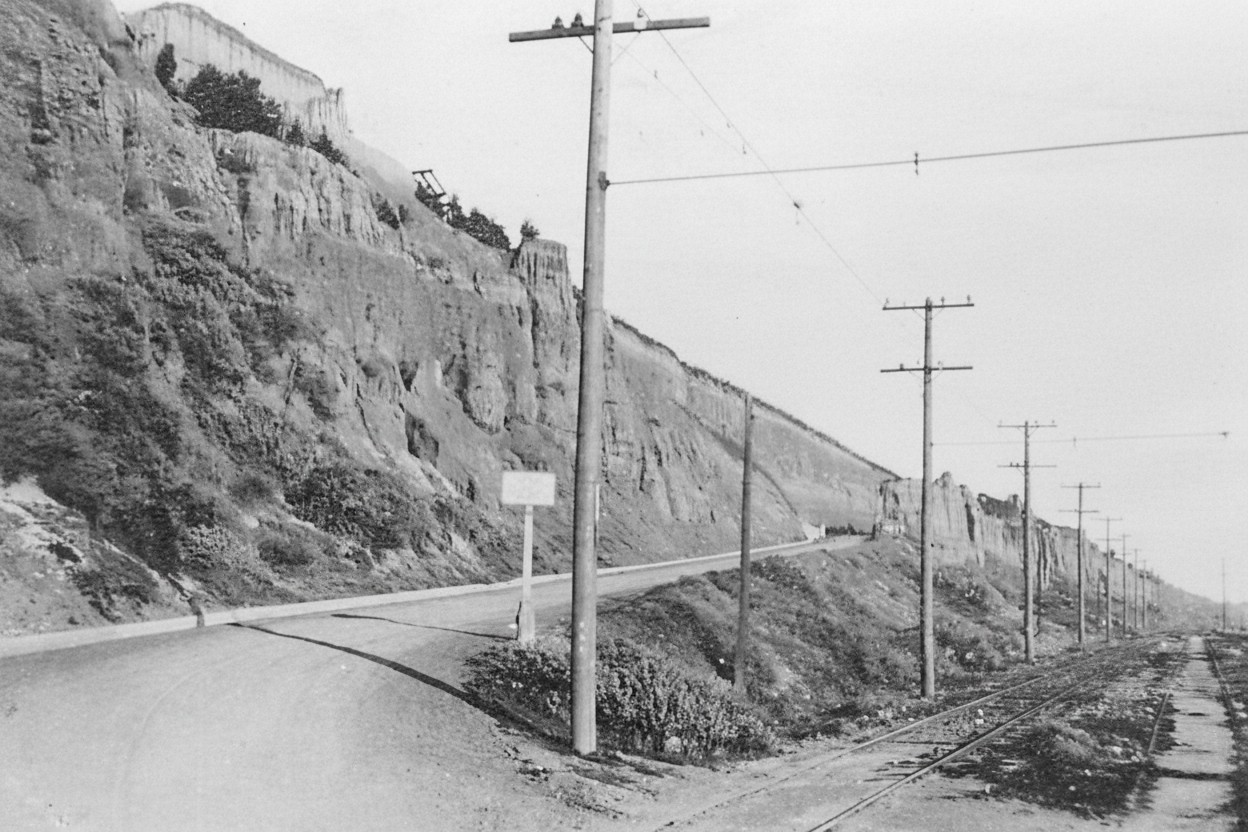 |
|
| (1912)* – View looking up the California Incline from near the tracks along the beach. |
Historical Notes By 1912 the California Incline had become a well used route cut into the steep sandstone face of the Palisades. Seen from track level at the bottom, the grade looks imposing and shows the challenge of building a dependable road on unstable coastal bluffs. Utility poles and wires run along the railroad and beach road at the foot of the cliffs, while the incline above remains simple and unpaved, with only scattered plantings and no retaining walls or concrete curbs. This early simplicity helps explain why later decades brought repeated projects to strengthen the bluffs and widen the roadway as traffic and erosion increased. |
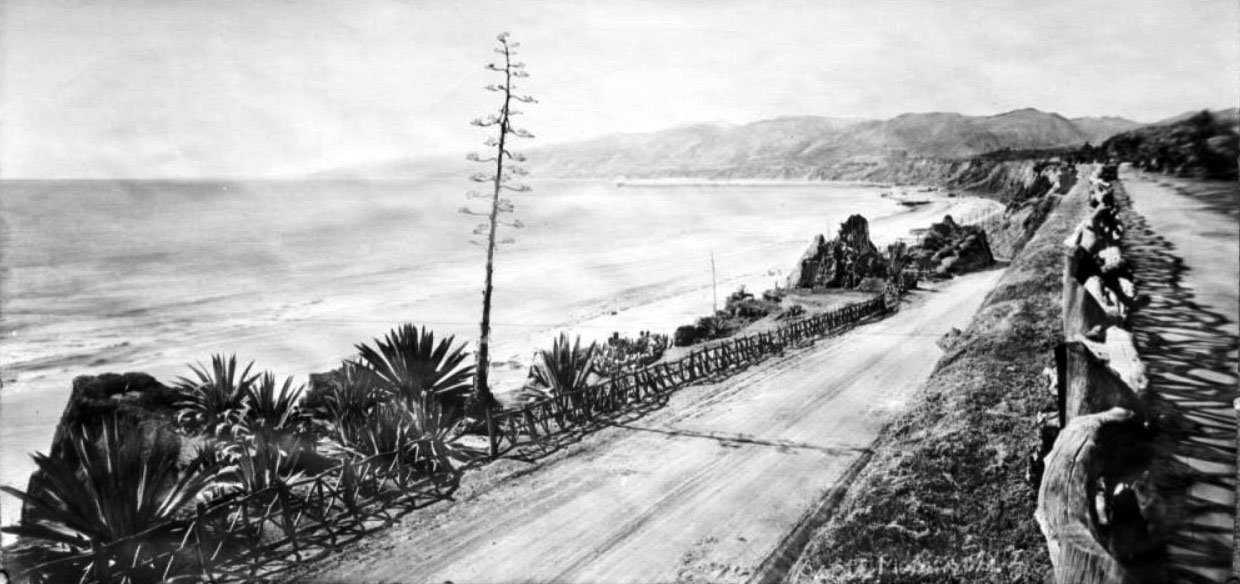 |
|
| (ca. 1913)* - Panoramic view of Santa Monica Beach looking north from the California Street incline. The ocean and shore are visible to the left, down from the cliff along which a paved road runs, lined to either side by a post-and-rail fence made from rough-cut branches. A second, higher road stands directly next to the first, at the right. Mountains are visible stretching out into the water in the background. Plants that appear to have been put there rather than growing naturally stand along the left side of the road. |
Historical Notes In this panorama a paved road hugs the base of the bluffs while a second, higher road runs alongside it, both lined with the characteristic rough-cut post and rail fence. Newly planted shrubs and trees soften the edge between road and cliff, part of a broader city effort to landscape the route for visitors arriving by carriage or car. The mountains angling into the sea remind viewers that this was still the edge of the Santa Monica Mountains, not yet hidden by dense development. Together the two roads show how the area around the incline was evolving into a scenic drive as well as a practical connection between the city grid and the coast highway. |
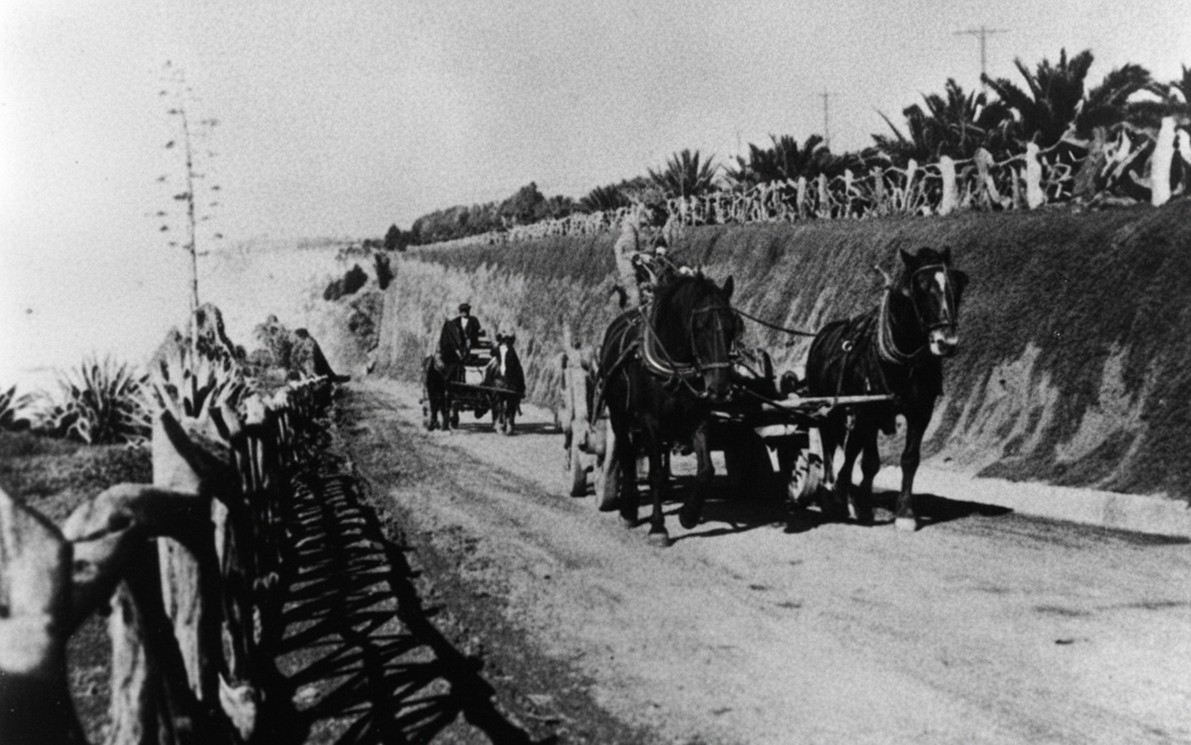 |
|
| (1915)* – View of two horse-drawn wagons hauling freight up the California Incline. |
Historical Notes Even as automobiles became more common, freight in Santa Monica still often moved by horse and wagon. This 1915 scene shows two heavily loaded wagons grinding their way up the California Incline, using the new shortcut to reach the commercial streets at the top of the bluffs. The combination of animal power, early road engineering, and the dramatic setting conveys how recent the shift from farm and ranch economy to beach town really was. It also illustrates why the city soon had to improve the road surface and width: the incline was carrying everything from beachgoers to building materials. |
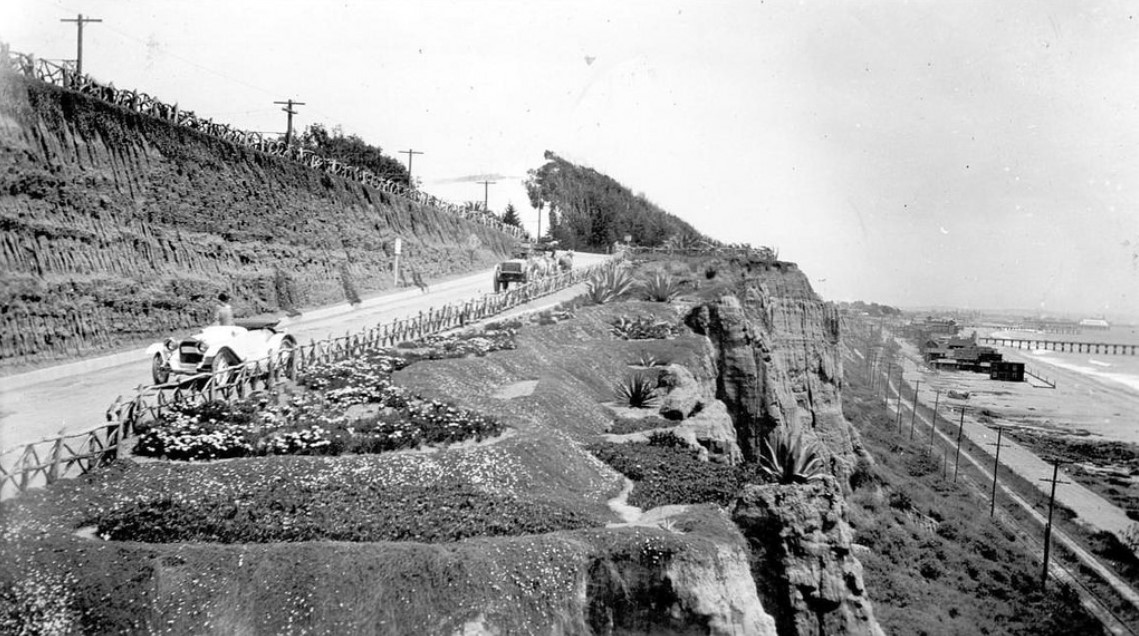 |
|
| (1916)* – Photo of the California Incline showing a man next to an early model convertible taking on the view of the beach and ocean below. Also seen is a horse-drawn wagon making its way up the incline. LA Times Photo Archives |
Historical Notes Here a man stands beside an open touring car to admire the sweeping view of the ocean while a horse-drawn wagon labors up the incline behind him. The photograph was taken only a few years after the Santa Monica Municipal Pier opened and the same year the Looff Hippodrome carousel building was completed on the adjacent pleasure pier. The scene sums up a moment when Santa Monica marketed itself as both a modern motor destination and a traditional seaside resort, with the California Incline as a scenic driveway between city and shore. |
 |
|
| (1910s)^ – Postcard view looking down the California Avenue Incline with the Long Wharf (1893 – 1920) seen in the distance. A man, a woman, and a child are posing for the camera at left. On the right, two people with ‘cool’ looking hats are standing behind the rustic wood fence at Linda Vista Park, which by 1920 was known as Palisades Park. |
Historical Notes This postcard view, posed with figures at the fence, was aimed at tourists who wanted a souvenir of the dramatic drop from Linda Vista Park to the beach. The road appears well worn by this time, and the rustic fence has become part of the visual identity of the park. The Long Wharf can still be seen far to the north, though by the late 1910s its days as an active cargo pier were nearly over and sections were already being removed. Images like this helped fix the relationship between city, bluffs, and wharf in the public imagination just as the port itself was fading from use. |
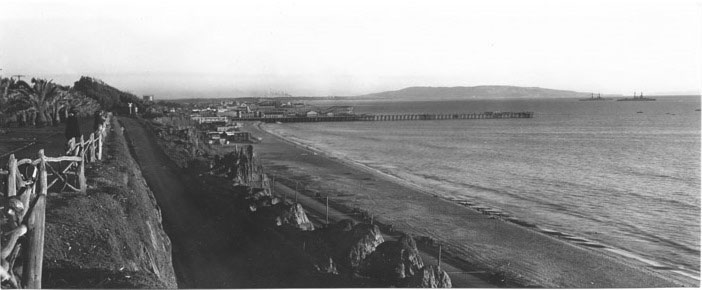 |
|
| (ca. 1920)^^ - Panoramic view shows two people standing by the fence along Palisades Park looking south toward the Santa Monica Pier and the Palos Verdes Peninsula. Another person is seen walking along the fence-lined path. Two large ships are seen between the pier and peninsula. |
Historical Notes By about 1920 Palisades Park had been formalized with walkways, plantings, and viewpoints, but it still retained its earlier rustic fencing and open bluffs. From this vantage the Santa Monica Pier dominates the scene, with the Palos Verdes Peninsula faint on the horizon and ships visible offshore. The photograph shows how the coastline had become busier with marine traffic and recreation, even as the park above remained a relatively quiet promenade for residents and visitors. The long sightline south also emphasizes how important the elevated park was for experiencing the coastline before high-rise development arrived. |
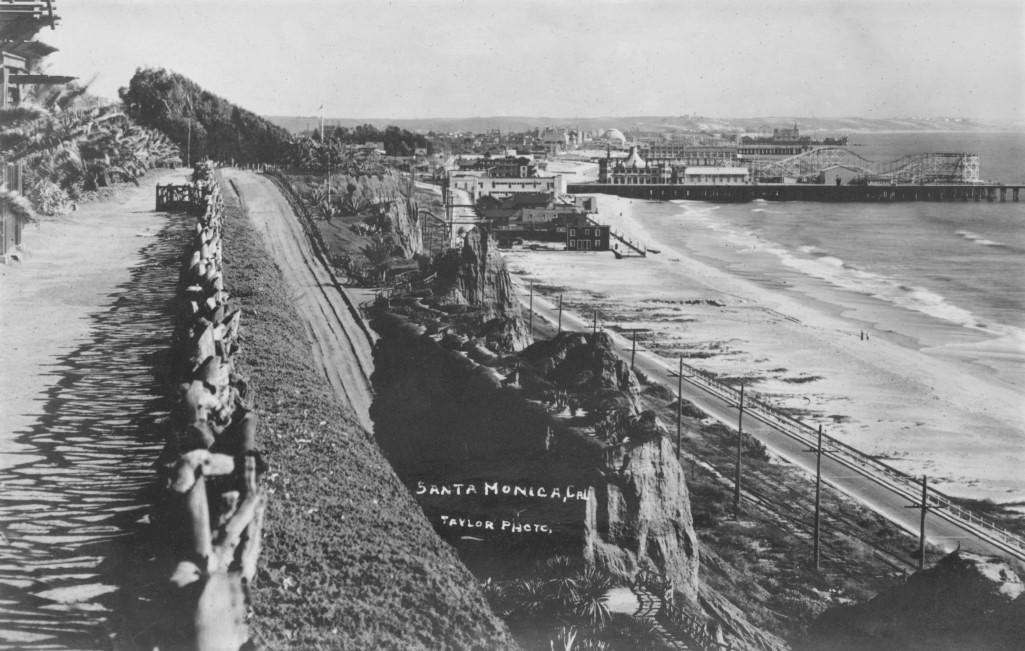 |
|
| (ca. 1920)* - View looking down from Linda Vista Park (Palisades Park) showing the California Incline. A bit of the Camera Obscura on the left edge, with the Looff Hippodrome, Dome Theater, Roosevelt Highway (Pacific Coast Highway) seen below. |
Historical Notes This view looks straight down on the California Incline from Palisades Park and catches several key landmarks. At the top left sits the Camera Obscura, a popular optical attraction that had been moved from the beach up to the park in the early 1900s. Below on the pier stands the Looff Hippodrome carousel building, completed in 1916 as part of the Looff Pleasure Pier. Roosevelt Highway, later known as Pacific Coast Highway, runs along the base of the bluffs, underscoring the growing importance of coastal motoring. Together these elements show how the incline linked new entertainment venues on the pier with the older bluff-top park. |
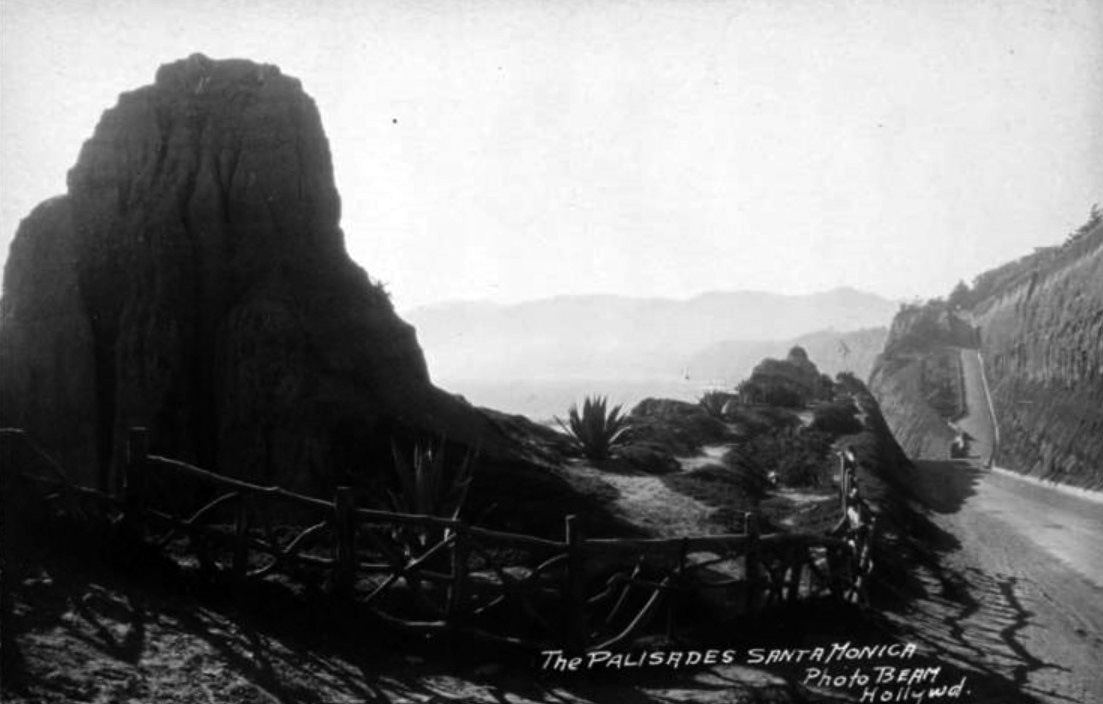 |
|
| (1920s)^ - Postcard view showing the California Incline and Palisades bluffs, lined with rustic wood fence, leading down to the beach at Santa Monica. |
Historical Notes By the 1920s the California Incline had become a familiar image in postcards that promoted Santa Monica as a scenic gateway to the coast. The road is now well defined and lined along its full length with the rough-hewn fence that appears in so many views of the bluffs. Cars share the road with occasional wagons while pedestrians still use nearby trails and park paths. The postcard reflects how the incline itself had become a landmark, not just a convenient street, and helped advertise Santa Monica’s combination of coastal cliffs and easy beach access. |
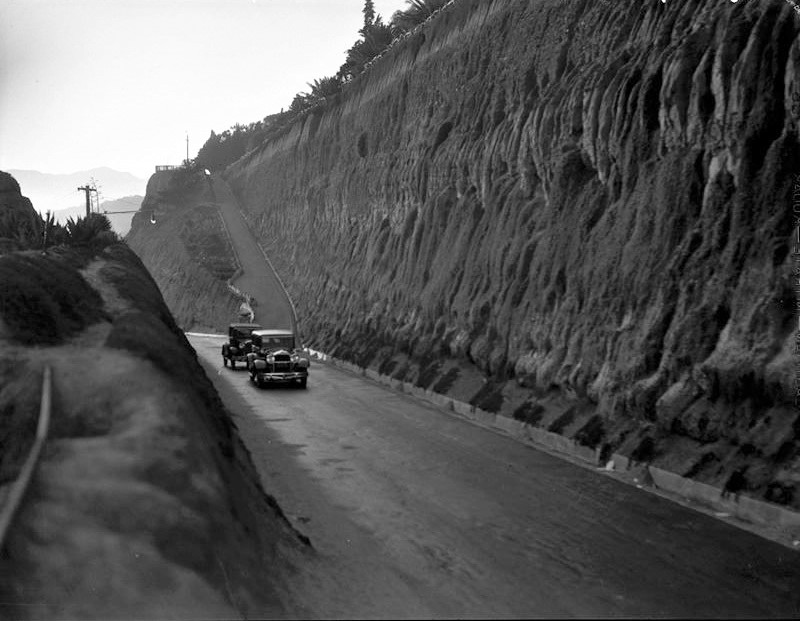 |
|
| (1924)^ - View showing two early model cars driving up the California Incline with pedestrian trail seen in the background. |
Historical Notes In this 1924 view the California Incline is clearly an automobile route, with two early cars climbing the grade while the Idaho Trail can be seen cutting across the bluff behind them. The coexistence of a dedicated footpath and a busy road reflects the original three-incline concept approved in 1905, which aimed to separate pedestrians from vehicles for both safety and comfort. The maturing plantings on the slopes hint at ongoing efforts to stabilize the bluffs and reduce erosion even before modern engineering methods were adopted. |
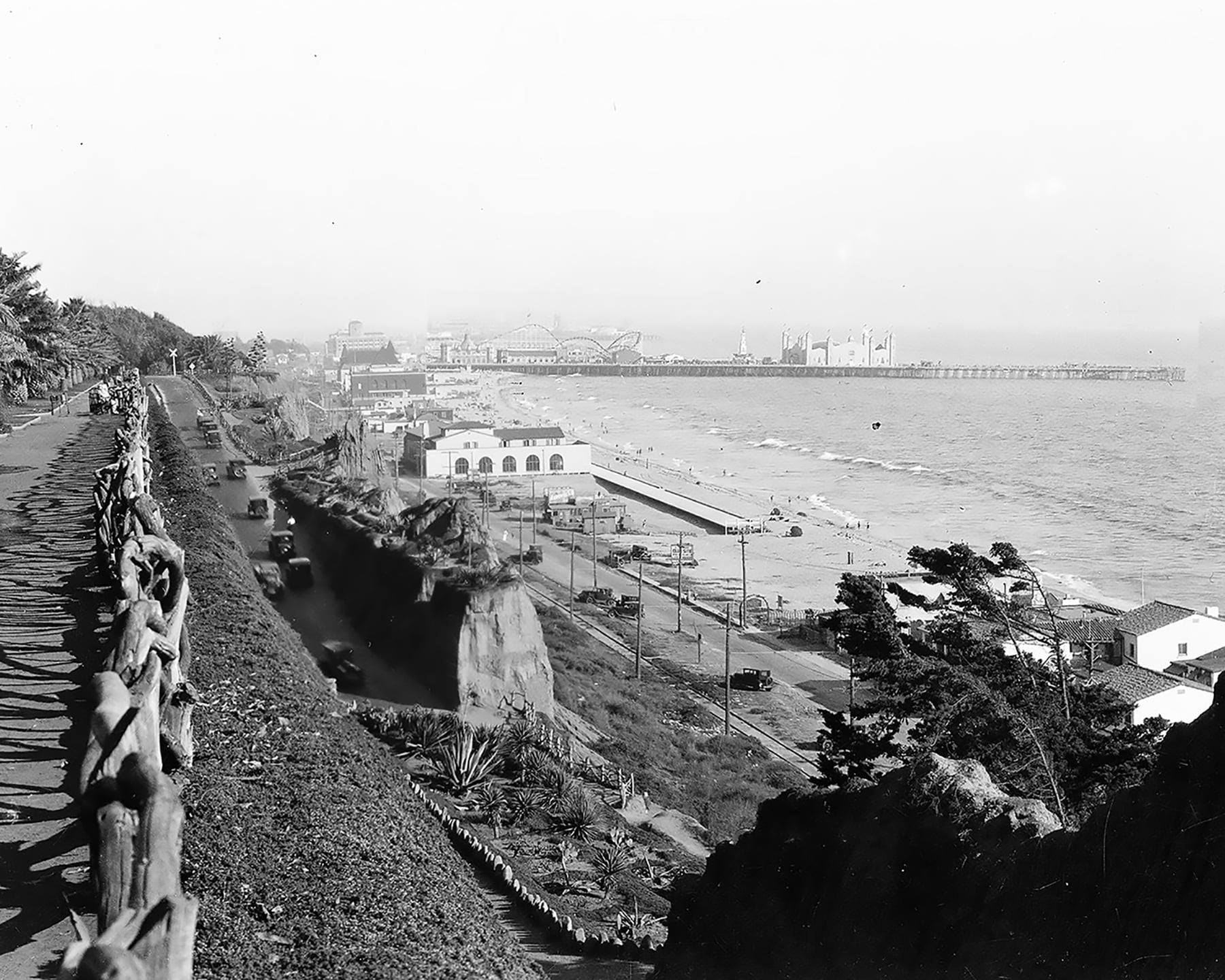 |
|
| (ca. 1925)* - California Incline with the Santa Monica Pier and Amusement Park in the distance. |
Historical Notes By the mid-1920s the Santa Monica Pier complex and the amusement zone around Ocean Park had grown into major attractions, and the California Incline served as a direct visual and physical link between the city and this entertainment waterfront. From the incline motorists could see the pier’s rides and lights ahead as they descended, making the drive itself part of the outing. At the same time, increased traffic along Roosevelt Highway and the beachfront was beginning to expose the limitations of the original narrow grade, setting the stage for the widening projects at the end of the decade. |
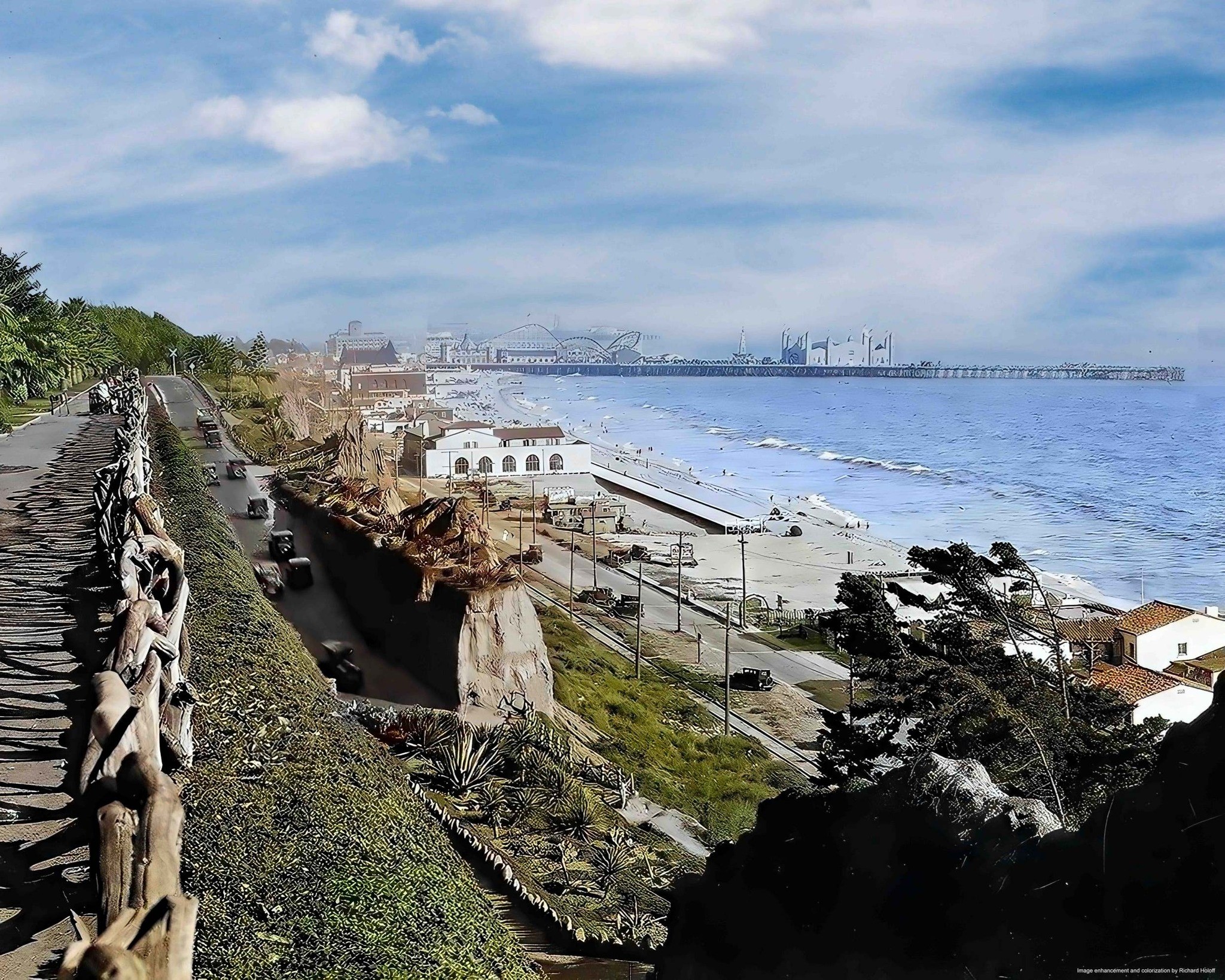 |
|
| (ca. 1925)* - California Incline with the Santa Monica Pier and Amusement Park in the distance. Image enhancement and colorization by Richard Holoff. |
Historical Notes This colorized rendering of the 1920s incline emphasizes the warm tones of the bluffs, the green park above, and the bright seaside light that drew visitors to Santa Monica. While the colors are modern additions, the underlying photograph remains an important record of the incline at its peak pre-widening form, with the now famous pier complex already established in the distance. |
 |
|
| (1920s)* - Aerial view of Santa Monica’s coastline showing the California Incline cutting through the bluffs, with a handful of beach clubs and homes along the shore, palm-lined Palisades Park above, and early residential development spreading inland. Photo by Dunning Air from the Ernest Marquez Collection. |
Historical Notes The aerial view from the 1920s shows how the California Incline carved a single direct line through the bluffs at a time when only a handful of beach clubs and houses dotted the shoreline. Roosevelt Highway runs at the base of the cliffs, with open sand extending seaward and Palisades Park lined with palms above. Inland, street grids and early residential districts are beginning to spread, signaling Santa Monica’s rapid growth as both a resort and a commuter suburb. This image helps explain why improving the incline and the coast highway soon became a priority for state and local officials. |
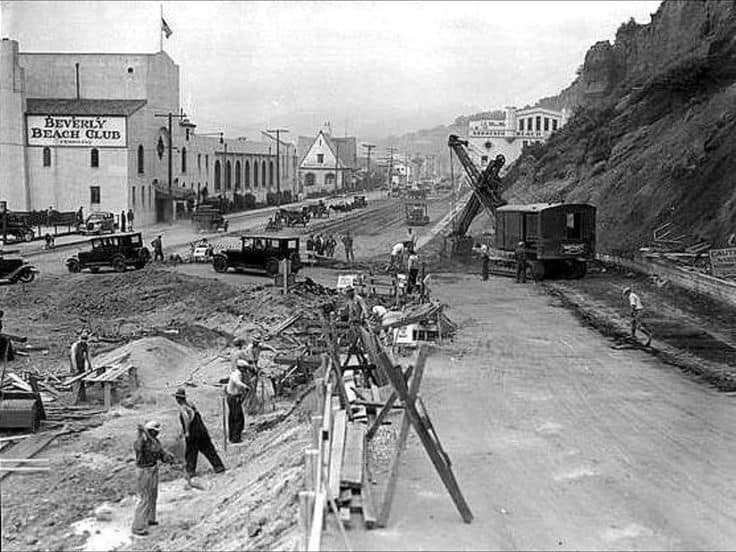 |
|
| (ca. 1929)* – View showing construction crews working on widening both Roosevelt Highway and the California Incline. |
Historical Notes Here workers and equipment are busy cutting back the bluffs and widening both Roosevelt Highway and the California Incline. The project, carried out around 1929 and 1930 by the state Division of Highways, was part of a larger effort to upgrade the coastal route that would soon be formally dedicated as the Theodore Roosevelt Highway and later signed as U.S. 101 Alternate before becoming California State Route 1. These improvements recognized that the once local beach road and narrow incline had become important regional links for motorists traveling between Los Angeles and points north along the coast. |
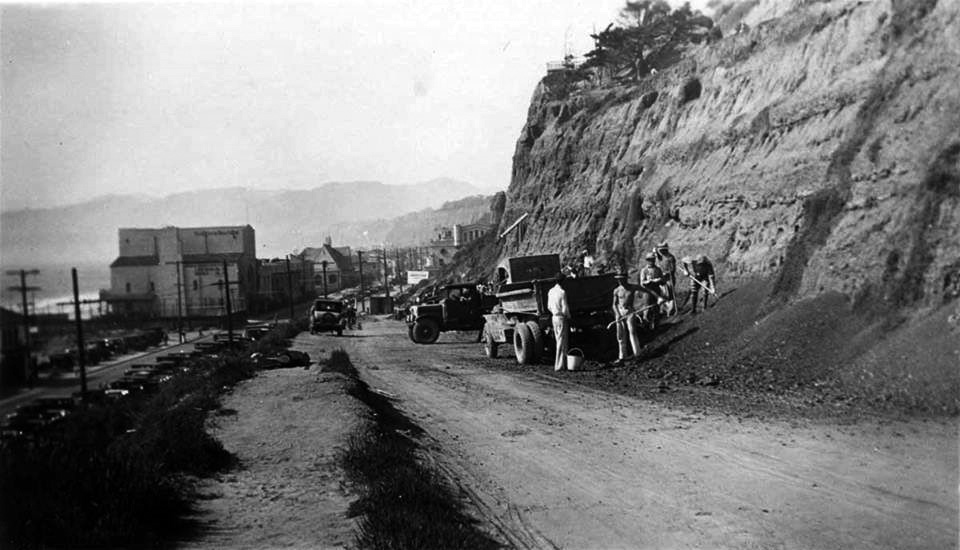 |
|
| (ca. 1929)* – View showing construction crews working on widening the California Incline. |
Historical Notes This closer view focuses on the California Incline during the same late nineteen-twenties widening project. Crews are cutting into the sandstone bluff, building up the outer edge, and preparing a broader, smoother surface suitable for the growing flow of cars and trucks. The work marks the incline’s transformation from a modest dirt shortcut into a fully engineered highway connection, anticipating later decades when it would be rebuilt again to meet changing safety and seismic standards. It is an early example of how coastal roads along the Pacific would require repeated rebuilding as traffic increased and knowledge about bluff stability improved. Click HERE to see more early views of the California Incline (1930 +). |
* * * * * |
California Incline: Then and Now
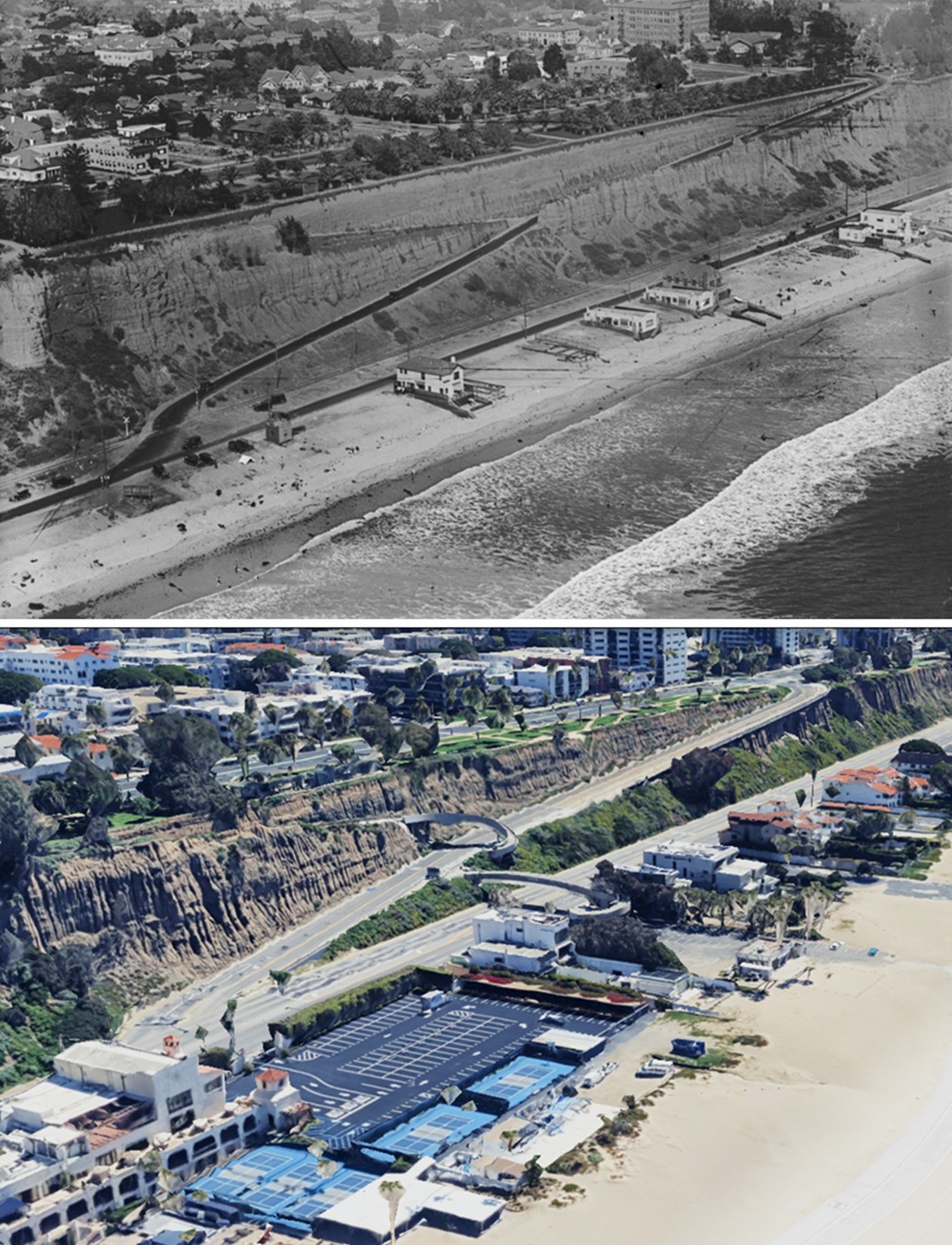 |
|
| (1920s vs. 2020s)* – Aerial Then and Now Comparison of the California Incline and Santa Monica Beachfront. Photo comparison by Jack Feldman. |
Historical Notes A full century separates these two views—100 years of change captured from above. In the earlier scene, Roosevelt Highway hugs the base of the Palisades, with just a scattering of beach structures. Fast forward to the 2020s, and the modern image reveals an expanded Pacific Coast Highway (CA–1), a reinforced and wider California Incline, and two pedestrian bridges now linking Palisades Park to the shore. The bluffs have filled in with development, and the beach appears noticeably wider. The increase in beach width is largely the result of sand replenishment efforts, which began in the mid-20th century as part of coastal management programs aimed at combating erosion and maintaining recreational shorelines. These projects, often involving offshore dredging and sand transport, have helped preserve and even expand the usable beachfront along much of Santa Monica Bay. |
Then and Now
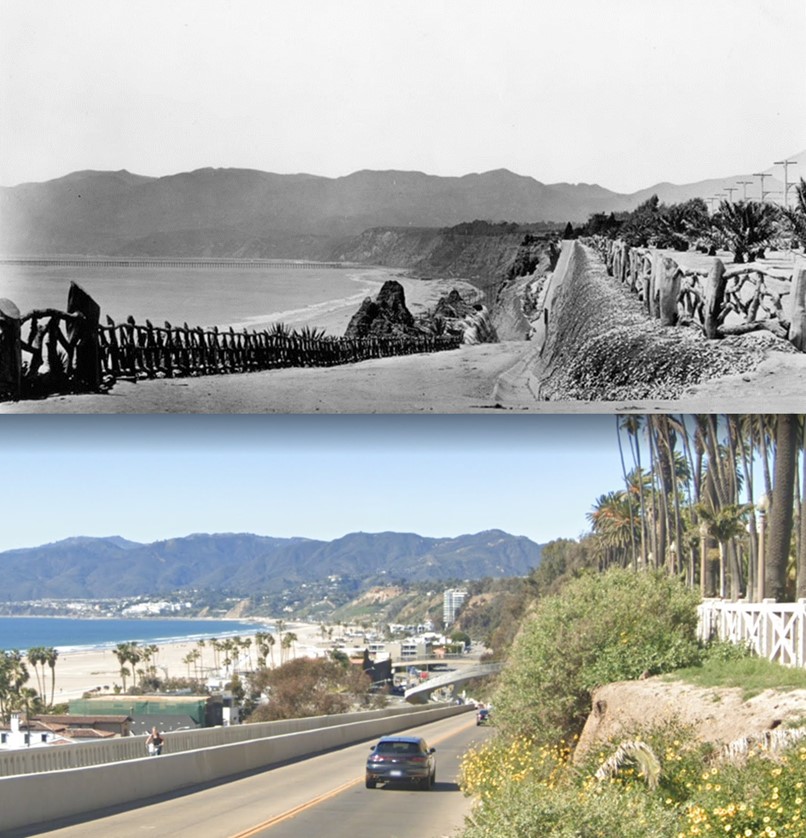 |
|
| (1905 vs. 2022)* - A 'Then and Now' comparison view of the California Incline. Photo comparison by Jack Feldman. |
Historical Notes In 1905, City Engineer Thomas H. James’ plan for three bluff inclines was approved. A footpath from Idaho Avenue and a vehicle road from California Avenue joined halfway down the bluff to form what is now the California Incline. A second pedestrian-only incline at Oregon Avenue (now Santa Monica Boulevard) became known as the Sunset Trail in 1916, while the Idaho path was renamed the Idaho Trail. All three routes were outfitted with rustic safety railings, including along the bluff edge of Palisades Park. |
Then and Now
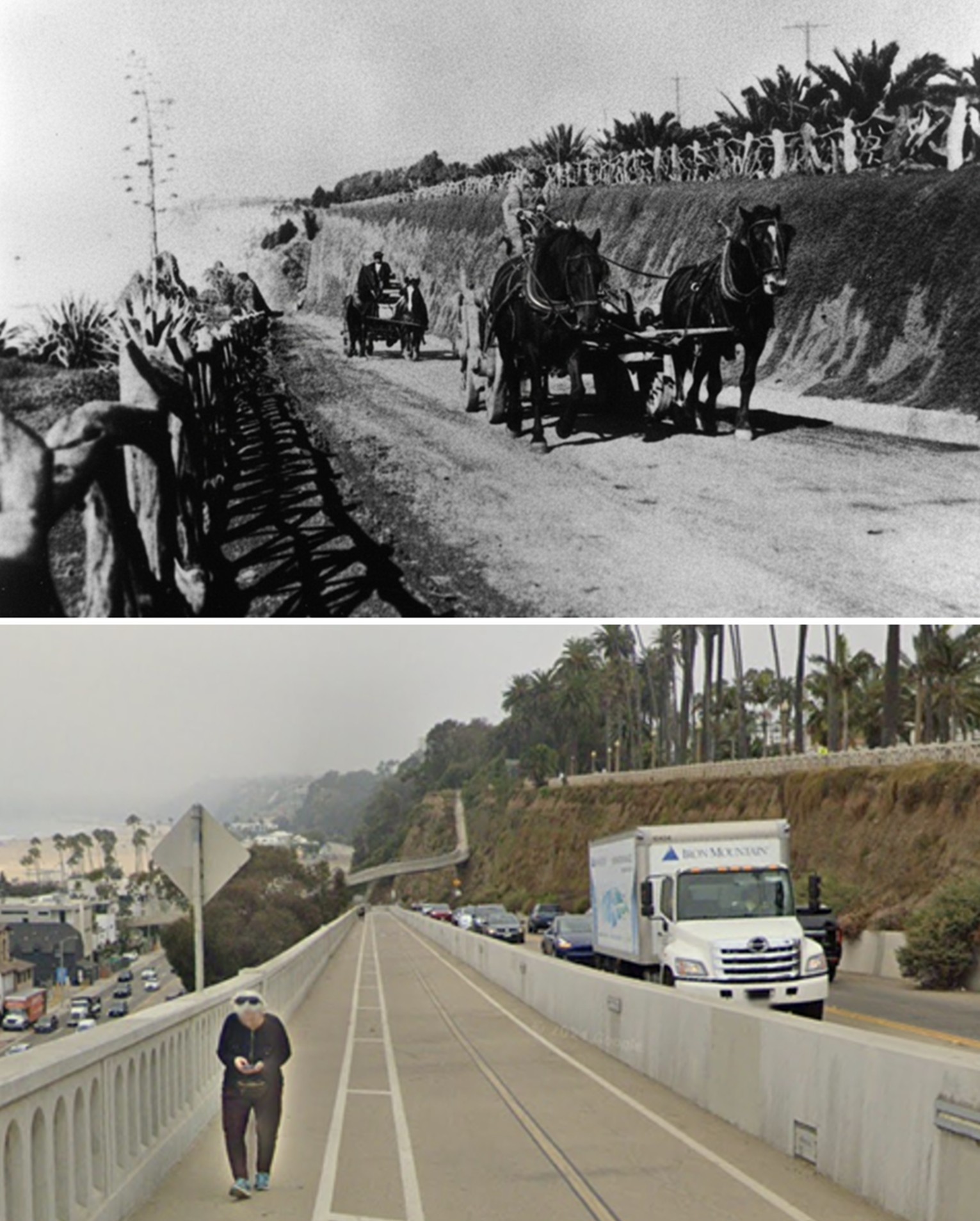 |
|
| (1915 vs 2024)* – Freight on the California Incline, then and now. Photo comparison by Jack Feldman. |
Historical Notes In the 1915 view, two horse-drawn wagons make the slow climb up the original dirt incline, using the bluff road as a practical route for hauling goods between the beach road and Santa Monica’s growing business district above. Lumber, produce, and building materials all moved this way before trucks became common, and the incline served as one of the few direct links between the shoreline and the top of the Palisades. The modern scene shows how the purpose of the incline has continued even as the city has changed. Where horses once strained up the grade, loaded trucks now move steadily along the rebuilt concrete structure. The shift from animal power to motor freight reflects Santa Monica’s growth and the repeated engineering work needed to keep this connection safe. What began as a narrow dirt cut into the bluff is now a widened, reinforced roadway carrying thousands of vehicles daily, yet its basic role—moving people and goods between Ocean Avenue and the coast—remains the same more than a century later. |
Then and Now
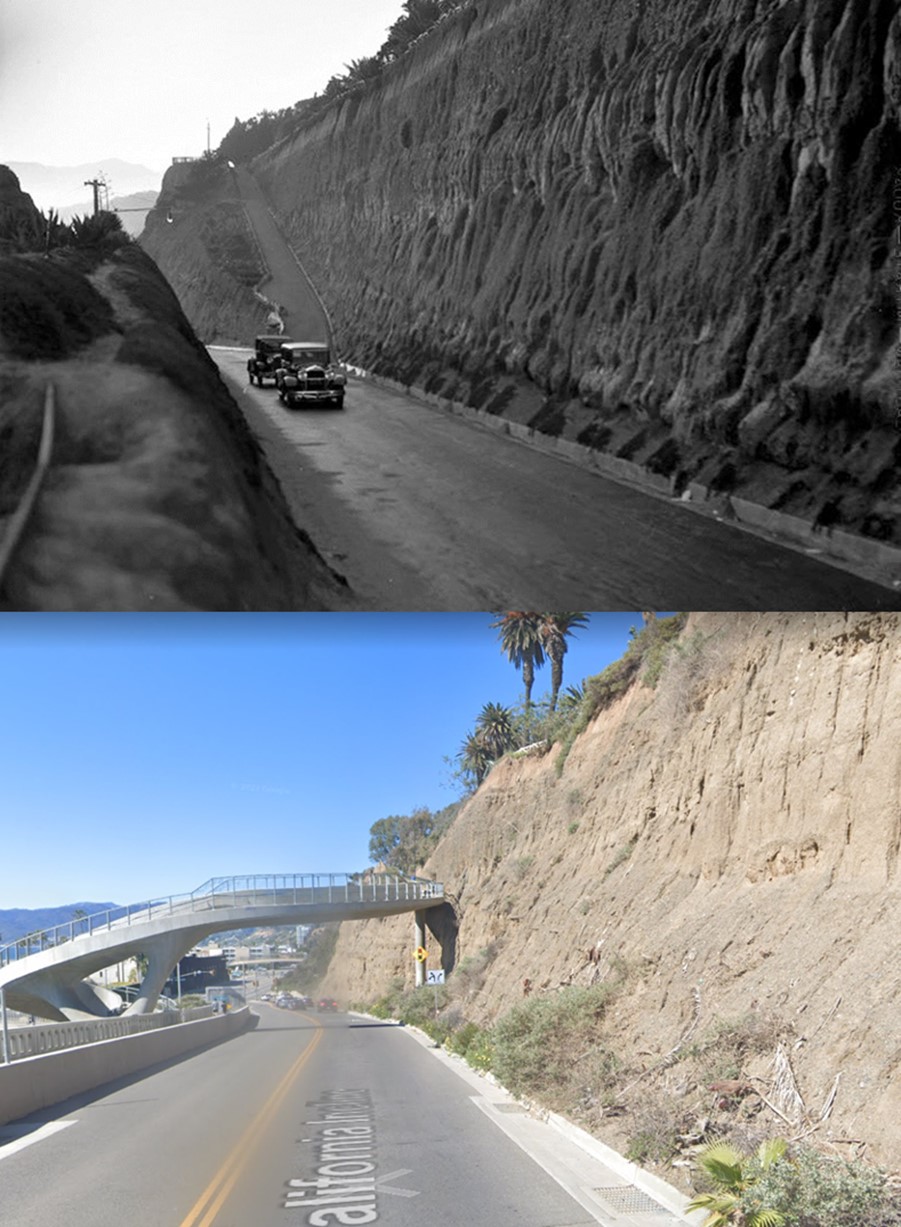 |
|
| (1924 vs. 2022)* - A ‘Then and Now’ comparison of the California Incline. In the 1924 view, a narrow pedestrian path known as the Idaho Trail descends from Idaho Avenue down Santa Monica’s bluffs, hugging the cliffside above the roadway. Nearly a century later, the 2022 photo shows its modern counterpart—the sculptural Idaho Avenue Pedestrian Overcrossing—spiraling gracefully over the California Incline, continuing the legacy of foot access from Palisades Park to the beach below. Photo comparison by Jack Feldman. |
Historical Notes The Idaho Avenue Pedestrian Overcrossing traces its origins to the early 20th century, when the Idaho Trail—formerly known as Linda Vista Walk—was established as a pedestrian path from Idaho Avenue down Santa Monica’s bluffs. This trail was part of a larger 1905 plan by City Engineer Thomas H. James, which included three inclines to improve beach access from Palisades Park. The Idaho Trail was designed exclusively for foot traffic and featured rustic fencing for safety, serving as a vital pedestrian link to the beach alongside the vehicular California Incline. By the mid-20th century, increased automobile traffic on the California Incline and Pacific Coast Highway created a need for a safer pedestrian route. In 1957, a dedicated pedestrian overcrossing was built to span the busy roadway, protecting foot traffic from the growing hazards below. Over time, this bridge, like the original incline, became structurally outdated and seismically vulnerable, prompting plans for its replacement as part of a broader infrastructure upgrade. |
Then and Now
 |
|
| (1905 vs. 2024)* – A ‘Then and Now’ comparison of the California Incline. In the 1910 photo, the California Incline meets Beach Road, which ran parallel to tracks built by Southern Pacific Ralroad Co. that led to the Long Wharf—faintly visible in the distance along the shoreline. Over a century later, the 2024 view from the Idaho Avenue Pedestrian Overcrossing shows the same location transformed, where the Incline now intersects with the heavily trafficked Pacific Coast Highway. Photo comparison by Jack Feldman. |
Historical Notes The California Incline underwent a significant reconstruction and reopened in 2016 after being deemed structurally deficient in the early 1990s. The new structure features a 750-foot-long reinforced concrete slab supported by 96 deep concrete piles and over 1,000 soil nails to stabilize the erosion-prone sandstone along the bluff. The updated Incline accommodates three lanes of traffic and includes a 16-foot-wide separated path for pedestrians and cyclists. As part of the reconstruction, the 1957-built Idaho Avenue Pedestrian Overcrossing was replaced with a modern, structurally sound bridge. The new curvilinear structure, featuring a signature V-shaped pier, connects Palisades Park to the beach, enhancing safety and accessibility for pedestrians. |
Then and Now
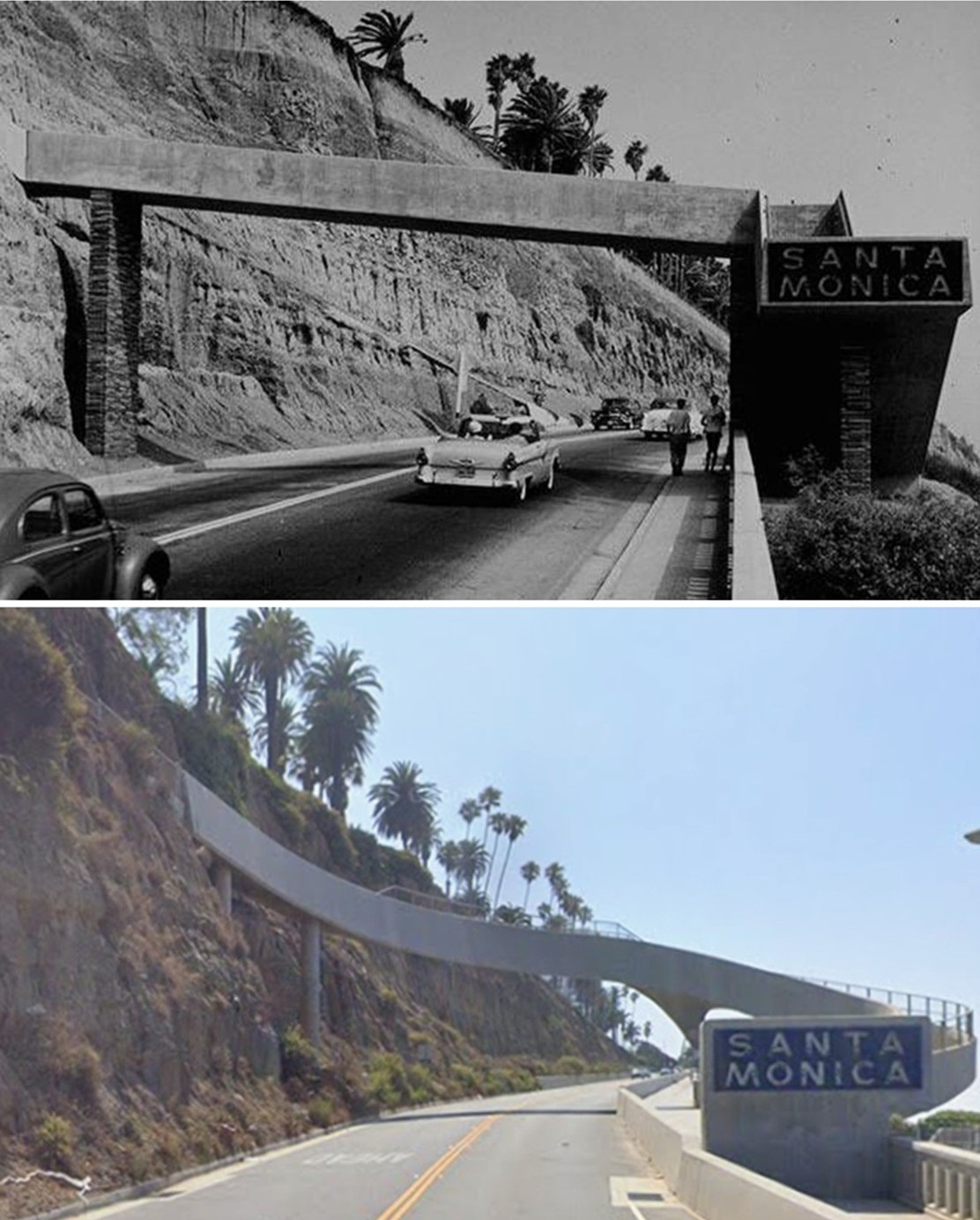 |
|
| (1957 vs. 2025)* – Looking up the California Incline toward the pedestrian crossing that connects the Palisades Park at the top to the bridge crossing Pacific Coast Highway. Photo comparison by Jack Feldman. |
Historical Notes The original Idaho Avenue Pedestrian Overcrossing was completed in 1957, giving beachgoers a safe way to cross the California Incline from Palisades Park without mixing with automobile traffic. It connected directly to a second structure, the California Incline Pedestrian Overcrossing, which spanned Pacific Coast Highway and led to the beach below. Together, the two bridges formed a continuous pedestrian route from Ocean Avenue to the shoreline. Both bridges were rebuilt in 2016 as part of the California Incline reconstruction project. The upper bridge was redesigned in a graceful curved form that follows the contour of the bluff, while the lower bridge over PCH was realigned and strengthened to meet modern seismic and accessibility standards. Today, the two crossings function as one continuous system linking Palisades Park with the beach, preserving the route’s historic purpose while enhancing its safety and visual appeal. Click HERE to see more early views of the California Incline (1930 +). |
* * * * * |
Sunset Trail
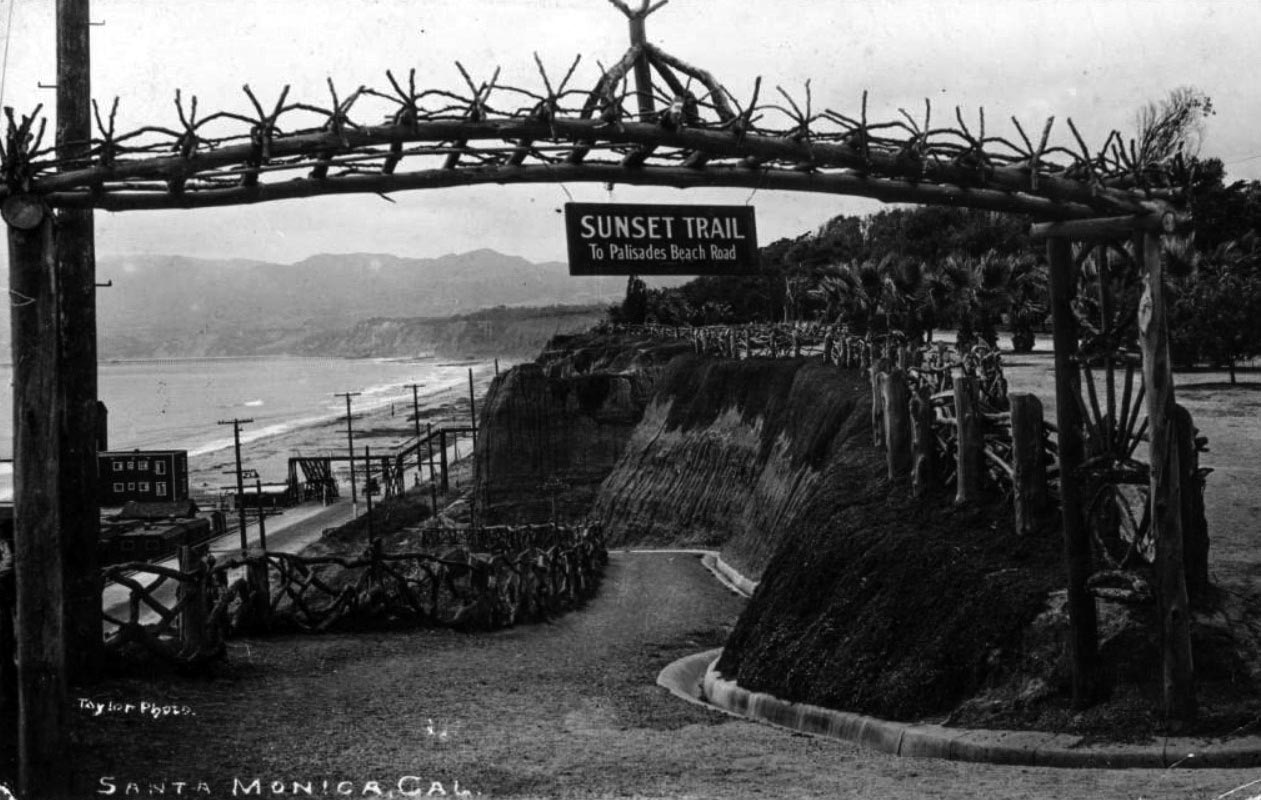 |
|
| (1910s)* - View of Sunset Trail from Linda Vista Park (present-day Palisades Park) to Palisades Beach Road in Santa Monica. A sign hangs from a rustic wooden archway that reads "Sunset Trail to Palisades Beach Road." The 99 Steps can be seen over the Beach Road (later part of Pacific Coast Highway) at left and the Long Wharf is visible in the distance. |
Historical Notes Sunset Trail began at the edge of Linda Vista Park, the bluff-top open space that Senator John P. Jones and the Santa Monica Land and Water Company donated to the city in the 1890s so it would remain a public promenade above the sea. The park was gradually landscaped in the spirit of the City Beautiful movement, with winding paths, plantings, and rustic fences made from twisted branches. The wooden arch in this view announces “Sunset Trail to Palisades Beach Road” and marks one of the steepest pedestrian routes down the bluffs. Below, Beach Road and the railroad tracks run along the sand toward the Southern Pacific Long Wharf in the distance. The set of stairs known as the 99 Steps drops from the lower end of the trail to the beach itself, giving visitors a direct connection from the park to the shoreline and the early bathhouses and cottage streets along what was sometimes called Sunset Beach. |
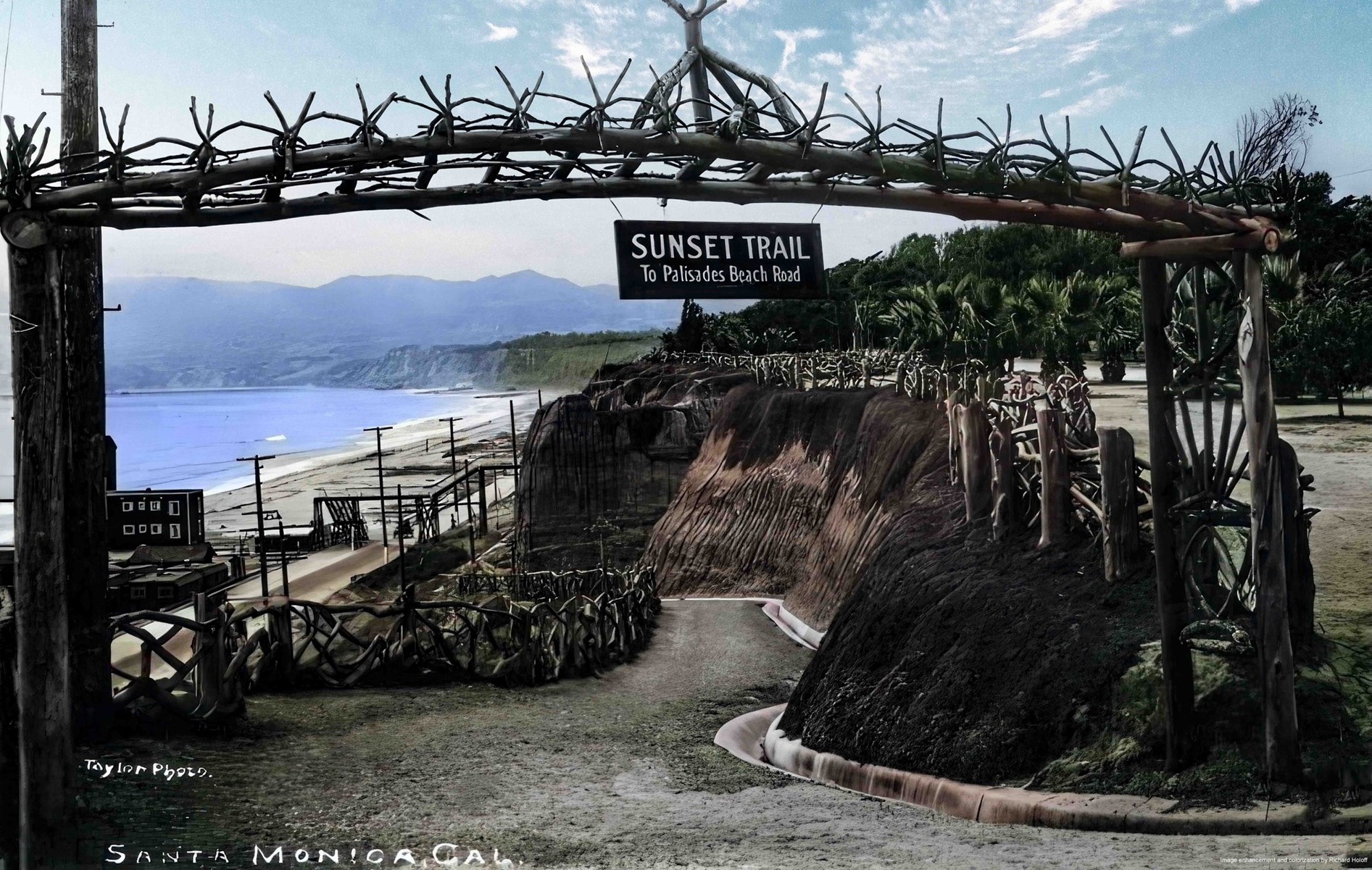 |
|
| (1910s)* - View of Sunset Trail from Linda Vista Park (present-day Palisades Park) to Palisades Beach Road in Santa Monica. A sign hangs from a rustic wooden archway that reads "Sunset Trail to Palisades Beach Road." The 99 Steps can be seen over the Beach Road (later part of Pacific Coast Highway) at left and the Long Wharf is visible in the distance. Image enhancement and colorization by Richard Holoff. |
Historical Notes This colorized version of the Sunset Trail entrance helps modern viewers imagine the scene as early visitors experienced it. The green of the bluff-top lawn, the dark foliage of the palms, and the warm tones of the sandstone cliffs all emphasize how closely the rustic trail was tied to its natural setting. The twisted branch fence and rough timber arch were deliberate design choices meant to make the man-made path feel like part of the landscape rather than a formal staircase. Even so, the trail carried steady traffic between the park and the busy beachfront below, where Beach Road, the railroad, and the Long Wharf made this part of Santa Monica an important corridor for both recreation and commerce. |
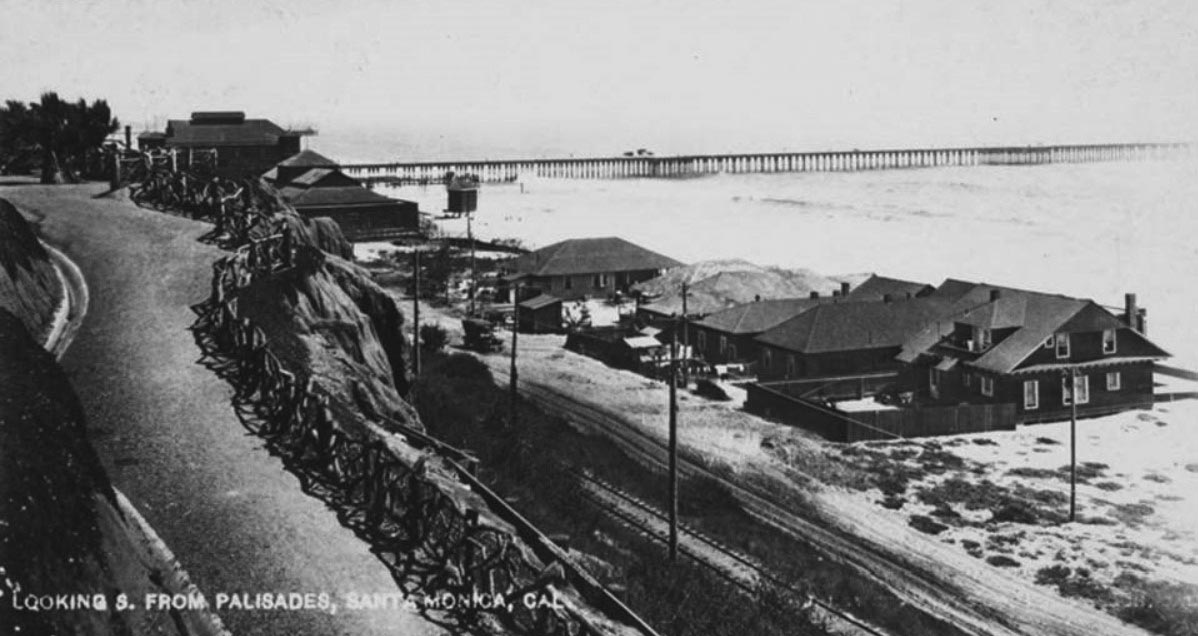 |
|
| (1910)* - Postcard view showing houses, a dirt coast road, an automobile and railroad tracks along the beach at Santa Monica, with the Santa Monica Municipal Pier (built in 1909) in the background. The Sunset Trail is seen on the left. |
Historical Notes This postcard shows how many different kinds of movement crowded the narrow strip between the bluffs and the ocean in the years just after 1910. A car and horse-drawn vehicles share the dirt coast road while a railroad line hugs the edge of the beach, carrying passengers and freight toward the Long Wharf and points north. On the left, the line of Sunset Trail drops sharply from the bluffs, meeting Beach Road close to the new Santa Monica Municipal Pier, which had opened in 1909 as a utility pier for sewer outfalls and city pipes. Small houses and beach cottages stand between the road and the sand, illustrating how the shoreline was starting to fill in with year-round development, even as the trail and park above still offered a largely open, rustic experience. |
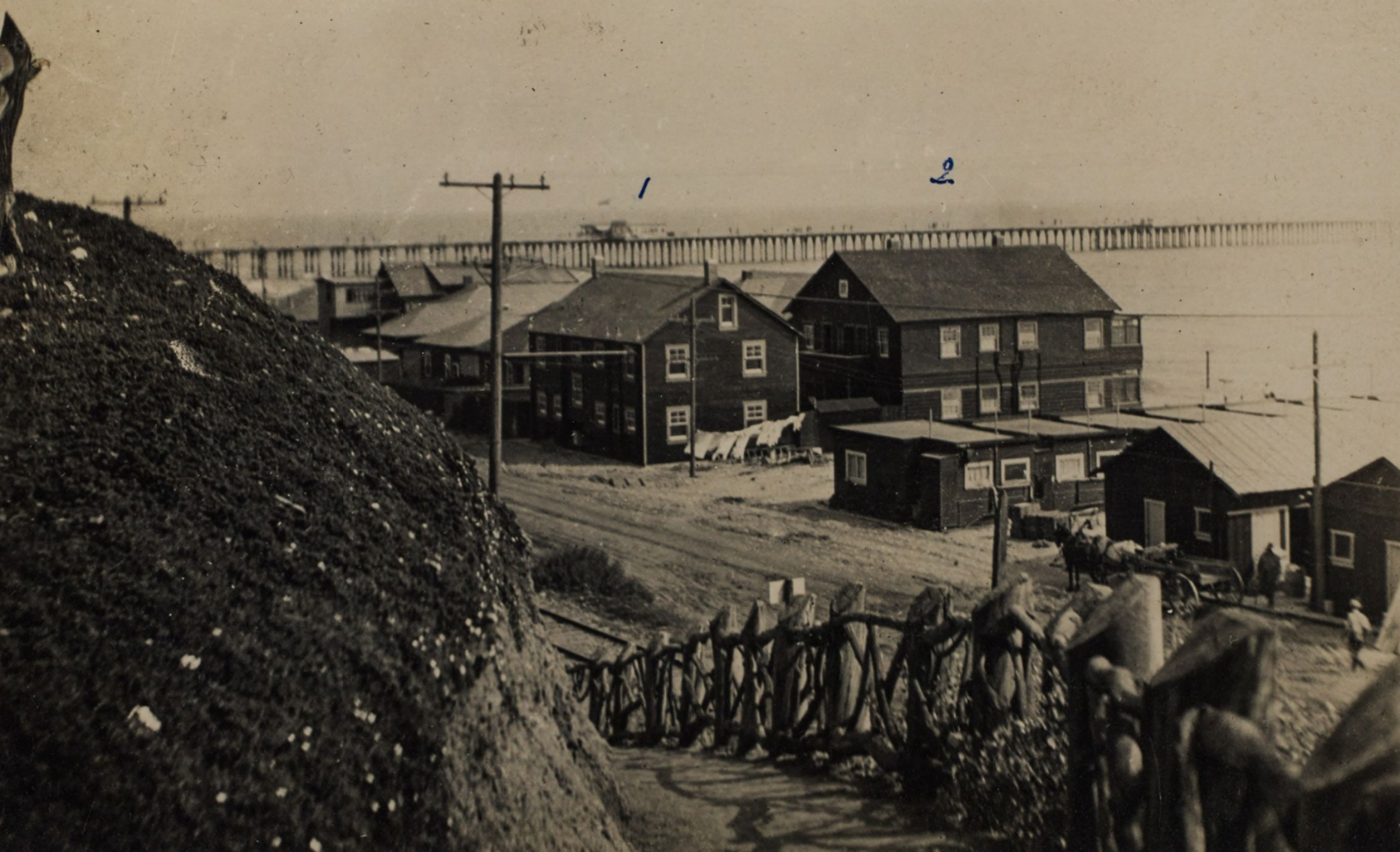 |
|
| (1914)* - Image of the rustic fence from Linda Vista Park (later Palisades Park) leading down to the Beach Road (later Pacific Coast Highway) with a horse-drawn wagon parked next to houses along Sunset Beach. The Santa Monica Municipal Pier is visible in the distance. |
Historical Notes The foreground fence, built from rough tree limbs and posts, is the signature style of early Linda Vista Park. It guided walkers safely along the bluff edge while preserving unobstructed views of the ocean. The same rustic look continued down the slope along Sunset Trail, where the path zigzagged past agaves and other hardy plantings on its way to Beach Road. At the bottom of the hill, a horse-drawn wagon is parked near modest homes that front the sand at Sunset Beach. Farther out, the Santa Monica Municipal Pier stretches into the bay. A few years later, amusement operator Charles Looff would add a wider pleasure pier with a carousel and other attractions just south of the municipal structure, and together the two would come to be known simply as the Santa Monica Pier. |
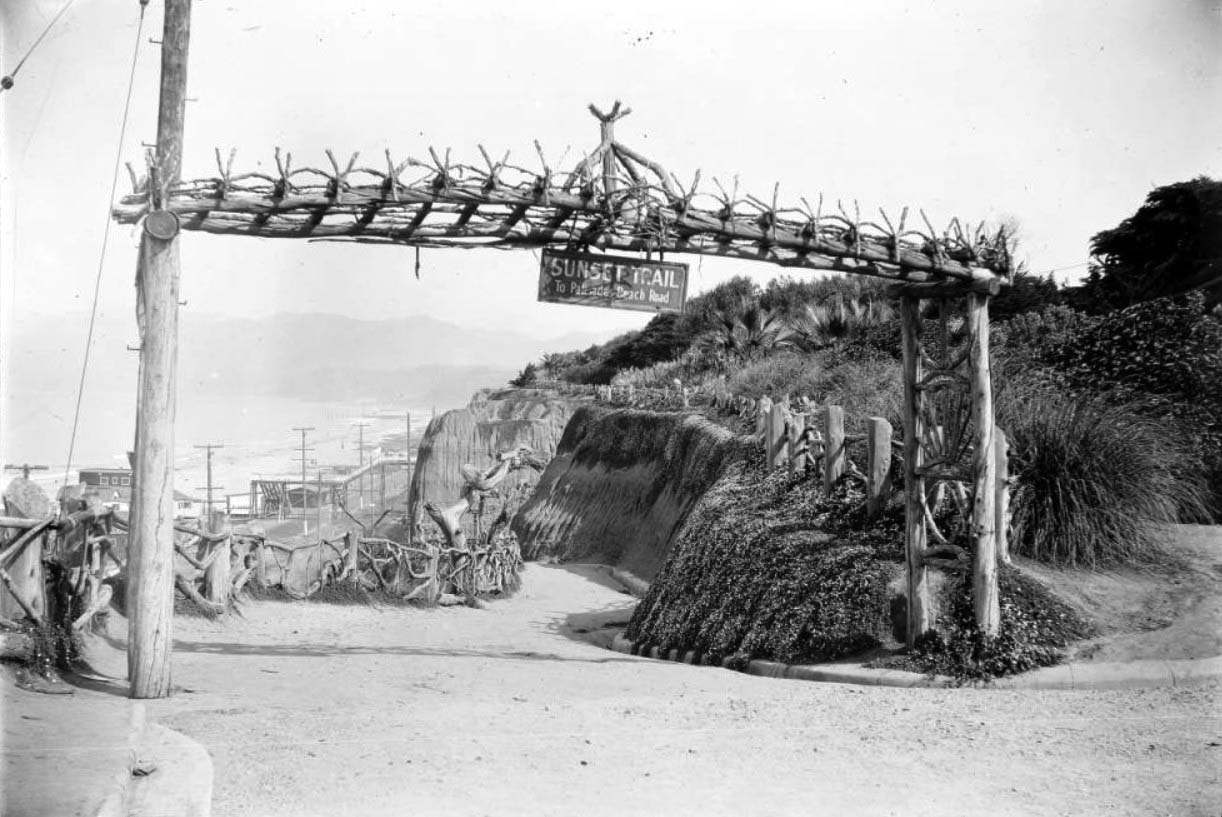 |
|
| (ca. 1920)* - Entrance to the Sunset Trail at Santa Monica's Palisades Park (originally Loma Vista Park). The trail is at center and heads down the steep face of the cliffs that give the park its name. The trail is bordered on the left side by a wooden fence made from twisted tree branches. The entrance to the trail is marked by a large wooden sign supported by a wooden framework made of tree trunks. The tops of the cliffs are at right and are covered with an assortment of bushes, and the ocean is visible in the background at left. The Pacific Coast Highway is at the base of the trail in the background at left and is lined with utility poles and beach houses. Sign reads: "SUNSET TRAIL - To Palisades Beach Road" |
Historical Notes By about 1920 Linda Vista Park had been renamed Palisades Park, but the entrance to Sunset Trail still kept its earlier rustic character. A heavy wooden frame made from unpeeled tree trunks supports the sign, and the fence along the path continues the theme, using crooked branches instead of formal rails. The intention was to make the trail feel like a natural canyon path, even though it was carefully engineered into the face of the bluff. At the bottom of the trail the once simple Beach Road had evolved into a busier coastal route lined with beach houses and utility poles. Within a few years this road would be improved and dedicated as Roosevelt Highway and later become part of Pacific Coast Highway, carrying motorists along the same strip of sand that walkers and wagon drivers once used. Sunset Trail remained the pedestrian counterpart to these changes, offering a direct foot route between the park lawns and the shoreline. |
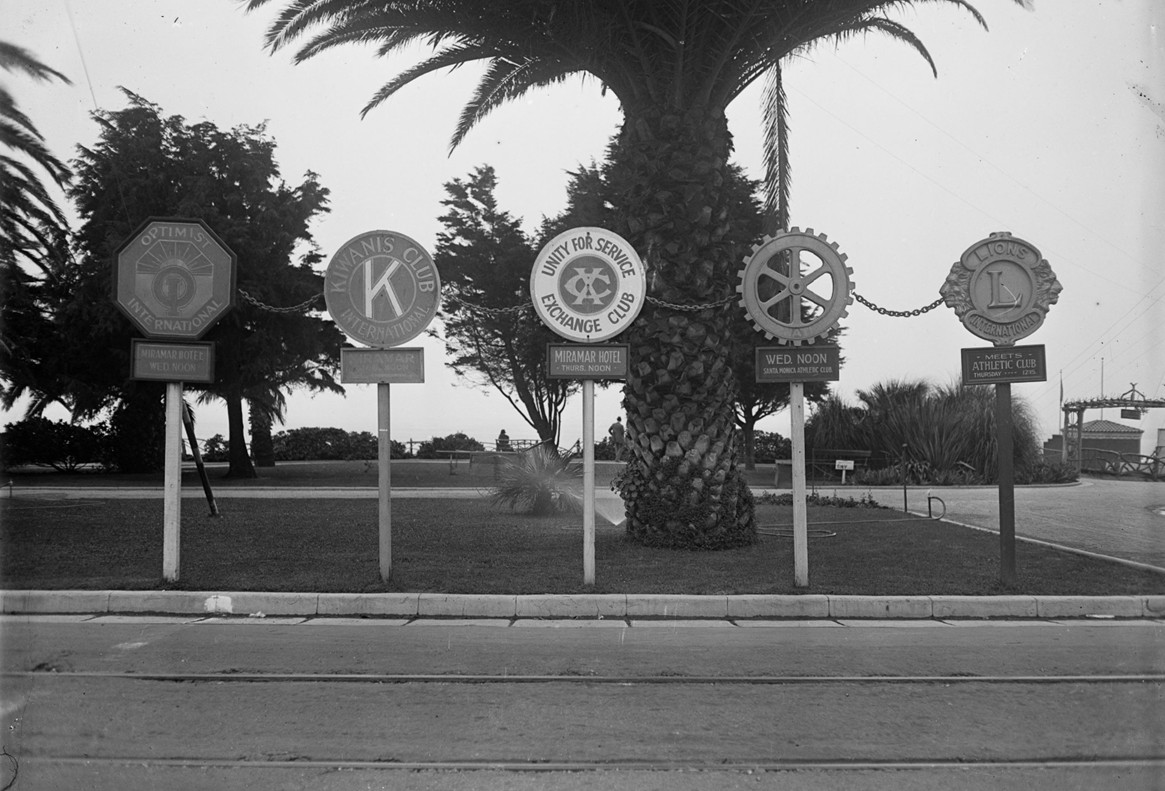 |
|
| (1920s)* – A view looking west at service club signs posted at the edge of Palisades Park in Santa Monica. Represented clubs include Optimist International, Kiwanis Club, Exchange Club, Rotary International, and Lions Club. To the right, a rustic wooden archway marks the entrance to Sunset Trail, which leads down the bluff to the beach. Photo from the Ernest Marquez Collection. |
Historical Notes In the 1920s Santa Monica promoted itself as a modern, civic-minded city, and the cluster of service club signs at the edge of Palisades Park reflects that spirit. Groups like the Rotary, Lions, Kiwanis, and Optimists were proud to announce their presence to motorists and pedestrians moving along Ocean Avenue and the bluff-top paths. Just beside these emblems of civic boosterism stands the familiar arch for Sunset Trail. Its rough wood construction contrasts with the neatly painted metal signs and underscores how the bluffs served two roles at once. They were both the city’s front porch, where organizations advertised their good works, and a rustic gateway to the beach, where the trail led down through the palms and agaves to the sand and coastal road below. |
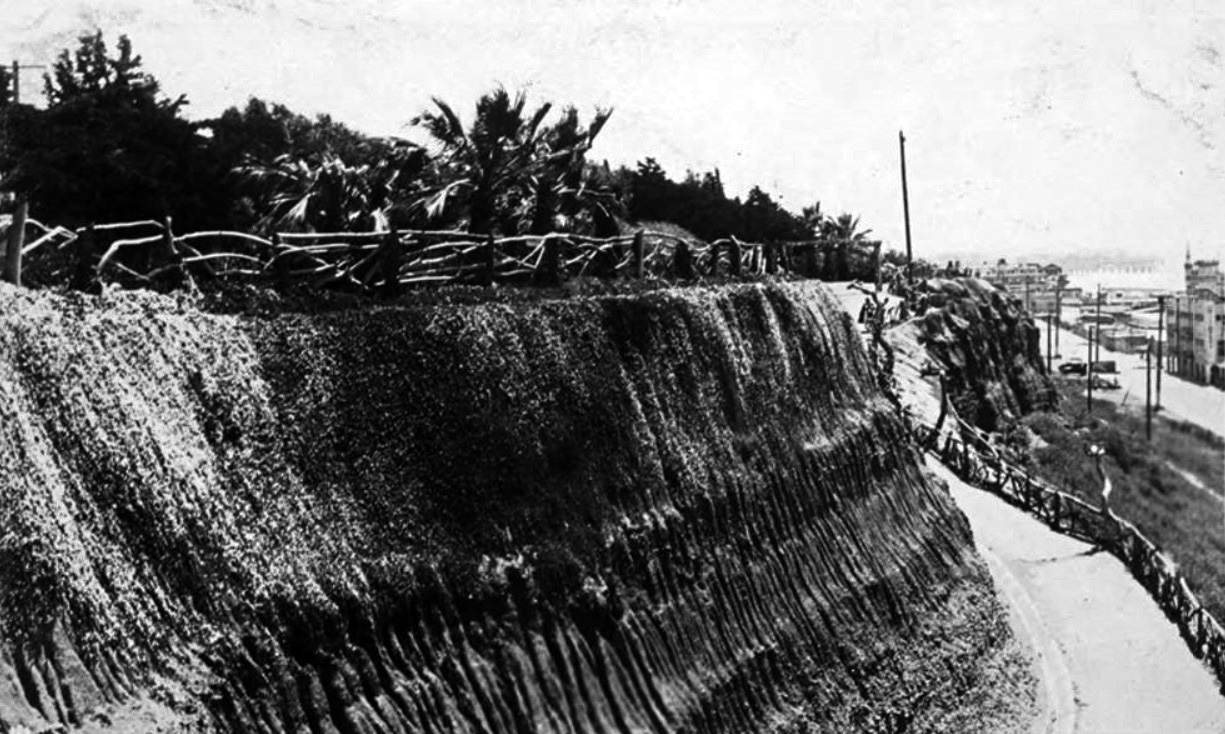 |
|
| (ca. 1920s)* - View of the Palisades bluffs above the beach, with a rustic wood fence, and palm trees in Palisades Park. The Sunset Trail path is on the right; a woman is walking down it in the background. The coast road (later part of Pacific Coast Highway) and buildings on the beach are also in the view. |
Historical Notes This view shows Sunset Trail in everyday use rather than as a posed postcard subject. A woman makes her way down the path, following the curve of the bluff toward the beach while palms and drought-tolerant shrubs line the slope around her. Above, Palisades Park is shaded by palm trees and framed by the same twisted branch fence seen in earlier decades, tying the whole bluff edge together visually. Below the trail, the coastal road and a row of houses and beach clubs mark how much busier the shore had become since the trail was first cut. Even so, the path itself still appears narrow and informal, more like a country footpath than a city staircase, reminding us how long Santa Monica tried to preserve a park-like atmosphere along its dramatic ocean cliffs. |
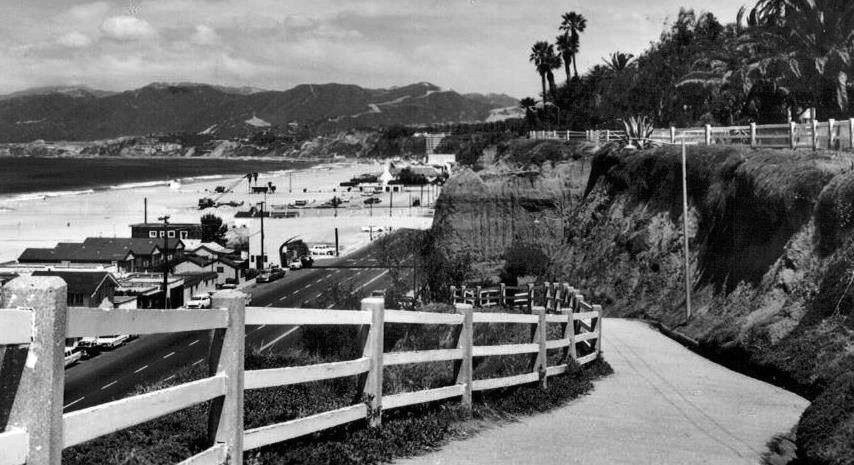 |
|
| (1950s)* – Postcard view showing Sunset Trail in the early 1950s with Palisades Park (originally Linda Vista Park) seen in upper right. |
Historical Notes By the early 1950s the world around Sunset Trail had changed dramatically. Pacific Coast Highway had been widened and engineered as a major state route, carrying a steady stream of cars between Los Angeles and the coastal communities to the north. New beach clubs, parking lots, and apartment buildings lined the shore, and the sound of traffic filled the canyon formed by the bluffs and the sea. Yet the postcard shows that the basic idea of the trail survived. Walkers could still leave the lawns and palm groves of Palisades Park, pass under the familiar rustic arch, and follow the steep path down to the beach. In an era increasingly defined by automobiles, Sunset Trail remained a reminder of the days when access to the shoreline depended as much on stairs and footpaths as on roads. |
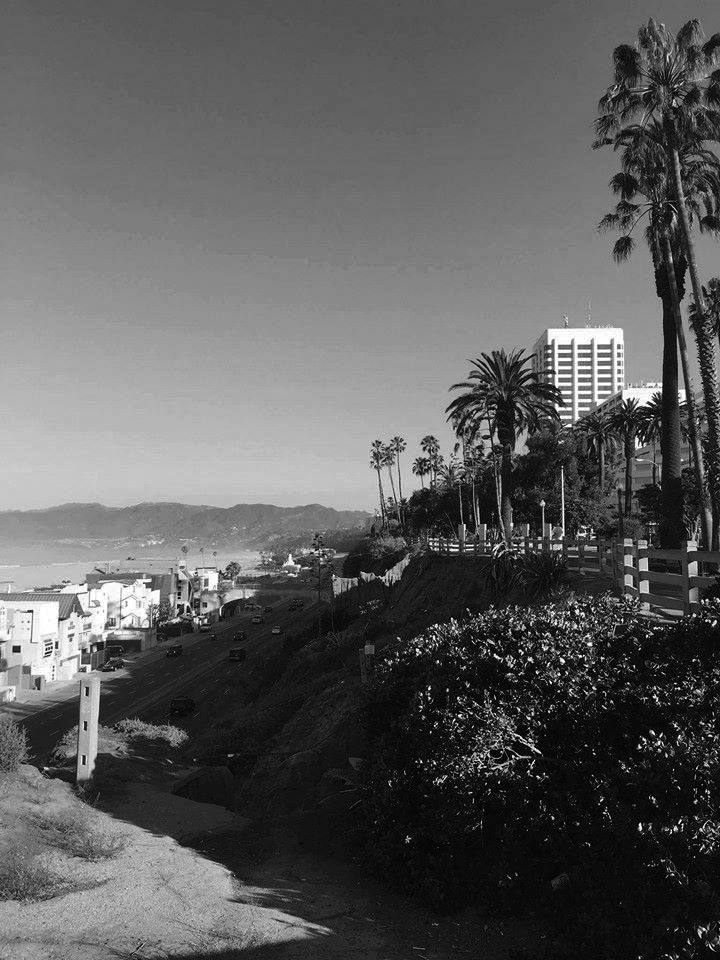 |
|
| (2018)* - Today’s reinforced walkway, built along the alignment of the old Sunset Trail. |
Historical Notes Although the name and general route survive, the original Sunset Trail no longer exists in its early form. The rustic wooden archway, twisted branch railings, and narrow dirt path that once descended the bluffs were removed as erosion control and safety needs changed over the decades. Today a modern pedestrian walkway occupies roughly the same alignment, reinforced with concrete, steel railings, and retaining walls that stabilize the steep cliffs. What remains is the experience of moving from the bluff top of Palisades Park down toward the beach. Visitors still begin near a signed entrance, walk past agaves and other coastal plants, and descend toward the shoreline after crossing Pacific Coast Highway. More than a century after it first appeared on postcards, Sunset Trail continues to serve its original purpose, even though its historic features have been replaced by modern infrastructure. |
* * * * * |
Linda Vista Park (later Palisades Park)
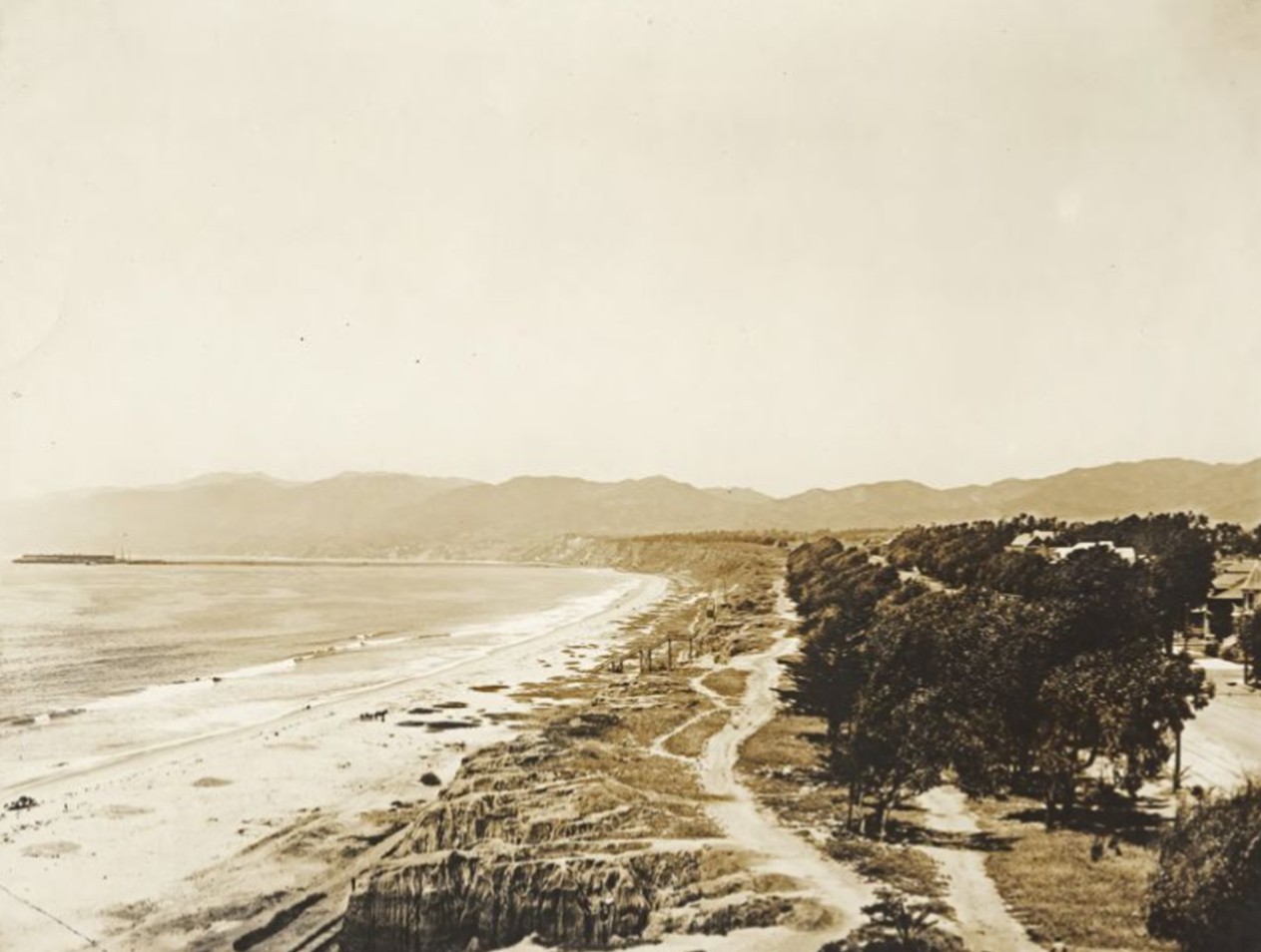 |
|
| (ca. 1893)* – Sweeping view looking north from the Santa Monica bluffs toward the mountains and the Southern Pacific Long Wharf, which opened in 1893. In the foreground is the newly donated bluffland that would soon become Linda Vista Park—the city's first public park, gifted in 1892 by founders Senator John P. Jones and Arcadia Bandini de Baker. Note the original “99 Steps” footbridge crossing the road and train tracks to the beach below. Ocean Avenue runs along the right, with a few early homes visible. |
Historical Notes Linda Vista Park was established in 1892 when Santa Monica’s co-founders donated this coastal bluff to the city “to remain a park forever.” Though the image card mistakenly dates the photo to 1888, the presence of the Long Wharf confirms it was taken no earlier than 1893. The original “99 Steps” staircase and footbridge were some of the earliest park features, offering a path to the beach long before the California Incline was carved into the bluff around 1905. |
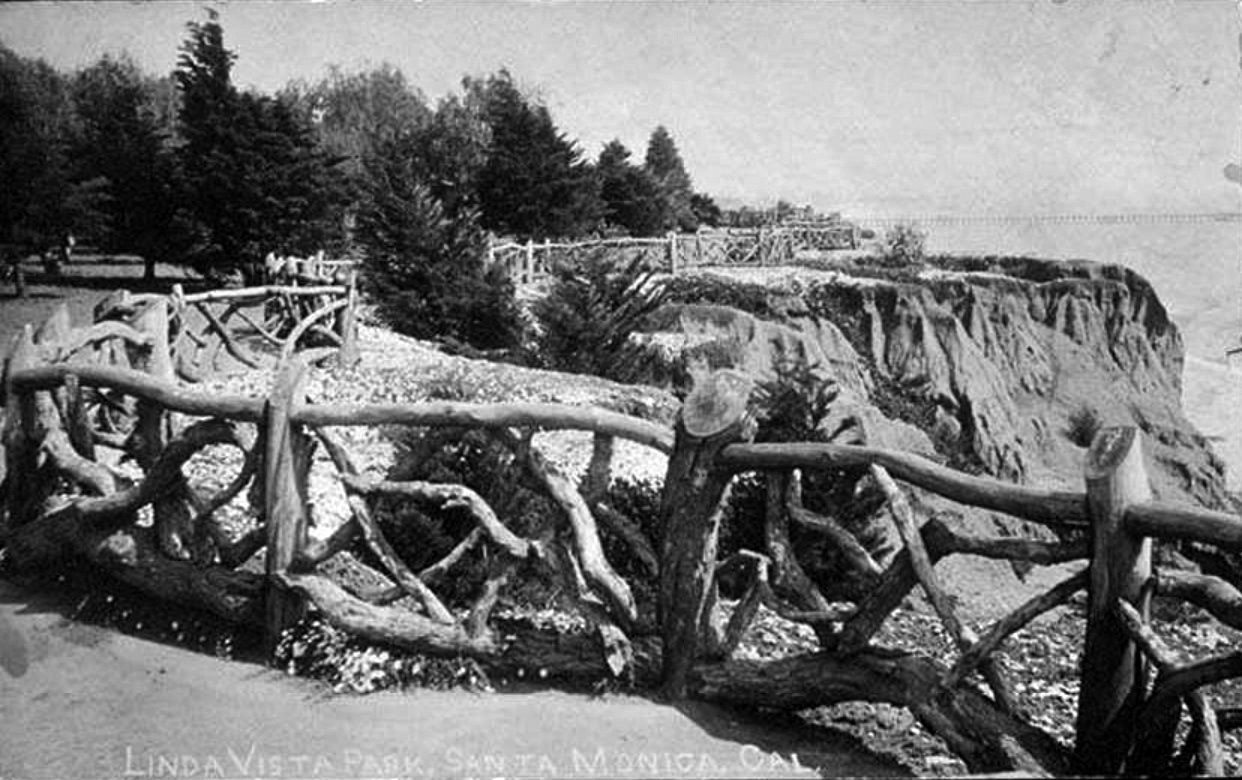 |
|
| (1909)* – View looking south across Linda Vista Park toward the Santa Monica Municipal Pier. The bluff was still lightly landscaped, with simple paths and early plantings along Ocean Avenue. |
Historical Notes The park's blufftop location was prized for its views but started out barren and windswept. After its dedication in 1892, the city slowly added improvements, including walking paths, trees, and rustic wooden fencing. This area remained known as Linda Vista Park until 1915, when it was officially renamed Palisades Park to reflect the grandeur of its coastal cliffs. |
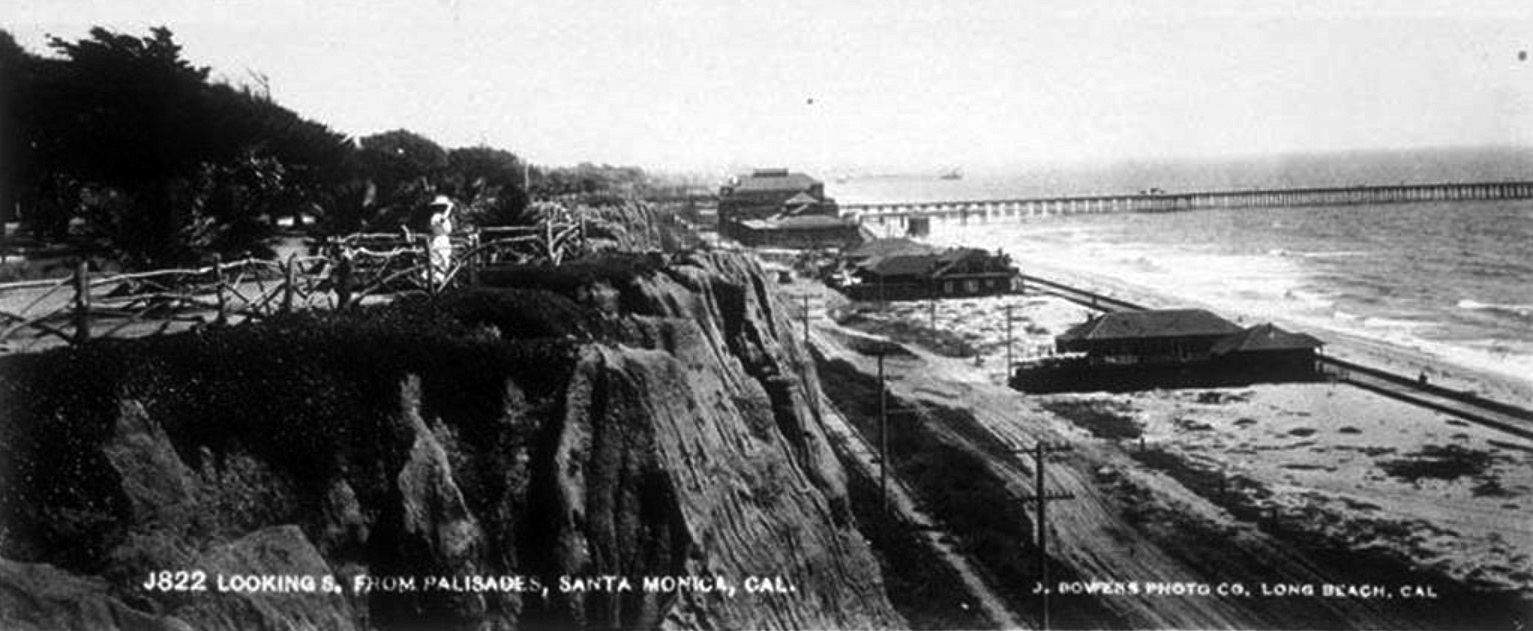 |
|
| (ca. 1909)* - View from Linda Vista Park (later Palisades Park), looking south toward the newly constructed Santa Monica Municipal Pier. The park's rustic fencing and early plantings are visible in the foreground. |
Historical Notes Park development picked up in the early 1900s under Park Commissioner E.H. Sweetser, who led major improvements including the planting of Monterey cypress, eucalyptus, and palms. Sweetser even donated his city salary to buy trees. The city built paths, benches, and viewing points that helped establish the park as a local gathering place and visitor attraction. |
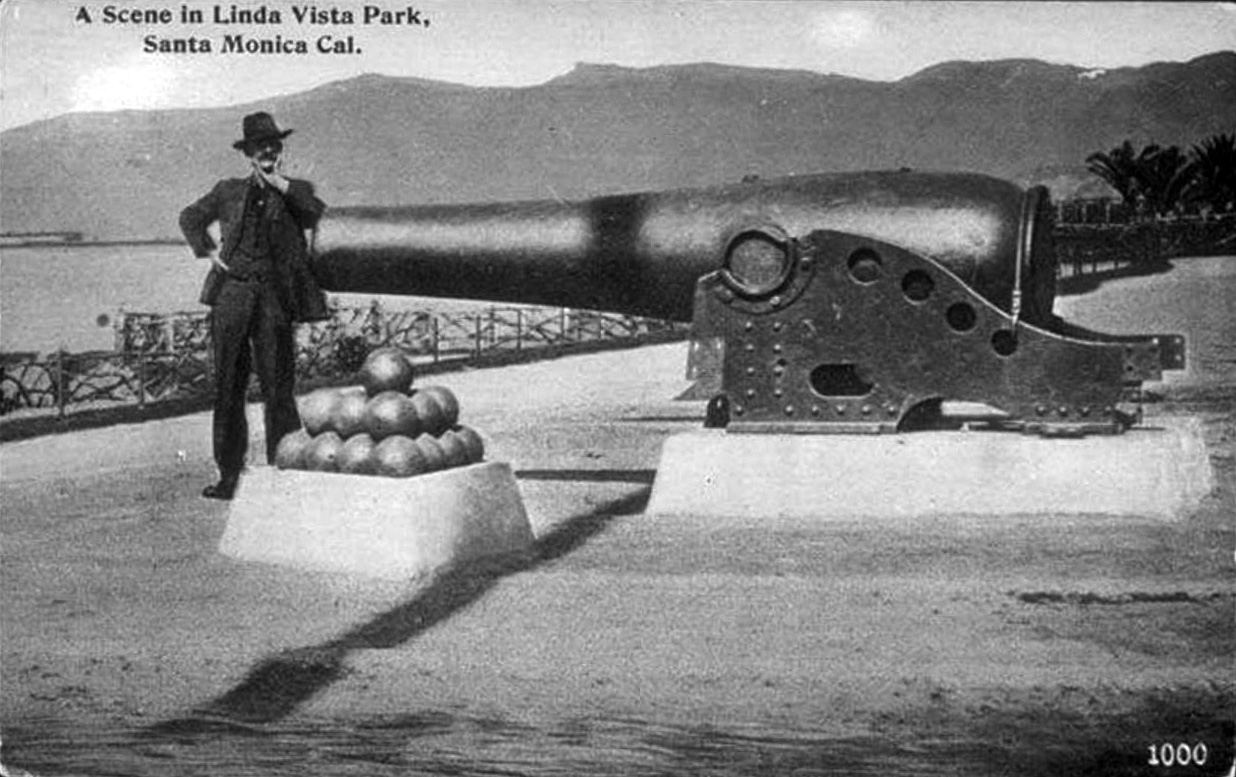 |
|
| (1908)* – A man poses beside the large 1861 Rodman cannon installed at Linda Vista Park (now Palisades Park). The cannon, aimed out toward the sea, was brought to Santa Monica from San Francisco as part of a national program to place military artifacts in public parks. |
Historical Notes Designed during the Civil War, the Rodman gun was one of the largest coastal defense cannons of its era. In 1908, Santa Monica received two Rodman guns on loan from the federal government, placing one at the end of Colorado Avenue to become a public curiosity. The cannon helped tie the park’s natural beauty to civic pride and American history, reinforcing the park's role as a centerpiece of public life. |
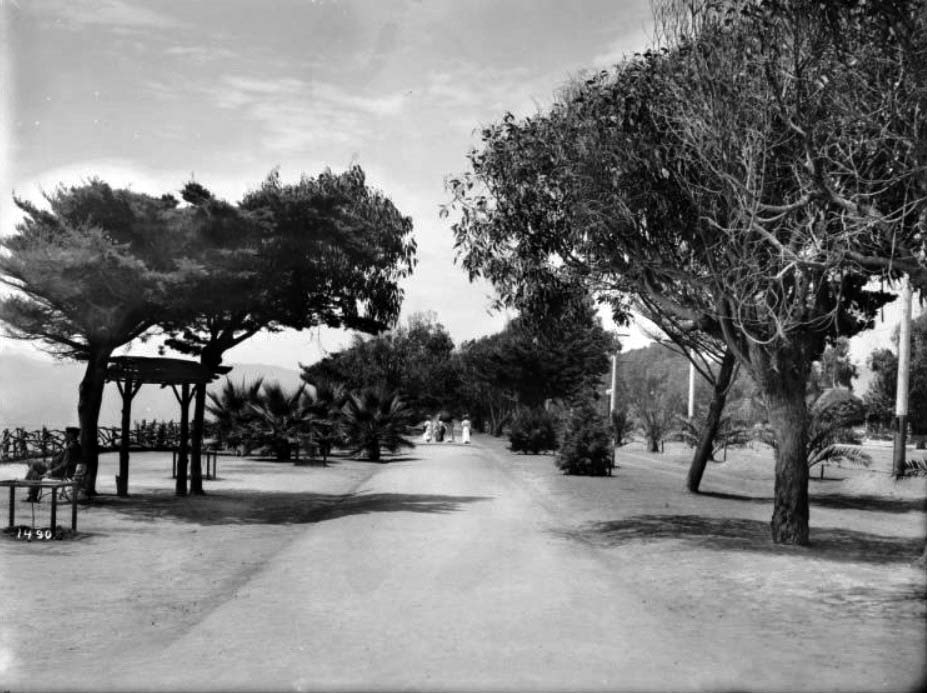 |
|
| (ca. 1910)* - Four women stroll along “Lover’s Walk,” a shaded dirt path in Linda Vista Park. Trees line the path, and a man is seen quietly sitting on a bench looking out over the Pacific Ocean. |
Historical Notes By the early 1910s, Linda Vista Park was becoming more than a simple bluff walk. It offered winding paths like “Lover’s Walk,” romantic spots for strolling and reflection. In 1913, landscape architect I.G. Le Grande proposed a more formal redesign influenced by the City Beautiful movement, including gazebos, walkways, and fountains. But local groups like the Santa Monica Bay Women’s Club successfully pushed to preserve the park’s informal charm, keeping much of its early rustic design intact. |
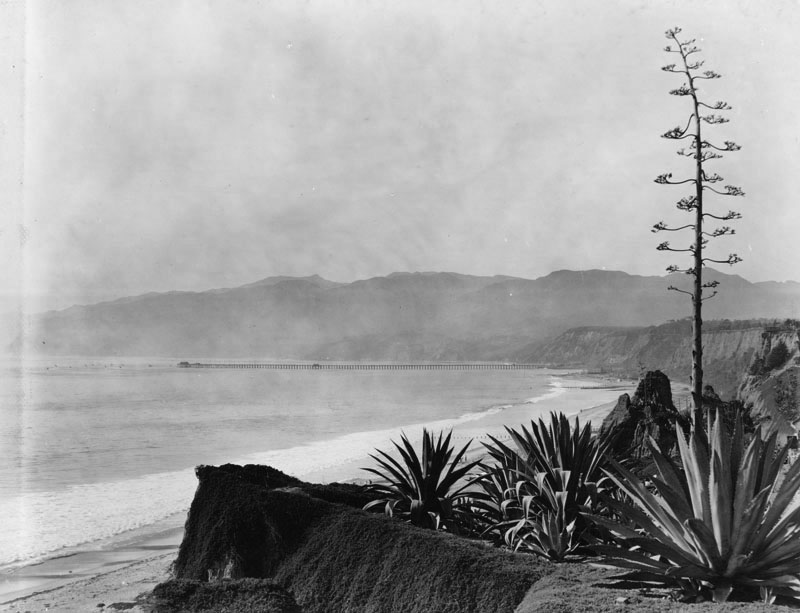 |
|
| (Early 1900s)* - View looking north from Linda Vista Park near the top of what would become the California Incline. The Southern Pacific Long Wharf, the world’s longest pier at the time, can be seen in the distance. |
Historical Notes In the early 1900s, a steep road called Linda Vista Drive (now the California Incline) was carved into the bluff to connect the park with the beach road below. It opened around 1905 and became a vital link for early automobiles. The Long Wharf, visible in the distance, was a major transportation hub until it was dismantled in 1920. The park’s location offered panoramic views of these landmarks and made it a favorite photo stop. |
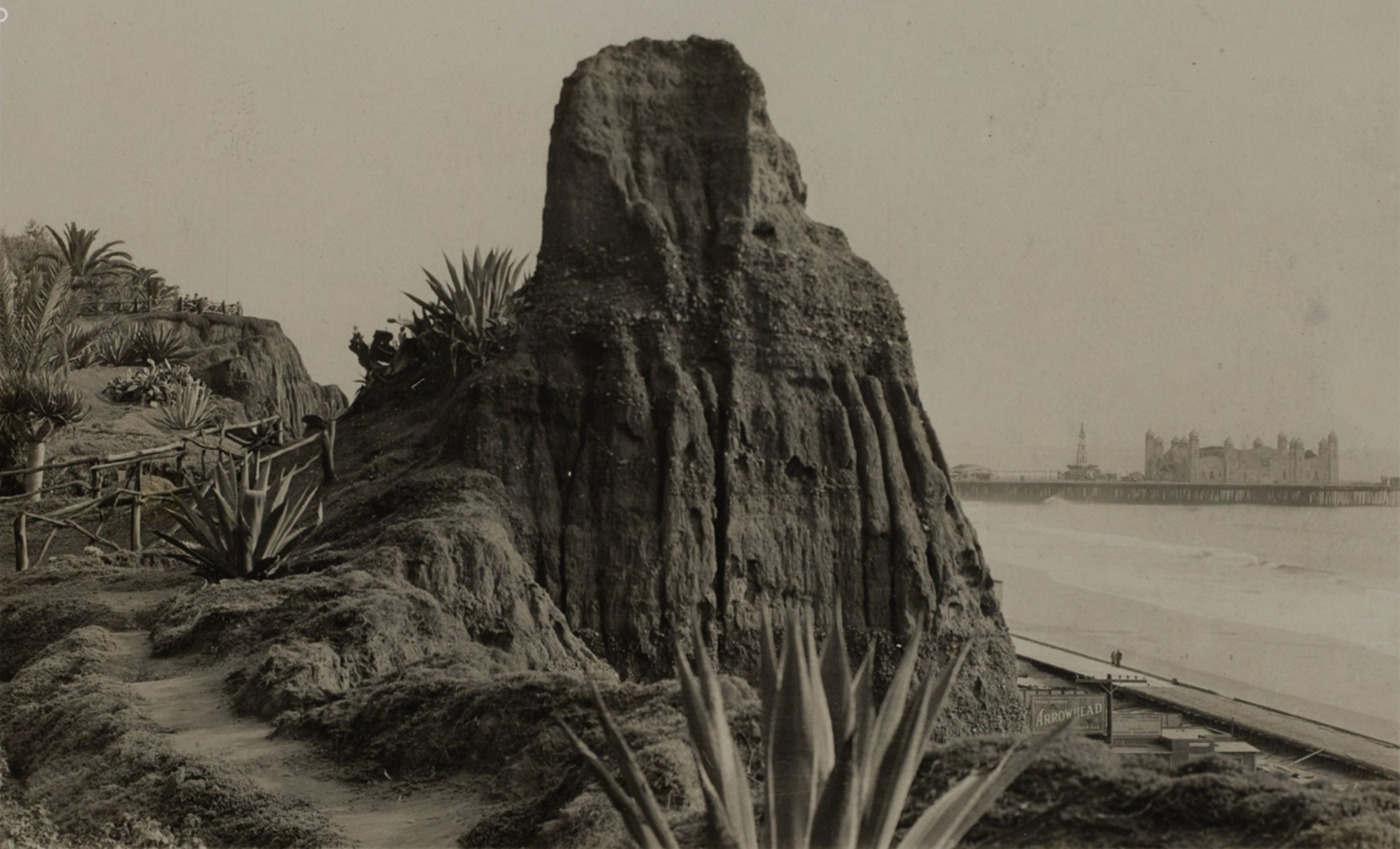 |
|
| (ca. 1929)* - View showing a natural alluvial formation at Palisades Park, with rustic fences in the background and the Santa Monica Pier and La Monica Ballroom visible at right. A boardwalk runs along the beach below. |
Historical Notes By the late 1920s, Linda Vista Park had been renamed Palisades Park and was well established as a scenic and recreational space. The rustic fencing seen here was first installed in the 1900s using trimmed eucalyptus limbs and became a trademark of the park’s informal charm. The La Monica Ballroom, built in 1924, was one of the largest dance halls over the ocean and added a festive backdrop to the park’s serene setting. |
* * * * * |
Ocean Park (Pier Avenue)
.jpg) |
|
| (ca. 1900)* – Panoramic postcard view showing Ocean Park. The "Wave w/ Furnished Rooms" can be seen in the background. "Lunch Counter" is on the right. |
Historical Notes Although Santa Monica and Ocean Park (South Santa Monica) were both settled at the same time (in the early 1870’s), Ocean Park’s history is somewhat independent from that of the rest of Santa Monica. Separated from the north by a gully which today is occupied by the Santa Monica Freeway, Ocean Park was initially oriented towards the beach where a series of piers and other tourist attractions were erected in 1890 to 1910. |
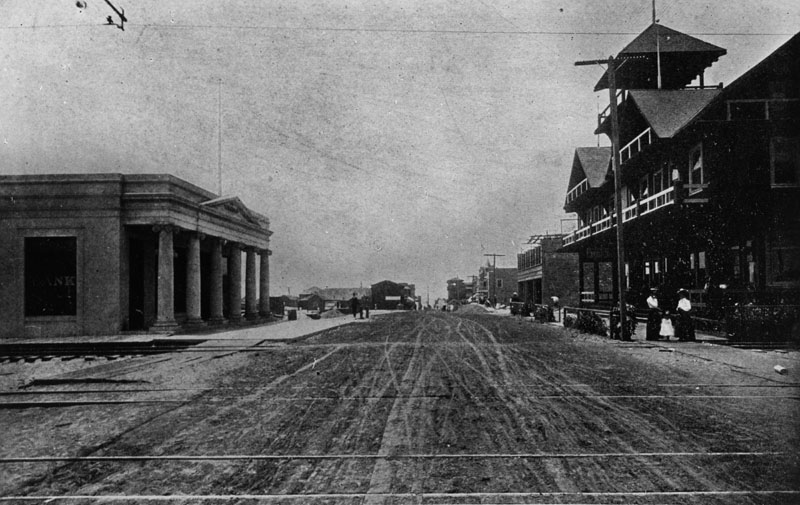 |
|
| (Early 1900s)^ - An early view down the unpaved Pier Avenue in Ocean Park. Several rail lines can be seen in the street. A bank has been built on the left and other multi-story commercial buildings on the right. The cross street is Trolley Way. |
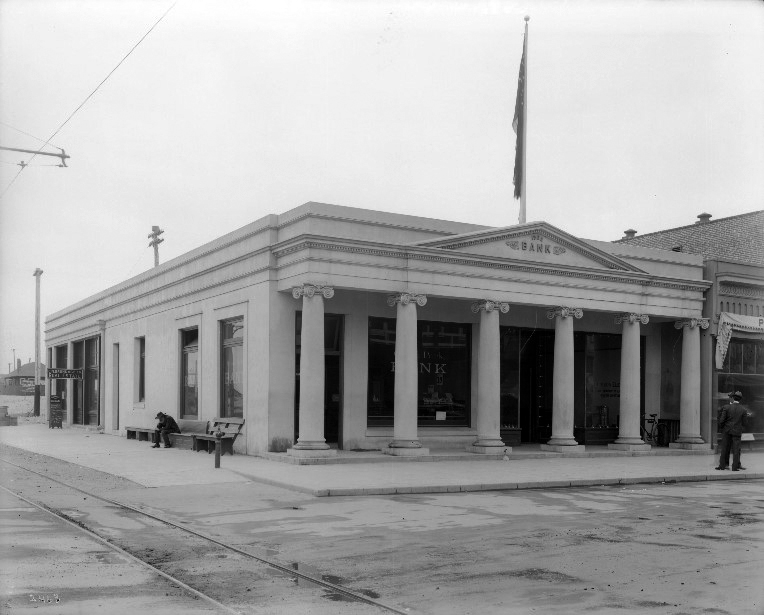 |
|
| (1905)* - View showing Ocean Park Bank located on the southwest corner Pier Avenue and Trolley Way. A man is sitting on a bench on the side of the bank in front of the tracks. The bank resembles a Greek Temple with its columns. |
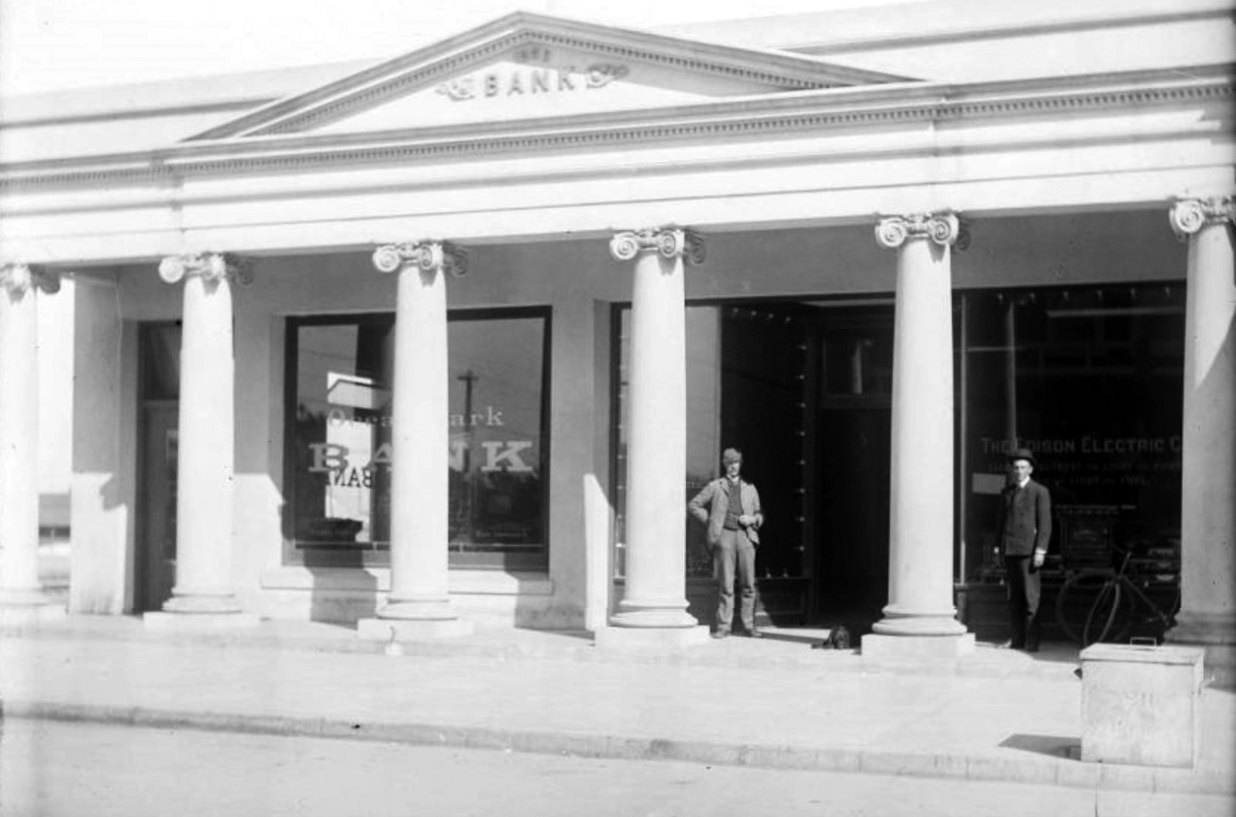 |
|
| (Early 1900s)* - View showing two men standing in front of the Ocean Park Bank on Pier Avenue. The Edison Electric Co. shared the building with Ocean Park Bank. |
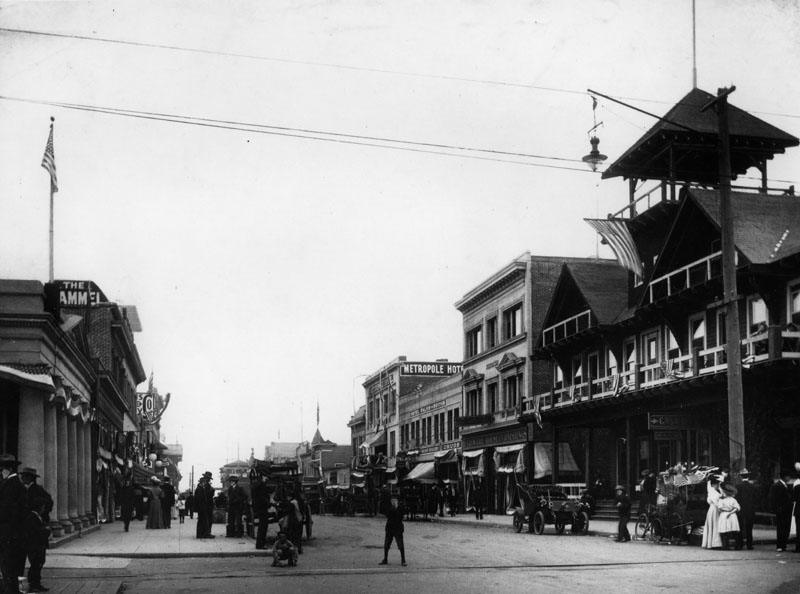 |
|
| (1905)* - A view down Pier Avenue showing additonal buildings from what was seen three photos back. The street is filled with pedestrians. Cars and horse-drawn carriages are parked in front of the stores on both sides of the street. |
Historical Notes One of the city’s oldest neighborhoods, Ocean Park sprang to life with Abott Kinney’s 1891 Ocean Park Development Company. Kinney bought a sandy strip of land in Santa Monica’s southwestern edge and began building roads, homes, parks and piers. After 1904, Kinney moved his attention to his Venice of America development (also called Ocean Park at the time), south of the Santa Monica city boundary. The history of Venice and Ocean Park are intertwined. |
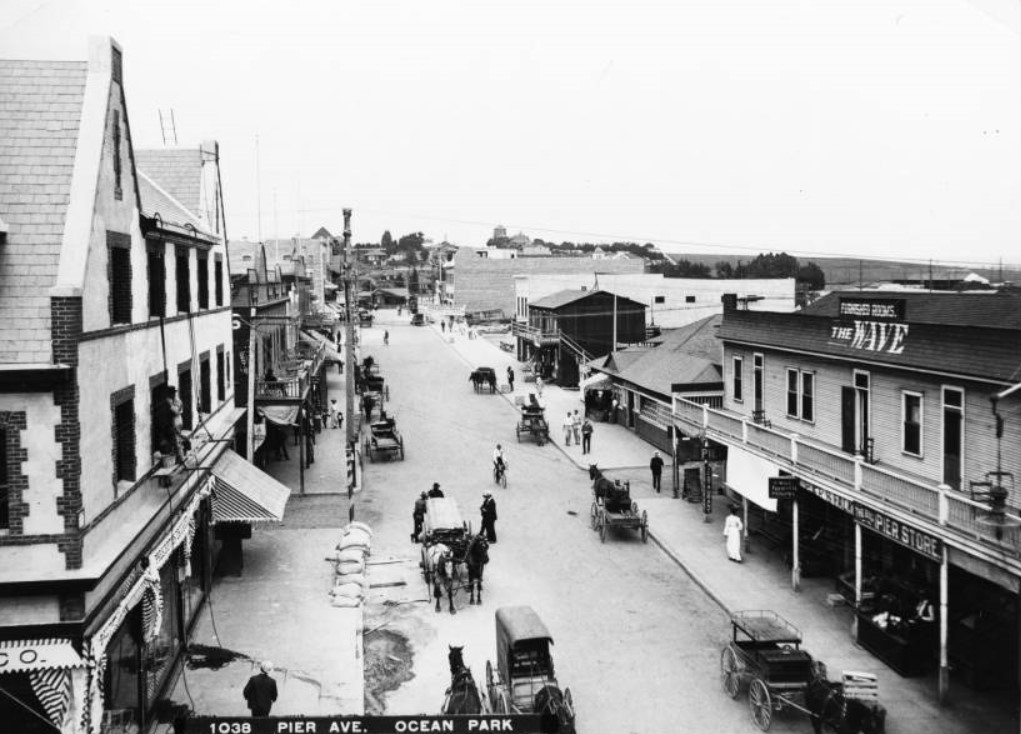 |
|
| (1904)* – Birdseye view of Pier Avenue in Ocean Park showing many horse-drawn vehicles, September, 1904. The unpaved street is at center is being traveled by several carriages as well as pedestrians and bicyclists. Large buildings, most of which are at least two stories high, line both sides of the street. A wooden building at right has a large balcony, while a brick building at left has three stories. Sand bags are piled up near the street at left.; Legible signs include, from left to right, "Pier Restaurant", "Wave Furnished Rooms", and "The Big Pier Store". |
Historical Notes The southern part of Santa Monica, commonly known as “Ocean Park,” was already an important business center as well as a popular summer resort. With the completion of the bath house and the Decatur Hotel, the building of the Masonic block and many other business blocks on Pier Avenue, Marine street and the ocean front began to put on a metropolitan aspect. |
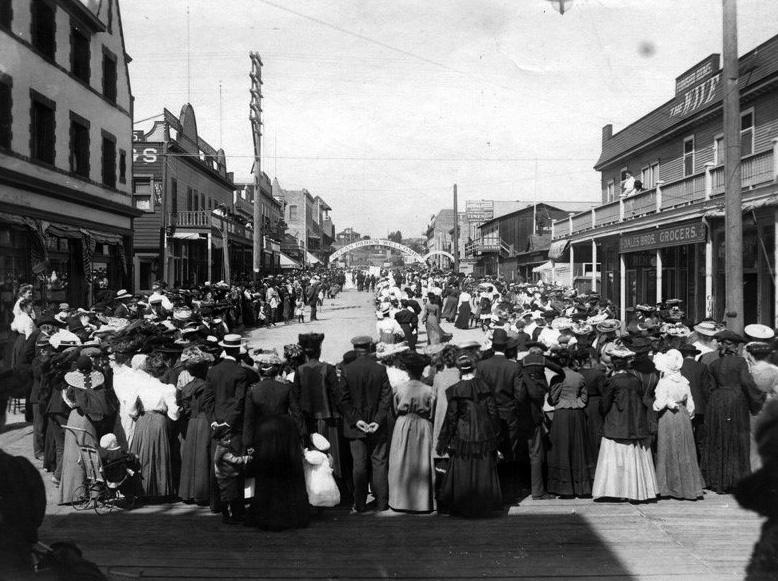 |
|
| (ca. 1905)* – View showing Pier Avenue with a crowd of men, women and children (including baby in a baby carriage waiting for some type of parade. The banner over the street reads “Ocean Park’s Welcome”. Buildings include: Dales Bros. Grocers, The Wave (furnished rooms), lunch room. |
.jpg) |
|
| (1915)* - Looking east on Pier Avenue, Ocean Park, Santa Monica. The Wave is on the right. |
.jpg) |
|
| (1915)* – Closer view of Pier Avenue, looking east, showing a line of cars backed up against the curb. Note the new 3-bulb streetlamps. |
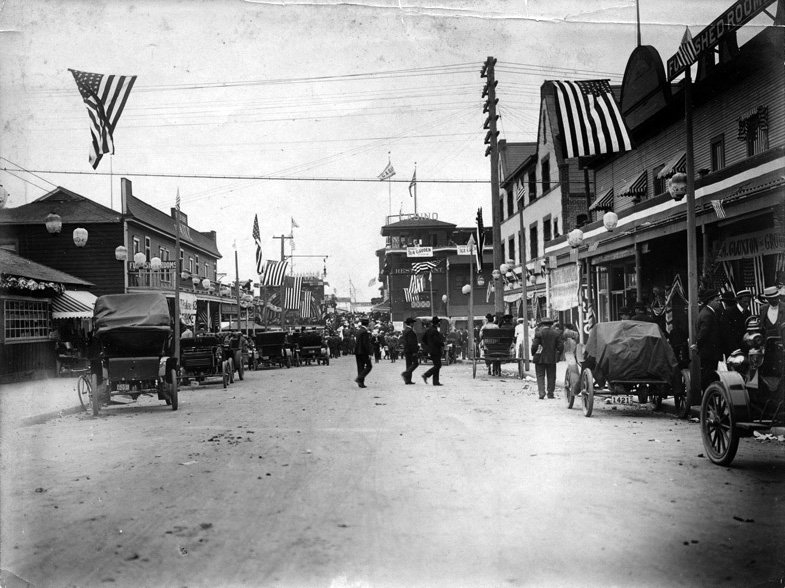 |
|
| (ca. 1905)* – View looking down Pier Avenue in Ocean Park. Horse-drawn carriages, early model cars, and people share the street with American flags and banners seen throughout. The Wave w/Furnished Rooms is on the left. |
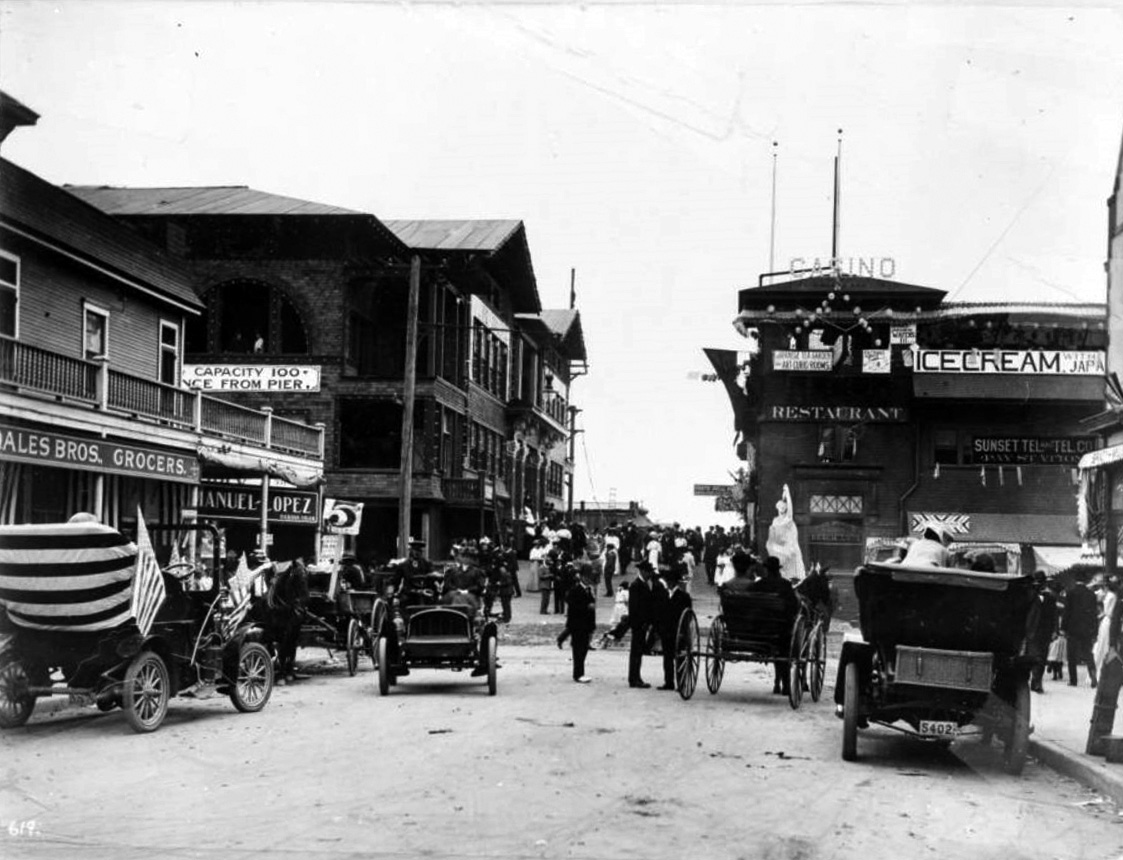 |
|
| (1905)* - View showing businesses, automobiles, and horse-drawn carriages on Third Street and Pier Avenue at Ocean Park in Santa Monica. Visible signs include "Ocean Park Improvement Company Headquarters Beach Lots" "Casino" "Japanese Tea Garden and Art Curio Rooms, " "Sunset Tel. and Tel. Co. Pay Station" "Manuel-Lopez Habana Cigar" and "Dales Bros. Grocers." There is a statue of a woman at center right. |
 |
|
| (ca. 1905)* - View showing Casino Restaurant, theatre, beach crowded with sunbathers, ferris wheel and Pier Avenue in the background. The "Wave w/Furnished Rooms" is on the right. |
.jpg) |
|
| (ca. 1905)* – View the Casino restaurant and bandstand at Ocean Park in Santa Monica. Crowds of people watch a performance taking place on the bandstand which is decorated with flags and bunting. A wharf extends behind the theatre. |
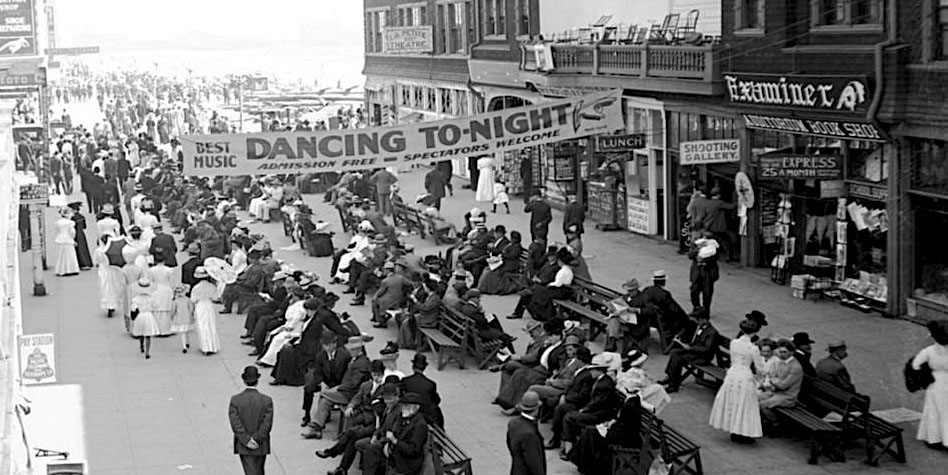 |
|
| (ca. 1907)* - View of the Ocean Park Promenade in Santa Monica showing how people went for a walk at the beach – fully dressed with hats, collars, ties, and floor-length dresses. The balcony at top right is where a band would play for the people down below. |
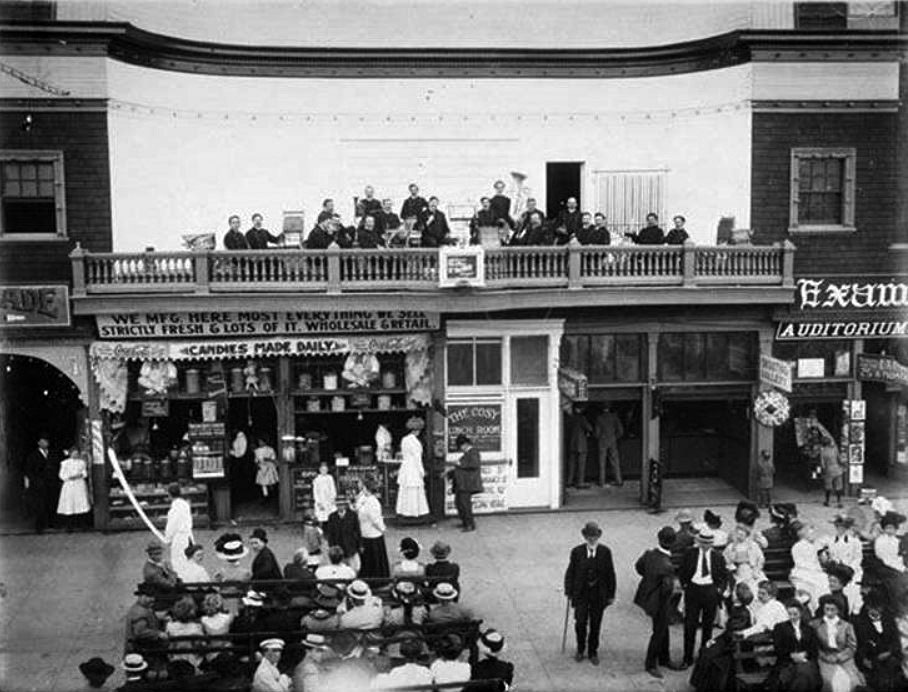 |
|
| (1909)* – View showing Frank McGarry's candy store and Band Plaza, located in Ocean Park between Pier Avenue and Marine Streets. Frank Gregory was the Band Director of the Lincoln Park Band. |
Historical Notes Click HERE to see more Early Views of Ocean Park in Santa Monica |
* * * * * |
Venice Pier
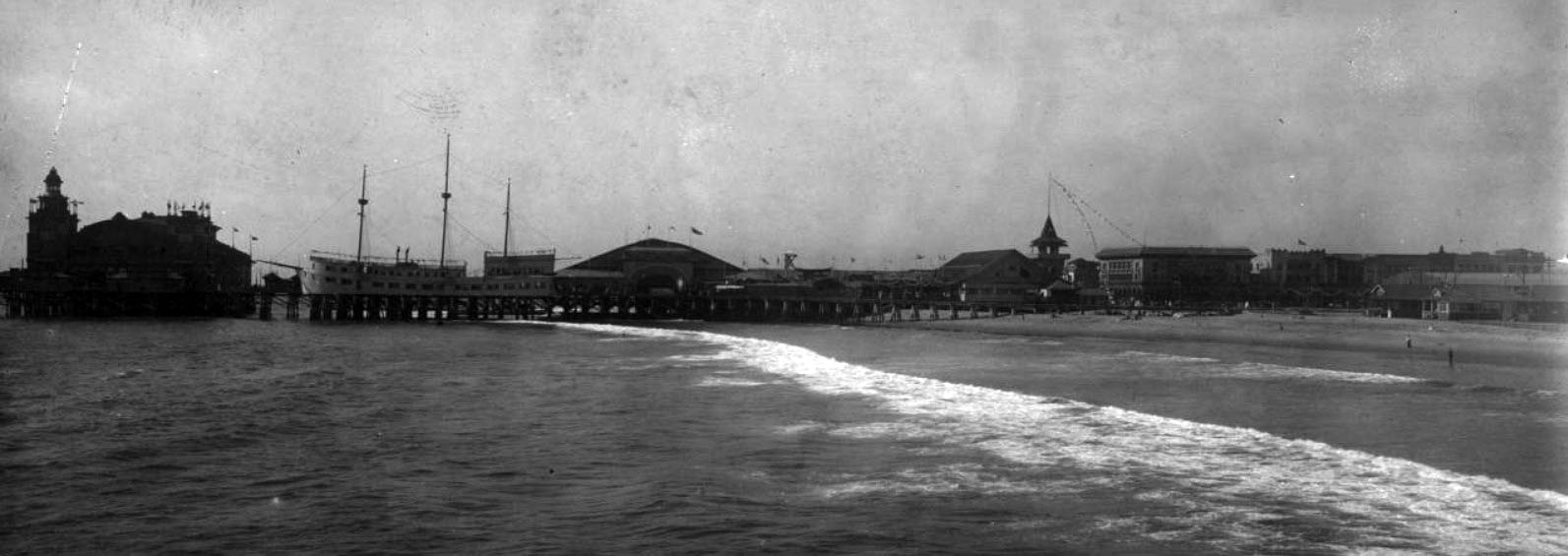 |
|
| (ca. 1905)** - Panoramic view looking north at the Pier at Venice Beach showing the amusement park and beach. The Ship Cafe is seen on the left. |
Historical Notes Among the South Bay piers, the most notable in this period was Abbot Kinney's Venice of America pier, started in 1904 and built to rival his former partner's Ocean Park Pier. Located at the end of Windward Avenue in Venice, Kinney's pier was 900 feet long, 30 feet wide and included an Auditorium, large replica Ship Cafe, Dance Hall, Dentzel carousel, a Japanese Tea House and an Ocean Inn Restaurant. Venice soon became considered its own neighborhood.*^ |
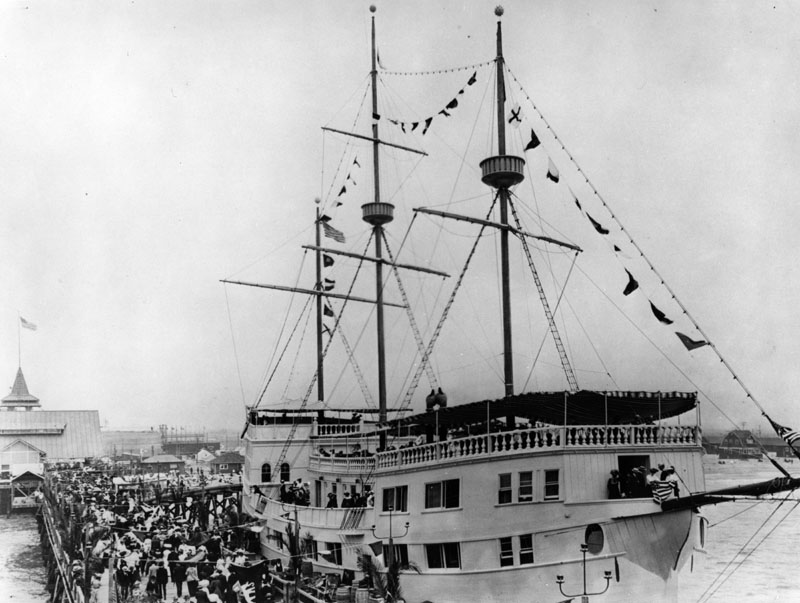 |
|
| (1905)* - A big crowd is seen behind the large restaurant ship which was a replica of Juan Cabrillo's Spanish galleon. People can also be seen aboard the ship which was located in Venice at the Abbot Kinney Pier. |
Historical Notes Venice of America was founded by tobacco millionaire Abbot Kinney in 1905 as a beach resort town. He and his partner Francis Ryan had bought two miles of oceanfront property south of Santa Monica in 1891. They built a resort town on the north end of the property called Ocean Park, which was soon annexed to Santa Monica. After Ryan died, Kinney and his new partners continued building south of Navy Street in the unincorporated territory. After the partnership dissolved in 1904, Kinney built on the marshy land on the south end of the property, intending to create a seaside resort like its namesake in Italy.*^ |
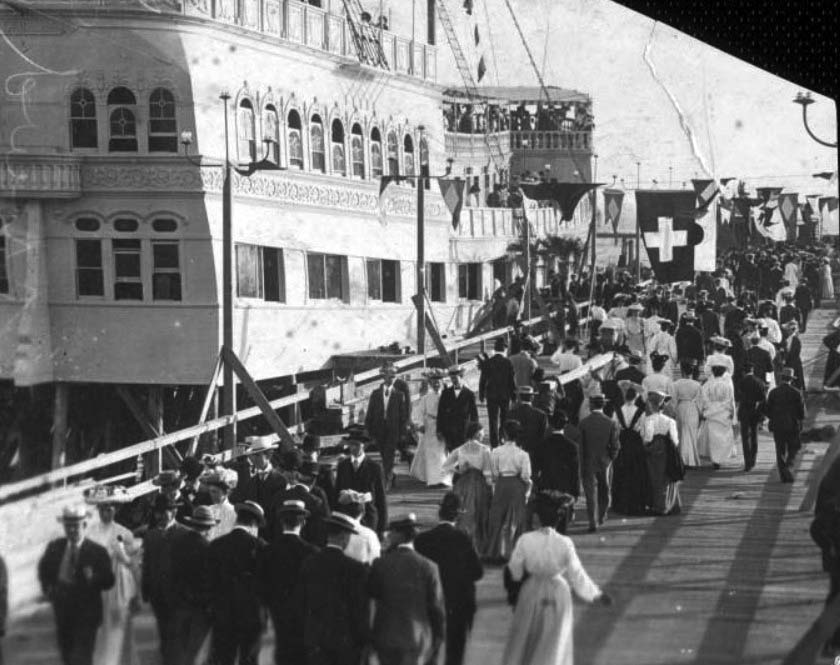 |
|
| (1906)** – Closer view showing a large number of well-dressed people walking on Abbot Kinney’s Venice of America pier alongside the Ship Café. Handwritten note on verso reads: "Ship Cafe / Venice, Cal. / 12-16-06" |
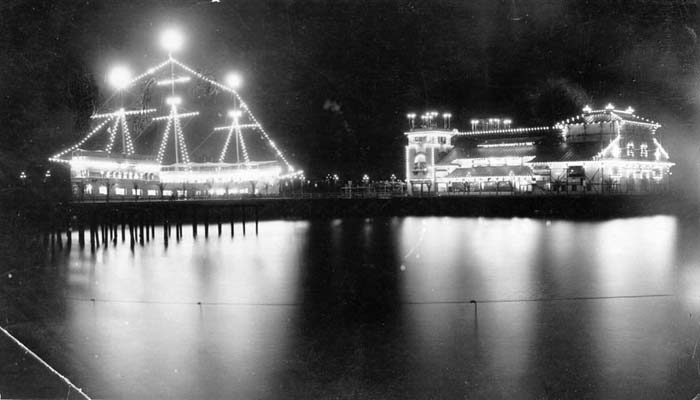 |
|
| (1905)* - Nigthtime view of Abbott Kinney's Pier in Venice. The pier was destroyed by fire in 1920. |
Historical Notes When Venice of America opened on July 4, 1905, Kinney had dug several miles of canals to drain the marshes for his residential area, built a 1,200-foot long pleasure pier with an auditorium, ship restaurant, and dance hall, constructed a hot salt-water plunge, and built a block-long arcaded business street with Venetian architecture. Tourists, mostly arriving on the "Red Cars" of the Pacific Electric Railway from Los Angeles and Santa Monica, then rode Venice's miniature railroad and gondolas to tour the town.*^ |
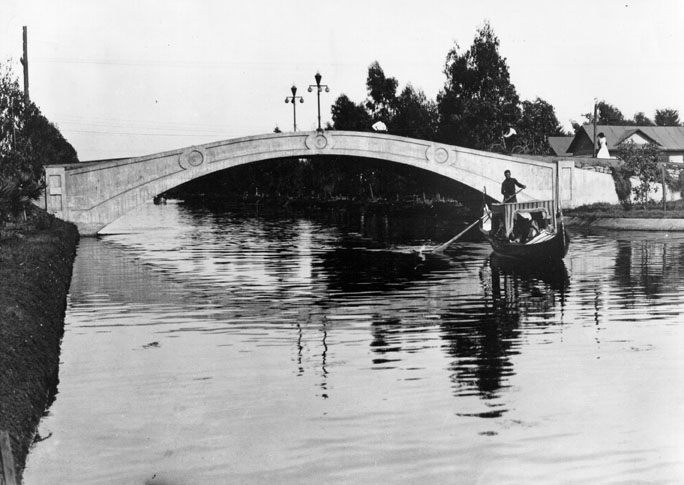 |
|
| (ca. 1905)*^ - A gondolier and boat passes under one of the bridges on the canal route. At the same time a pedestrian and a bicycle rider are passing over the bridge. |
Historical Notes The beautifully lit canals with gondoliers and arched bridges drew widespread publicity and helped sell lots in Kinney’s Venice development. However, as the automobile gained in popularity, the canals were viewed by many as outdated, and the bulk of the canals were filled in 1929 to create roads.*^ Click HERE to see more Early Views of the Venice Canals (1904+). |
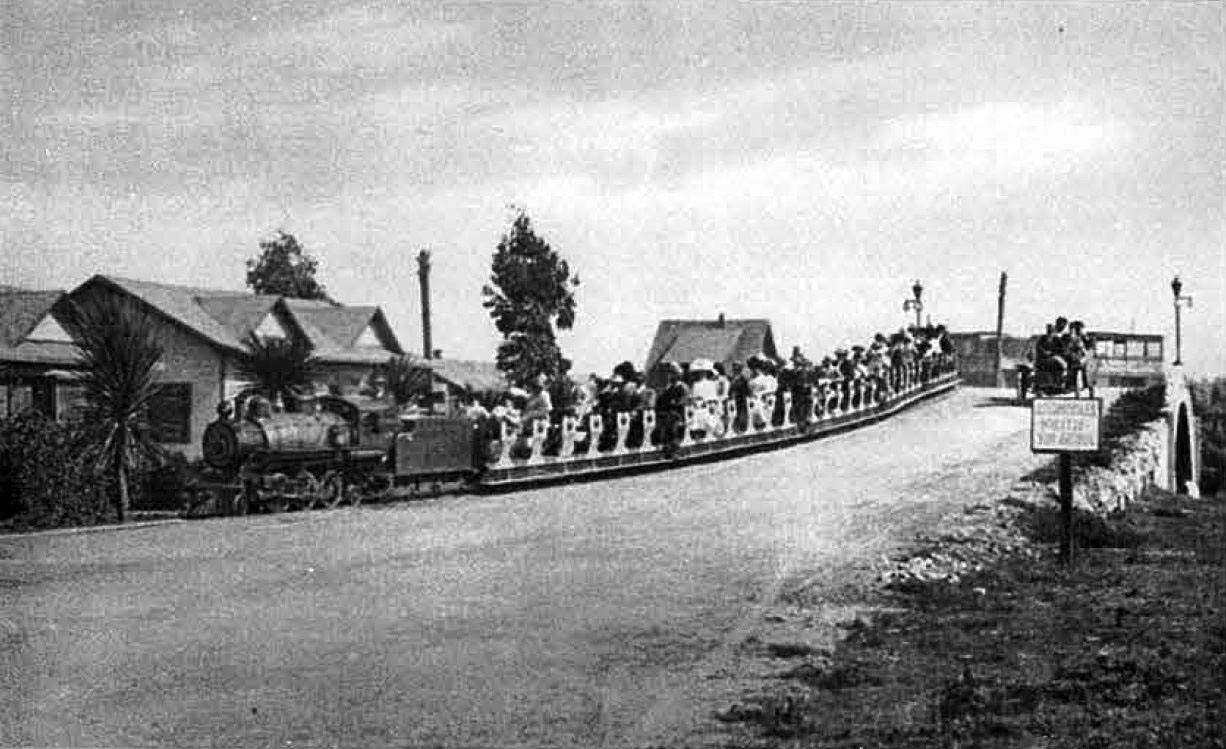 |
|
| (ca. 1905)*#** - View of the Venice Miniature Railway train crossing over a Venice Canal bridge on its way back to Windward Avenue at the Venice of America Amusement Park. |
Historical Notes When Abbot Kinney was building Venice in 1905, he decided that his new resort should have an internal transportation system to shuttle visitors and residents around town. He turned to John J. Coit who operated a successful eighteen inch gauge (1/3rd scale) miniature steam railroad at Eastlake Park (now Lincoln Park) in Los Angeles. He persuaded him to oversee the construction and management of a mile and three quarter long railroad that would take passengers from the Windward Avenue business district on a loop across canal bridges and through the canalled residential district, then return via a loop up Washington Boulevard, past its Lake Avenue maintenance yard and back to the Windward station along Mildred Avenue.*#*#* |
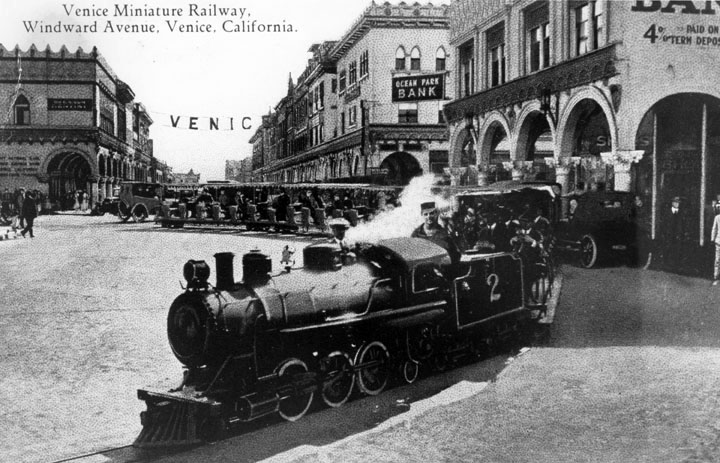 |
|
| (1912)* - Postcard view of the Miniature Railway on Windward Avenue in Venice. The miniature railroad would carry passengers for trips around the Venice streets, including Windward Ave. as shown here, and around the canal area. |
Historical Notes The cost of a trip around Venice was five cents, although residents could buy a book of tickets for $1.00 which made the run only two cents. At that time, it cost 15 cents to ride from Los Angeles to Venice on the Los Angeles Pacific Railway. *#** |
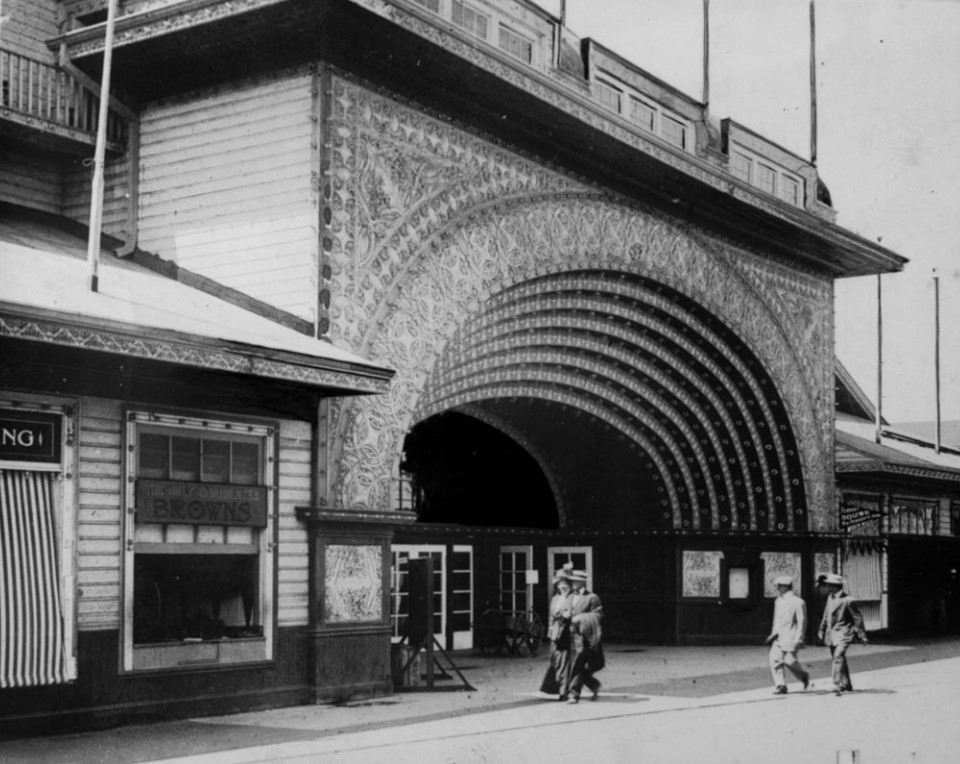 |
|
| (ca. 1905)** - Several people stroll by the Dance Hall on the Amusement Pier at Venice Beach circa 1905. "Dance Hall / Venice" -- handwritten note on verso. |
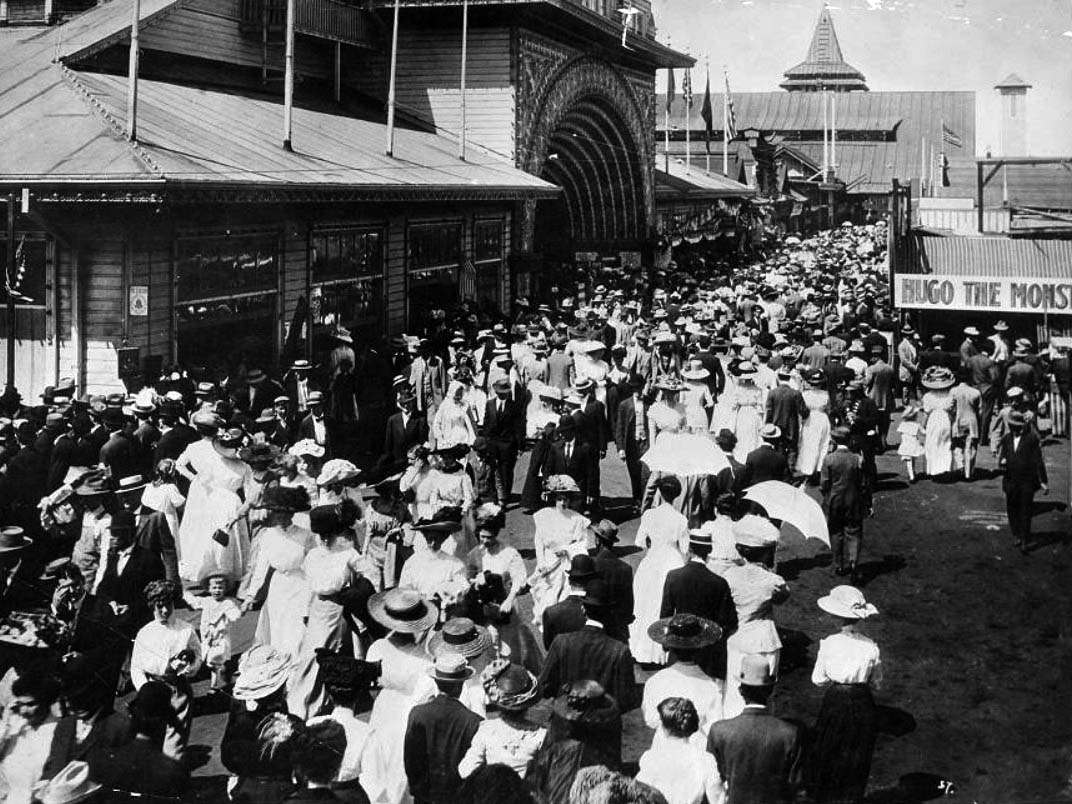 |
|
| (1908)** - Venice Pier on a crowded day with the Dance Hall seen in the background. |
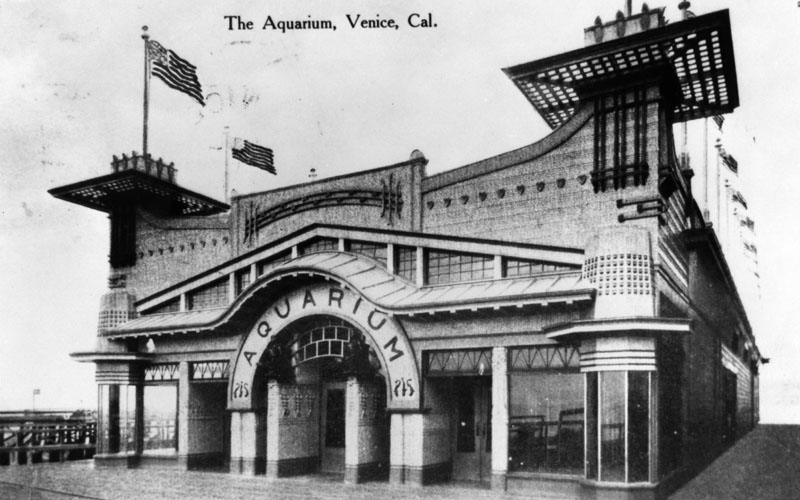 |
|
| (ca. 1908)* - A view of the front of the Aquarium, with flags flying all around the top of the building. |
Historical Notes The Venice Beach Aquarium exhibited the finest collection of marine specimens on the Pacific coast. It later became the official marine biological station for the University of Southern California.* |
Click HERE to see more in Early Southern California Amusement Parks. |
North Beach
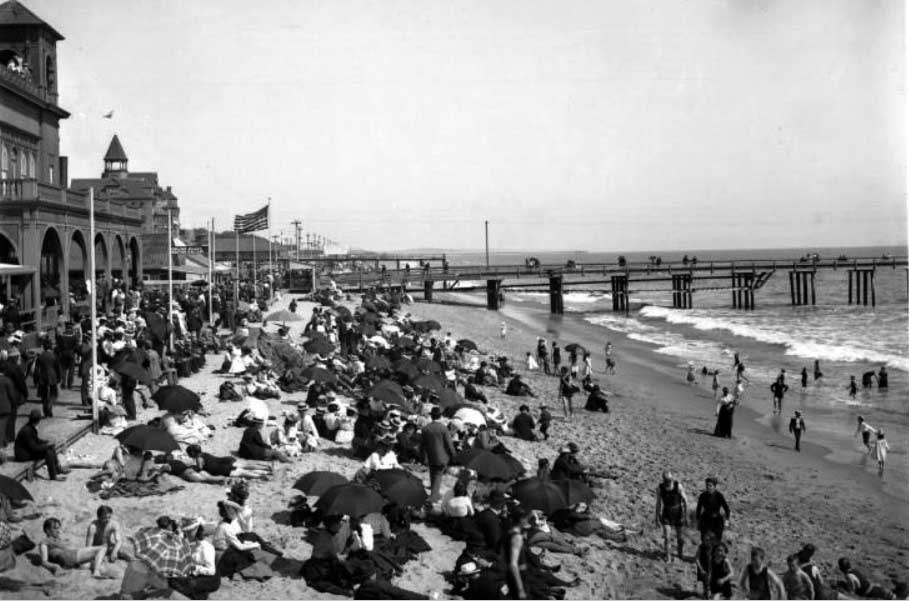 |
|
| (ca. 1900)** - View of a crowded North Beach in Santa Monica with the pier in the background. The boardwalk is also full of people enjoying what appears to be a nice day at the beach. |
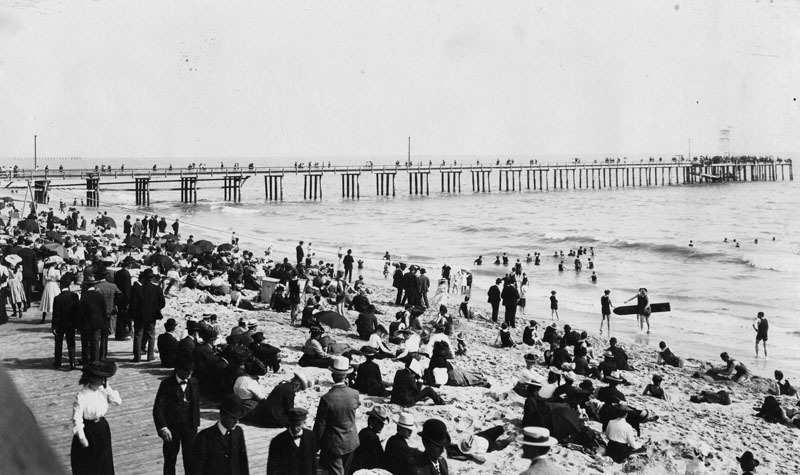 |
|
| (ca. 1900)* - Photo of men wearing suits and finely dressed women, sitting on the sand, standing and walking the boardwalk at North Beach in Santa Monica. The North Beach Bathhouse pier can be seen in the background. |
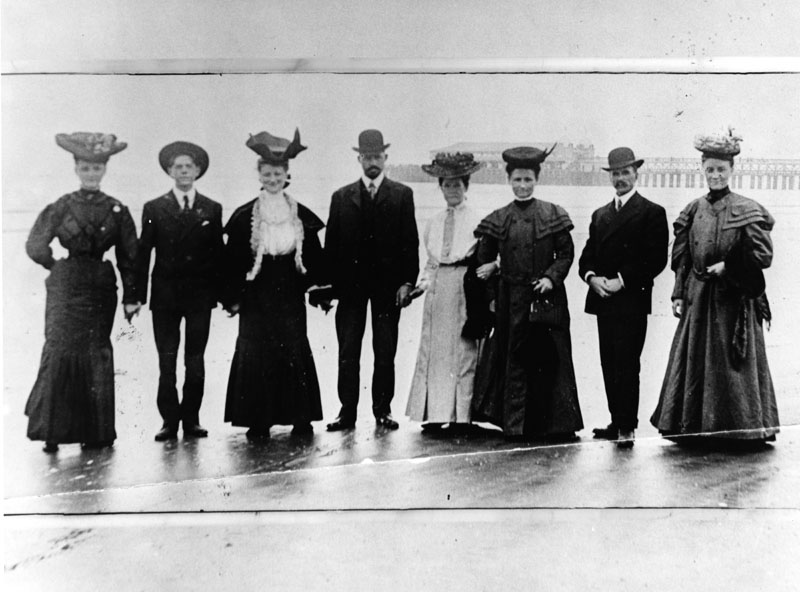 |
|
| (Early 1900s)* - Group portrait of eight people, finely dressed, standing on the beach. The pier can be seen in the background. |
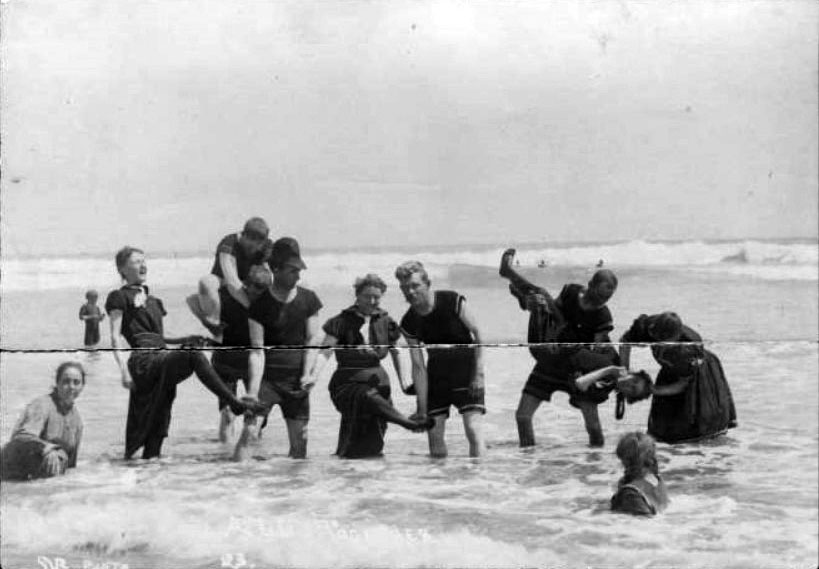 |
|
| (ca. 1900)** - View of eleven young men and women knee-deep in the ocean posing for the photographer. |
North Beach Bath House
.jpg) |
|
| (1905)* - Crowds of people wearing their fine dress are seen strolling along the boardwalk and sitting on the beach, in front of the North Beach Bath House in Santa Monica. |
Historical Notes The North Beach Bath House replaced the original Santa Monica Bath House in 1894. It was for many years the area’s favorite resort facility. A special feature was the hot saltwater baths. The admission fee was twenty-five cents. The building also housed a restaurant, a bowling pavilion and the first Camera Obscura. At the turn of the century, thousands of people were coming to visit the Santa Monica beach and its attractions.^#* |
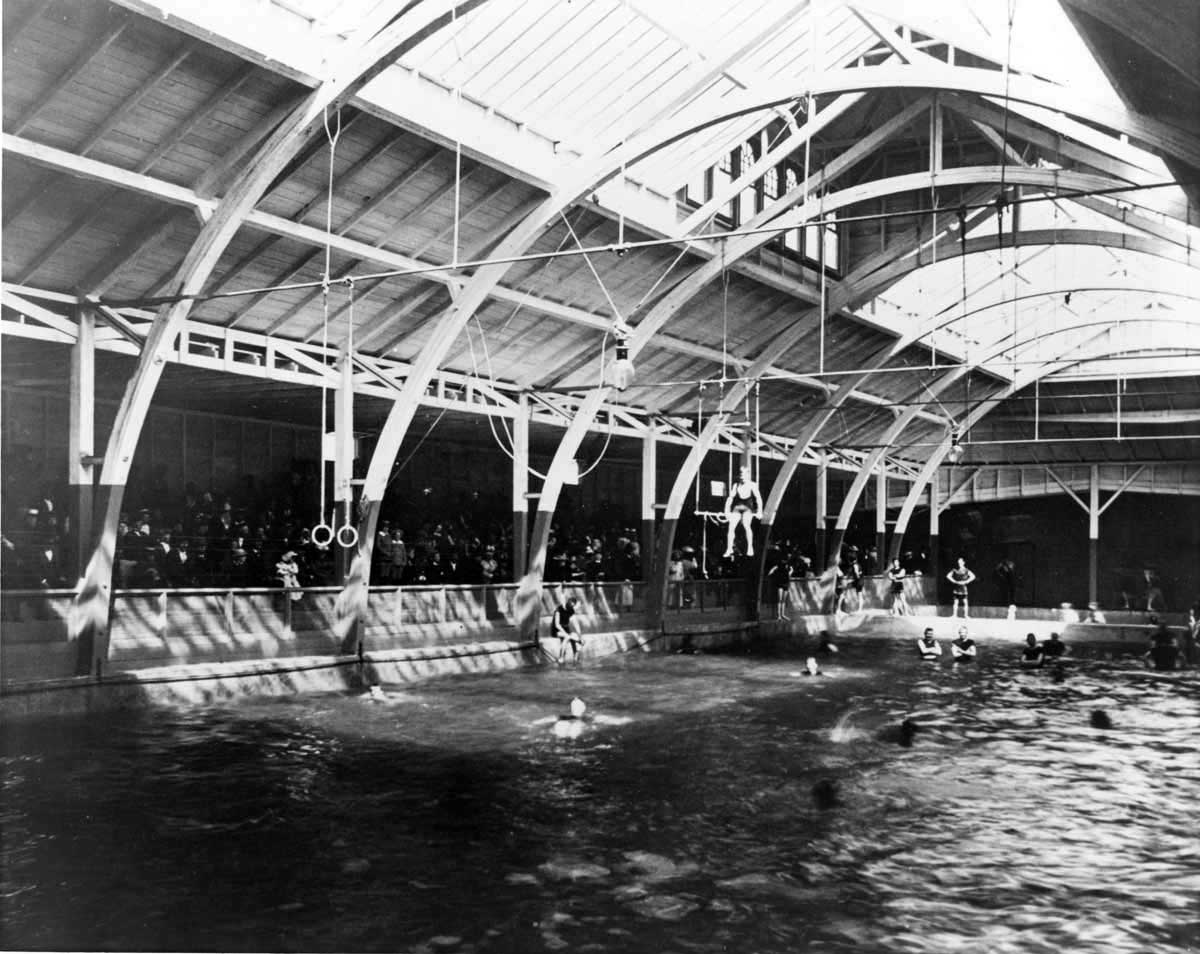 |
|
| (ca. 1900)^#* - Interior view of the North Beach Bath House. |
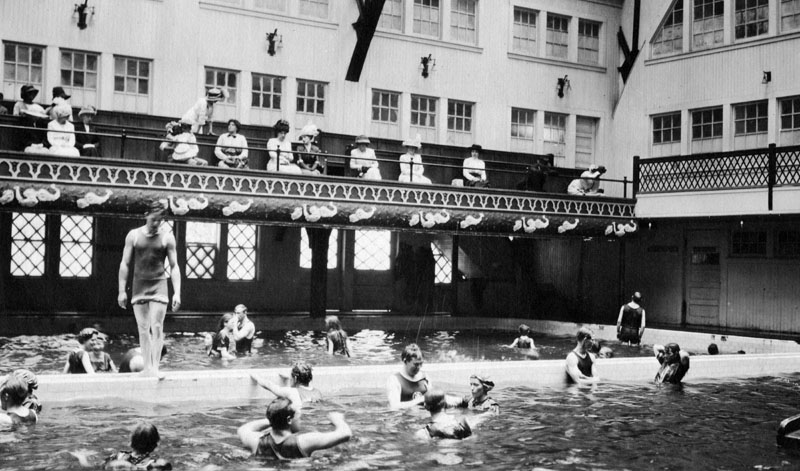 |
|
| (ca. 1900)* - View of the indoor plunge in Santa Monica-Ocean park. Several people are swimming while spectators (in street clothes) watch from the bleachers along the side. |
* * * * * |
Santa Monica Municipal Pier
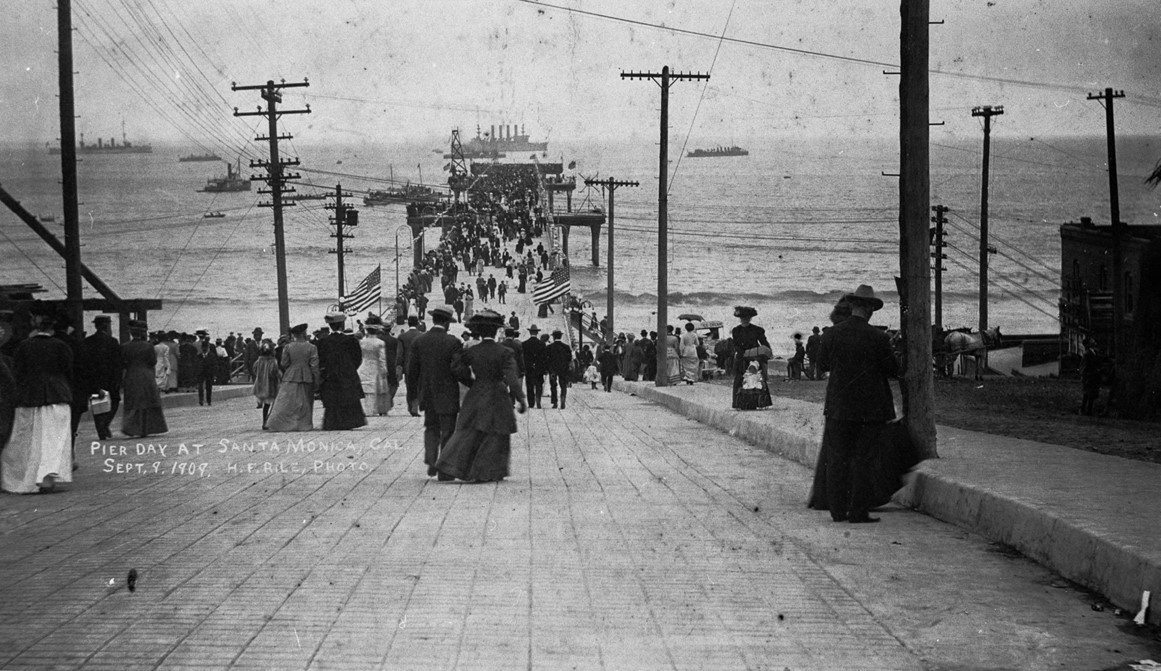 |
|
| (1909)* - View showing people walking onto the Santa Monica Municipal Pier on Pier Day, September 9, 1909, in Santa Monica. In the distance United States Naval vessels are seen anchored offshore for the event. From the Ernest Marquez Collection. |
Historical Notes On September 9, 1909, after sixteen months of construction, the Santa Monica Municipal Pier opened to the public. Thousands of people swarmed onto the 1,600-foot-long concrete pier to enjoy a festive day of band concerts, swimming races and the novelty of walking above the waters of the Pacific Ocean. While originally built to satisfy the City's sanitation needs, the Pier quickly became a magnet for the fishing community and fueled the imagination of many local entrepreneurs. |
 |
|
| (1909)* – View showing the Santa Monica Municipal Pier on opening day, September 9, 1909. Photo Credit: Santa Monica Pier Restoration Corporation |
Historical Notes In the early 20th century, Santa Monica faced a serious sewage disposal problem, prompting the city to build a concrete pier—the first on the West Coast—to solve it. Designed by local architect Edwin H. Warner, the 1,600-foot pier featured an outfall pipe running beneath it to carry treated waste into the ocean. Construction began in April 1908, and the pier was completed on August 18, 1909. On September 9, 1909, thousands attended the grand opening, where the pier was celebrated as a groundbreaking achievement in engineering and a symbol of the city's innovation. |
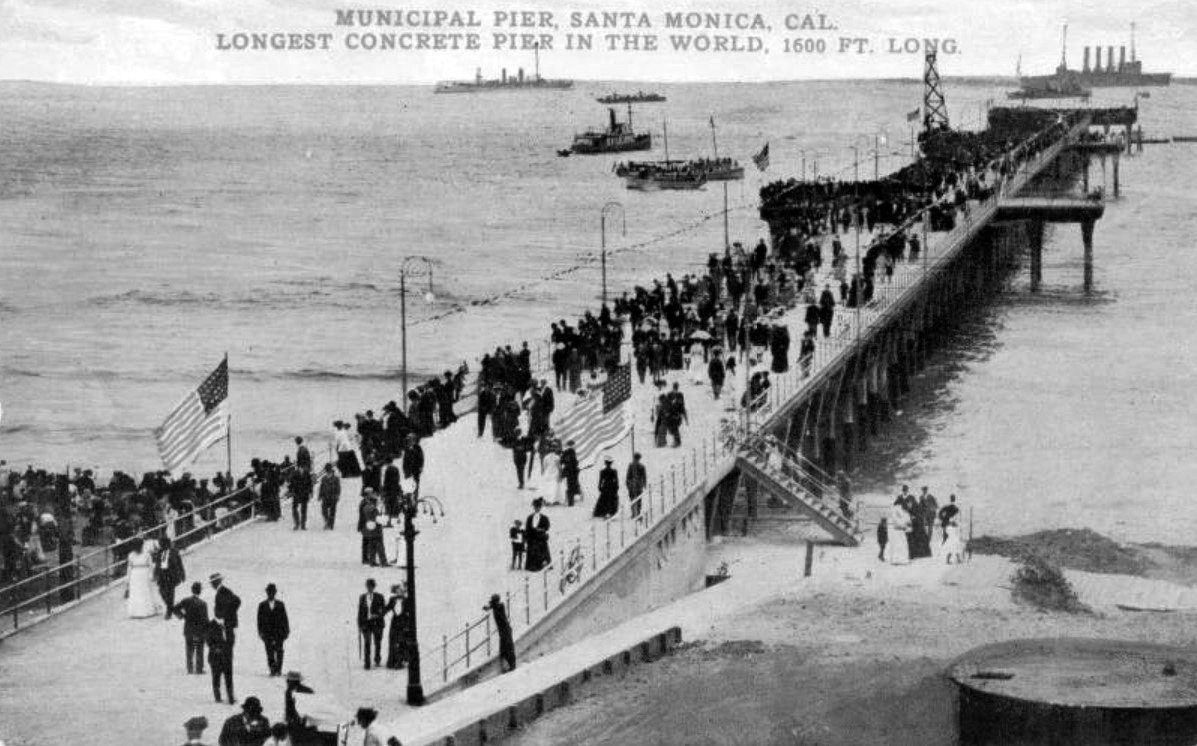 |
|
| (1909)*– Postcard view showing the newly constructed Santa Monica Municipal Pier on opening day. Heading reads: Municipal Pier, Santa Monica. Longest Concrete Pier in the World, 1600 Ft. Long. |
Historical Notes The above postcard was produced to advertise the Balloon Route Excursion, a daily trolley car site-seeing route that operated under the management of C. M. Pierce (and the Los Angeles Pacific Co.) between 1904 and 1911. Printed on front: Longest concrete pier in the world, 1600 ft. long. On reverse: Balloon Route Excursion, The Scenic Trolley Trip. Paralleling the mountains from Los Angeles to the ocean, then 36 miles along the Seashore. Parlor Cars; Reserved Seats; Competent Guides. Free Attractions - An ocean voyage on wheels, the cars running a mile into the ocean on Long Wharf, Port Los Angeles; Admission to Largest Aquarium on Pacific Coast; Ride on the L.A. Thompson Scenic Railway at Venice; Admission to Camera Obscura, Santa Monica. Last car 9:40 A.M. Daily, 429 South Hill, Los Angeles. |
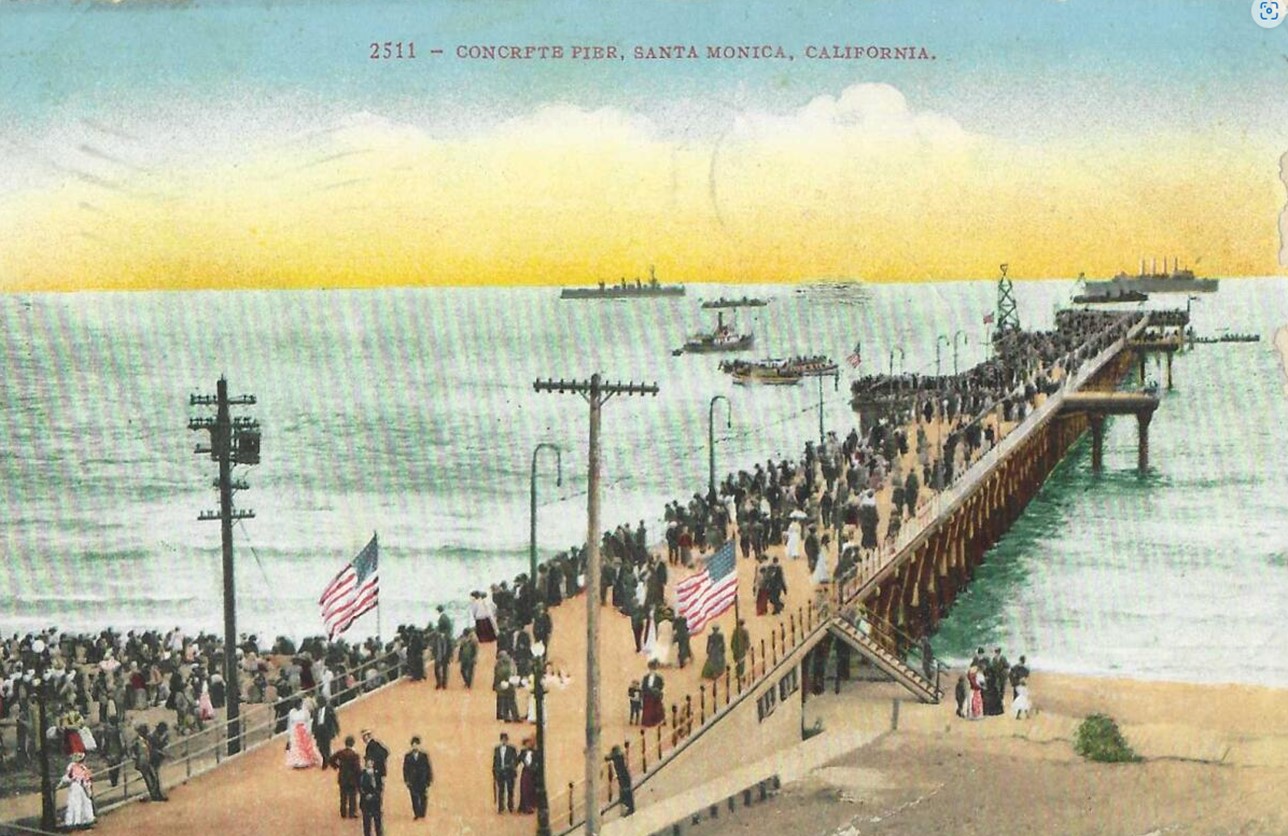 |
|
| (1909)*– Colorized postcard view showing the newly constructed Santa Monica Municipal Pier on opening day. Heading reads: Municipal Pier, Santa Monica. Longest Concrete Pier in the World, 1600 Ft. Long. |
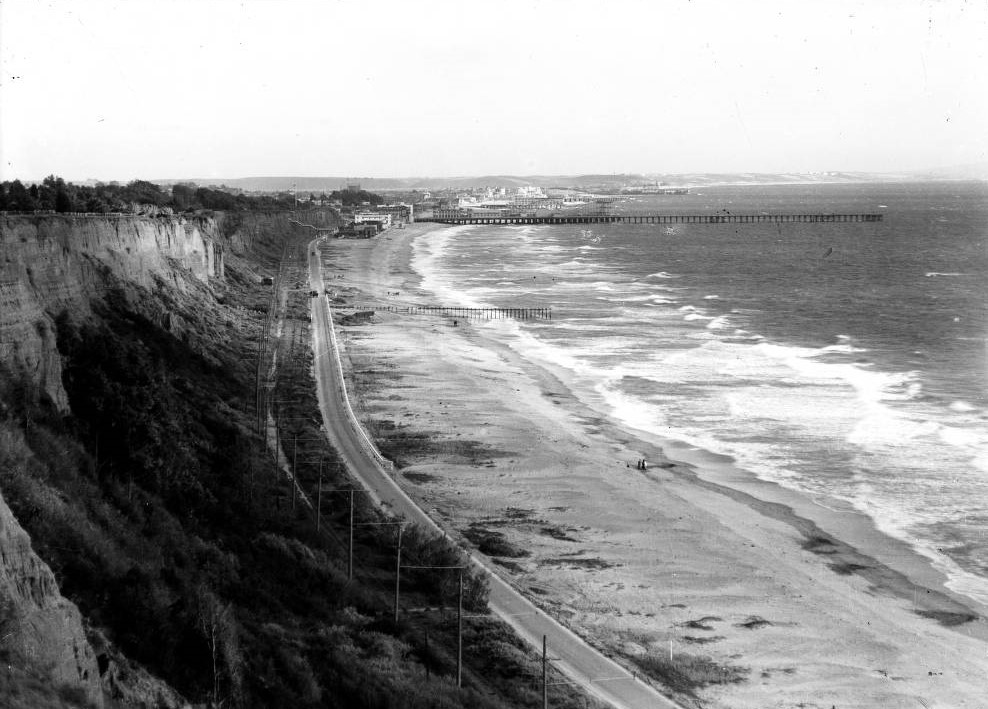 |
|
| (ca. 1909)* - View of Santa Monica Beach looking south from the Palisades. The beach is at right, and running next to it is a two-lane paved highway. Making its way parallel to the road is a railroad. There are tall cliffs at left, covered in a variety of plants and trees. A small group of buildings is visible at center near the water, and a long pier (Santa Monica Municipal Pier) juts out into the ocean from near these buildings. There is a shorter pier in the foreground, and two people can be seen walking along the sand at right. |
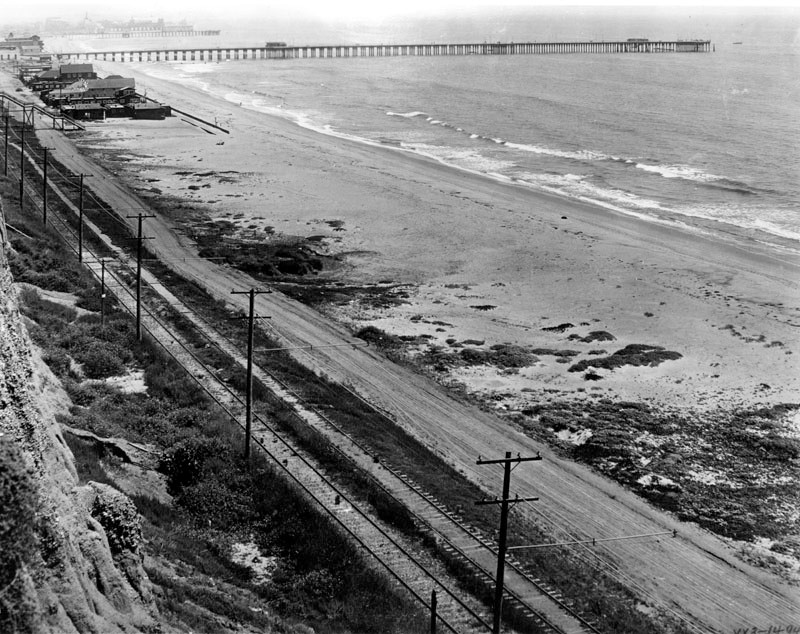 |
|
| (1915)* – Closer view showing railroad tracks running parallel to an old dirt road along the Santa Monica beach front. This site is now the Roosevelt Highway. In the background can be seen Santa Monica Municipal Pier. |
Historical Notes The Santa Monica Pier today has a rich history dating back to the early 20th century. Originally consisting of two adjoining piers with distinct purposes, the Municipal Pier (seen above) was inaugurated on September 9, 1909, primarily for utilitarian purposes like carrying sewer pipes beyond the breakers into the Pacific Ocean. However, it quickly became popular for fishing and scenic oceanfront strolls. In 1916, the southern portion, known as the Pleasure Pier or Newcomb Pier, was added by amusement park pioneer Charles I.D. Looff and his son Arthur. This section featured the iconic Looff Hippodrome, which housed a carousel and other attractions like the Blue Streak Racer roller coaster. The Looff Hippodrome remains a significant historical structure, listed on the National Register of Historic Places. Click HERE to see Early Views of the Santa Monica Pier (1917+). |
* * * * * |
Venice Beach
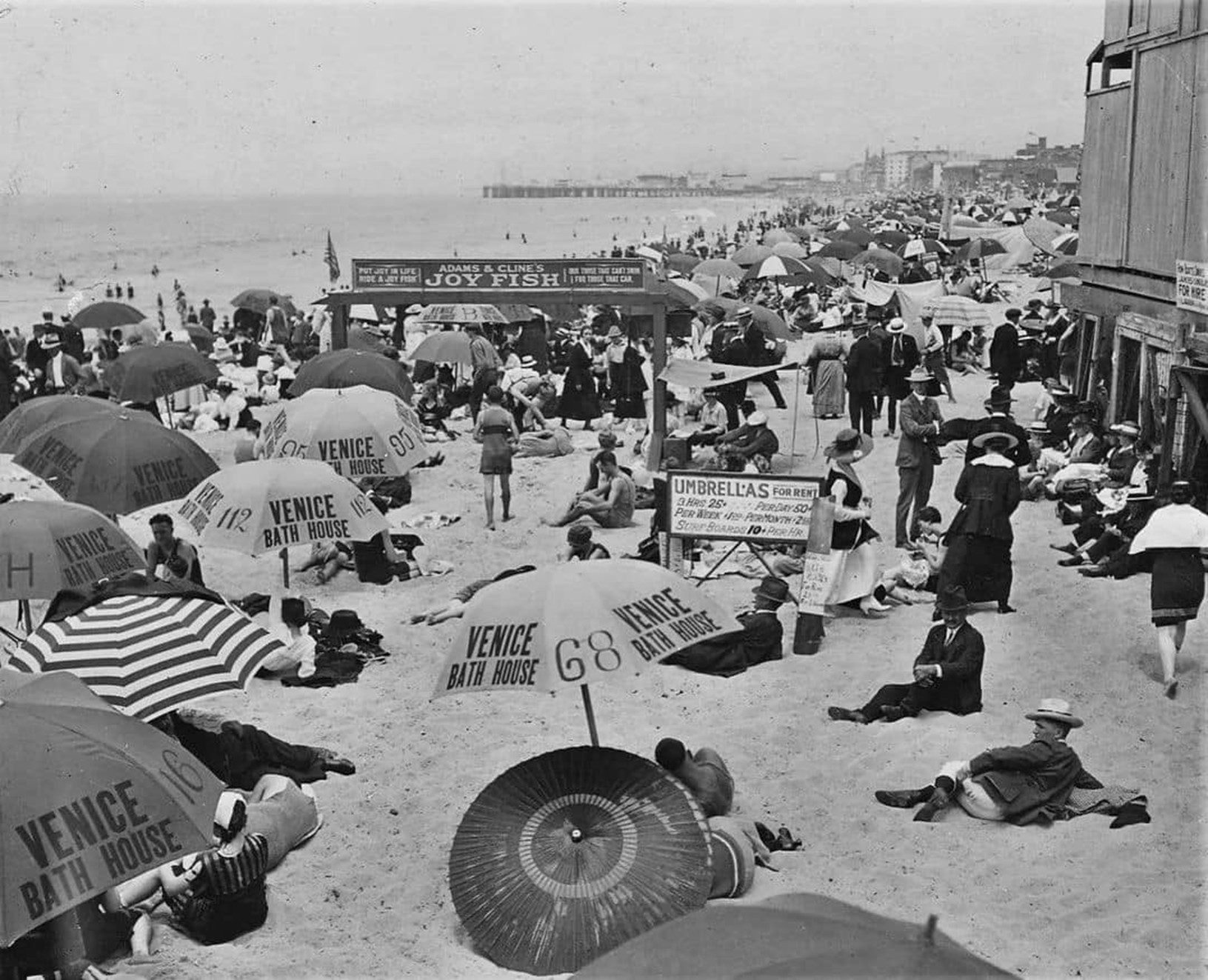 |
|
| (1910s)* – View of sunbathers enjoying an afternoon at Venice Beach in front of the Venice Bath House. Umbrellas are available for rent at 25 cents for three hours or 50 cents for the whole day. The Ocean Park Pier is visible in the distance. |
Historical Notes n the 1910s, Venice Beach, California, underwent significant transformation from a small resort town to a bustling tourist destination, with its population growing to over 3,000 residents and attracting up to 150,000 visitors on weekends. The area boasted a vibrant entertainment scene, highlighted by attractions such as Kinney Pier, which featured rides like the Virginia Reel and various amusements, as well as the scenic canals and beaches that drew crowds. |
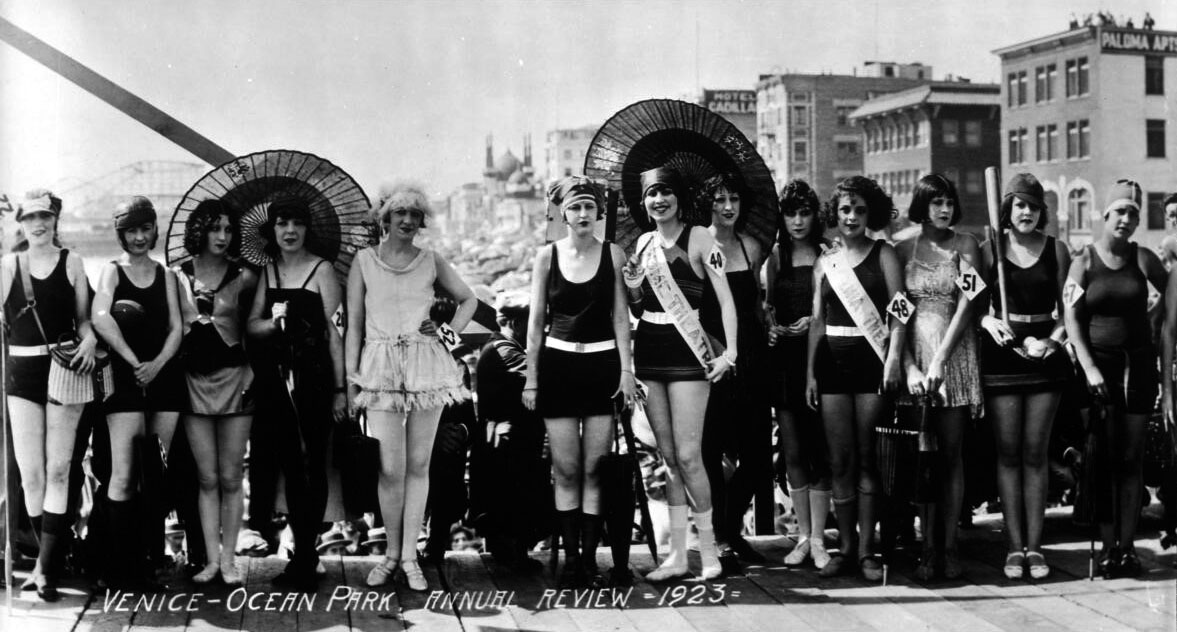 |
|
| (1923)* – Beauty contest contestants in the Venice-Ocean Park Annual Review with the Moorish-style dome of the Ocean Park Bath House seen in the background. |
Historical Notes In the 1920s, Venice Beach became a vibrant hub for bathing beauty contests, which attracted large crowds and showcased women parading in swimsuits. These contests, initially sponsored by the Los Angeles Examiner in 1912, grew in popularity, leading to events held north of the Venice Pier to accommodate thousands of spectators. Contestants competed for various prizes and titles, contributing to the beach's festive atmosphere. Interestingly, Venice also introduced male beauty pageants in 1926, offering prizes for categories such as "most handsome" and "homeliest" male. |
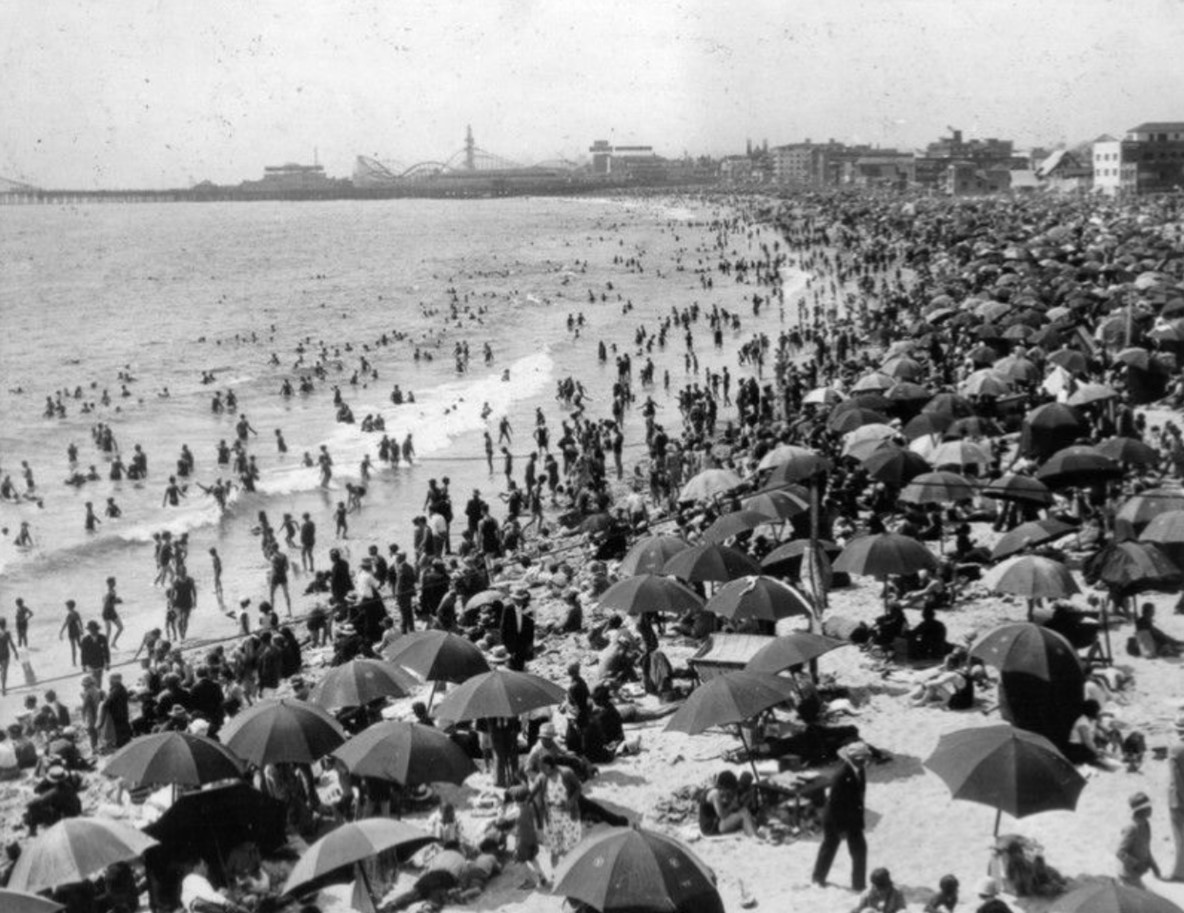 |
|
| (1925)* – The ocean is crowded with people swimming and playing, while the beach is filled with sunbathers and umbrellas. The view looks north toward Ocean Park from Venice Beach.. |
Historical Notes In the mid-1920s, Venice Beach became a bustling destination for large crowds of sunbathers, drawing between 50,000 to 150,000 tourists on weekends. This surge in visitors was largely due to Venice's appeal as a seaside resort, characterized by its mile-long beach and various attractions, including amusement piers and gondola rides. Founded by tobacco millionaire Abbot Kinney in 1905, Venice was designed to be a health-oriented resort town, and by the 1920s, it had established itself as the "Playland of the Pacific." The beach culture flourished during this period, with many beachgoers embracing sunbathing and social activities in their fashionable bathing suits. However, this increasing visibility of bathers in casual attire sometimes led to tensions with local authorities, who sought to maintain social conventions by regulating beachwear. Despite these challenges, the vibrant atmosphere at Venice Beach continued to attract a diverse crowd eager to enjoy the sun and surf. |
* * * * * |
Ocean Park Bath House
 |
|
| (ca. 1908)* – Panoramic view looking south from Ocean Park Pier in Santa Monica. The beautiful Ocean Park Bath House, built in 1905, is seen on the left. |
Historical Notes When it was built in 1905, the Ocean Park Bath House was one of the most elaborate structures on Santa Monica's beach. It was Moorish in style, 3 stories high with 5 domes. An ad from 1906 claimed it had the largest swimming pool in the US. |
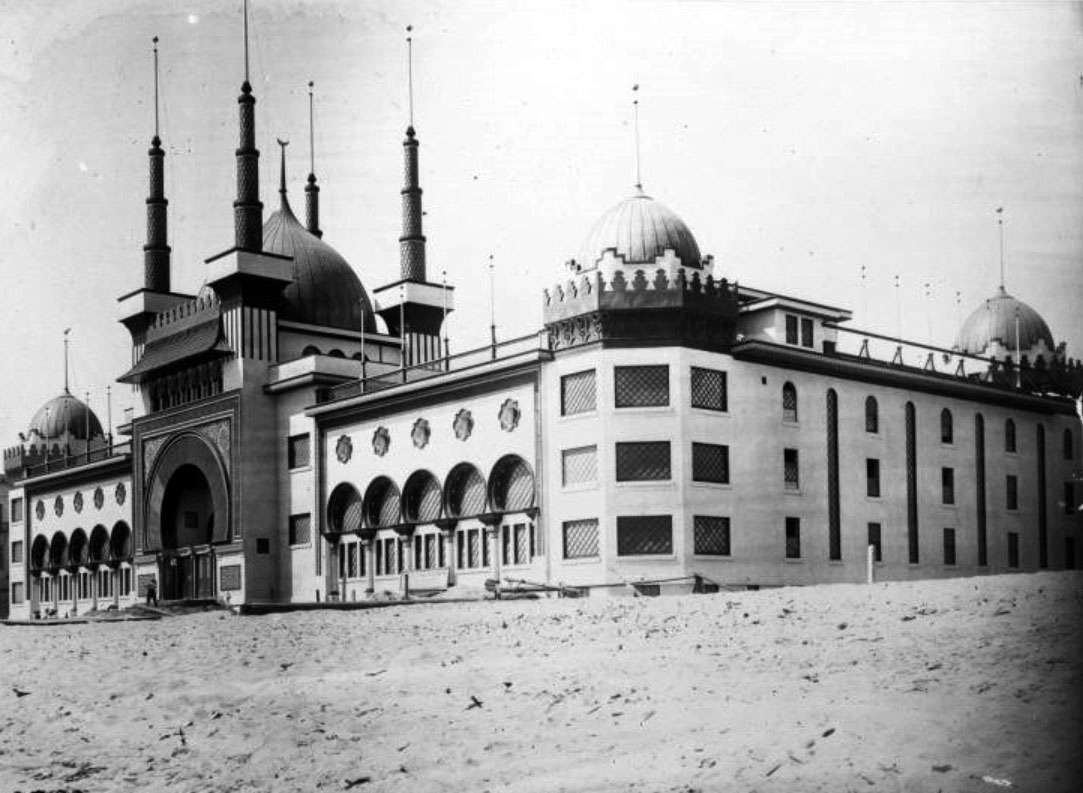 |
|
| (1905)* - View of Moorish style Ocean Park Bath House, nearing completion. Round turrets rise from each of the corners as well as over the main entrance. Rows of arched or round windows line the exterior of the three-story building on the beach. Laborers are seen working near the entry. |
Historical Notes Looking more like a movie set, the Ocean Park Bath House was one of the most talked about buildings of its day-and a great draw for the beach area. The lavish indoor plunge (heated for those who didn’t take to cooler ocean swimming) was built by A.R. Fraser. |
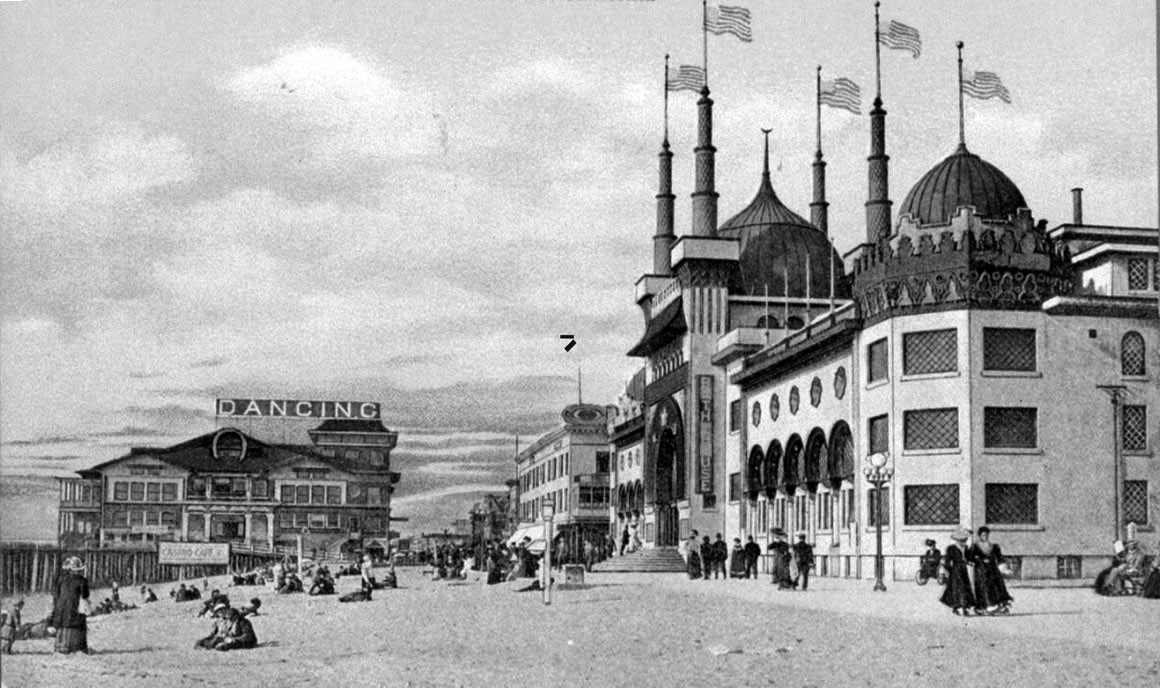 |
|
| (ca. 1909)*- Postcard view of Ocean Park beach with pier in the distance and Ocean Park Bath House on the right. |
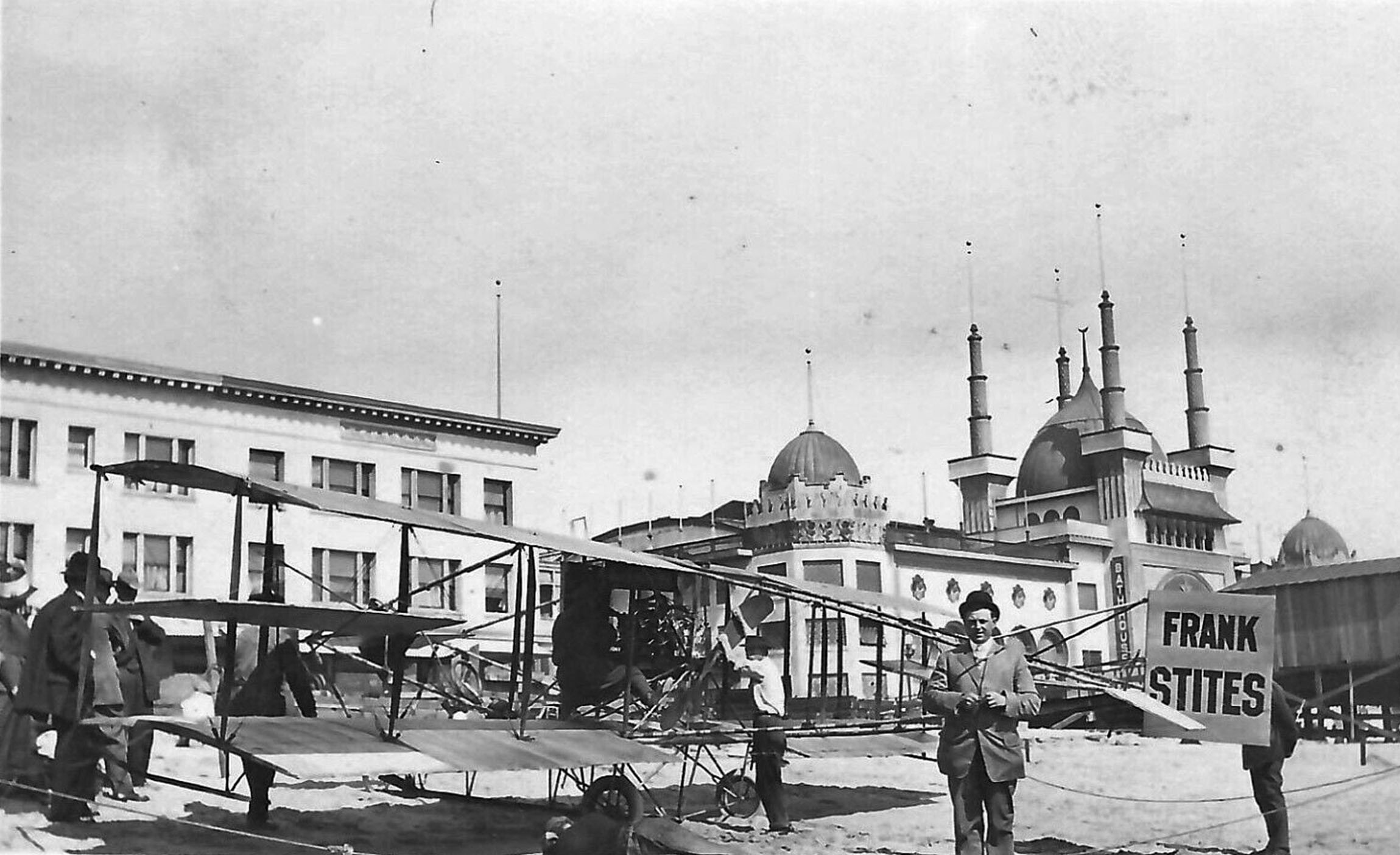 |
|
| (ca. 1909)* - Frank Stites airplane on the beach in front of Ocean Park Bath House. |
Historical Notes Daredevil pilots landed on the beach since there was no airport back then. The Kinney Company hired many. |
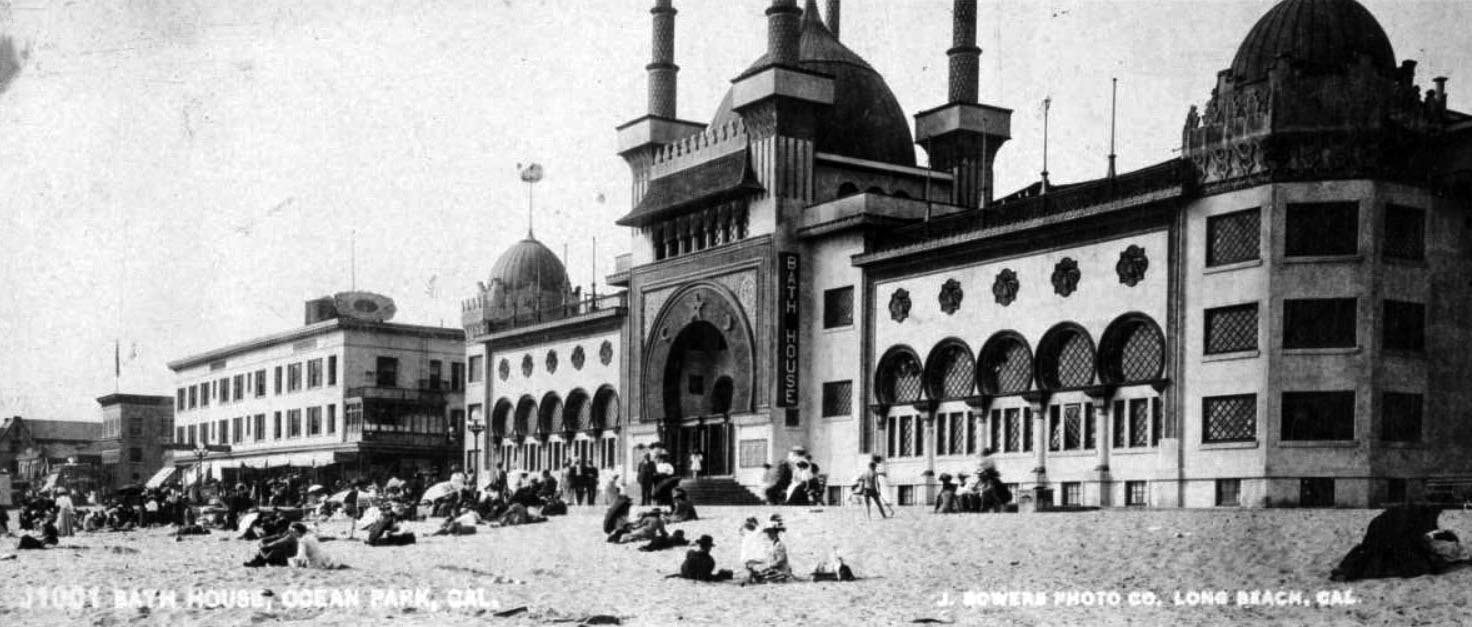 |
|
| (ca. 1910)* – Panoramic view showing people on the beach in front of the Ocean Park Bath House at Ocean Park, in Santa Monica. |
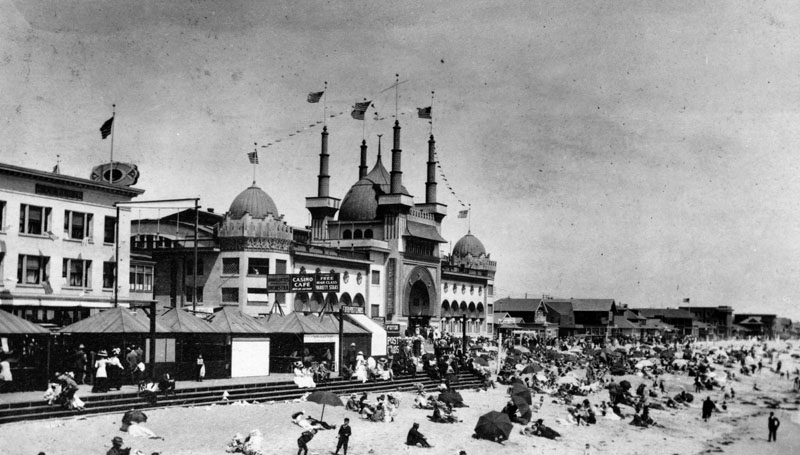 |
|
| (Early 1900s)* - Crowded shoreline in front of the Ocean Park Bathhouse at Ocean Park Beach. |
Historical Notes In 1903 Alexander Rosborough Fraser built the Ocean Park Casino, and in 1905 erected the Ocean Park Bath House. In 1906 he built the Ocean Park Auditorium, the Masonic Temple and the Decatur Hotel. In 1911 “Fraser’s Million Dollar Pier,” was completed, extending 1000 feet over the ocean and housing a multitude of amusements, including a beautiful dancing pavilion. Fraser built numerous improvements in Ocean Park, and is responsible for the construction of the concrete promenade which joins Ocean Park with Venice. |
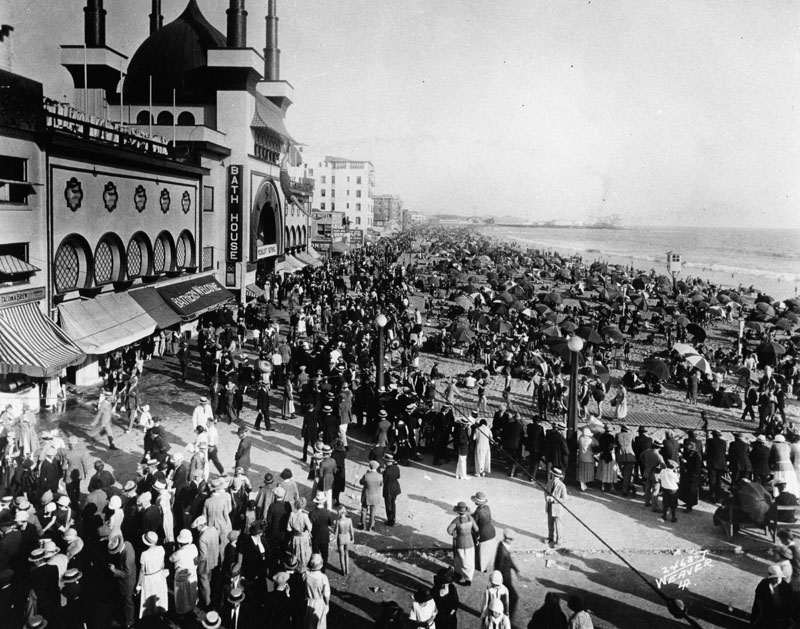 |
|
| (Early 1900s)* - Heavy crowd day on the beach and in front of the Ocean Park Bath House. |
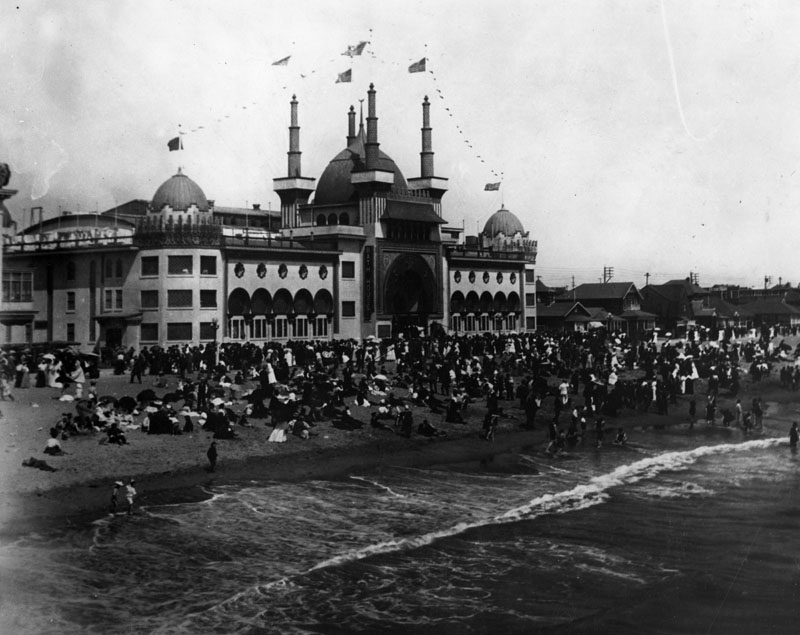 |
|
| (Early 1900s)* - Crowded beach at Ocean Park in front of the Bath House. |
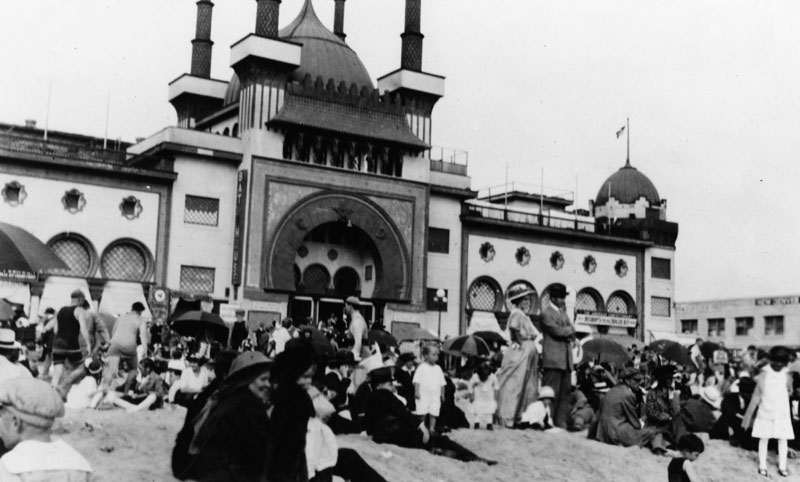 |
|
| (ca. 1910)* – Closer view showing railroad tracks running parallel to an old dirt road along the Santa Monica beach front. This site is now the Roosevelt Highway. In the background can be seen Santa Monica Municipal Pier. |
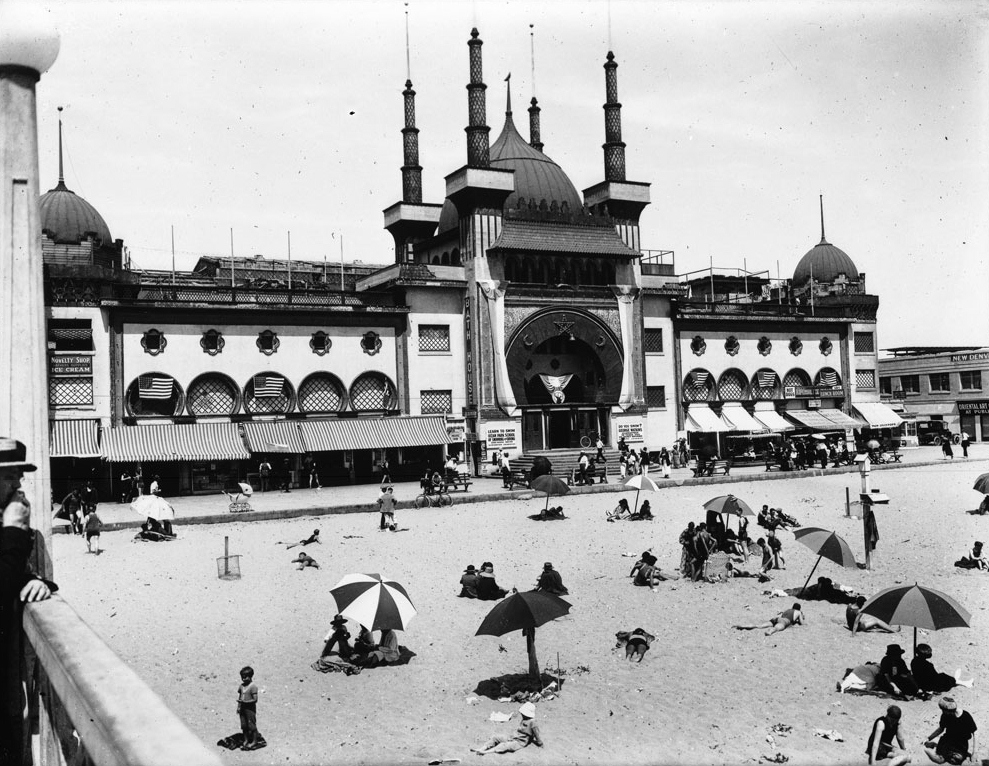 |
|
| (ca. 1920)* - Exterior view of the Ocean Park Bath House in Santa Monica from the pier. The bath house is at center and is a large Moorish-style building. At the center of the building is an elaborate entry way consisting of a large domed tower surrounded by four tall spires. Smaller domed towers occupy the corners of the buildings. Awnings project from the bottom story of the building, and rows of round windows occupy the second and third stories. |
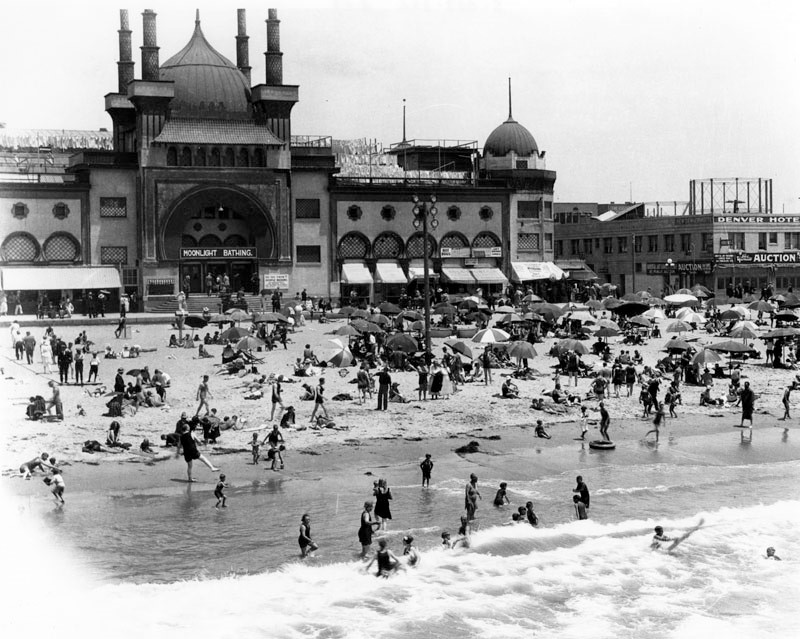 |
|
| (1921)* - A view of the beach and ocean water with the Ocean Park Bath House in the background, offering (sign over the door) moonlight bathing. To the right is a building Denver Hotel with a sign below it announcing Yosemite Auction. |
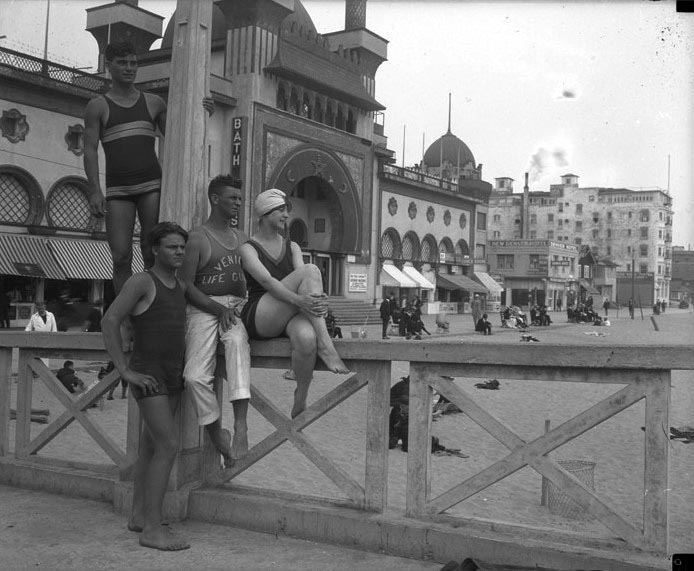 |
|
| (ca. 1925)* - Bathers and lifeguard on boardwalk in front of Ocean Park Bath House. |
* * * * * |
Early Santa Monica Street Scenes
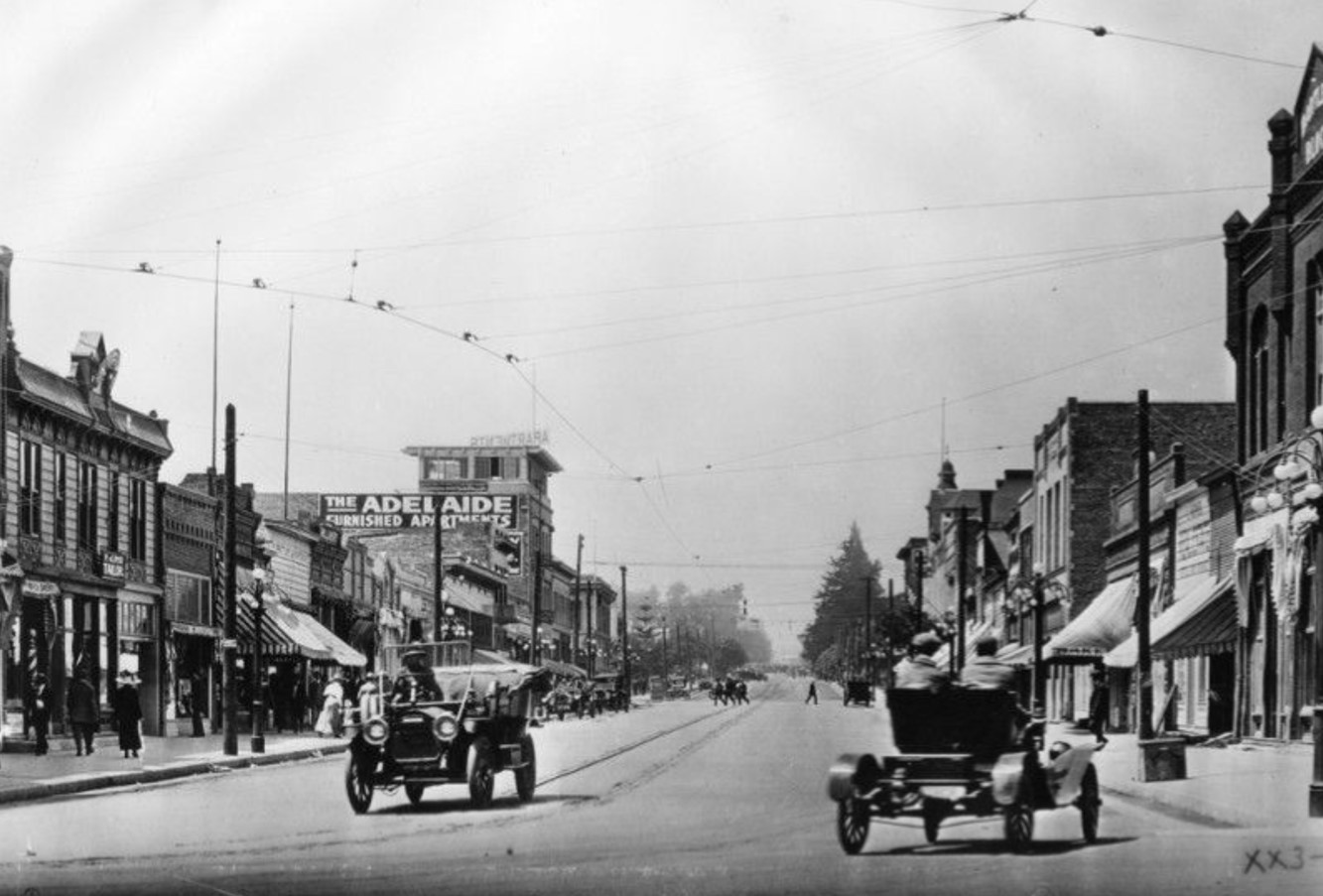 |
|
| (1910)* - View looking northwest on Third Street from Utah Street (now Broadway), in what is now the Third Street Promenade. |
Historical Notes In the 1910s, Third Street in Santa Monica was a bustling commercial strip, far removed from the pedestrian-friendly promenade we know today. The street was open to automobile traffic, and early cars, notably, had steering wheels on the right side despite driving on the right. Lined with various businesses, it served as the heart of Downtown Santa Monica, reflecting the city’s early growth and charm. The shift from a vehicular street to a pedestrian mall began in 1965 when Third Street was closed to cars. This transformation culminated in 1989 with a major redesign and renaming to the Third Street Promenade, solidifying its status as a vibrant, pedestrian-focused destination nearly 80 years after its original heyday. |
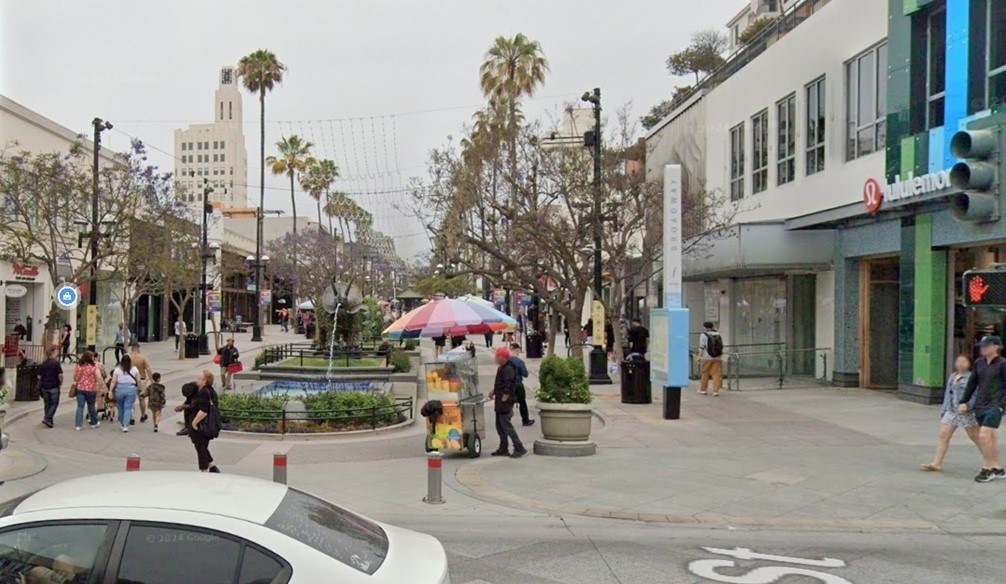 |
|
| (2024)* - Third Street Promenade in Santa Monica, looking northwest on Third Street at Broadway. |
Historical Notes The shift from a vehicular street to a pedestrian mall began in 1965 when Third Street was closed to cars. This transformation culminated in 1989 with a major redesign and renaming to the Third Street Promenade, solidifying its status as a vibrant, pedestrian-focused destination nearly 80 years after its original heyday. |
Then and Now
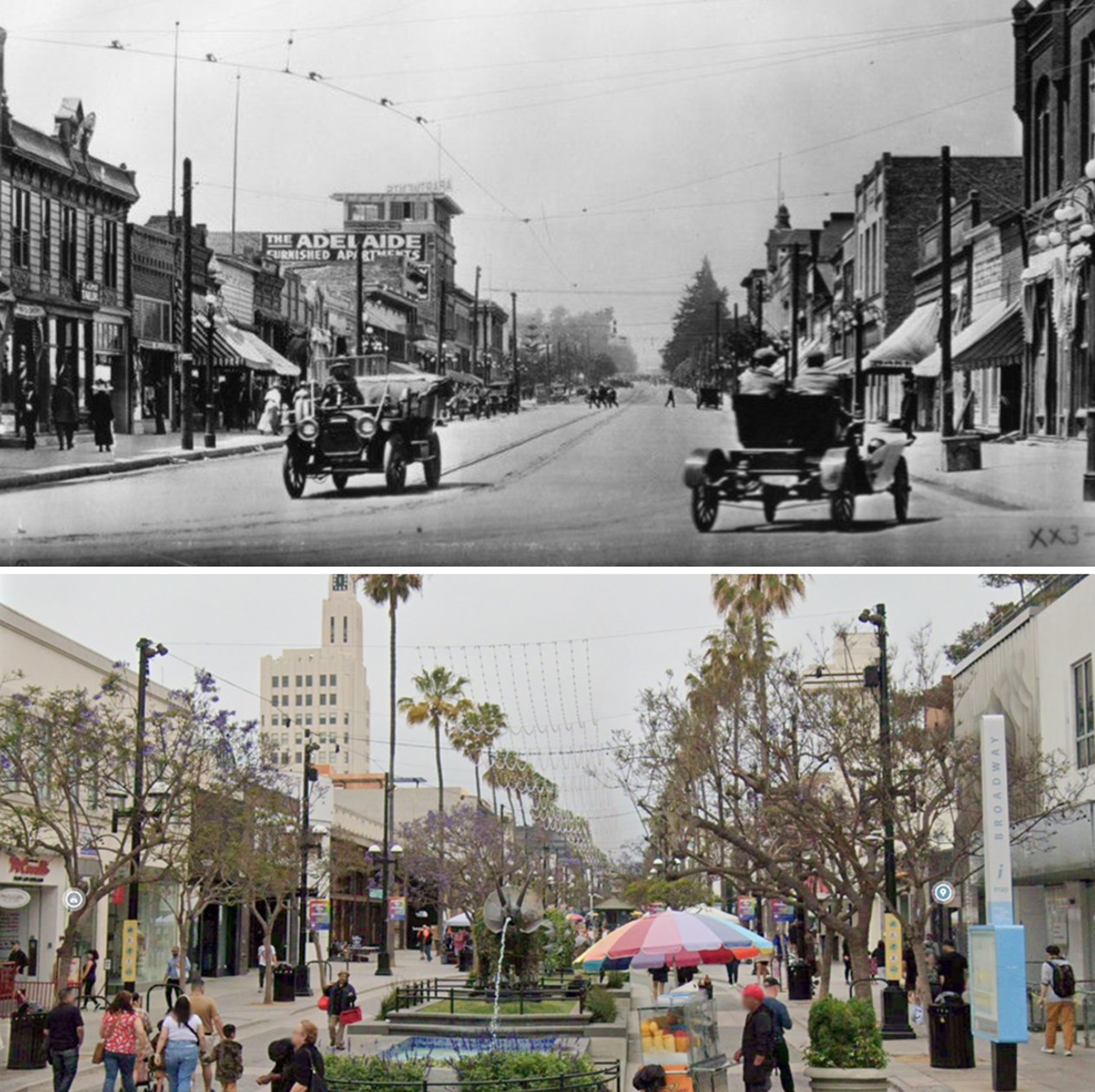 |
|
| (1910 vs. 2024)* - A 'Then and Now' view looking northwest at what is now the Third Street Promenade at Broadway. |
Historical Notes ClicK HERE to see more early views of Third Street, at was is now Santa Monica's Third Street Promenade. |
* * * * * |
Auto Racing in Early Santa Monica
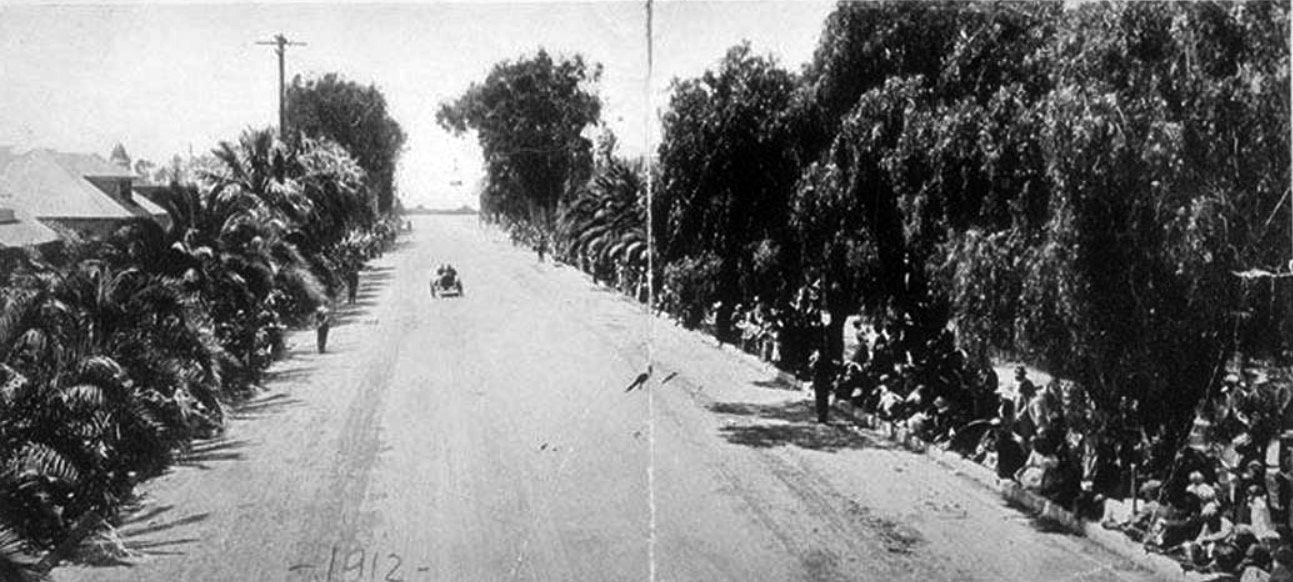 |
|
| (1912)* - Wilshire Boulevard (then Nevada Street), a section of the fastest road race course in the world (promotional brochure), Santa Monica. |
Historical Notes Santa Monica was known for its annual road race--an event that took place from 1909 through 1919 (with a 1917-18 hiatus because of America's involvement in World War I). The Santa Monica race was established by a consortium of Southern California auto dealers who wanted to stimulate interest in cars--buying them as well as racing them--at a time when automobiles were relatively rare in Los Angeles. |
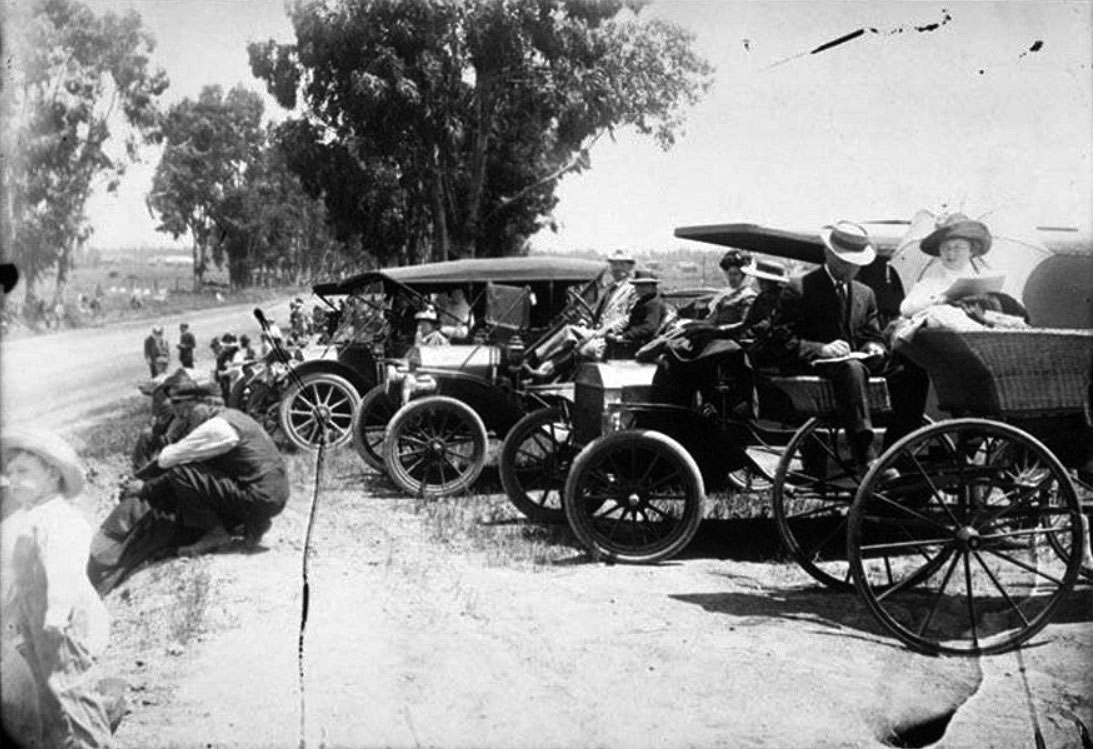 |
|
| (1912)* – Close-up view showing spectators on the side of the road and in their automobiles on Nevada Avenue (later Wilshire Boulevard) waiting for the Santa Monica Road Race to begin. |
Historical Notes Auto racing became popular in Santa Monica. Drivers would race an 8.4-mile loop made up of city streets. The Free-For-All Race was conducted between 1910-1912. The United States Grand Prix was held in Santa Monica in 1914 and 1916, awarding the American Grand Prize and the Vanderbilt Cup trophies. By 1919, the events were attracting 100,000 people, at which point the city halted them. |
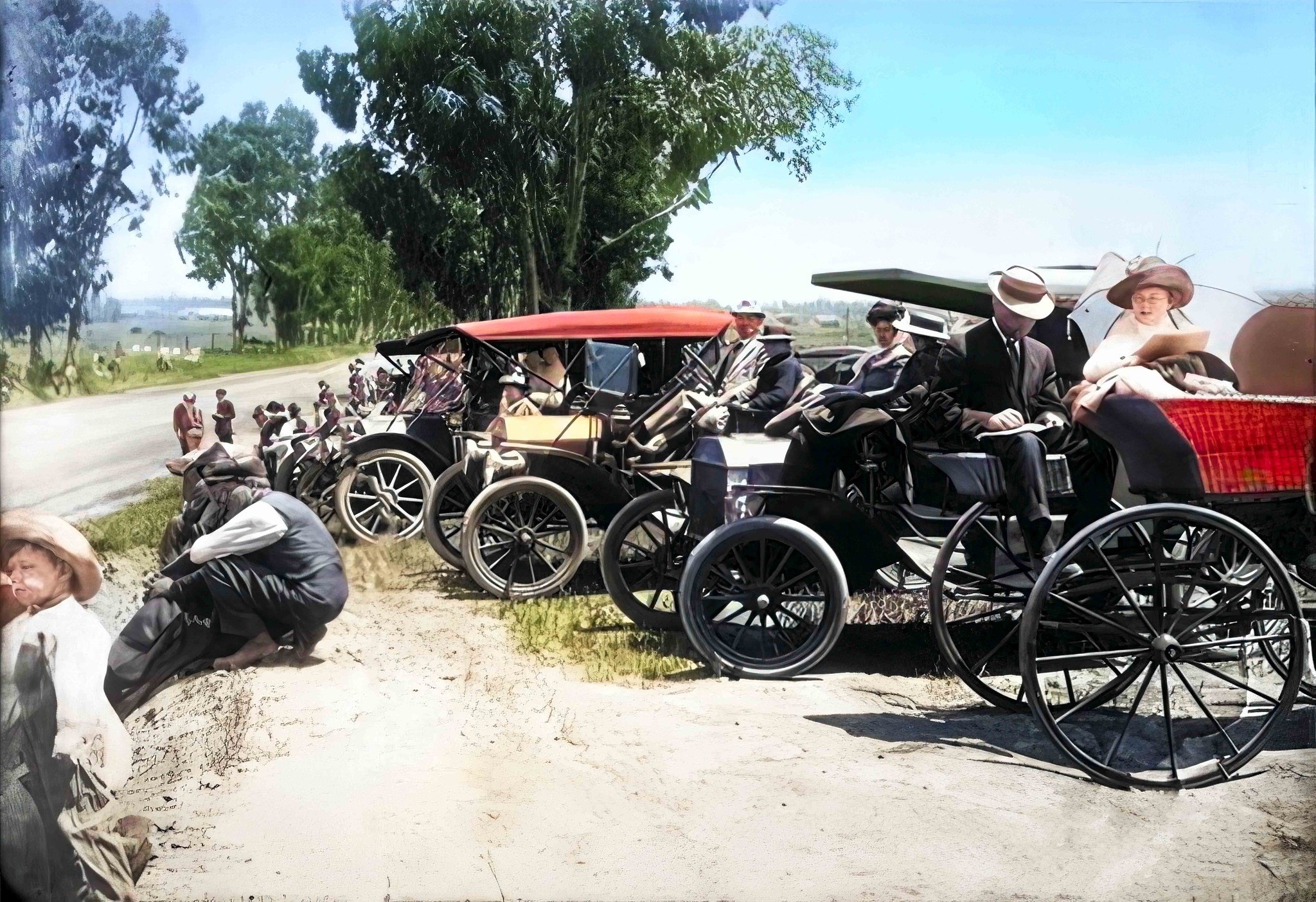 |
|
| (1912)* – Close-up view showing spectators on the side of the road and in their automobiles on Nevada Avenue (later Wilshire Boulevard) waiting for the Santa Monica Road Race to begin. Image enhancement and colorization by Richard Holoff. |
Historical Notes The original naming convention for east-west avenues in Santa Monica, established when the townsite was laid out in 1875, used names of Western U.S. states and territories. In later years, many of these street names were changed. For example: |
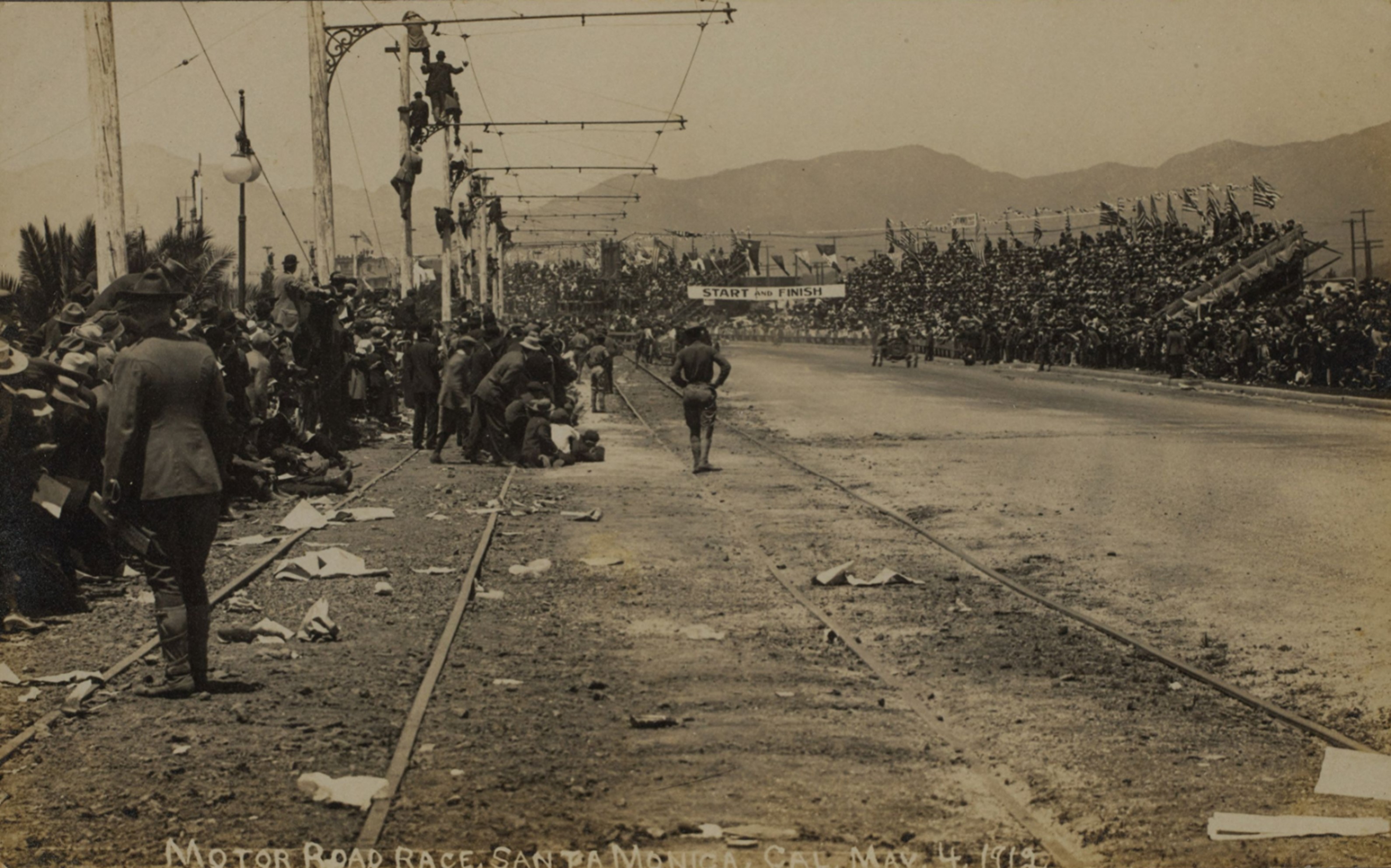 |
|
| (1912)* – Crowds of spectators watch race cars at the finish line of the Santa Monica Road Race on May 4, 1912. With streetcar tracks, trash, people climbing poles, a sign that reads "Start and Finish" and crowded grandstands visible. Photo from the Ernest Marquez Collection. |
Historical Notes The Santa Monica Road Race on May 4, 1912, was a pivotal event in early American auto racing, featuring a grueling 303-mile competition known as the Dick Ferris Trophy Race. The race took place on an 8.4-mile circuit of public roads in Santa Monica, California, including the notorious "Death Curve." This event attracted large crowds eager to witness the thrilling spectacle of early automotive competition, with drivers navigating the challenging course in primitive racing machines. One of the most notable participants in the 1912 race was the famous Barney Oldfield, driving a 1911 FIAT S74 nicknamed the "Maier Select Kid." This race marked Oldfield's return to competition after a one-year suspension by the AAA, though he finished last in seventh place. The ultimate victor of the free-for-all race was Teddy Tetzlaff, driving a Fiat. |
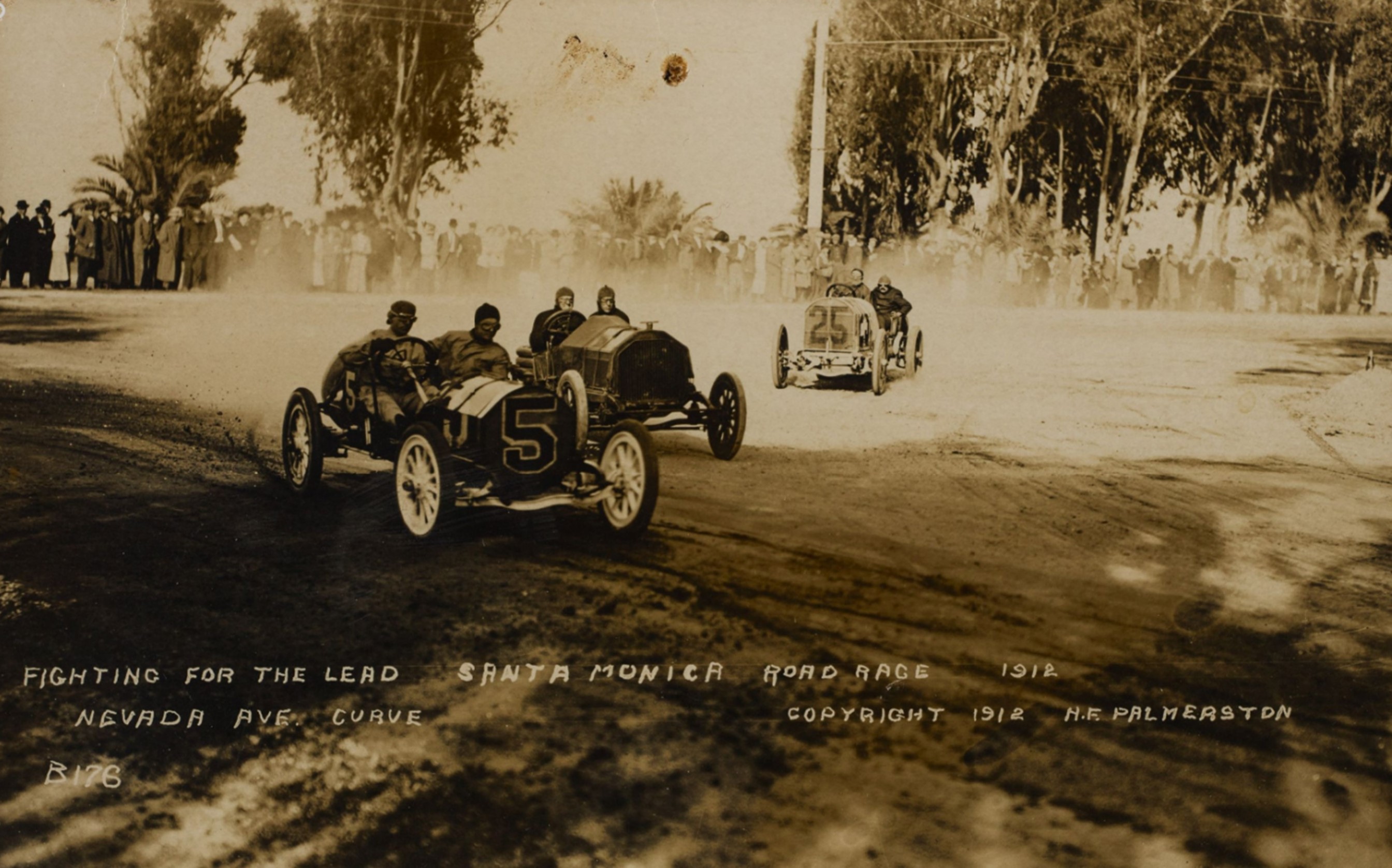 |
|
| (1912)* - Two-man race cars take a turn on Nevada Avenue (now Wilshire Boulevard) from Ocean Avenue and kick up dust as spectators watch from the side of the dirt road. Photo from the Ernest Marquez Collection. |
Historical Notes The course covered San Vicente Boulevard, Ocean Avenue and Wilshire Boulevard (then named Nevada Avenue). |
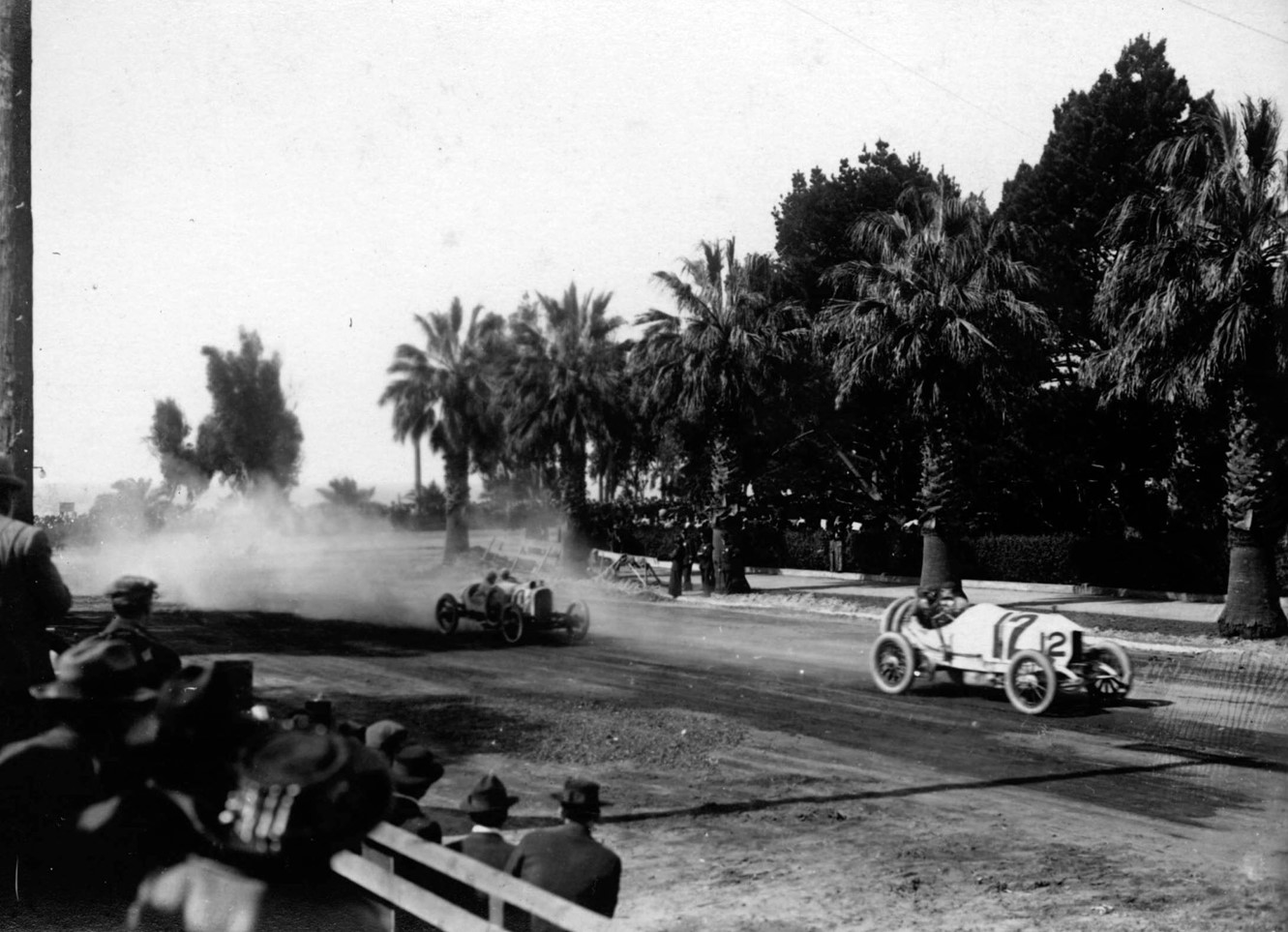 |
|
| (1910)* - A crowd watching an automobile race near Ocean Avenue in Santa Monica. The cars have just turned from Ocean Avenue onto Nevada Avenue (later Wilshire Boulevard). This was called the "Death Curve". |
Historical Notes The infamous "Death Curve" was a treacherous left turn on the Santa Monica road racing circuit between 1909 and 1919, connecting Ocean Avenue to Nevada Avenue (now Wilshire Boulevard). Despite its menacing name, no actual fatalities occurred at this specific location, though the turn was notorious for spectacular crashes that tested drivers' skills and nerve during the early days of automotive racing. Drivers like Eddie Pullen and John B. Marquis experienced dramatic incidents at Death Curve, with Marquis famously crashing his Sunbeam while leading a race after taking the turn too aggressively. The curve became a focal point for spectators, symbolizing the dangerous and thrilling nature of early 20th-century auto racing, where primitive technology and limited safety measures made each race a high-stakes test of driver ability and machine performance. |
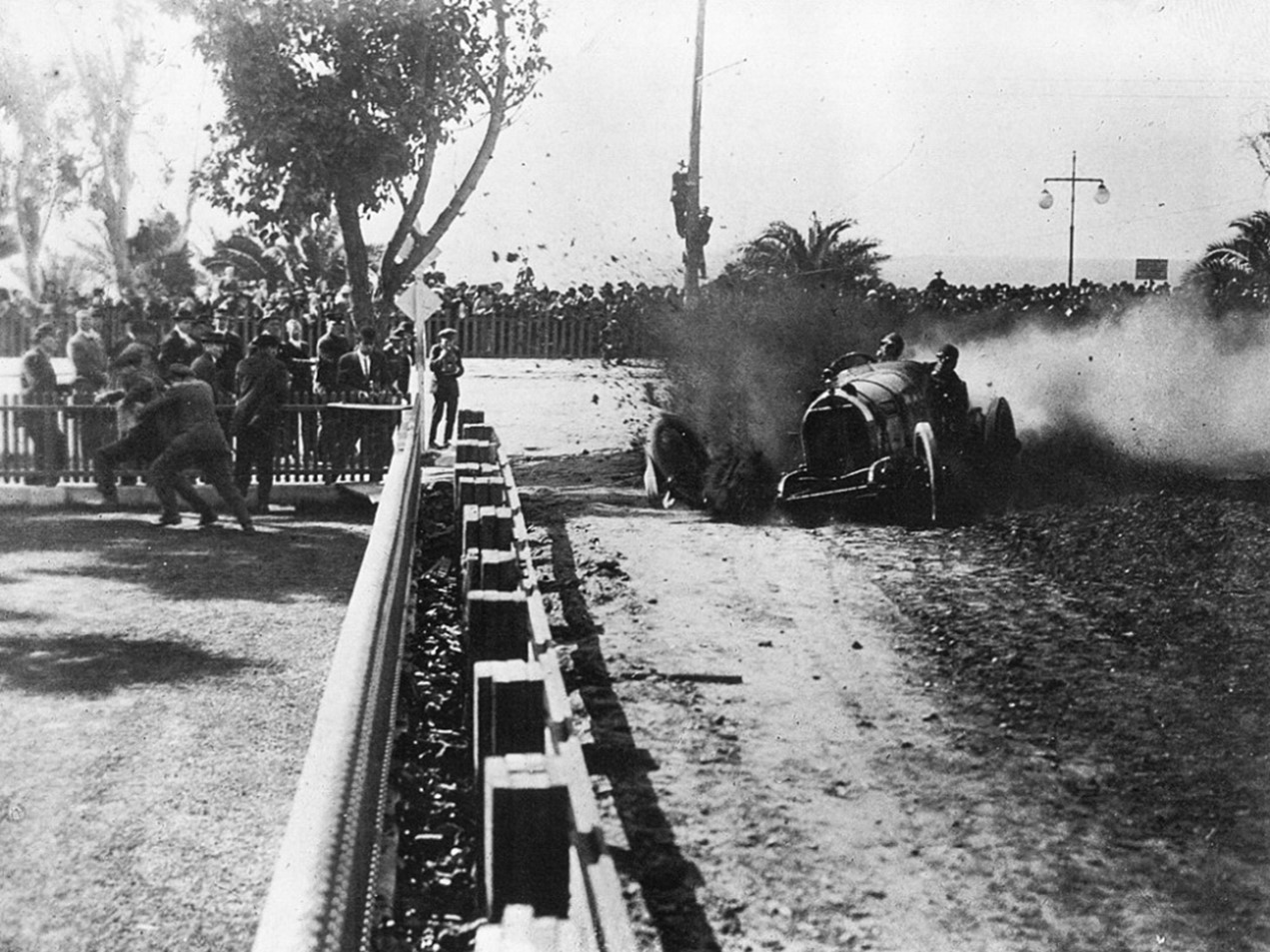 |
|
| (1914)* – View showing the "Death Curve", located at the corner of Ocean Avenue and Wilshire Boulevard. |
Historical Notes In the 1914 Vanderbilt Cup Races, Eddie Pullen's #4 Mercer lost its front right tire at the "Death Curve" and moments later crashed into the barricade. Two days later, Pullen won the 400-mile American Grand Prix on the same course with the same car. |
Then and Now
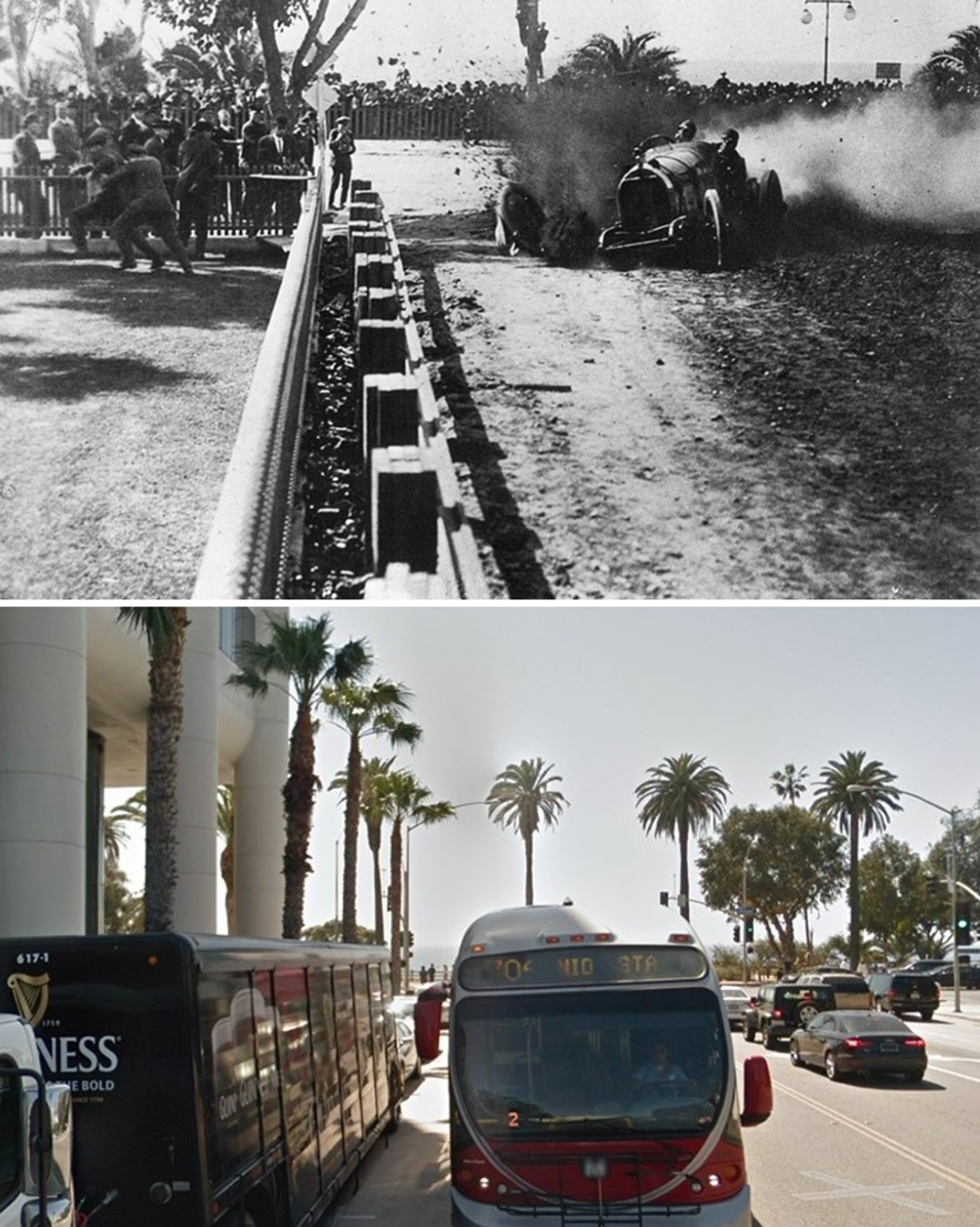 |
|
| (1914 vs. 2015)* – A ‘Then and Now’ view looking west along Wilshire Boulevard toward Ocean Avenue. |
Historical Notes The intersection of Wilshire Boulevard and Ocean Avenue has evolved from a dangerous racing curve to a prime location for luxury hotels, residences, and commercial spaces, reflecting Santa Monica's growth as a popular coastal city. |
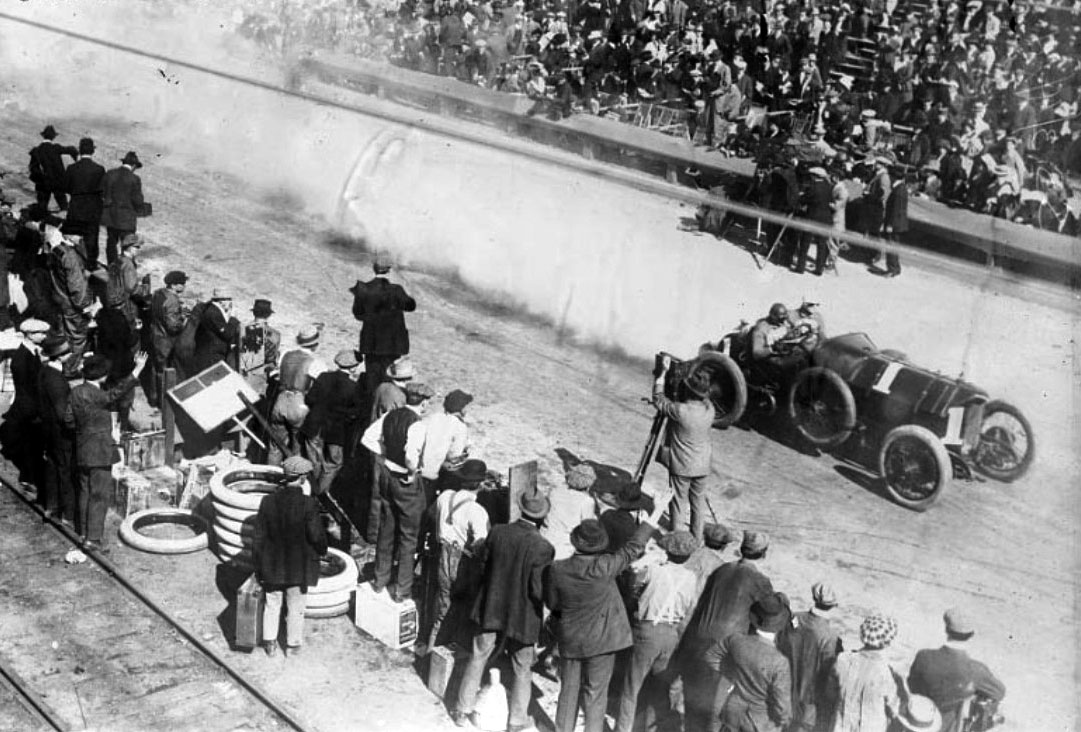 |
|
| (1914)* - Harry Grant, two-time winner of the Vanderbilt Cup Races, driving the #1 Isotta passes the grandstands on the east side of Ocean Avenue. |
Historical Notes Both the 1914 and 1916 Vanderbilt Cup Races were held on the beautiful Santa Monica road course bordering on the Pacific Ocean. The Santa Monica 8.4-mile course consisted of three major roads; Ocean Avenue (location of the start/finish), Wilshire Boulevard and San Vicente Boulevard. The race was 35 laps for a total of 295 miles. |
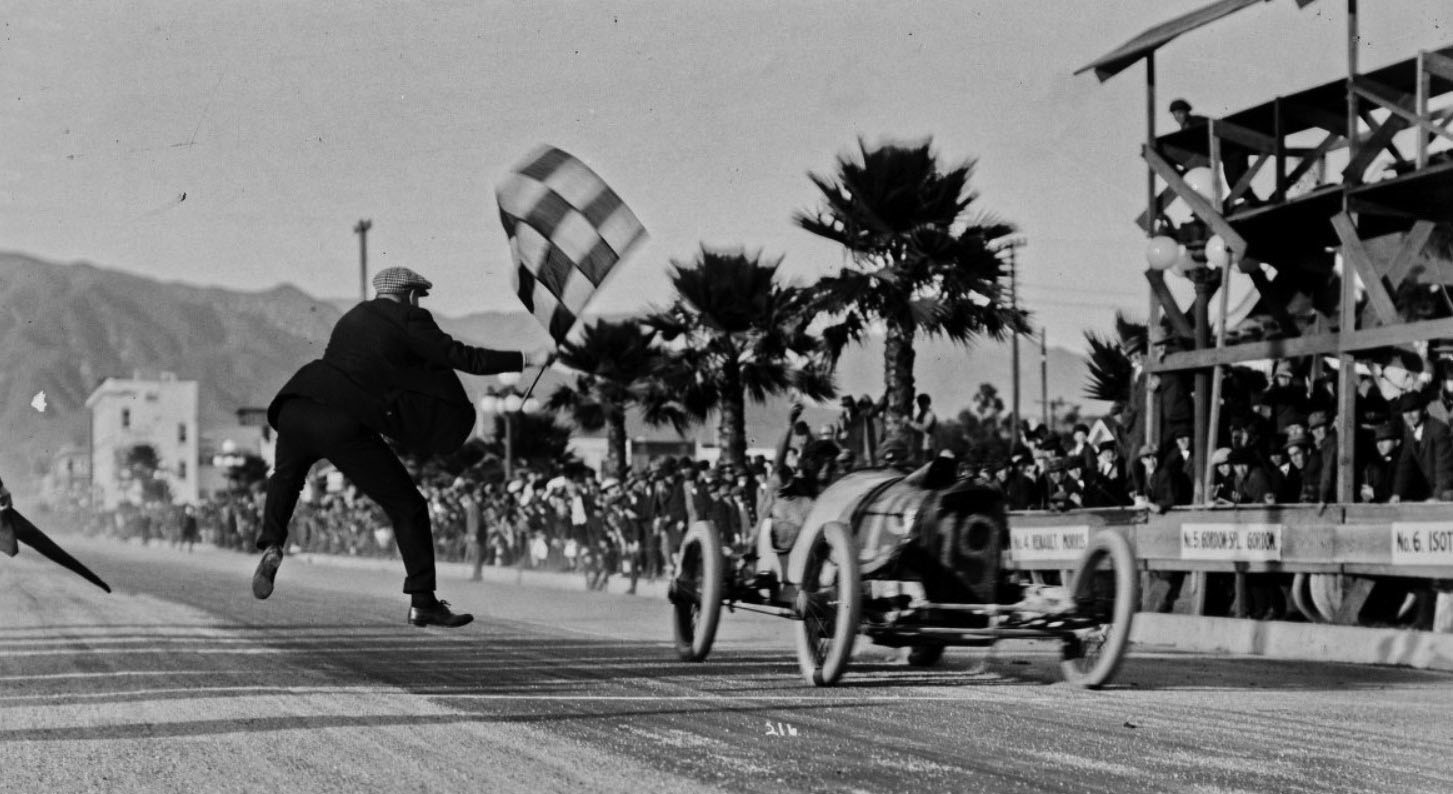 |
|
| (ca. 1916)* – View showing the dramatic Santa Monica finish line where Eddie O'Donnell takes the checkered flag in his Number 19 Duesenberg. |
Historical Notes These races were more than just sporting events; they were cultural phenomena that helped establish Southern California as a hub for automotive innovation and competition. The final race in 1919 drew a record crowd of 150,000 people and represented the pinnacle of early 20th-century road racing. By hosting prestigious competitions like the Vanderbilt Cup and the American Grand Prize in 1914 and 1916, Santa Monica played a crucial role in developing the nascent automotive racing culture, setting the stage for the region's future as a motorsports destination and helping to popularize the emerging automotive technology of the era. |
* * * * * |
Jefferson School (Santa Monica's 1st School Building)
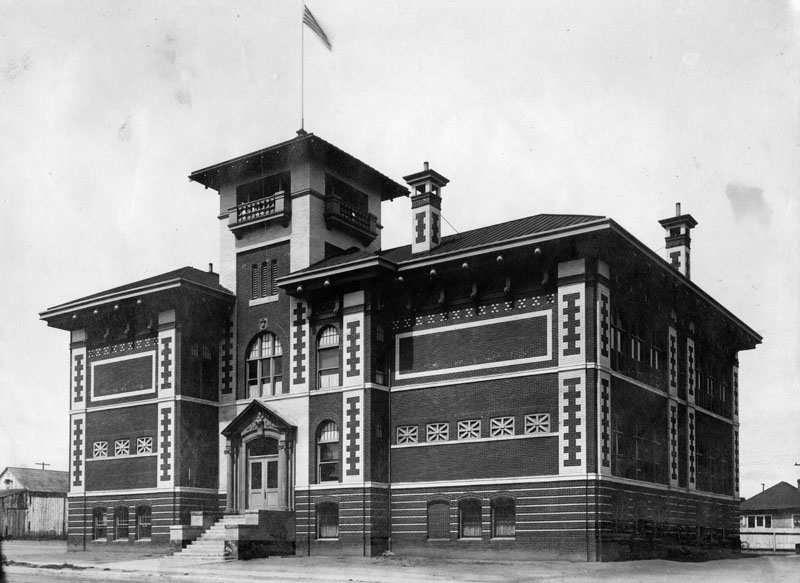 |
|
| (1910)* - Jefferson School located at 1333 Sixth Street in Santa Monica. |
Historical Notes Jefferson school, originally called 6th St. School, was Santa Monica's first school building and was located on two lots on the east side of 6th St. between Santa Monica Blvd. and Arizona. This first school was a frame building and was erected in 1876. |
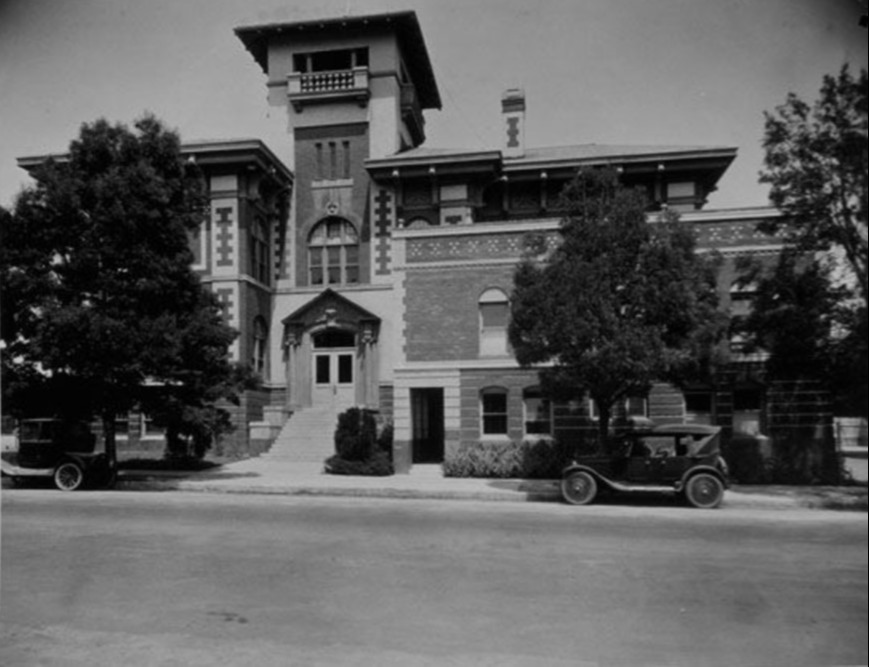 |
|
| (1920s)* - Jefferson School, originally known as 6th Street School, located at 1333 Sixth Street in Santa Monica. |
* * * * * |
Santa Monica City Hall
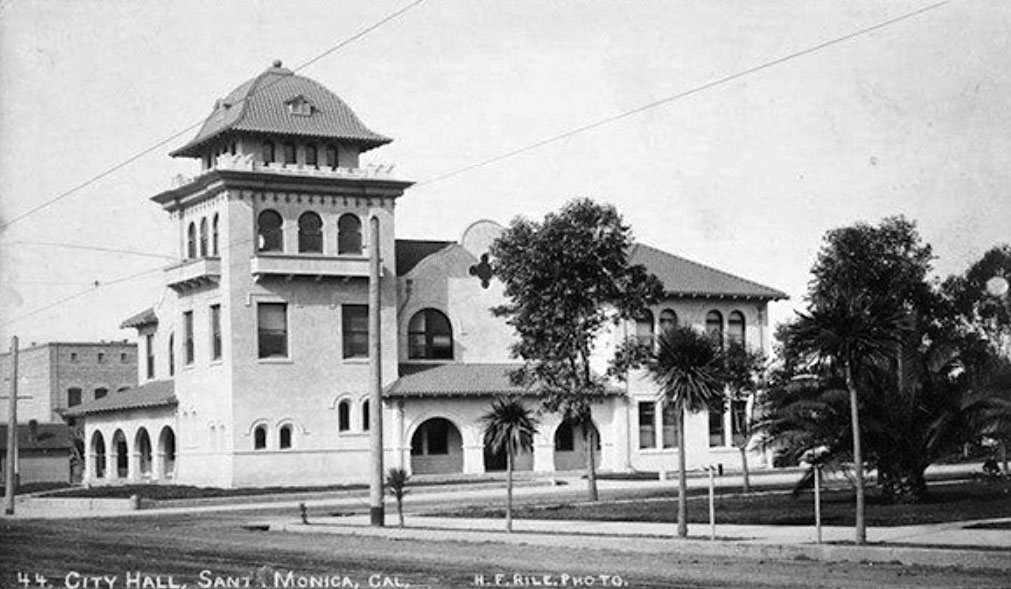 |
|
| (1903)* - Exterior view of Santa Monica City Hall the year it was built, located at the southwest corner of 4th and Oregon (Santa Monica Boulevard). Architect: Carol Brown, addition by Henry Hollwedel. |
Historical Notes In 1903, Santa Monica constructed its first independent city hall at a site that was then just east of downtown’s main commercial core. Choosing the Mission Revival architectural style, it featured massive brick walls covered with stucco, arcades, arched windows, elevated scalloped parapets, and a corner tower. |
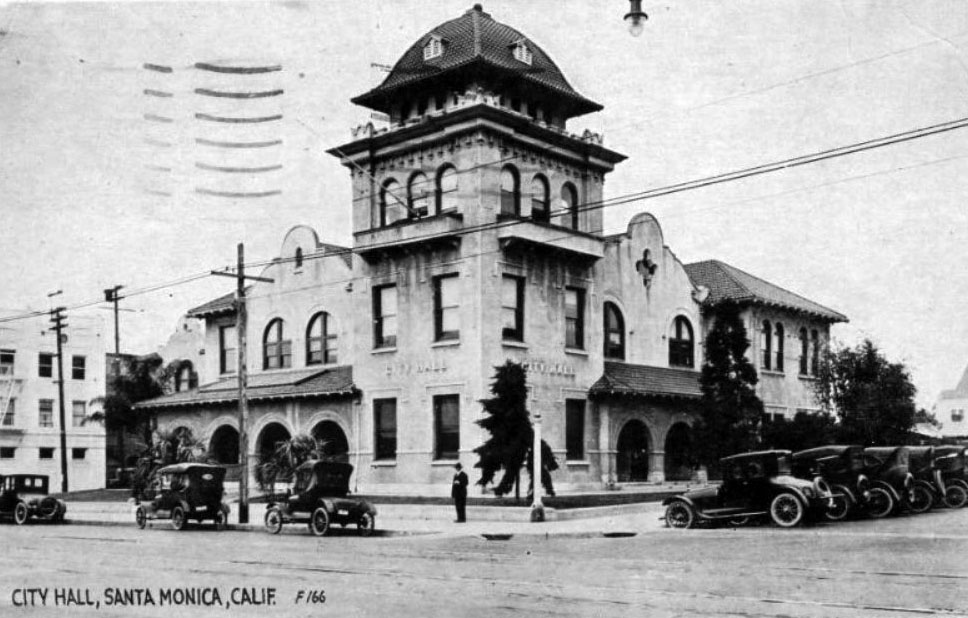 |
|
| (ca. 1917)* – Postcard view showing the old Santa Monica City Hall, located at Santa Monica Boulevard and Fourth Street. |
Historical Notes Santa Monica’s library shared space in City Hall, and a notorious dungeon-like jail was located in the basement that drew indignant protests from female civic leaders who demanded better conditions for the city’s prison population. Later a new jail adjacent to City Hall was built by Henry Hollwedel. |
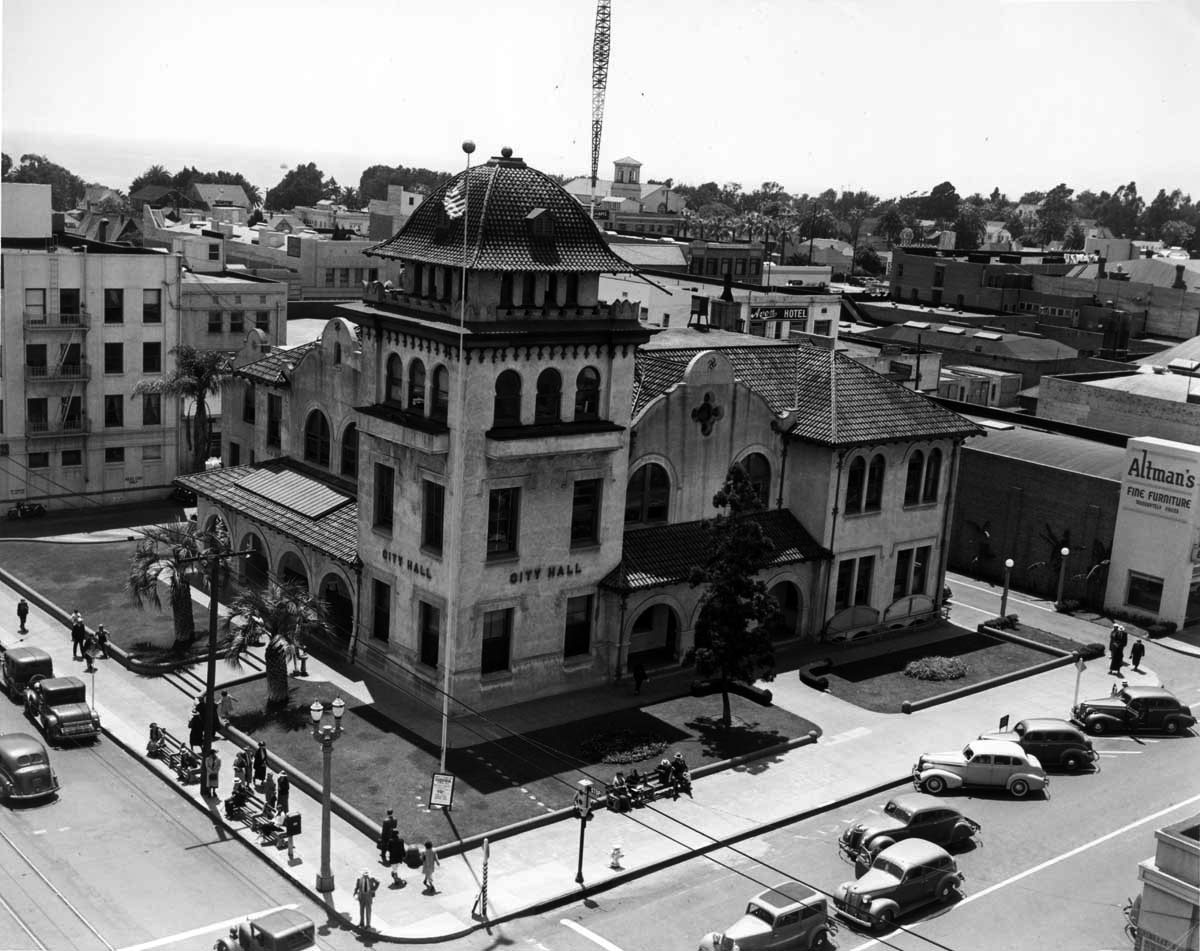 |
|
| (1930s)* - The old Santa Monica City Hall at Santa Monica Boulevard and Fourth Street. This building housed the City Hall and Police Department from 1902-1938. |
Historical Notes The Mission Revival style building designed by architects Carroll Brown and Henry Hollwedel (Henshey's Majestic Theater, Santa Monica Bay Women's Club) served as city hall and SMPD headquarters from 1902 to 1938. |
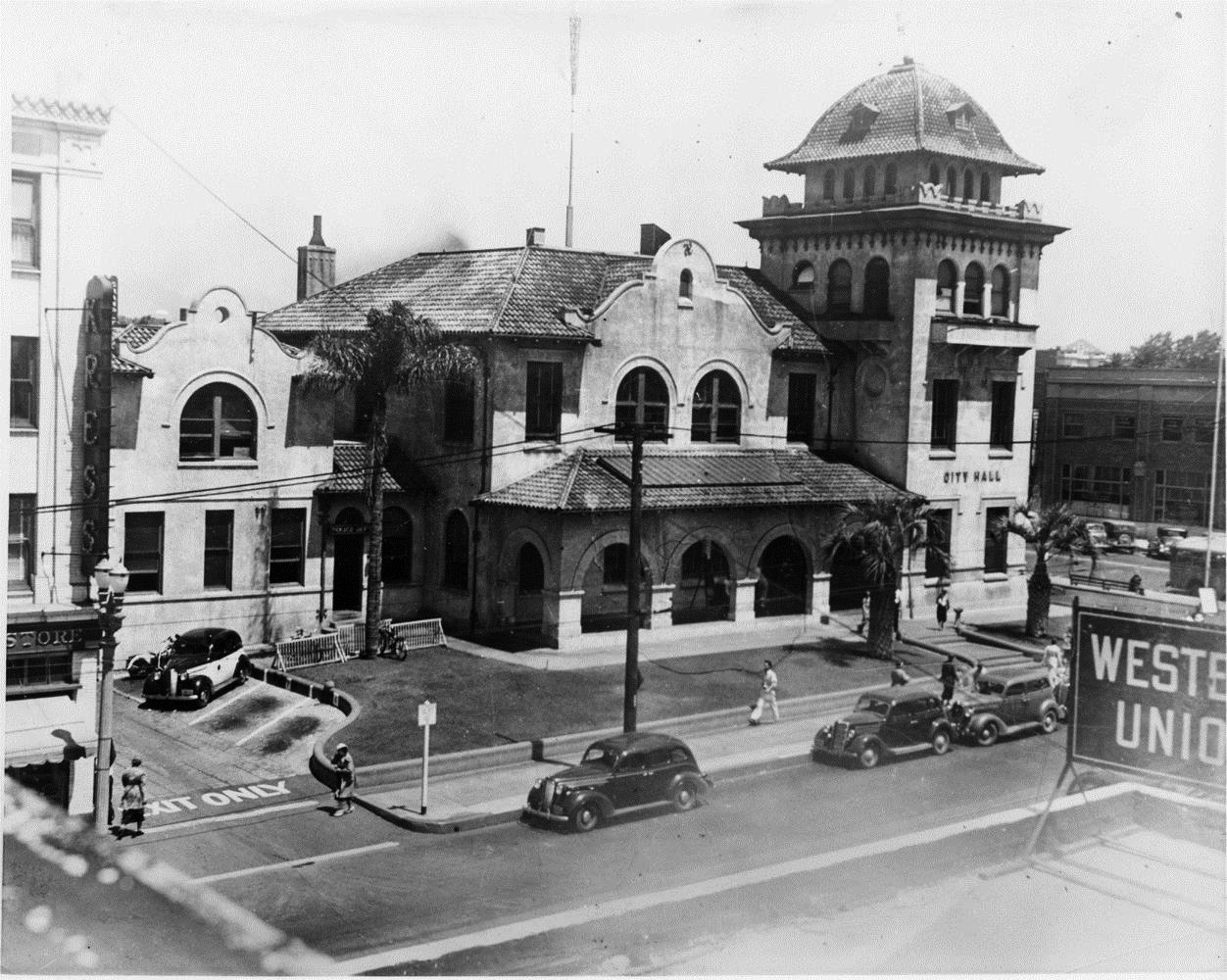 |
|
| (1930s)* - Closer view of Santa Monica City Hall. The building shared space with the Police Dept. |
Historical Notes The old City Hall building was demolished in the late 1930’s. S. H. Kress & Co bought the property and erected a new store to replace the store on 3rd street. This building has since been demolished for new development, but the 3rd Street building survives. Today’s City Hall at 1685 Main Street replaced this earlier structure in 1939. |
* * * * * |
Vitagraph Film Company
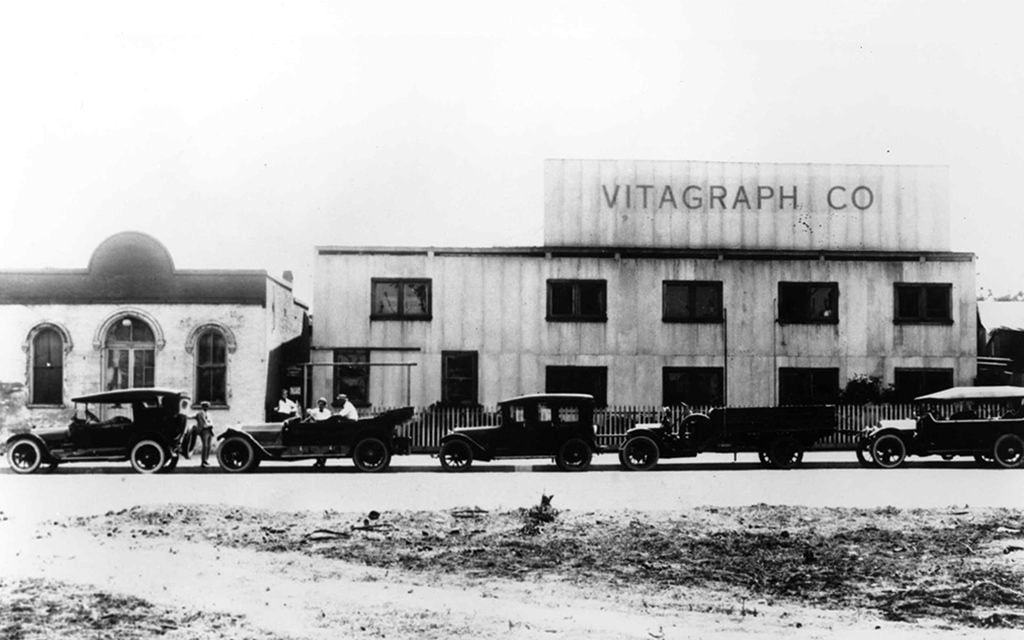 |
|
| (1912)* – View showing early model cars parked in front of Vitagraph Film Company and Rapp Saloon located on the 1400 block of 2nd Street in Santa Monica. |
Historical Notes The Vitagraph Company was one of the biggest motion picture studios in the early era of American film. Originally founded in Brooklyn, NY in 1897, they established another studio on 2nd Street in Santa Monica in 1911. The photo above was taken the following year, 1912, but they only lasted there until 1915 because the persistent fog made filming so difficult that they moved to 4151 Prospect Avenue in Hollywood (Click HERE to see the Hollywood Studio). In 1925, they were bought by Warner Bros. |
* * * * * |
Rapp Saloon
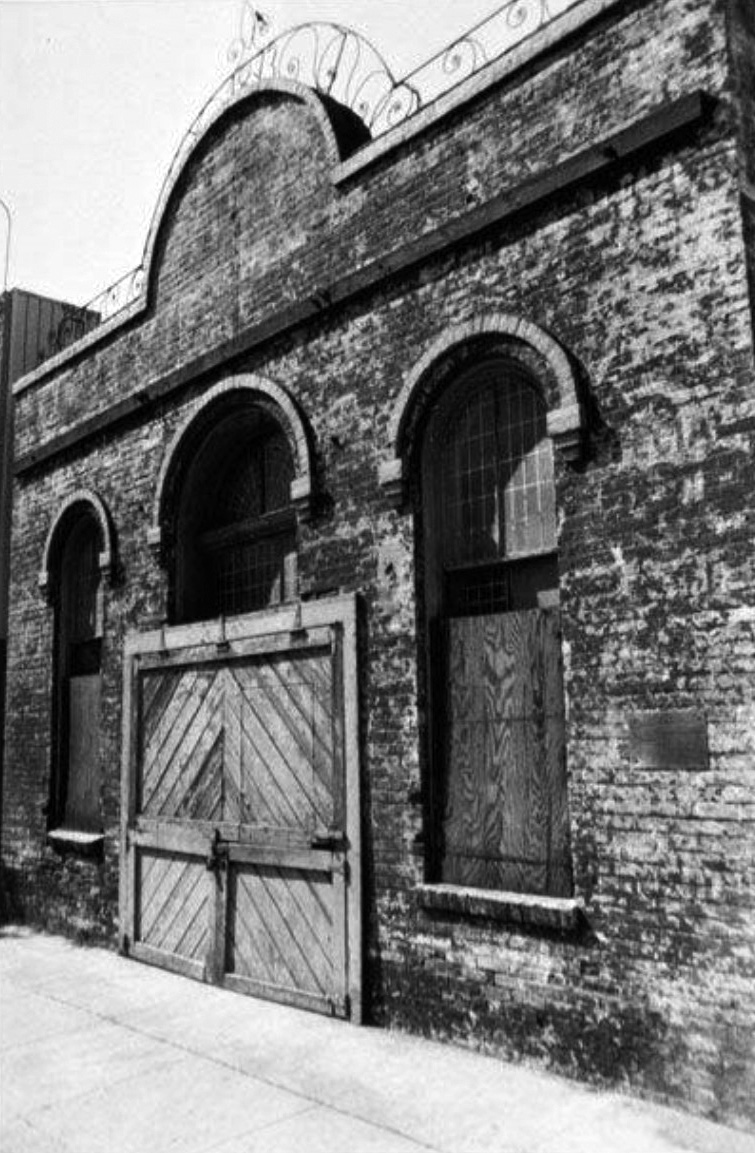 |
|
| (1975)* – Close-up view of Santa Monica's oldest masonry building, the Rapp Saloon located at 1438 Second Street. It was built in 1875 and designated as a landmark in 1975. |
Historical Notes A remarkable survivor from the year Santa Monica was born, this small brick building was constructed as a beer hall by William Rapp. An 1877 newspaper ad promoted the “Los Angeles Beer Garden” with fresh Los Angeles beer always on hand. |
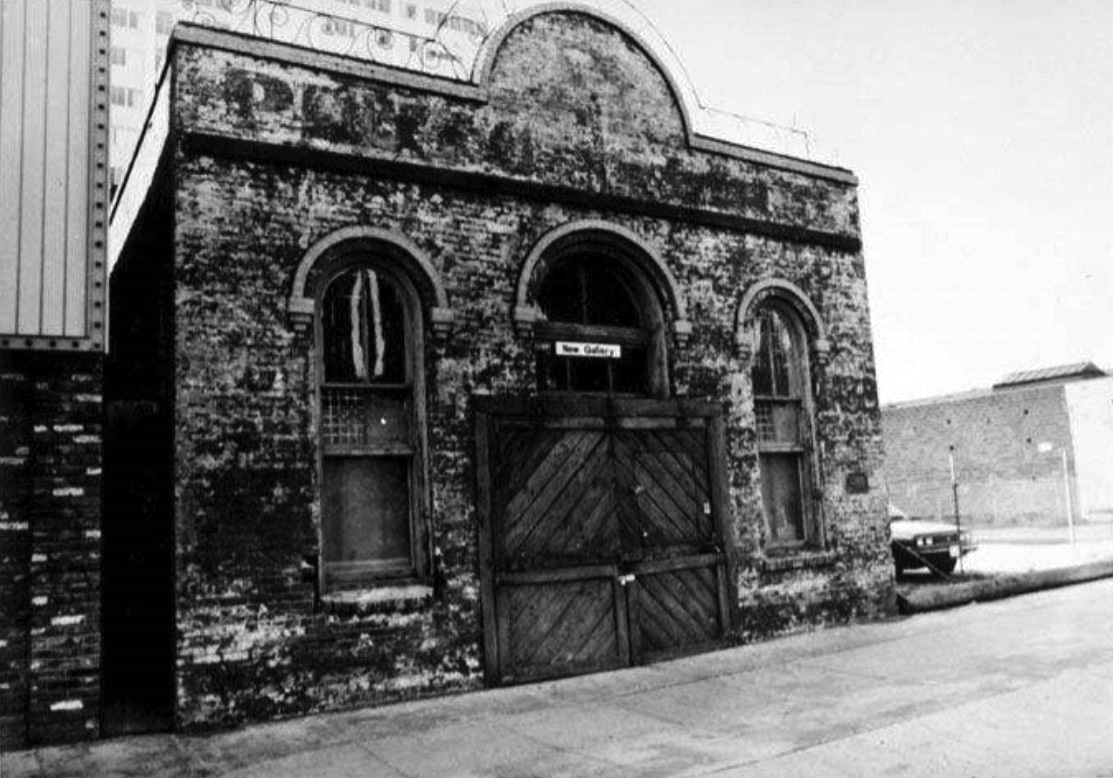 |
|
| (1983)* - Rapp Saloon, 14438 Second Street, Santa Monica. Built in 1875 by William Rapp, this is the oldest masonry building in Santa Monica. |
Historical Notes The arches give this vernacular building an Italianate air. It has gone through many incarnations in its long life, even serving briefly as City Hall in 1888-1889. From 1911 to 1914 it was used by the Vitagraph Film Company, an early movie studio. It’s also been home to the Salvation Army, a radiator repair shop, a piano tuning shop and an art gallery. Old painted signs on the north wall memorialize some of the previous occupants. |
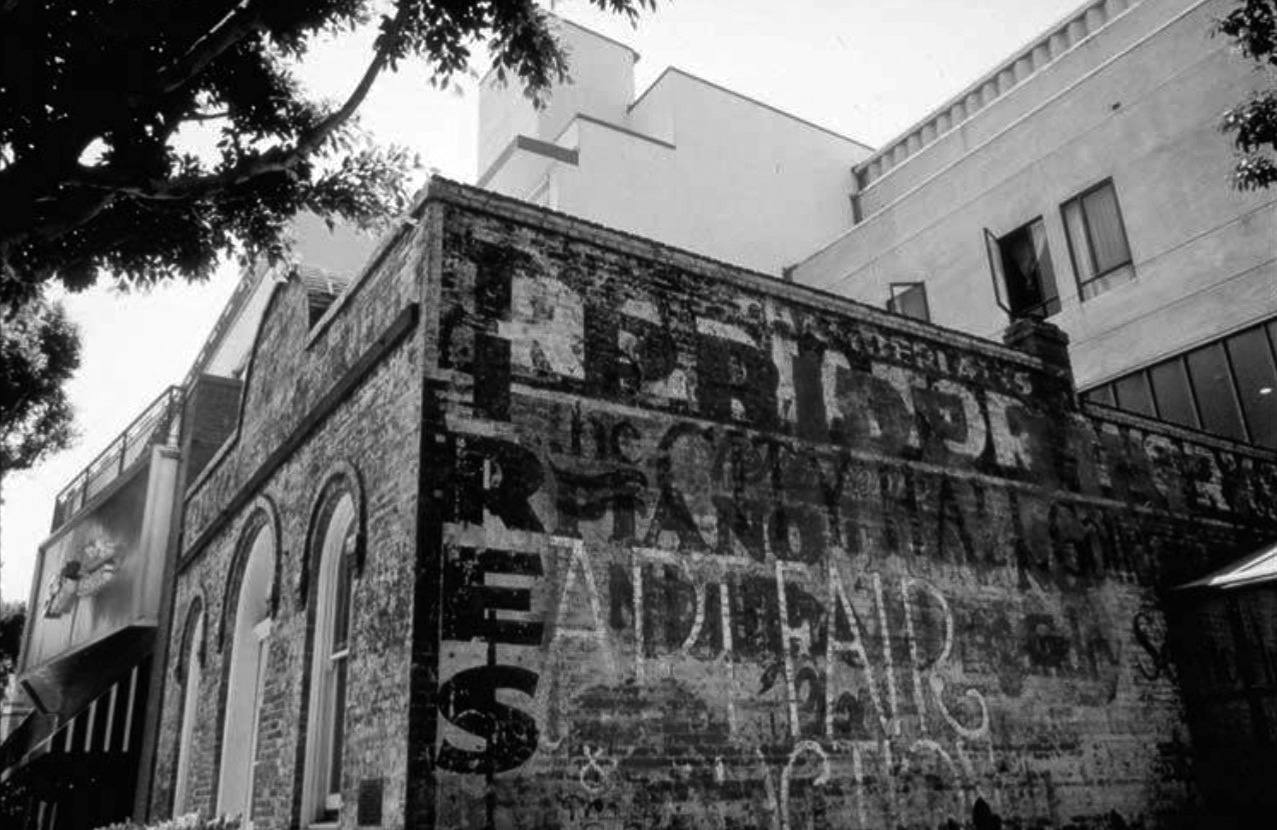 |
|
| (2001)* – Side view of the Rapp Saloon, 1438 Second Street, oldest masonry building in Santa Monica built in 1875 by William Rapp. |
Historical Notes Saving the Rapp Saloon took several decades of effort. Vacant and abandoned since 1959, the owner hoped to sell and relocate the building so that this prime location could be redeveloped. It was named the first landmark in the city in 1975, and the city offered to support the relocation. Ideas floated to use the building as a historical museum. By 1984 no viable purchaser had emerged with a realistic plan for re-use; and the owner threatened demolition. Finally, in 1986, the American Youth Hostel acquired the property with the intention of preserving and re-using the historic landmark. New construction wraps around the Rapp Saloon, visible in its entirety – a model of combining new construction with historic preservation. |
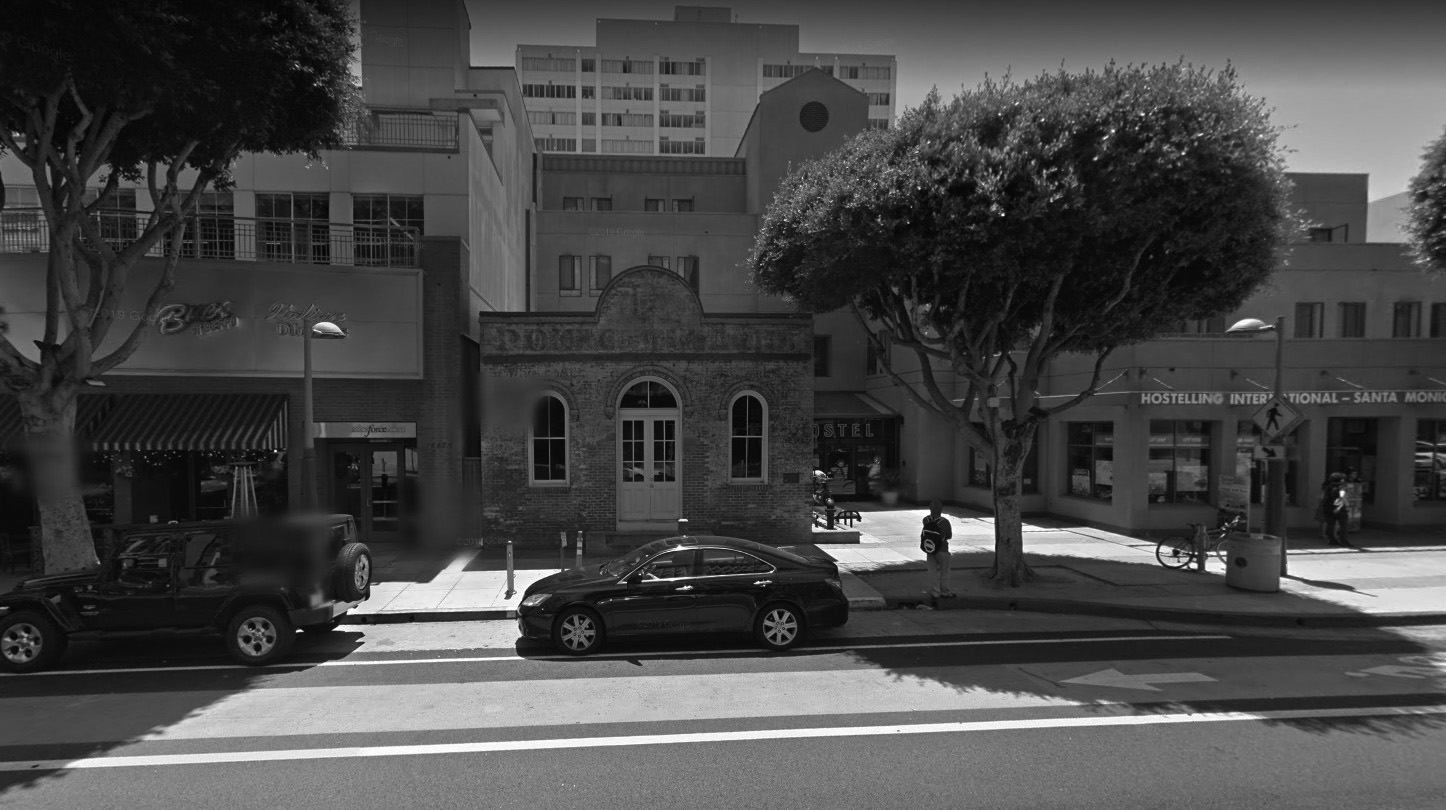 |
|
| (2015)* – Google street view showing the Rapp Saloon as it appears today. |
Historical Notes The Rapp Saloon, at 1438 Second St., was built in 1875 and is the oldest surviving brick building in the city. This one-story structure was designed for William Rapp by a contractor known only as Mr. Freeman. The building was constructed by Spencer & Pugh bricklayers and plasterers. It was the first masonry structure in Santa Monica. The Rapp Saloon even served as Santa Monica’s City Hall for two years, and was the city's first landmark. |
* * * * * |
Santa Monica High School
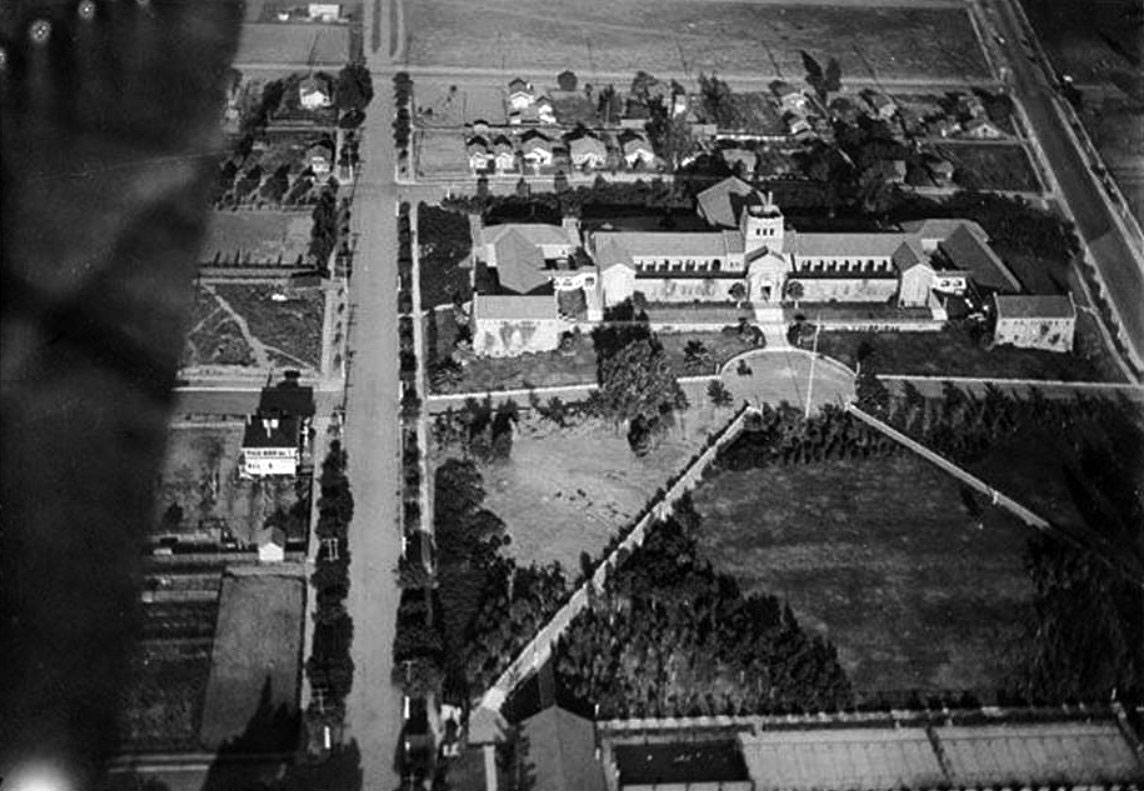 |
|
| (1916)* – Aerial view of Santa Monica High School, located at 601 Pico Boulevard. |
Historical Notes Santa Monica High School was founded in 1884. It changed location several times in its early years before settling into its present campus at 601 Pico Boulevard. The "new" campus opened in 1906 with one building, the current History building, with an enrollment of 50 students. The school sits on the hilltop of what is now 6th Street and Pico Boulevard, from which one can see the Pacific Ocean. |
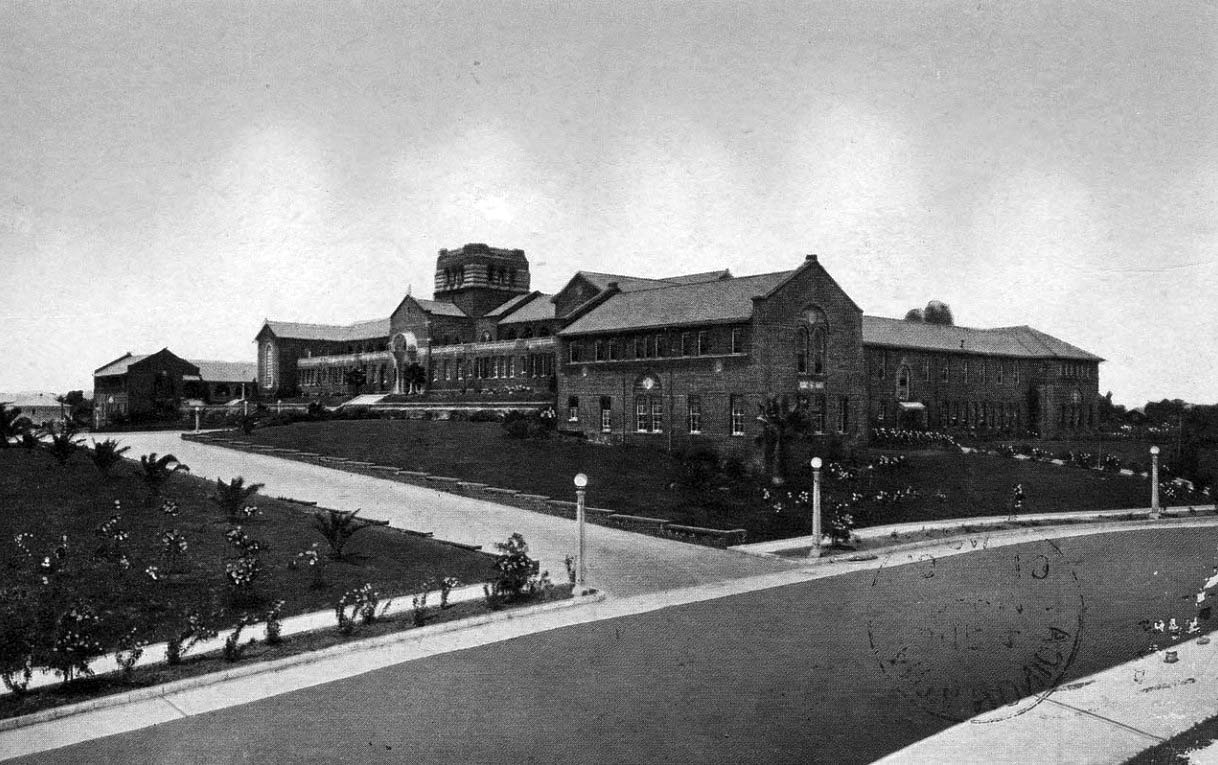 |
|
| (ca. 1919)*^ - Postcard view of Santa Monica High School located at 601 Pico Boulevard. |
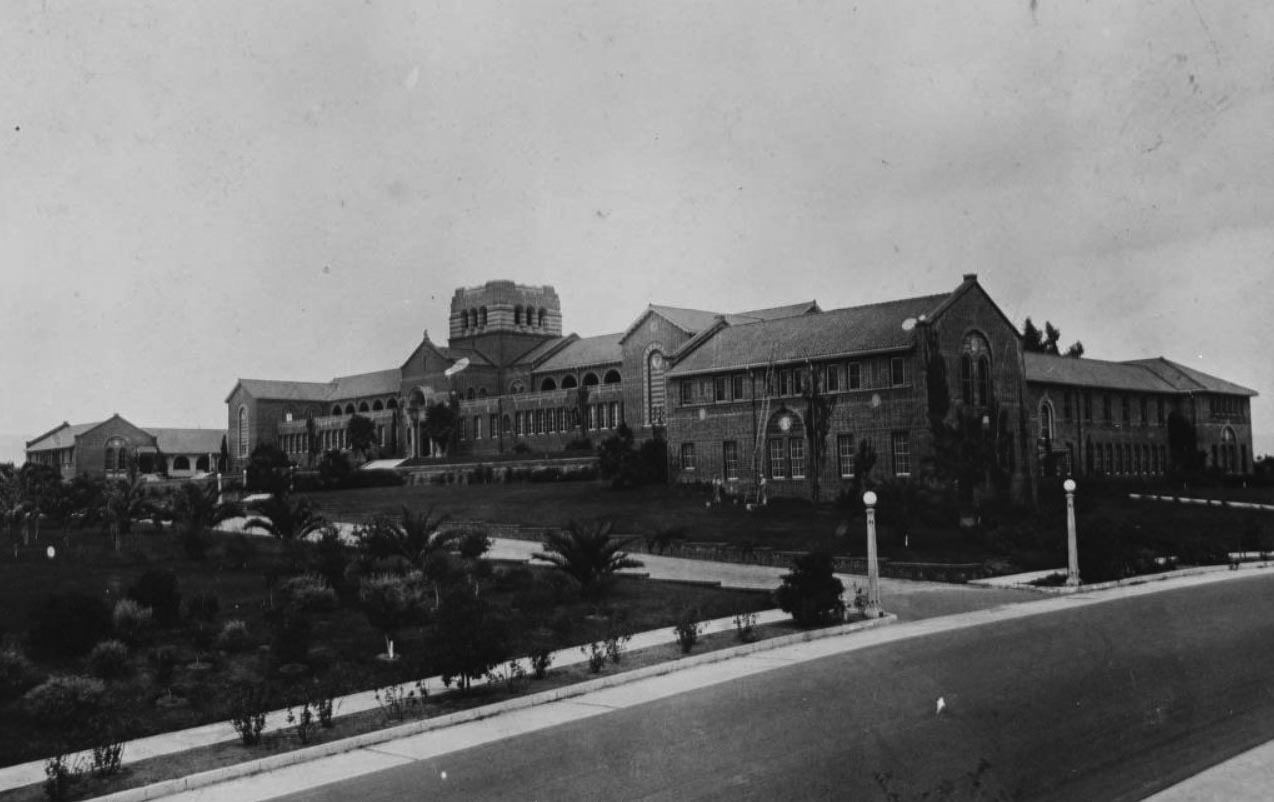 |
|
| (ca. 1922)* - Image of the main entrance wing of Santa Monica High School and grounds on Pico Boulevard in Santa Monica. |
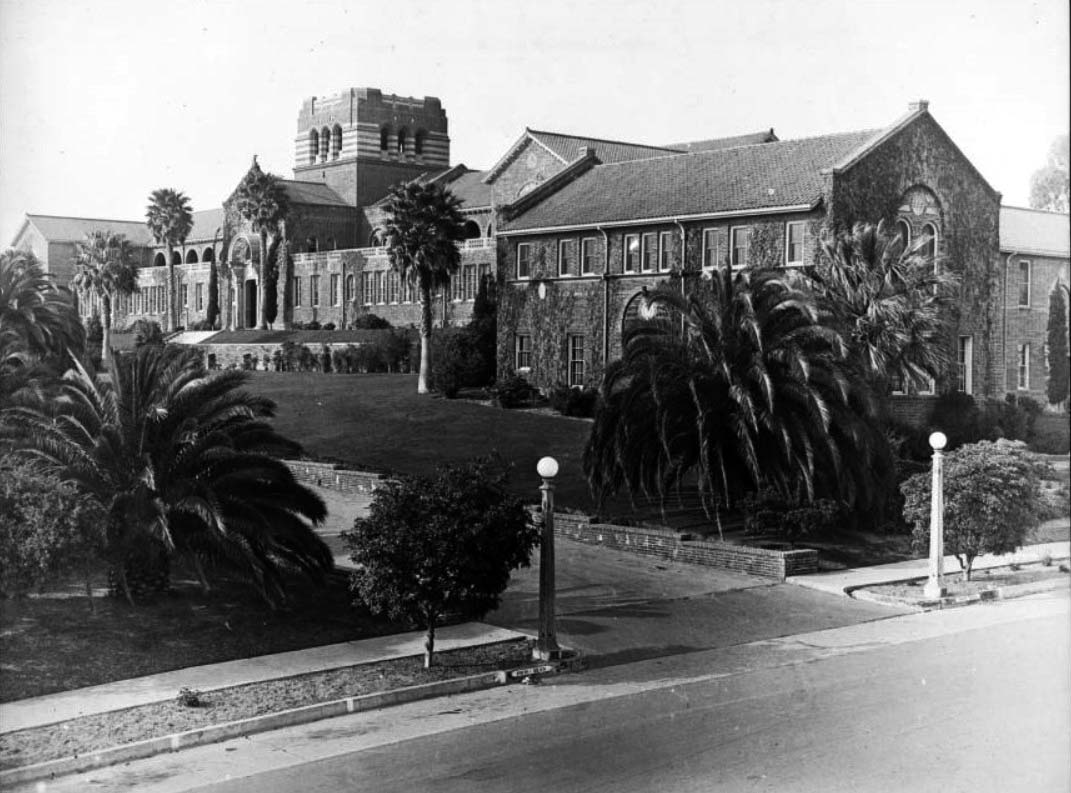 |
|
| (1924)* - Exterior view of Santa Monica High School, showing the main entrance and right wing. The main entrance to the multi-story brick building is seen at left center. The right wing, its walls covered in ivy, protrudes toward the foreground. The building is fronted by lawns and palm trees. A paved street and sidewalk run diagonally through the lower right of the image. The high school building was erected in 1912 and replaced during 1936 and 1937. |
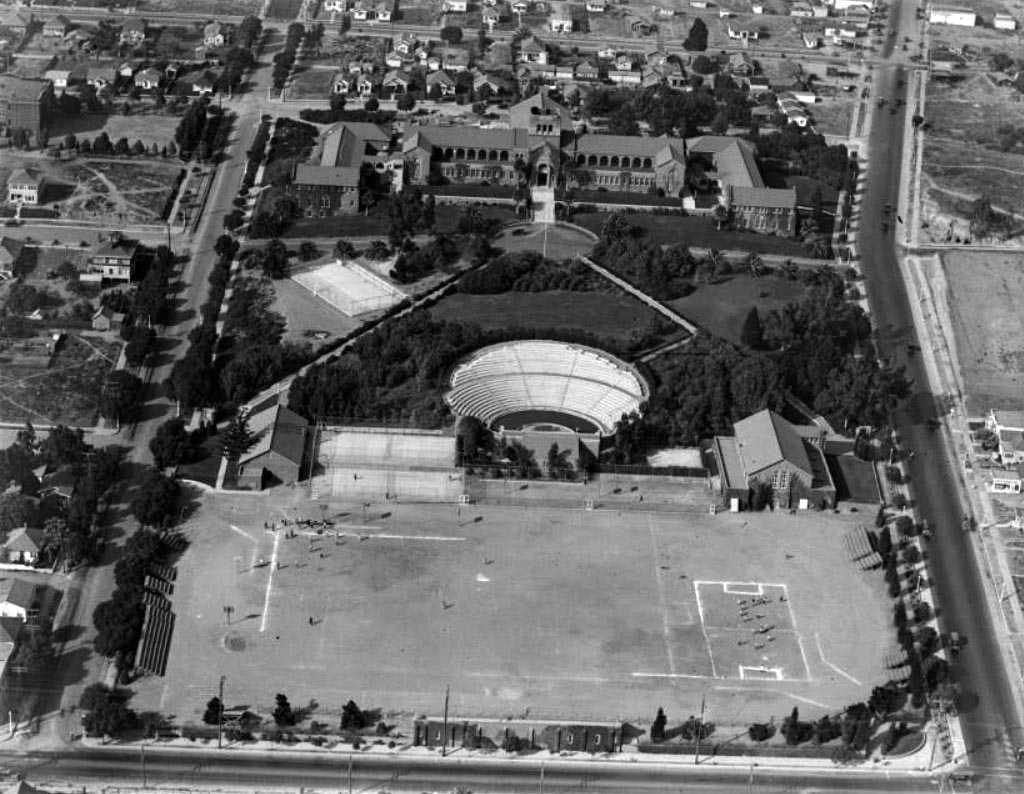 |
|
| (1925)* - Aerial view of the Santa Monica High School campus showing the athletic field and Open Air Memorial Theater (later renamed the Memorial Greek Amphitheatre) bordered by 4th Street at bottom and Pico Boulevard at right. |
Historical Notes In 1921, the Open Air Memorial Theatre (now called the Greek Amphitheatre) was built to honor the Santa Monicans who served in World War I. One of the best examples of the classical Greek style in Southern California, the amphitheatre was built after Santa Monica passed a $30,000 bond measure to fund its construction. Barnum Hall Theater, originally called "the Auditorium," was built in 1937 by the Works Progress Administration (WPA) to be the Civic Auditorium of Santa Monica and host school events as well. The campus also added six buildings during this period: the Language, English, Business, History, Administration and Music buildings. In 1952, Santa Monica High School was finally expanded to what it is now, 33 acres, and two new buildings were built, the Science and Technology D.M. buildings. As the school aged, renovations took place in Barnum Hall and the Music building was completely rebuilt. The school has been a location in a number of films. Most famously, it is the high school setting in Rebel Without a Cause where James Dean walks up the History Building stairs. |
* * * * * |
Ocean Park
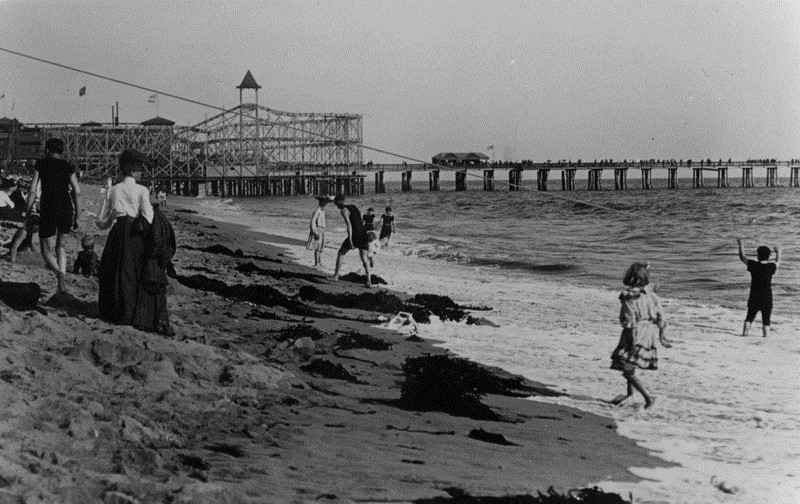 |
|
| (1912)* - View of the seashore at Ocean Park Beach in Santa Monica. Amusement park can be seen on the pier. The roller coaster seen above was called Ingersol's Scenic Railroad. It was the first roller coaster to be installed in the Santa Monica Bay area. |
Historical Notes Amusement piers became enormously popular in the first decades of the 20th century. The extensive Pacific Electric Railroad easily transported to the beaches people from across the Greater Los Angeles Area. Competing pier owners commissioned ever larger roller coaster rides. Wooden piers turned out to be readily flammable, but even destroyed piers were soon replaced. There were five piers in Santa Monica alone, with several more down the coast. |
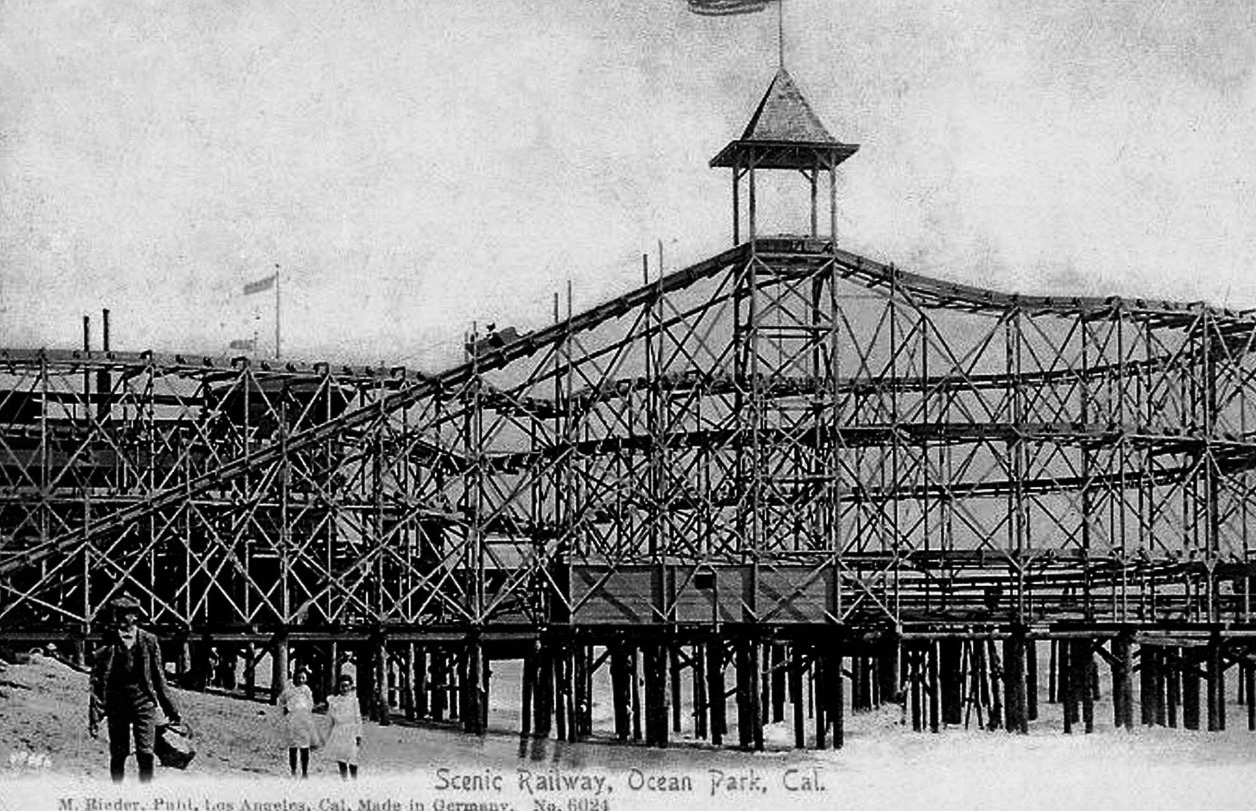 |
|
| (ca. 1912)* – Postcard view showing a man and two young girls walking along the beach with the Ocean Park Scenic Railway Roller Coaster in the background. |
Historical Notes In 1904, Ingersol's Scenic Railroad was the first roller coaster to be installed in the Venice / Ocean Park area. |
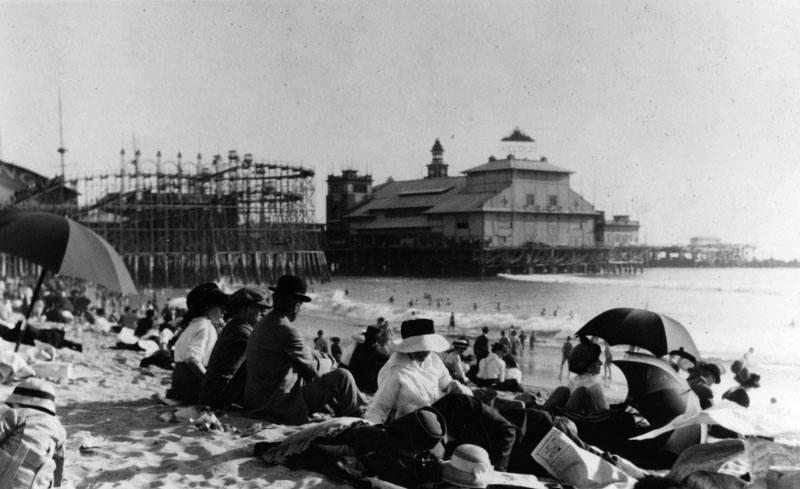 |
|
| (1912)* - View from Santa Monica Beach of Ocean Park. |
Historical Notes The earliest part of the current Santa Monica Pier, which is now the last remaining amusement pier, was built in 1909 on what was referred to as the North Bay. The second half, an amusement park pier, was built later and the two rival piers were merged. |
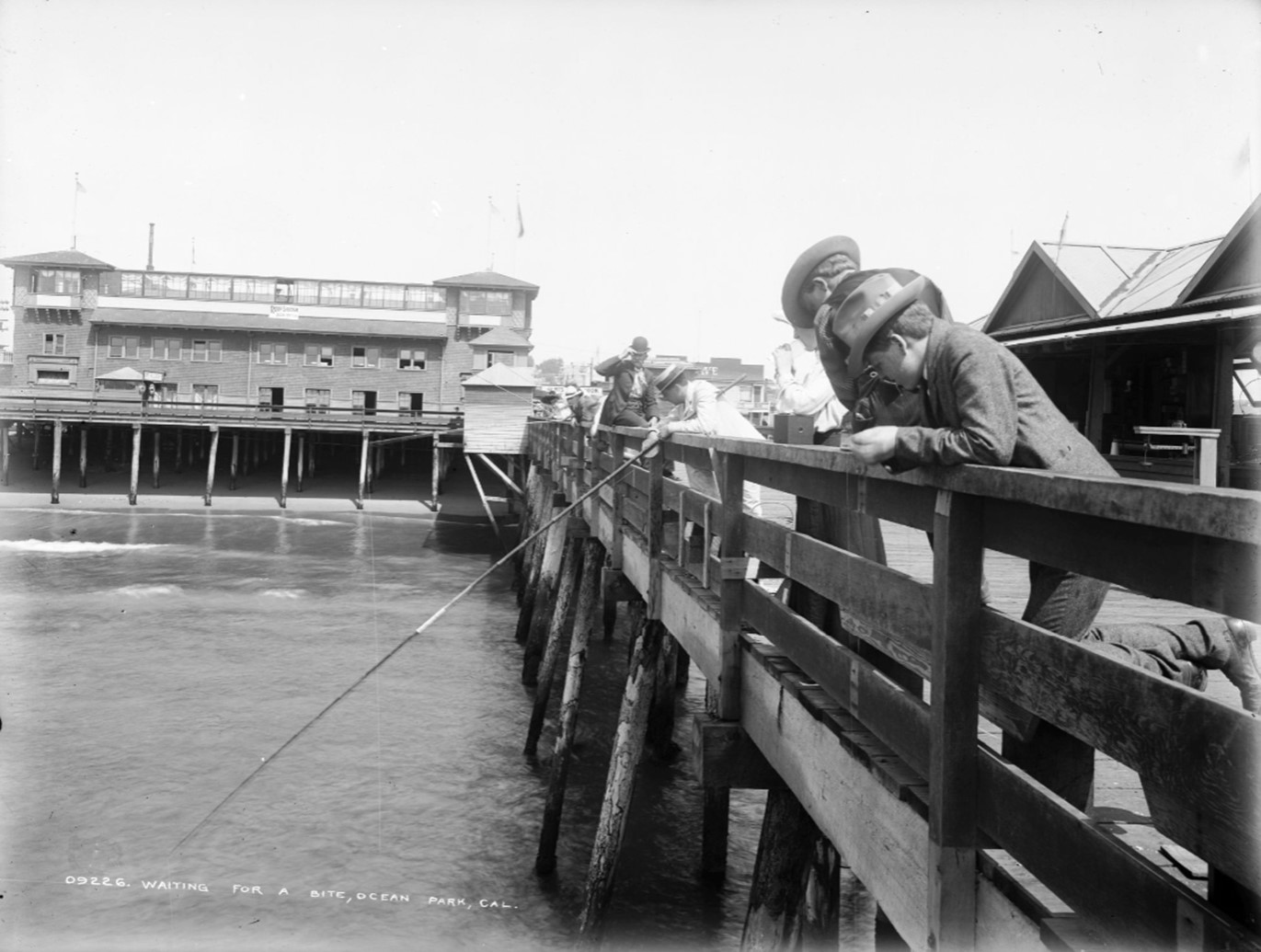 |
|
| (ca. 1910)* – Waiting for a Bite, Ocean Park – Several people are seen leaning on railings and fishing from Ocean Park Pier. One man is holding a bamboo (cane) fishing rod. Sign on the building in the background reads: "Roof Garden Now Open". |
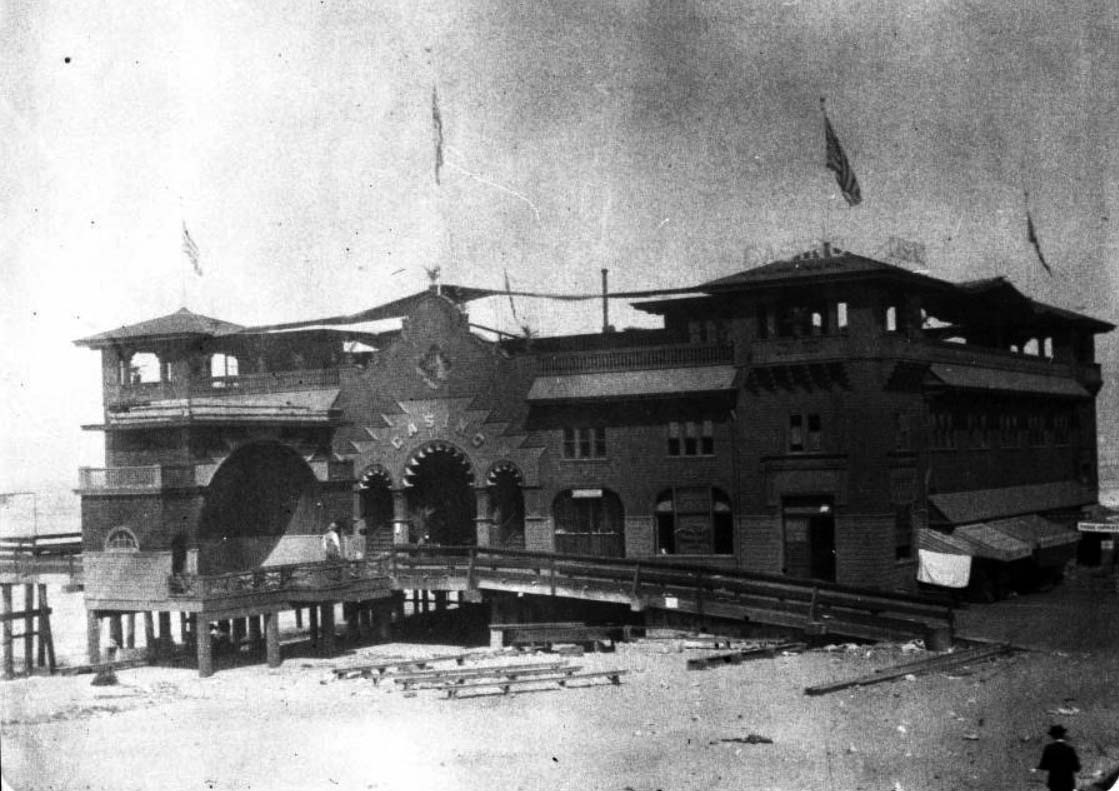 |
|
| (ca. 1910)* - View of the casino and band stand at Ocean Park in Santa Monica. The two-story brick building is at center. It has a wooden ramp leading up from the sandy beach to the entryway at center. The roof of the building is flat and has an open observation deck. Four towers are visible, one on each corner, and a sign over the arched entryway identifies the building as a casino. A man is standing near the entrance, and another is visible in the foreground at right. Several benches can be seen in the sand in front of the casino, and American flags fly from the top of the building. |
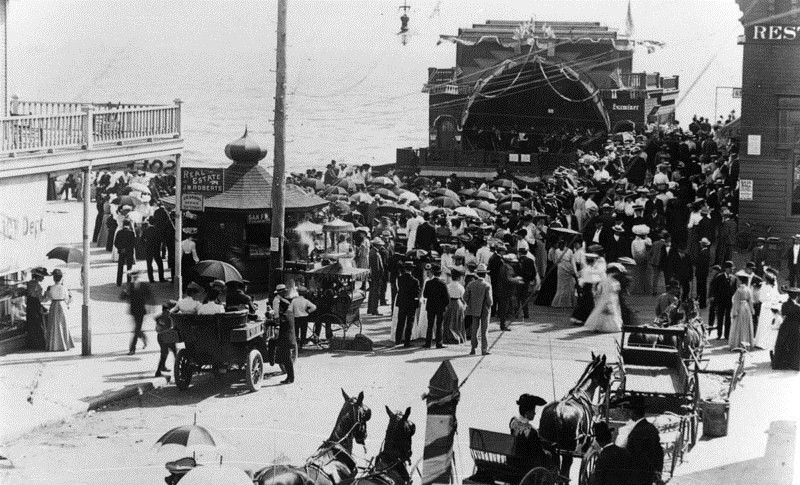 |
|
| (1912)* - Large crowds are gathered near a concert shell in Ocean park. There are more people than seats. Edges of buildings of several businesses can also be seen such as real estate and restaurants. An early model car and several horse-drawn wagons are parked in the foreground. |
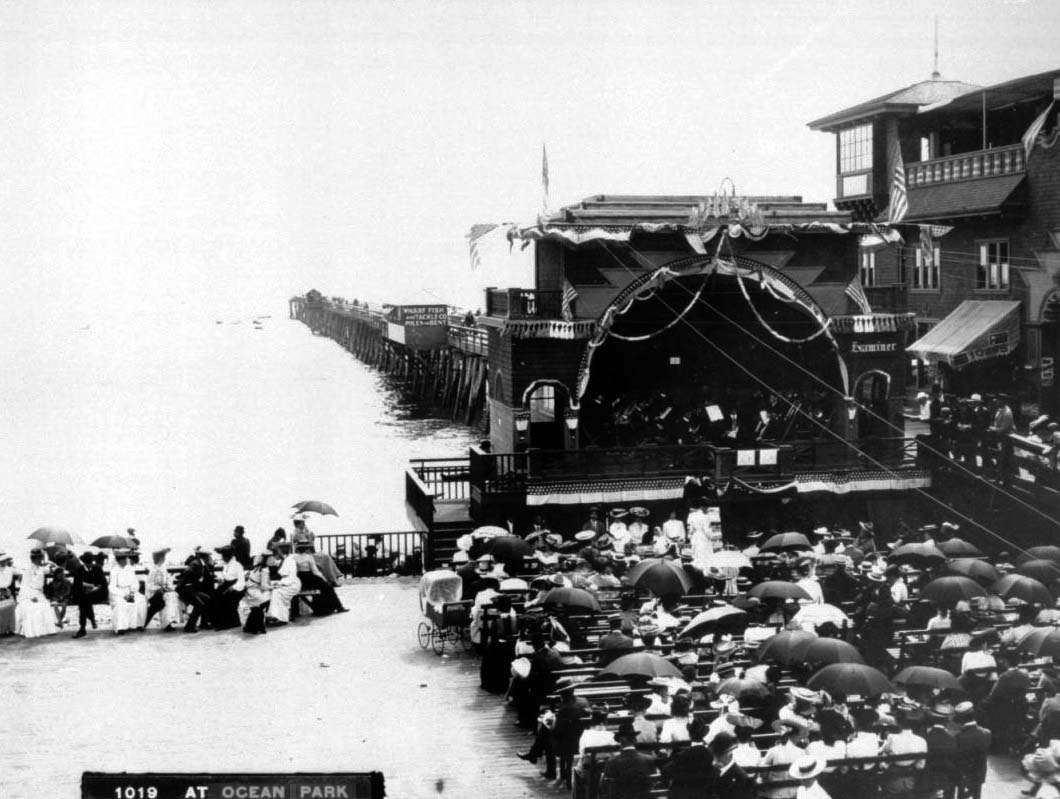 |
|
| (ca. 1910)* - Closer view of the Ocean Park bandstand showing Harry Moore's band playing in front of a crowd. Dozens of people, many holding umbrellas, are seated in chairs in front of the band, watching. Attached to the bandstand at right is a casino, and a pier juts into the water behind the bandstand building. More people can be seen seated on benches at left near the water's edge. A small shack on the edge of the pier is adorned with the words "Wharf Fish and Tackle Co. Poles for Rent". |
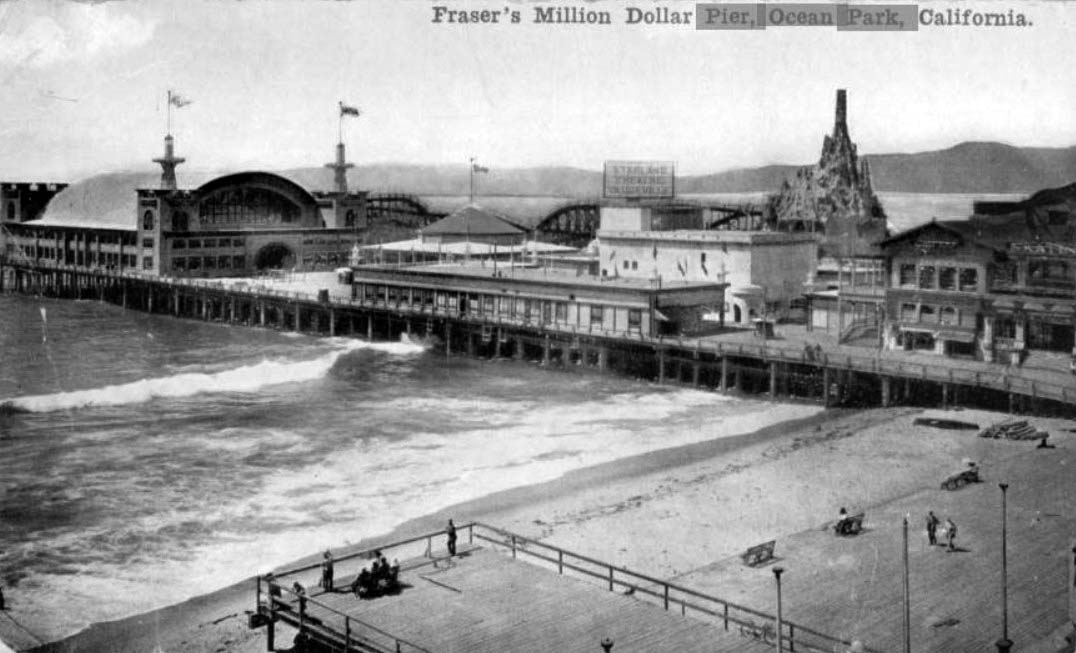 |
|
| (ca. 1911)* – Postcard view showing Fraser's Million Dollar Pier, Ocean Park. Fraser's Dance hall, the roller coaster, and Starland Theater can be seen on the pier, with a boardwalk and beach in the foreground. |
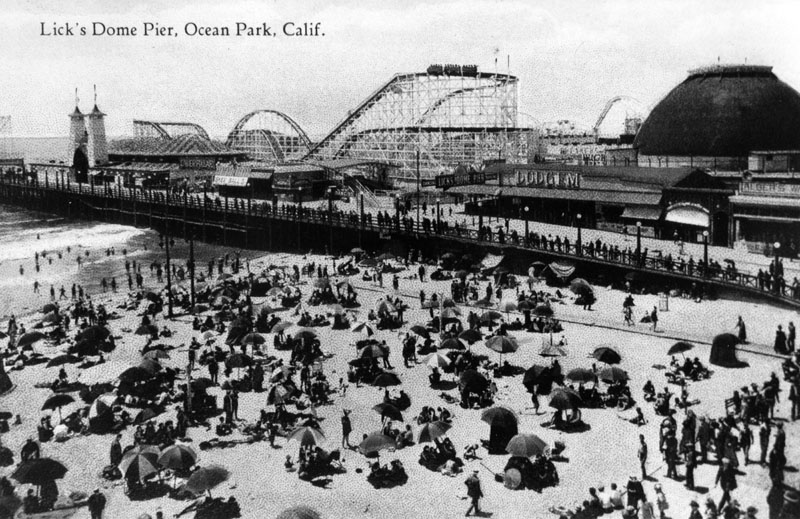 |
|
| (ca. 1911)* - View of the Lick's Dome Pier at Ocean Park. |
Historical Notes In 1911, Charles Lick added Lick Pier to the new Million Dollar Pier. They were both destroyed by fire in 1912 and again in 1924. The Lick Pier was rebuilt both times. The pier was finally done in by a fire in 1970, after which it was not rebuilt. |
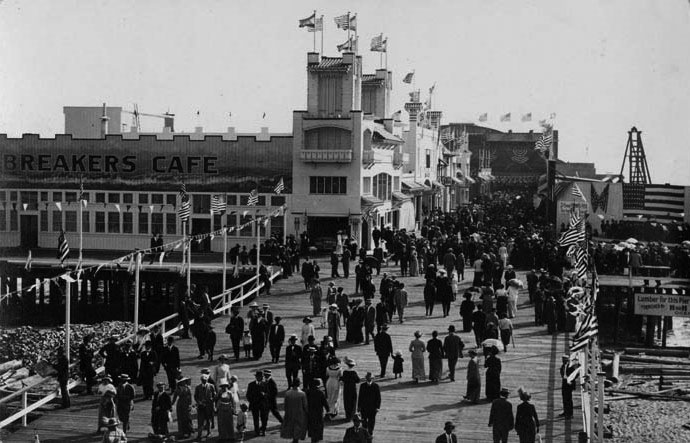 |
|
| (Early 1900s)^^ - A crowded day at the Ocean Park Pier in Santa Monica. |
Historical Notes The Ocean Park Pier, a combination of two piers: Million Dollar Pier and Lick Pier, burned down in 1912. In its place was rebuilt Fraser's Million Dollar amusement pier, which claimed to be the largest in the world at 1250 feet long and 300 feet wide. The pier housed a spacious dance hall, two carousels, the Crooked House fun house, the Grand Electric Railroad, the Starland Vaudeville Theater, Breaker's Restaurant and a Panama Canal model exhibit. It too burned within the year. |
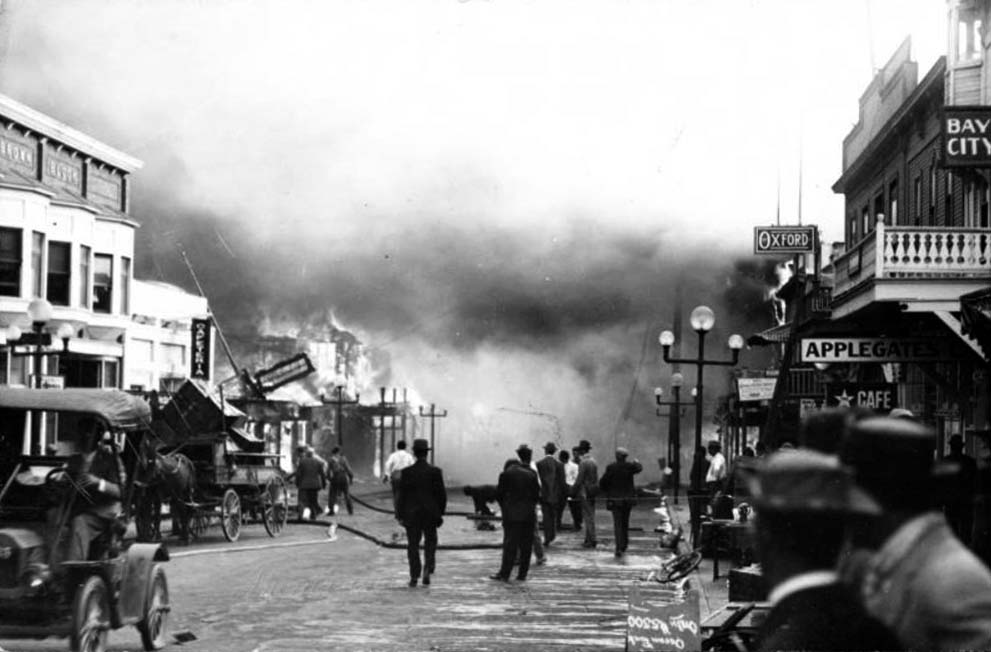 |
|
| (1912)- View showing people working to extinguish the fire on the Ocean Park pier in Santa Monica, 1912. The fire is blazing in the distance at left. A group of onlookers is gathered at center as is watching as firemen drag a large hose towards the building. The dirt road at center is muddy from the water used to fight the fire. An early automobile can be seen at left, and a large horse-drawn wagon is parked near the edge of the street at left. A collection of two-story buildings lines the road.; Legible signs include, from left to right: "Brown Block", "Cafeteria", "Oxford", "Applegate's Café", and "Bay City". |
Historical Notes Click HERE to see more Early Southern California Amusement Parks. |
* * * * * |
Bristol Pier (originally White Star Pier, later Crystal Pier)
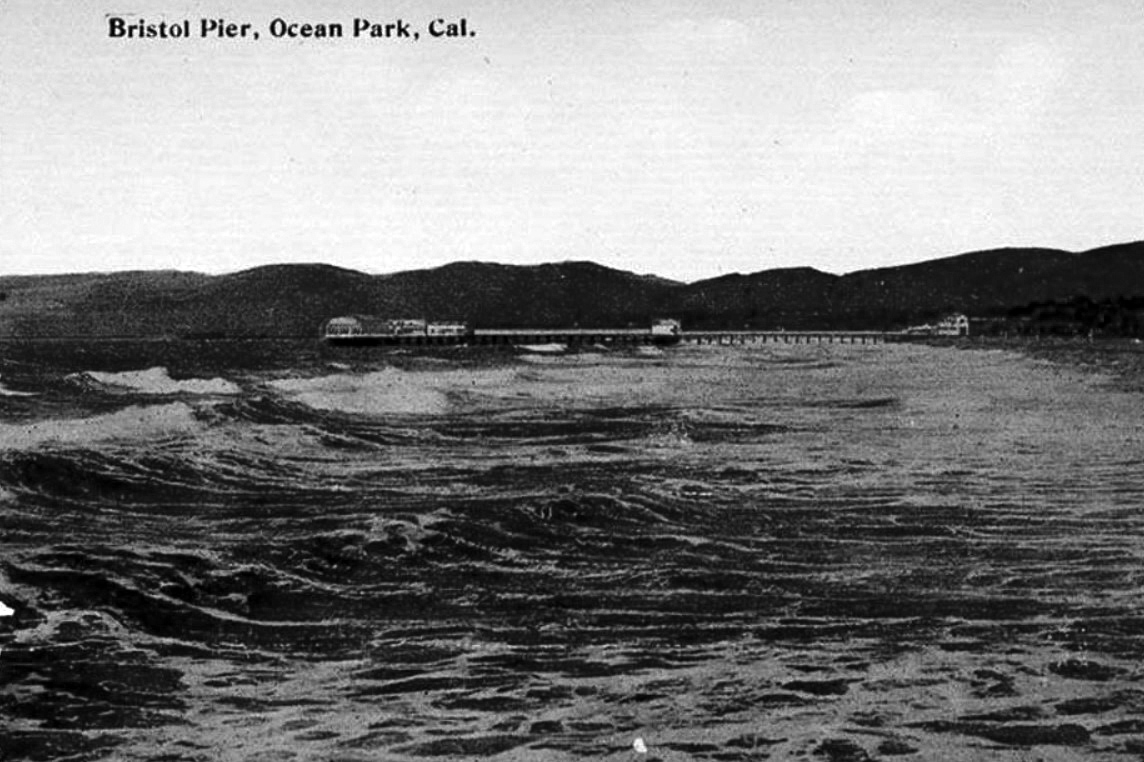 |
|
| (ca. 1908)* – View looking north from Ocean Park Pier showing Bristol Pier in the distance. |
Historical Notes The smallest pier, south of Santa Monica Pier at Hollister Avenue, existed from 1905 to 1949. It was built in 1905 as the White Star. In 1908 it was renamed the Bristol Pier. From 1919 to 1949 it was the Crystal Pier. The pier was demolished in 1949. |
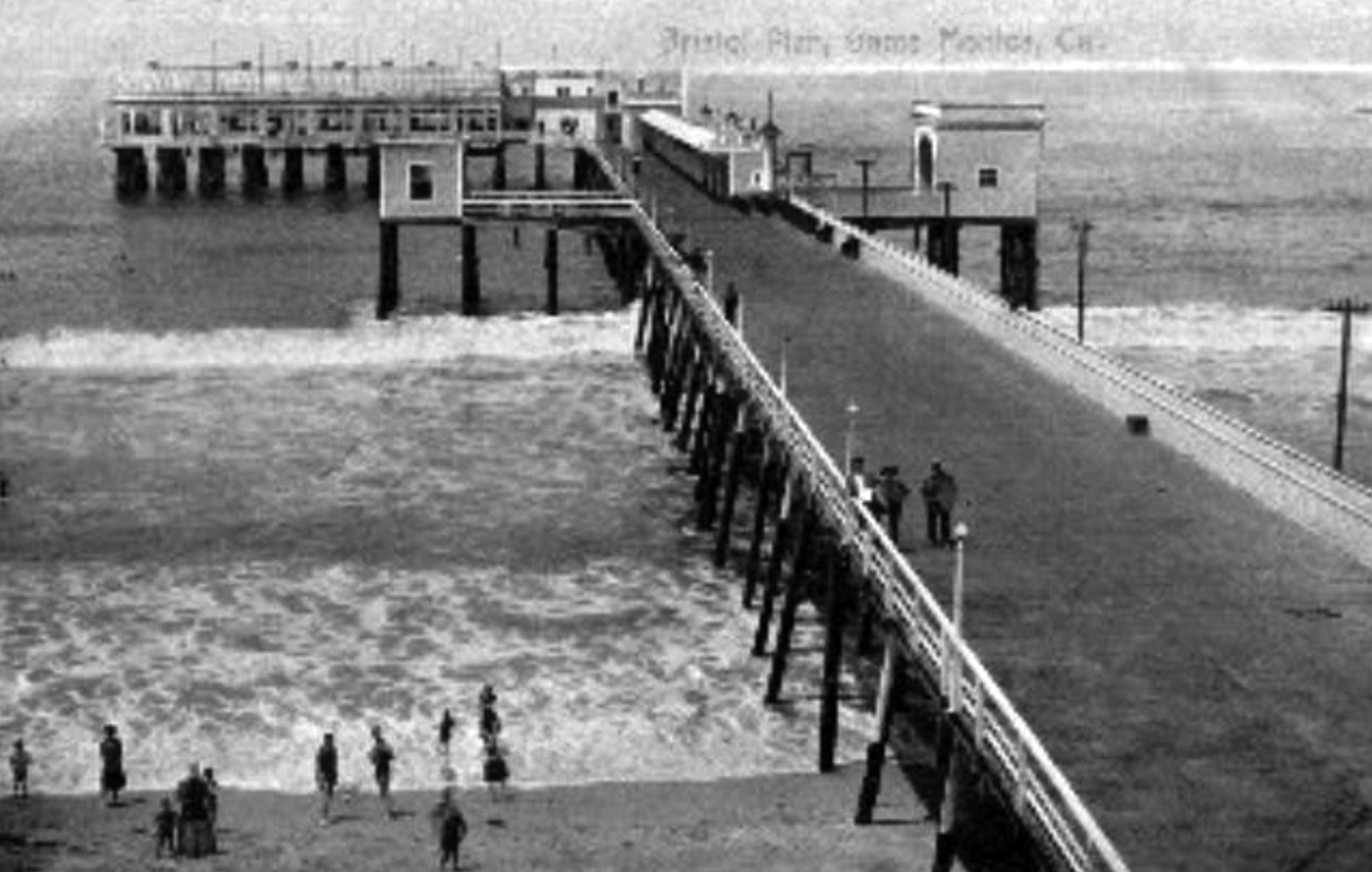 |
|
| (1908)* – Postcard view showing the Bristol Pier located in Ocean Park (Santa Monica) at the foot of Hollister Avenue. |
Historical Notes The White Star pier was completed in 1905, but it was not a paying investment during its first season and was sold in 1906. Renamed the Bristol pier in 1908, and the Crystal Pier in 1919 by Nat Goodwin. |
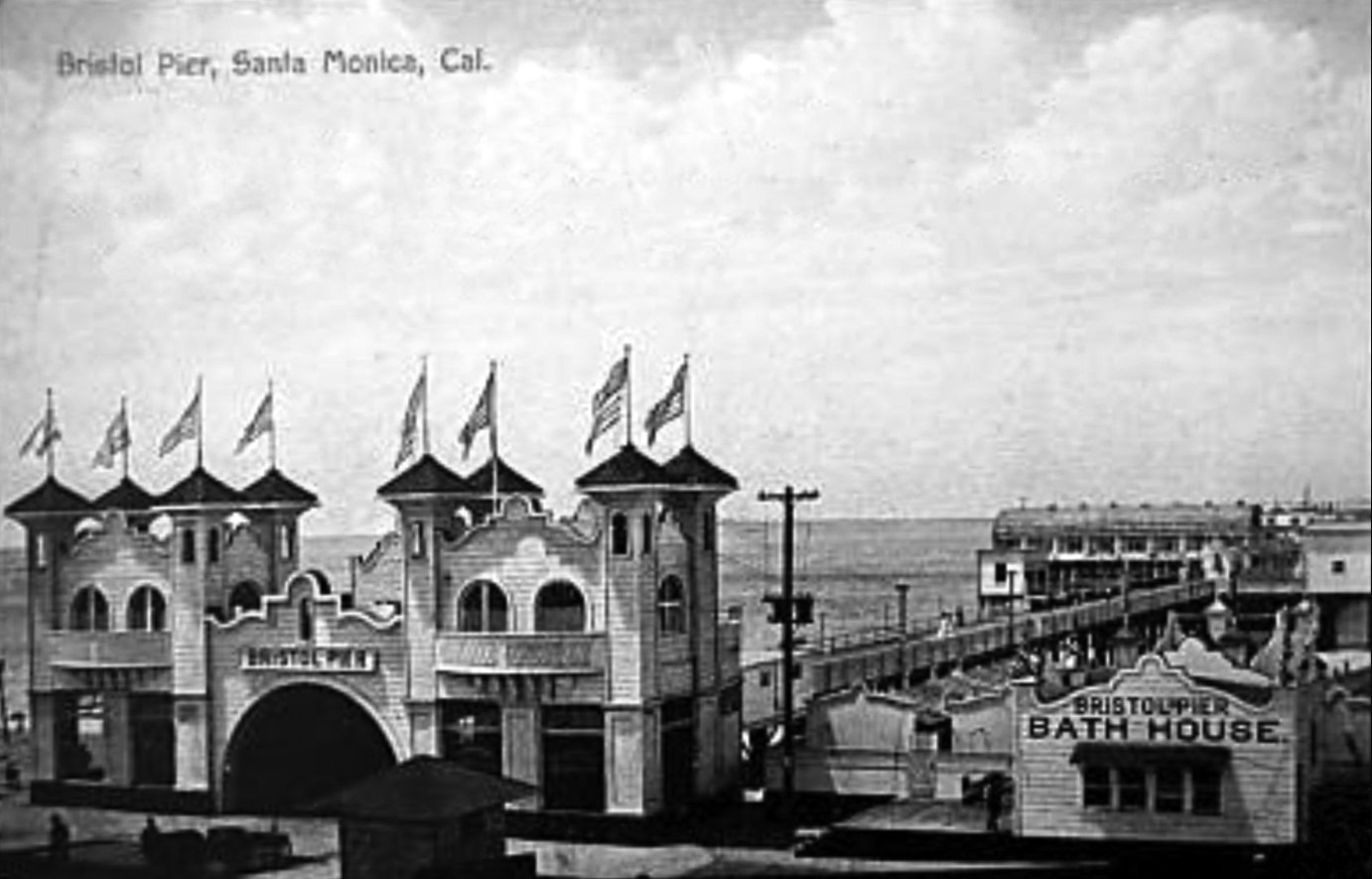 |
|
| (1909)* – Postcard view showing the flags rising from the ornate entrance to Bristol Pier in Ocean Park* with the Bristol Pier Bath House seen at lower-right. |
Historical Notes Although Santa Monica and Ocean Park (South Santa Monica) were both settled at the same time (in the early 1870’s), Ocean Park’s history is somewhat independent from that of the rest of Santa Monica. Separated from the north by a gully which today is occupied by the Santa Monica Freeway, Ocean Park was initially oriented towards the beach where a series of piers and other tourist attractions were erected in 1890 to 1910. Much of the housing during this initial period of development was deliberately temporary in nature. Although residential tracts began to be subdivided from the large blocks of land owned by families such as the Lucas’ and the Vawters, construction tended to cluster on streets nearest the ocean, with the 4th Street hill as the inland boundary. One of the city’s oldest neighborhoods, Ocean Park sprang to life with Abott Kinney’s 1891 Ocean Park Development Company. Kinney bought a sandy strip of land in Santa Monica’s southwestern edge and began building roads, homes, parks and piers. After 1904, Kinney moved his attention to his Venice of America development (also called Ocean Park at the time) , south of the Santa Monica city boundary. The history of Venice and Ocean Park are intertwinned. From 1905 to 1925, Ocean Park was developed by people such as Fraser, Merritt Jones, Hart, Hollister and Wadsworth. |
Café Nat Goodwin
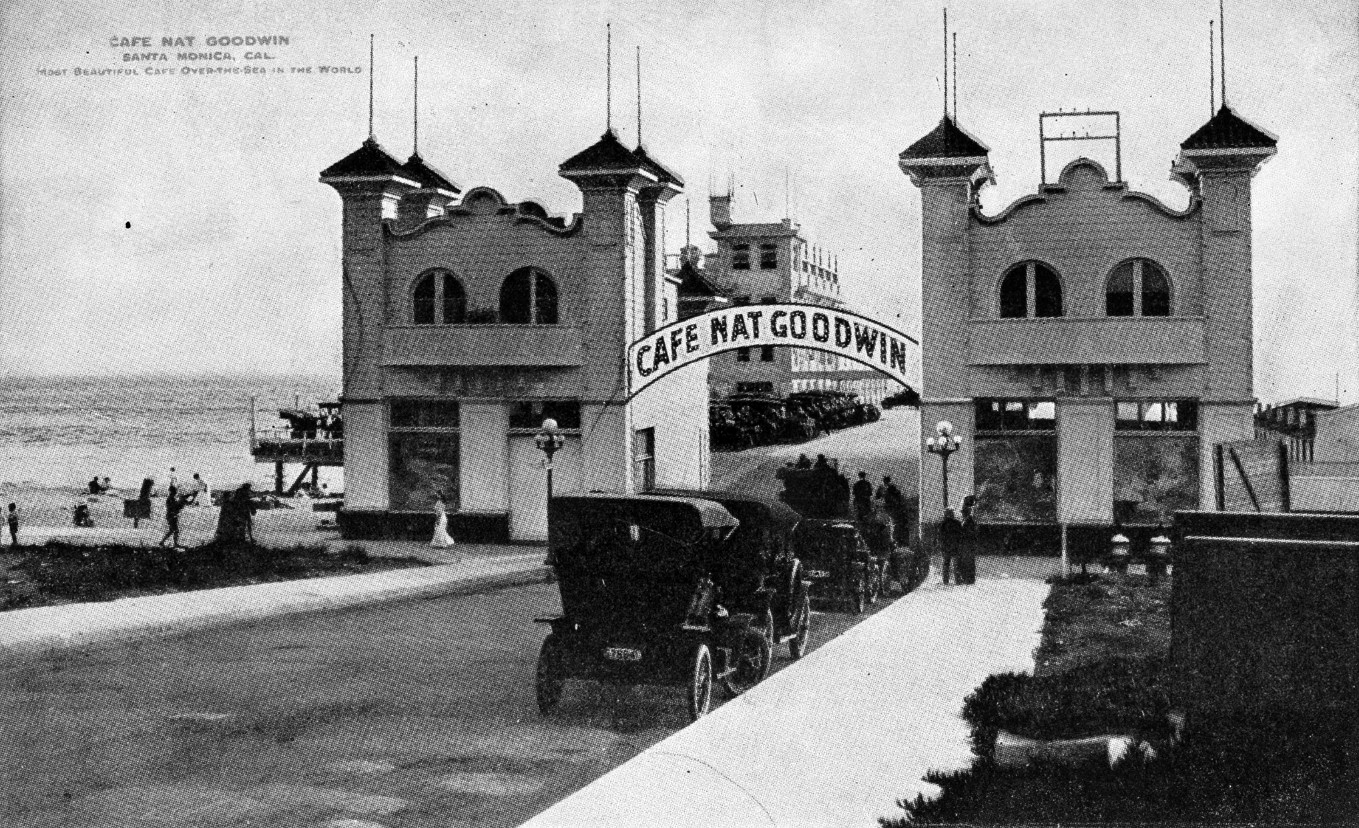 |
|
| (1917)* – View showing cars parked at the foot of Hollister Avenue in front of the private Bristol Pier. A large arched sign reads Café Nat Goodwin. Courtesy of Ernest Marquez Collection |
Historical Notes Nat Goodwin was a vaudevillian comic who also appeared in a few films between 1912 and 1916. In about 1913 Goodwin opened a club on the private Bristol Pier in Santa Monica. The Cafe Nat Goodwin was one of the swankiest on the beach and included a cabaret, ballroom and a roof garden. Goodwin's club was frequented by fellow film funny folks, Charlie Chaplin, Mabel Normand, and Mack Sennett and soon became an area hot spot. Goodwin sold his cafe to Baron Long about 1919 and it became the Sunset Inn. Goodwin died in 1919. |
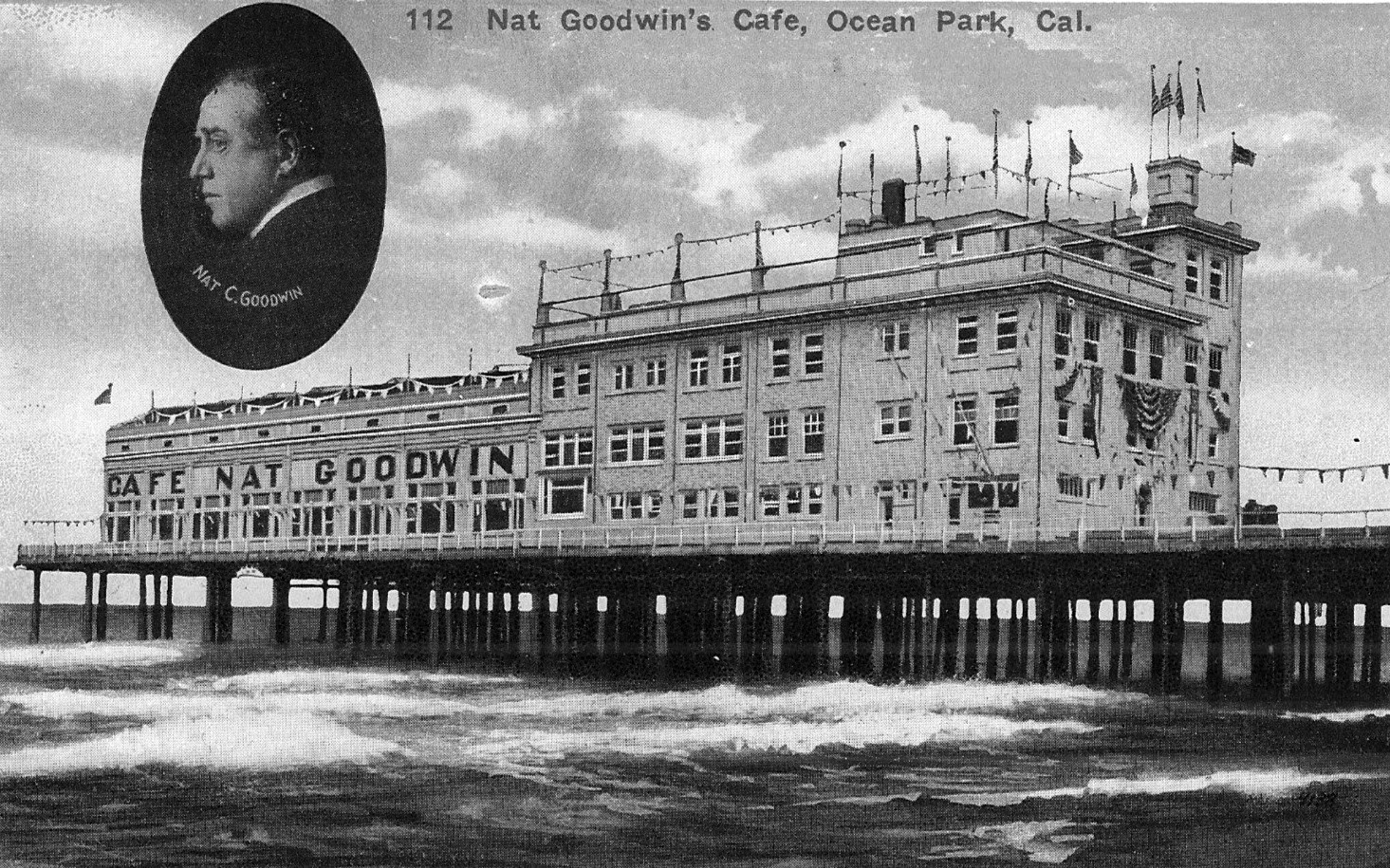 |
|
| (ca. 1917)* – Postcard view of Café Nat Goodwin located on the private Bristol Pier in Santa Monica. |
Historical Notes The restaurant, Cafe Nat Goodwin, was located on Hollister Avenue at Crystal Pier in Ocean Park. It claimed to be the "largest and best cafe on the Pacific coast." Originally, the Crystal Pier was named the White Star Pier, then was renamed the Bristol Pier after the Bristol Cafe located there. When Nat Goodwin took over the Bristol Cafe and renamed it the Cafe Nat Goodwin, the Pier became known as the Crystal Pier. |
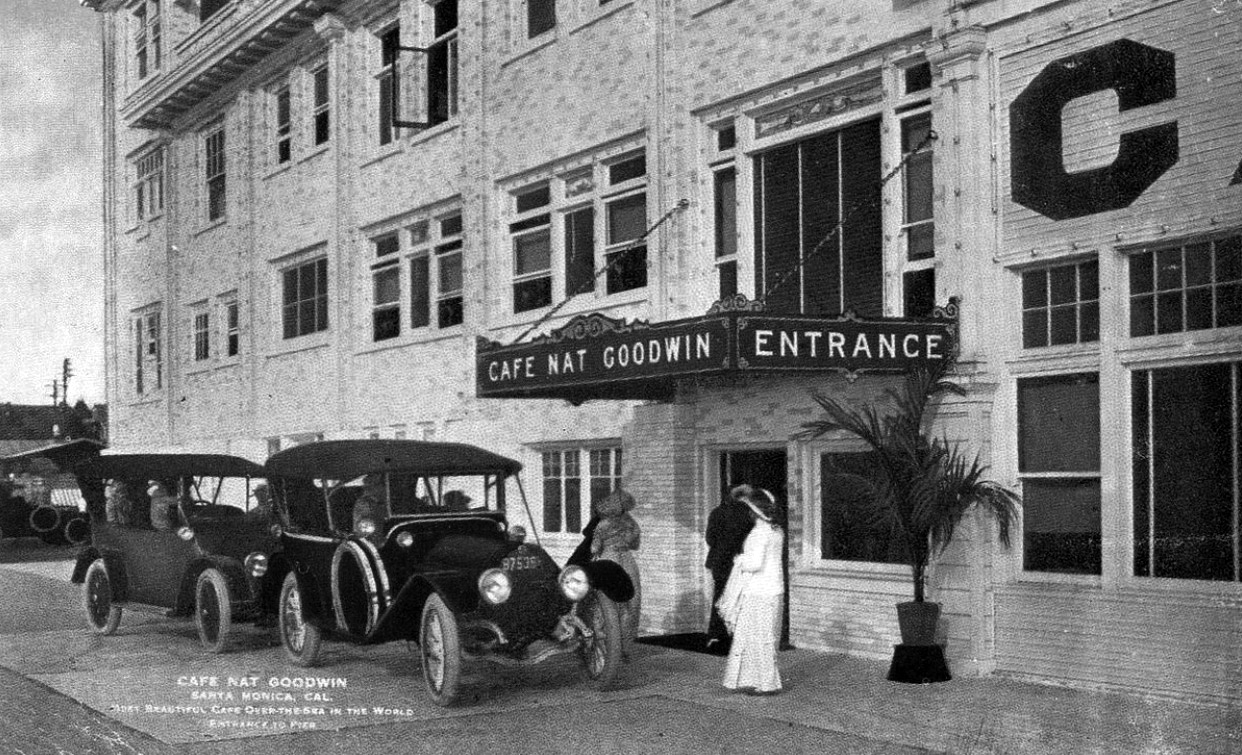 |
|
| (1917)* - Postcard photo showing entrance to Café Nat Goodwin located on Bristol Pier, Santa Monica. |
Historical Notes Goodwin opened an incredibly hip and exclusive operation that took use of a ball room, inclusive gardens on the roof and live cabaret. This era in the early 20th century was full of expansion and Goodwin recognized that, renaming the pier — Crystal Pier. Shortly after renaming the restaurant, Goodwin sold the restaurant to Baron Long. The Nat Goodwin Cafe on Ocean Park became the Sunset Inn and Goodwin died later that year from “shock” two weeks after his eye was removed. At the time of his death, Goodwin was deeply in debt, with his estate listing assets of $6,895 and debts of $15,000. When he died he was said to have been engaged to the actress Georgia Gardner. White Star Pier (1905 - 1908) – Bristol Pier (1908 - 1919) – Crystal Pier (1919 – 1949) |
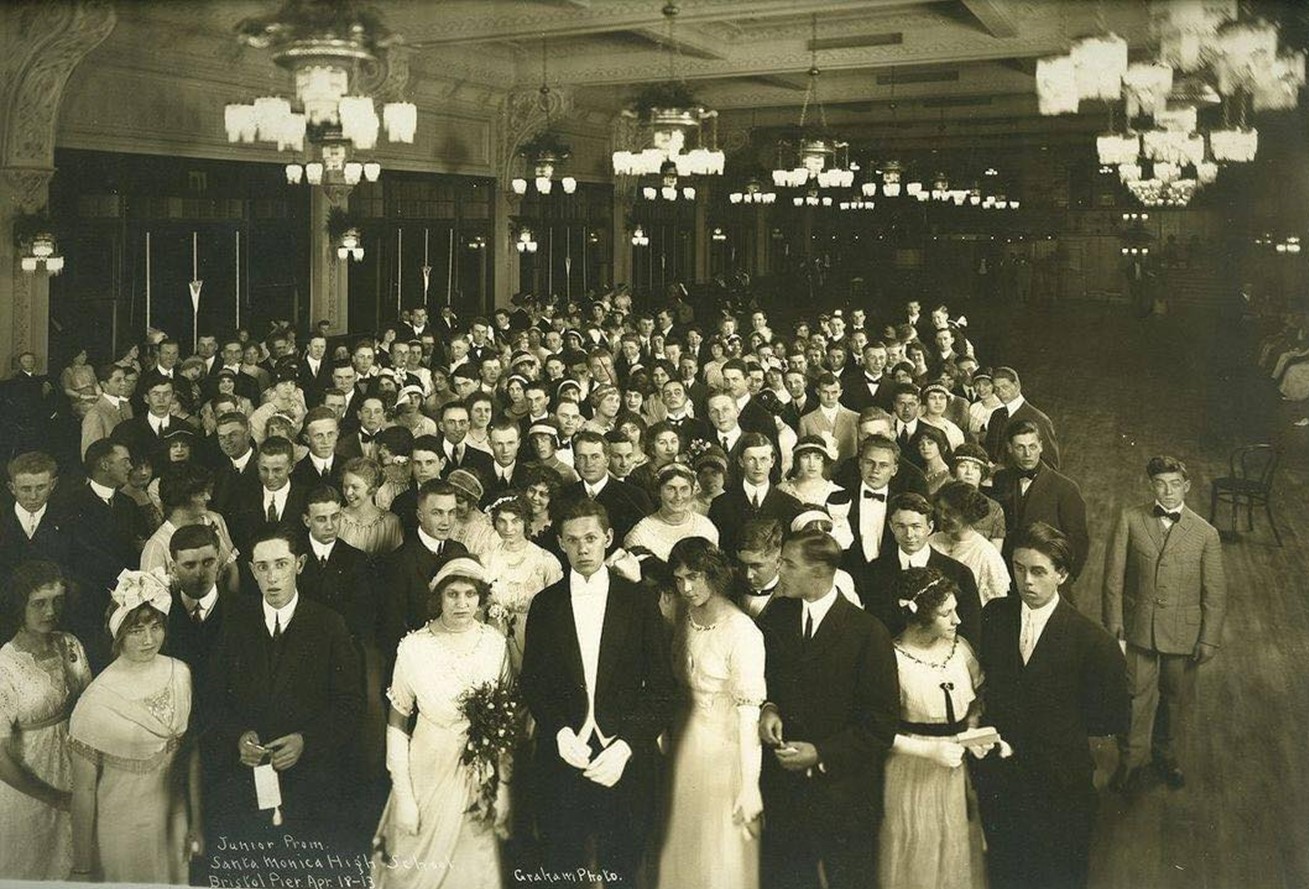 |
|
| (1913)* - Santa Monica High School Junior Prom at the ballroom of the Café Nat Goodwin on Bristol Pier, April 18, 1913. |
Historical Notes lThe ballroom at Café Nat Goodwin, part of the upscale dining complex on Bristol Pier, was a key feature of the establishment when it opened in 1913. Reflecting the café's status as a fashionable entertainment destination, the ballroom was elegantly decorated and spacious enough to accommodate live music and dancing, complete with a proper dance floor for popular dances of the era. This multi-faceted venue, which also included a cabaret and roof garden, catered to wealthy patrons and celebrities, enhancing its reputation as one of the "swankiest" spots on the beach. |
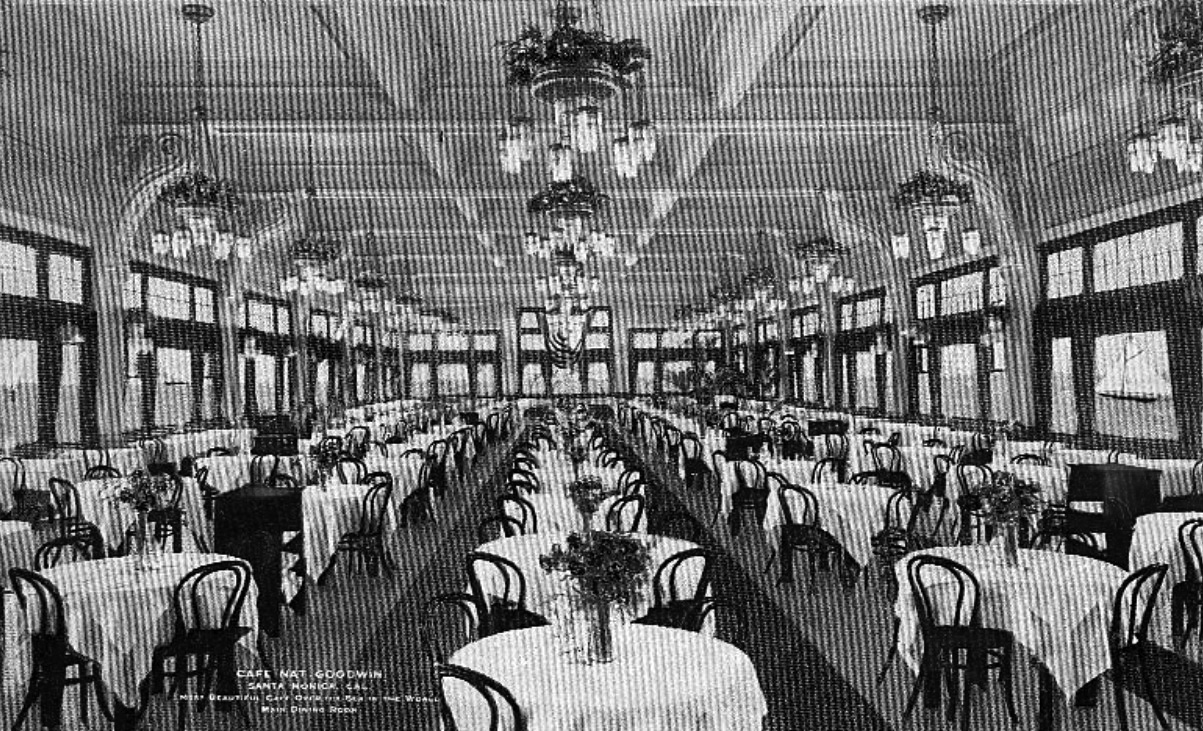 |
|
| (ca. 1917)* – Postcard photo showing main dining room at the Café Nat Goodwin. |
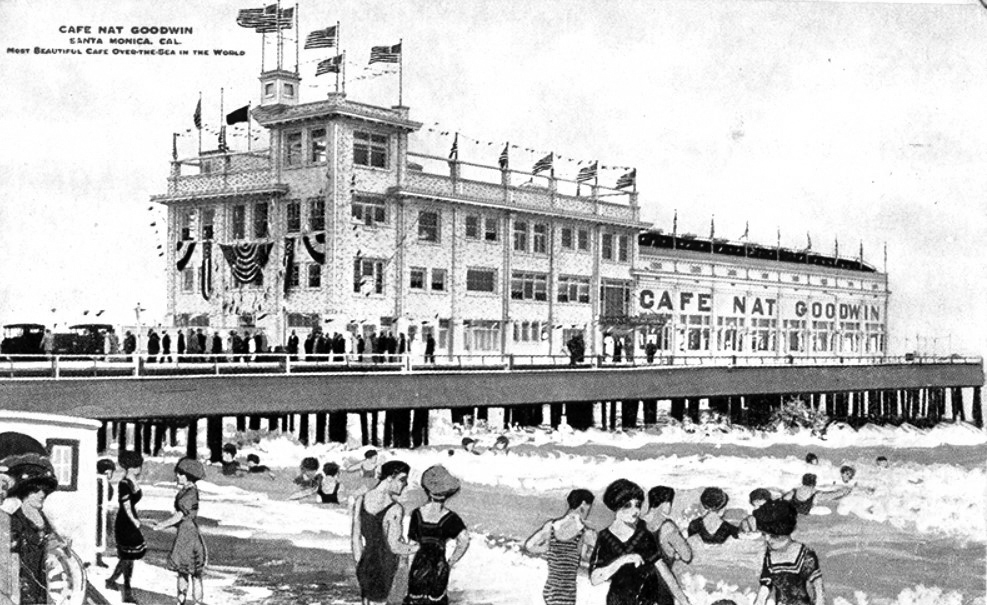 |
|
| (ca. 1917)* - Postcard view showing the grand restaurant built by Nat Goodwin on a pier that hangs above the ocean. |
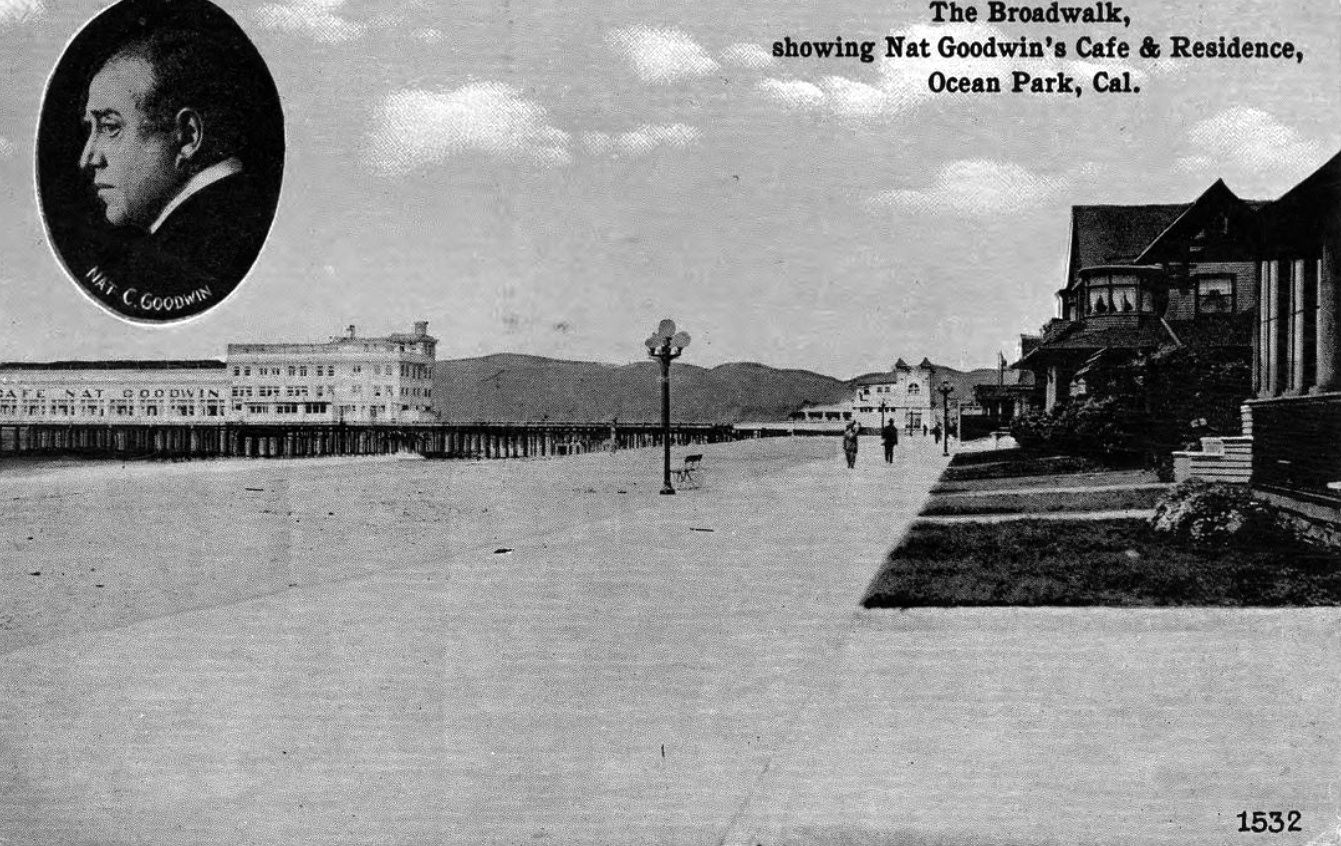 |
|
| (ca. 1915)* – Postcard view looking north showing the boardwalk leading to Bristol Pier where the where Nat Goodwin's Cafe is located with residences seen on the right. |
Historical Notes After Nat Goodwin sold the business, its name was changed to the Sunset Inn. |
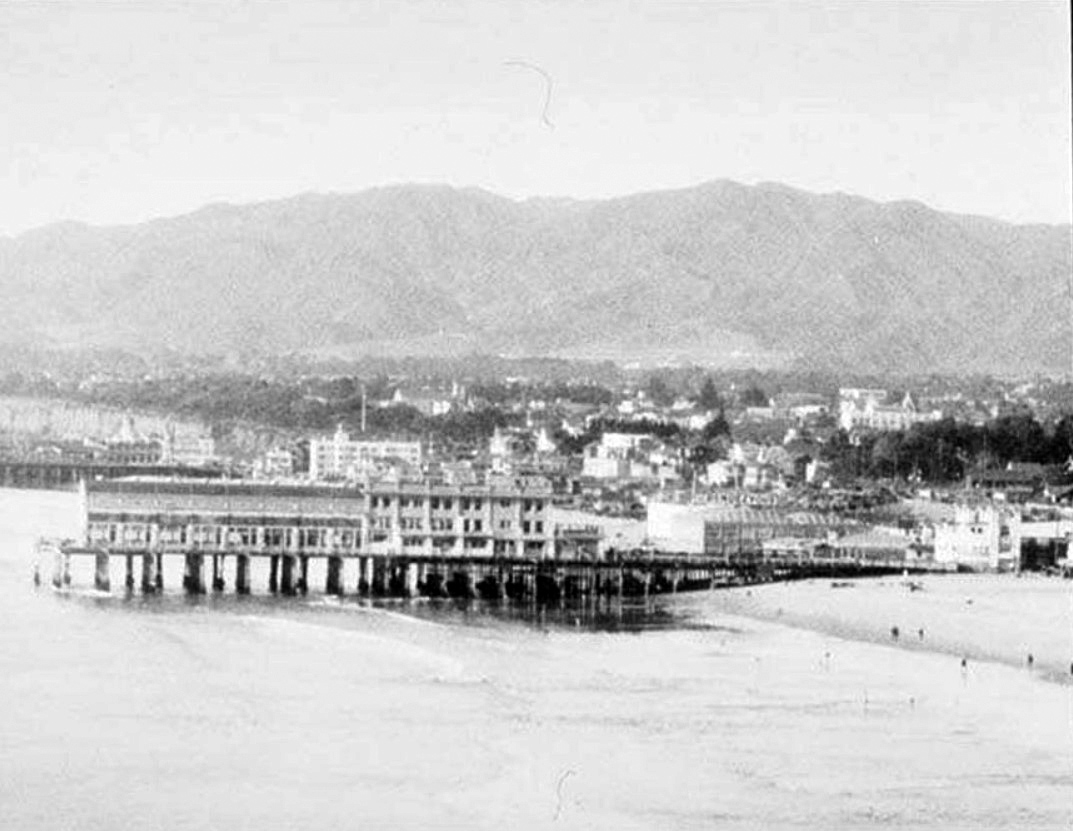 |
|
| (1923)* – Aerial view looking at the Crystal Pier showing the Rendevous Ballroom. Note how much shorter the pier is when compared to earlier photos (most likely due to storm damage). |
Historical Notes Records show the pier had three names during its existence, from its construction in 1905 to its demolition in 1949: White Star Pier (1905–1908) Bristol Pier (1908–1919) Crystal Pier (1919–1949) |
* * * * * |
Santa Monica's Cement Boardwalk and Piers
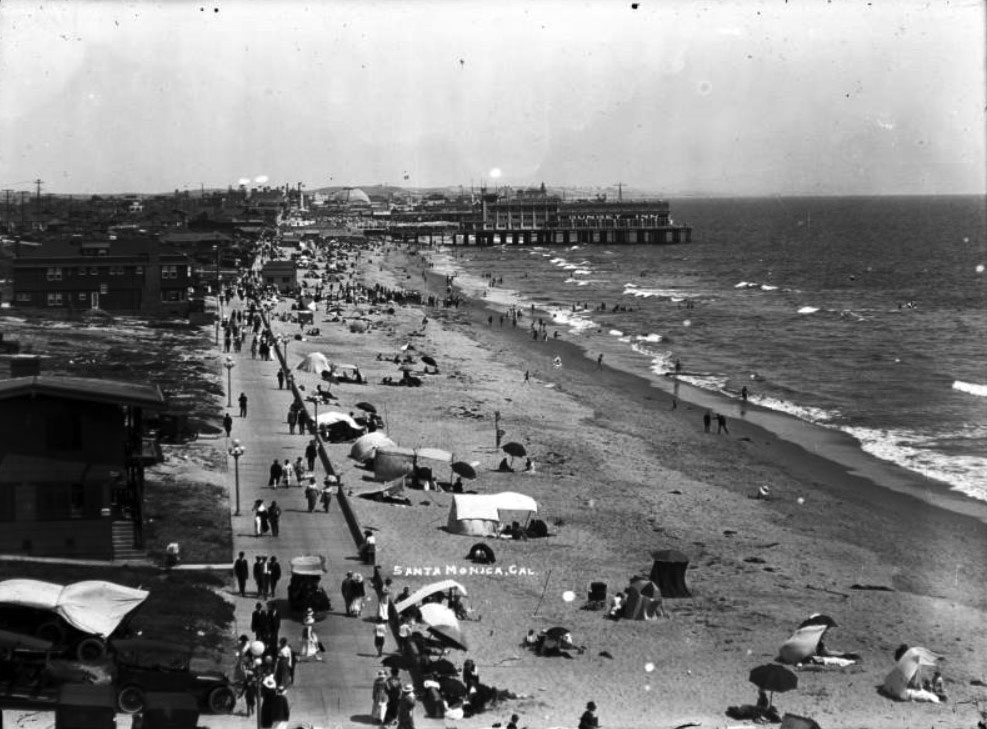 |
|
| (ca. 1915)* - Birdseye view of the beach in Santa Monica looking south with Bristrol Pier in the background. The beach is a wide, sandy tract of land that extends from the foreground away from the viewer into the distance at center. There are a few people playing in the surf and many people resting beneath umbrellas or tents on the sand. The left side of the beach is bordered by a cement sidewalk, and a large number of pedestrians is walking along the path. At left, a series of two-story beach houses lines the sidewalk. Several early-model automobiles are parked in driveways and alleys near the sidewalk at left. There is a short pier jutting out into the water in the background at center and a large building is constructed near the right side of the pier. |
Historical Notes In the early 1900s, Santa Monica's boardwalk emerged as a vibrant coastal destination that captured the imagination of Southern California's growing population. Anchored by the newly constructed Santa Monica Pier, which opened in 1909, the area became a bustling hub of entertainment and leisure. The Pacific Electric Railroad made the beach easily accessible, drawing visitors from across Los Angeles who came to enjoy roller coasters, carousels, vaudeville shows, and seaside attractions. |
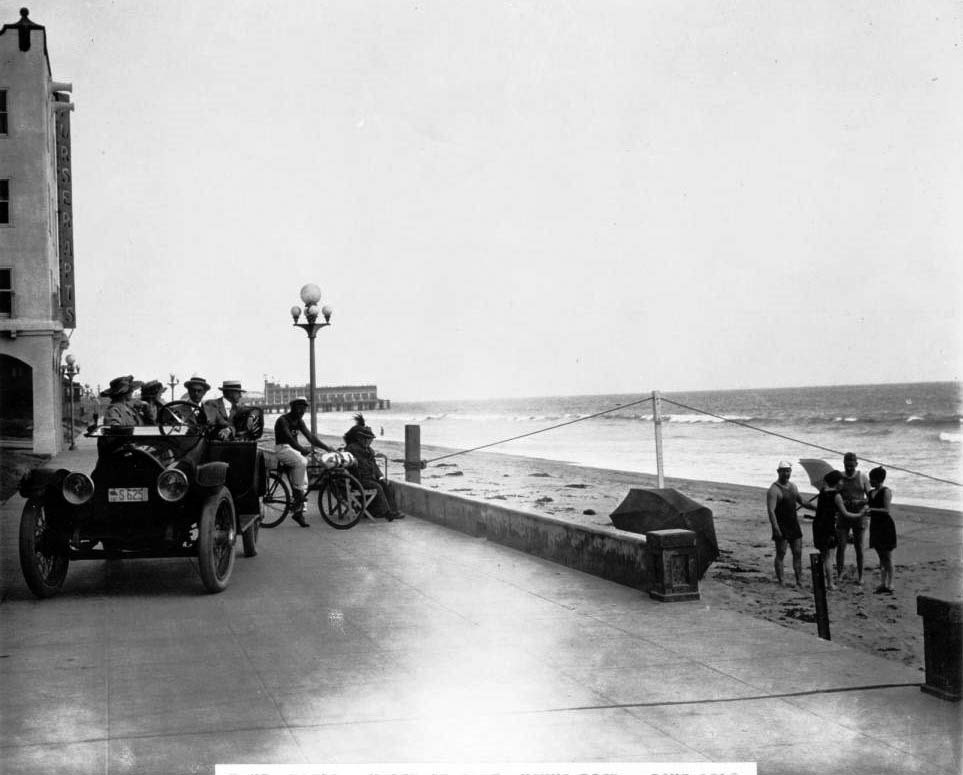 |
|
| (ca. 1915)* - Photograph of people on the beach in Santa Monica, looking south toward Bristol Pier. Four people in bathing suits stand in the sand of the beach on the right with the water washing in and out behind them. A tile sidewalk lies on the left where people stay finely dressed in their automobile. A shop can be seen on the far left of the sidewalk further back while a large building stands on the beach in the background. |
Historical Notes The boardwalk was more than just an amusement area; it was a social center where people could swim, sunbathe, and gather at venues like the Casino Restaurant and Japanese Tea Garden. Wealthy elites and working-class families alike were drawn to the pier's attractions, while surrounding commercial developments sprouted banks, restaurants, and furnished rooms to support the growing tourism industry. |
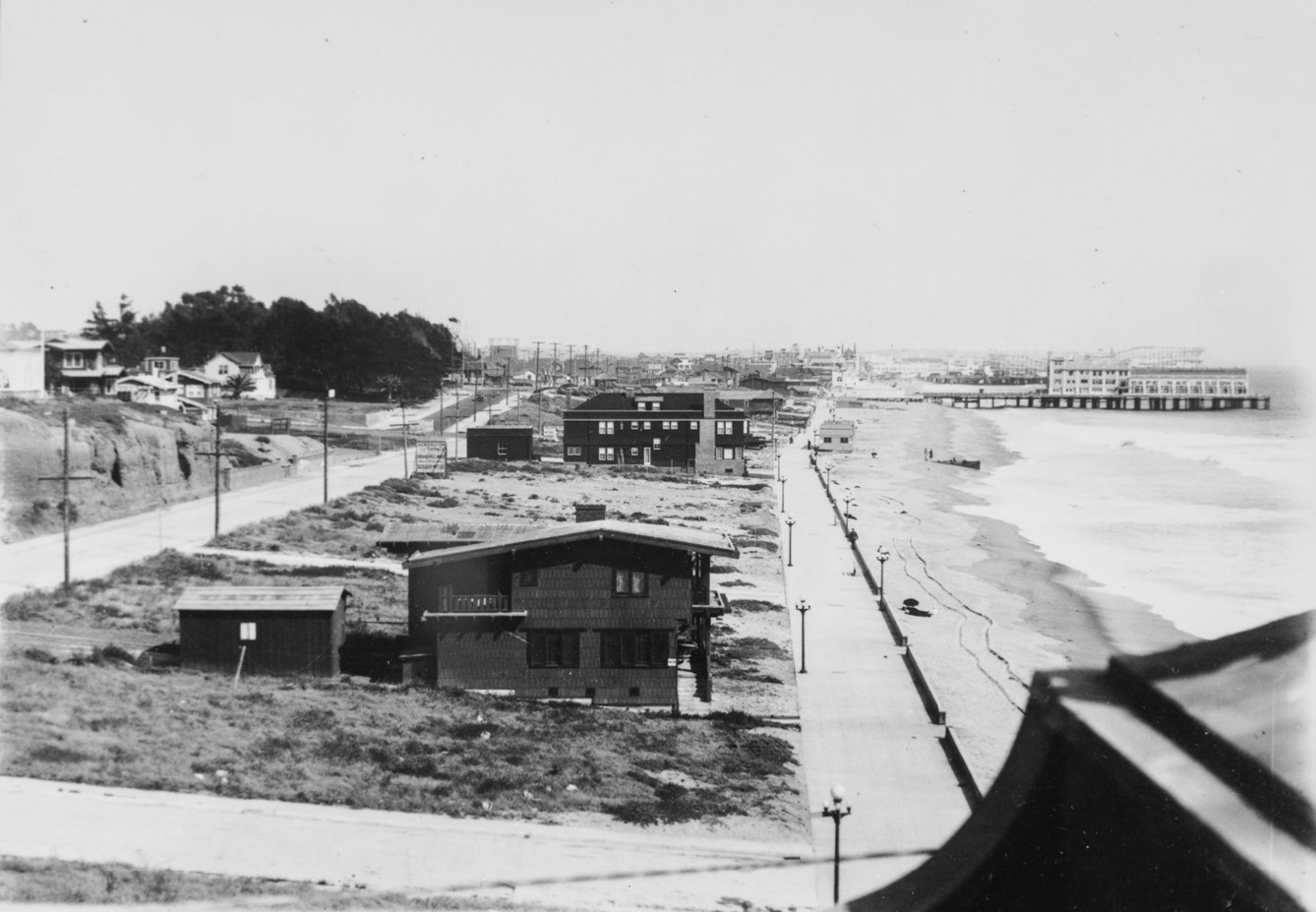 |
|
| (1910s)* – Looking south from near the Santa Monica Pier, the view shows beach houses lining the boardwalk. In the distance, Bristol Pier (renamed Crystal Pier in 1919), home to the once-famous Café Nat Goodwin, is visible, with Ocean Park Pier and its roller coasters further back. On the left, a sign along the road reads "Kensington Terrace, Residents Only ...". Photo from the Ernest Marquz Collection. |
Historical Notes Café Nat Goodwin openend in 1913. Goodwin sold his cafe to Baron Long about 1919 and it became the Sunset Inn. The name of the pier also changed in 1919 from Bristol Pier to Crystal Pier. Kensington Terrace was a distinctive residential development in Santa Monica during the 1920s, created by developer Elliot Schrader between the Vicente Terrace and Seaside Terrace tracts. Situated along the city's rapidly developing coastline, the tract emerged during a transformative period when Santa Monica was experiencing significant urban growth, with its population nearly doubling from 15,000 to 32,000 during the decade. Like many coastal developments of its era, Kensington Terrace likely represented an upscale residential area targeting affluent homeowners seeking proximity to the beach and the city's emerging urban amenities. While specific architectural and demographic details remain limited, the tract was part of the broader real estate expansion that characterized Santa Monica's coastal landscape in the early 20th century, reflecting the city's economic prosperity and growing desirability as a residential destination during the Roaring Twenties. |
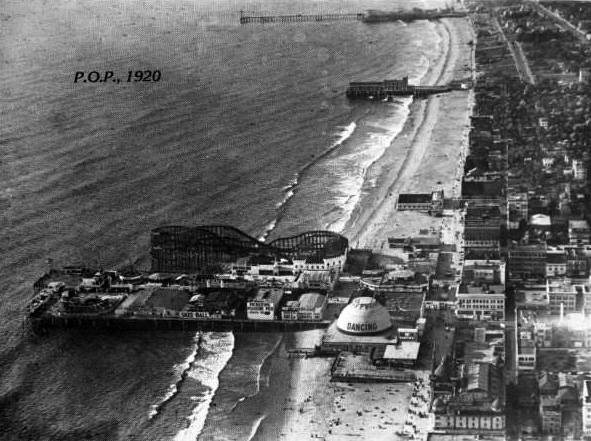 |
|
| (1920)* - Aerial view of Ocean Park Pier showing it's large roller coster. The long pier to the north (top of photo) is the Santa Monica Pier. It too had its own amusement park starting in 1916. In between the two longer piers is the shorter Crystal Pier (originally White Star Pier then Bristol Pier). |
Historical Notes In the 1920s, Santa Monica Bay was lined with numerous piers due to the area's booming tourism, vibrant recreational activities, and strategic importance for transportation and commerce. The piers served as hubs for economic growth, attracting visitors with entertainment, dining, and amusement parks. Additionally, they enhanced real estate development by making coastal properties more attractive and served as key social and community gathering spots. |
 |
|
| (1928)* – A strongman in a leopard-print bodysuit pulls a car packed with beachgoers by his teeth, near one of Santa Monica’s piers. Just another day of seaside spectacle and vintage showmanship. Photo from the Ernest Marquez Collection. |
Historical Notes In the 1920s, Santa Monica’s piers were vibrant hubs of entertainment where seaside spectacles and vintage showmanship were common. Acts like a strongman in a leopard-print bodysuit pulling a car full of beachgoers by his teeth fit perfectly into the lively beach culture of the time. The piers featured a mix of vaudeville performances, athletic feats, and circus-like stunts designed to captivate crowds. This tradition of public displays of strength and novelty acts helped define Santa Monica as a popular playground blending physical culture, spectacle, and Hollywood glamour well before the famous Muscle Beach era of the 1930s |
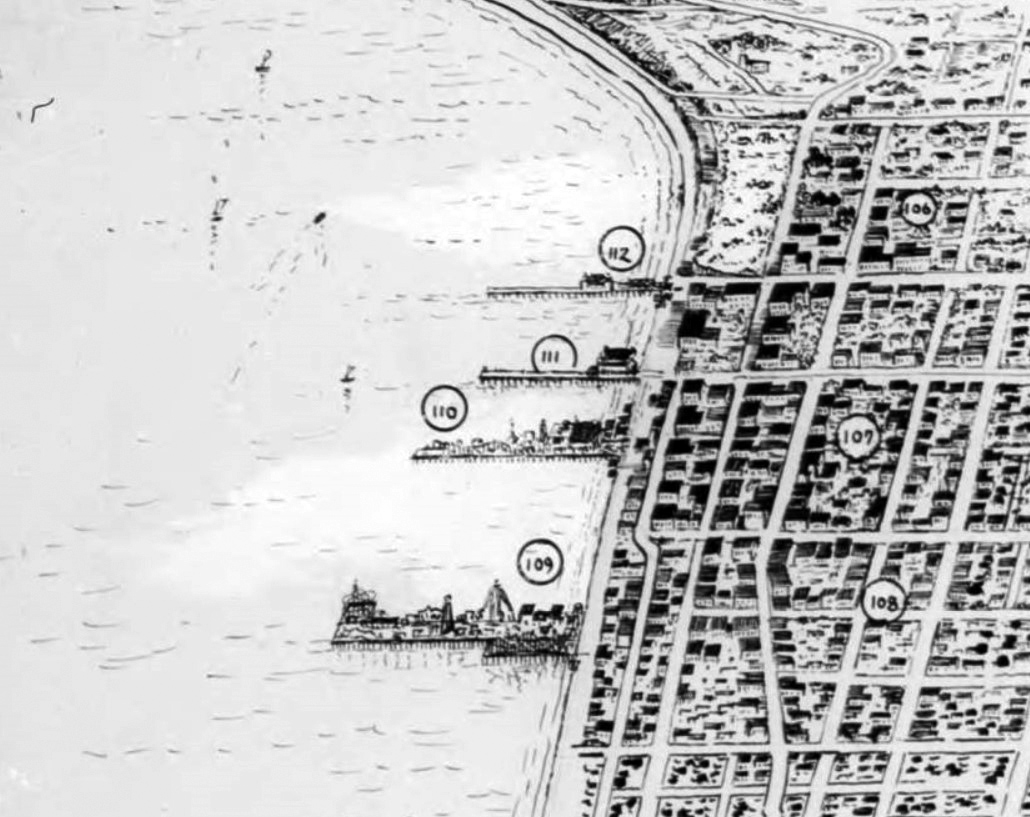 |
|
| (1927)* – Detail of a map showing four of the main piers in Santa Monica Bay. |
Historical Notes 112 – Santa Monica Pier 111 – Crystal Pier 110 – Ocean Park Pier 109 – Pickering Pier / Venice Pier Click HERE to see more of the Piers of Santa Monica Bay. |
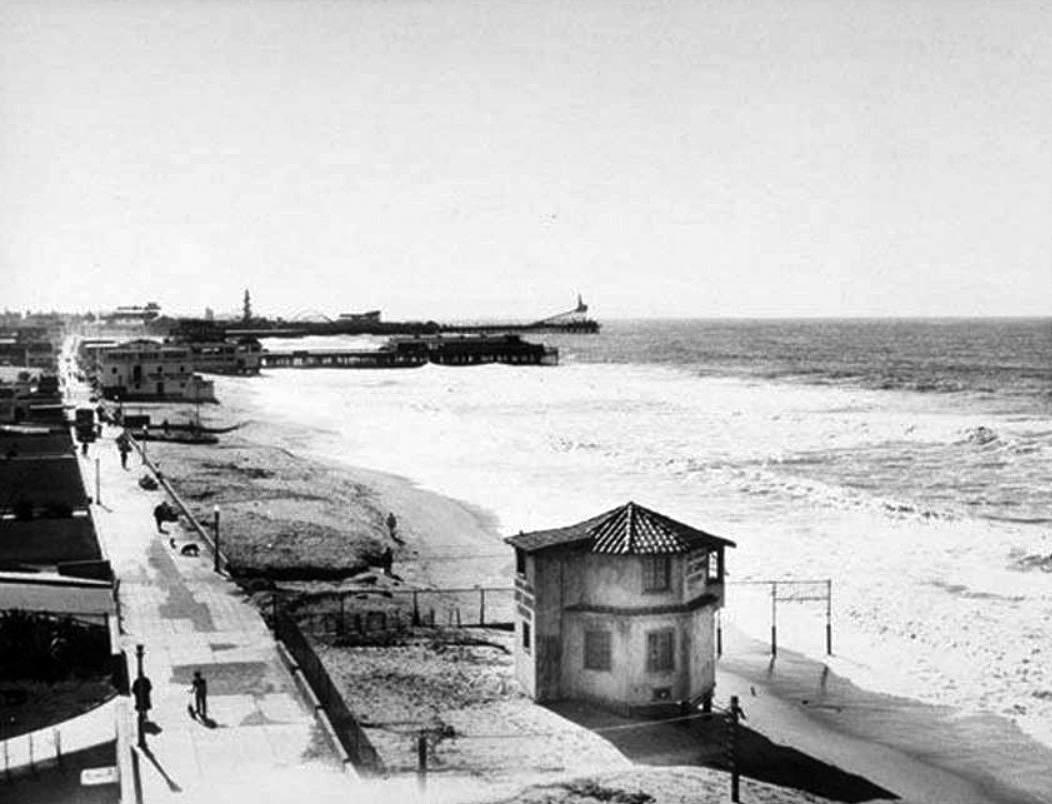 |
|
| (1938)* - View looking south toward Crystal Pier with the longer Ocean Park Pier and amusement park seen in the distance. |
Historical Notes Click HERE to see more of the Piers of Santa Monica Bay. |
* * * * * |
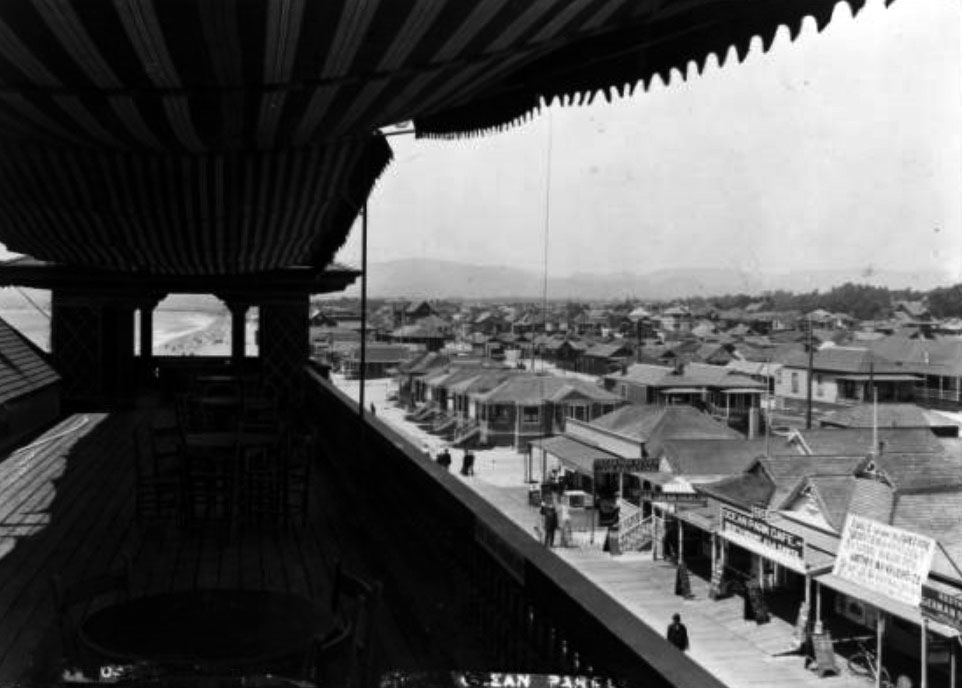 |
|
| (ca. 1915)* - View from the second story of a pavilion on the Ocean Park pier, showing shops and beach houses. A portion of roof covered by a cloth canopy is pictured in the left foreground, four sets of tables and chairs spaced regularly under the shade. Over its edge to the right, a collection of small shop fronts can be seen advertising their wares via signs, while farther in the distance at center, an expanse of housing can be seen stretching toward the mountains.; Legible signs from left to right include: "These chairs for patrons only", "Clairvoyant", "Lunch Room", "Ocean Park Review Job Printing", "Cigars and Tobacco", "Ice Cream Parlor", "99 Ocean Park Cafe. Restaurant A la Carte". |
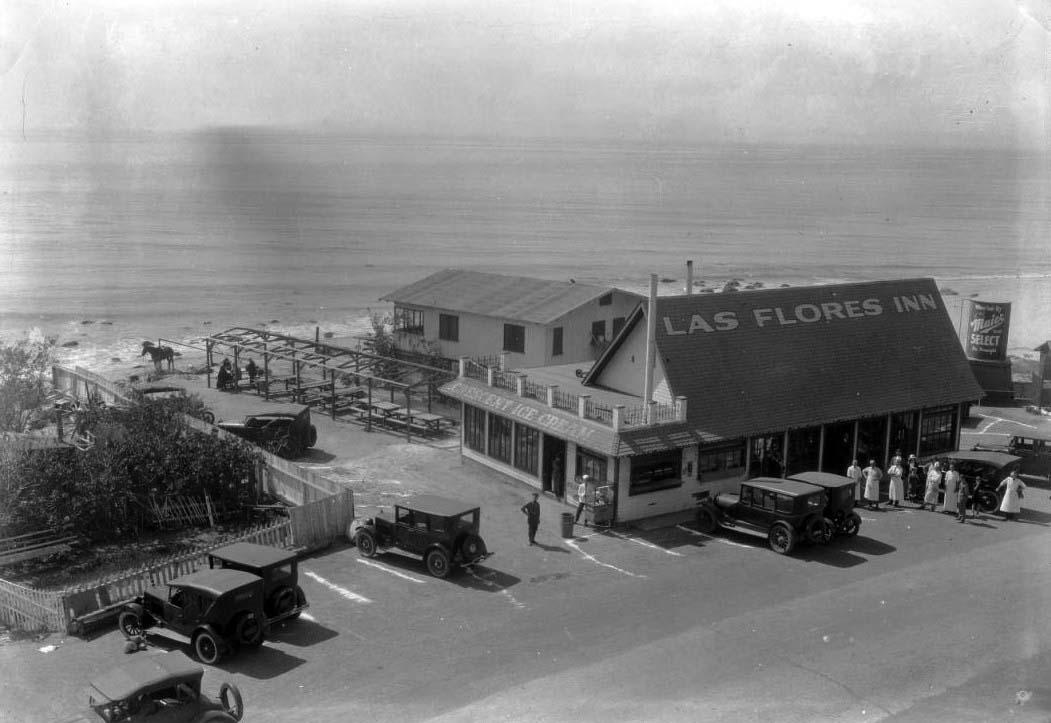 |
|
| (1915)** - Exterior view of the Las Flores Inn on the coast road near Santa Monica. The inn is at right and has a steeply peaked roof with its name painted near the top. Part of the inn extends back to the ocean behind it. A wooden structure is seen covering tables at left, and there is a fenced-in garden at left. Several cars are parked in front of the inn and the garden, and there are people standing in front of the inn. A horse is tied near the ocean at left. |
Historical Notes Las Flores Inn was located near where Duke’s Restaurant is today, by Las Flores Canyon. The coast route ended at Las Flores Canyon until the late 1920s, when the Roosevelt Highway was completed. Children used to wait here for the school bus to Santa Monica. Their parents played the slot machines at the restaurant and a big win meant soda pops for all. It is said the inn refused to pay "protection fees" and lost their slots, but the Malibu Inn up the road kept theirs.^## |
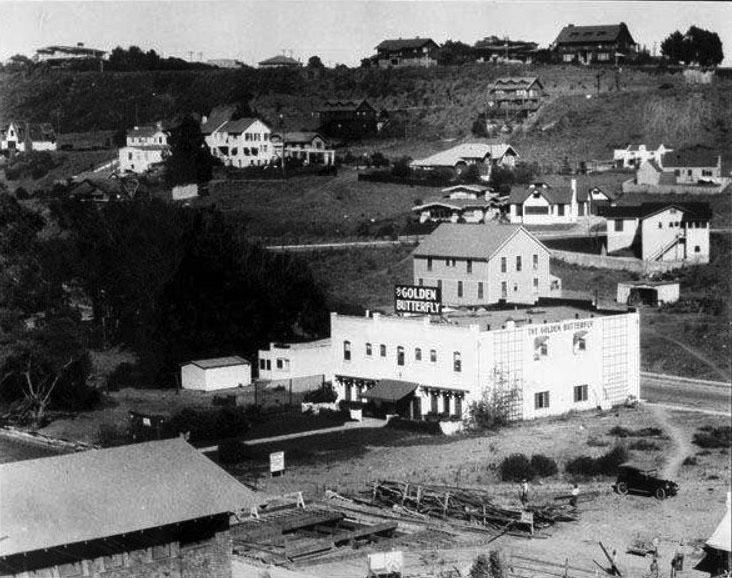 |
|
| (1916)#^ - View of the Golden Butterfly establishment in Santa Monica Canyon, below Adelaide Drive. |
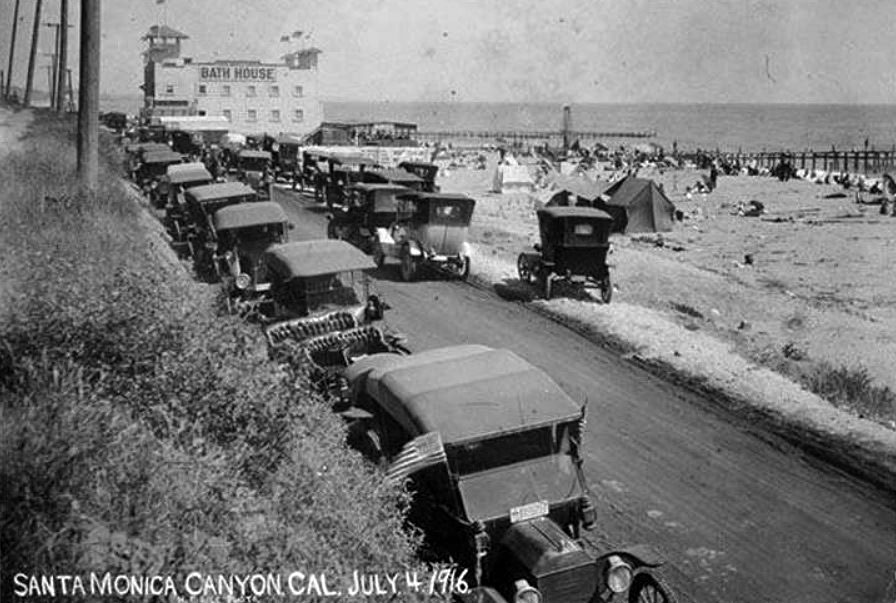 |
|
| (1916)#^ - View showing people enjoying the Fourth of July on the beach at the entrance to the Santa Monica Canyon. A large bathouse and two piers are seen in the background. |
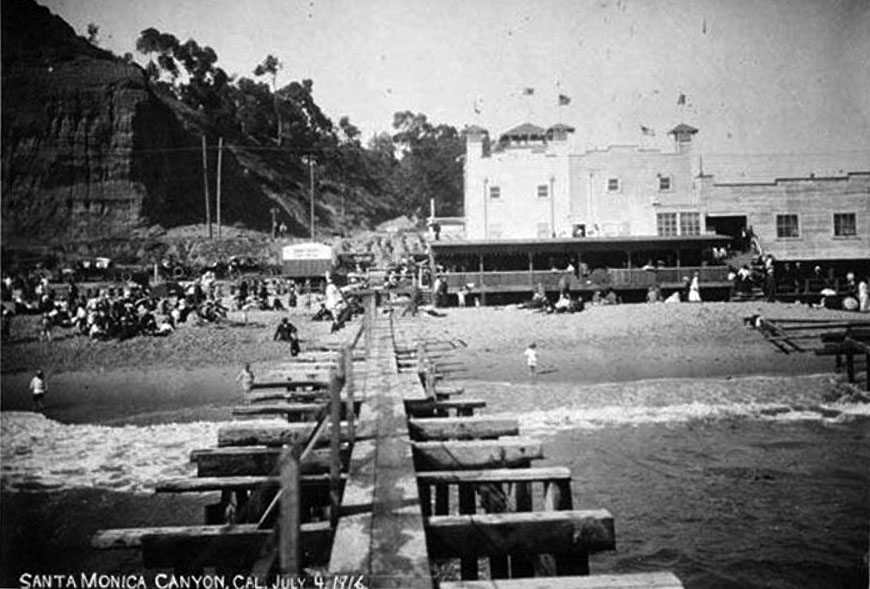 |
|
| (1916)#^ – View of the beach at the entrance to Santa Monica Canyon. The Santa Monica bathouse is seen in the background. |
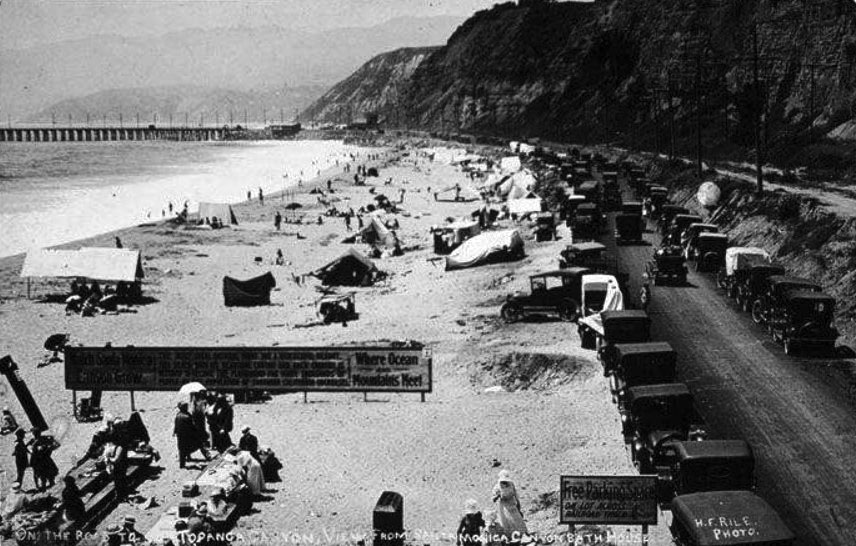 |
|
| (1916)#^ - View of the road to Topanga Canyon as seen from the Santa Monica Bath House. The Long Wharf can be seen in the distance. The beach is full of people between the bath house and the pier. The right side of the sign in the foreground reads: "Where Ocean and Mountains Meet" |
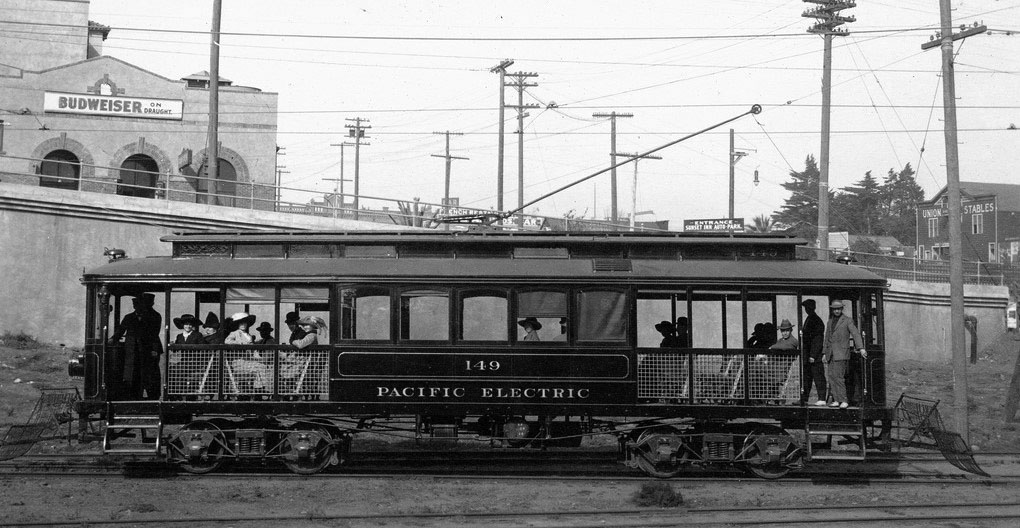 |
|
| (1916)#**- View of streetcar 149 leaving Santa Monica en route to the Long Wharf. |
Historical Notes The above streetcar was built by American Car Co. in 1902 for the San Bernardino Valley Traction Co. and later purchased by the Pacific Electric Railway Company. The car was eventually scrapped in 1926. #** The last ships arrived at the Long Wharf in 1908, however, the wharf lived on as a tourist destination, accessed by a trolley from Santa Monica. The wharf was demolished in stages, and disappeared entirely by 1920.#^^^ |
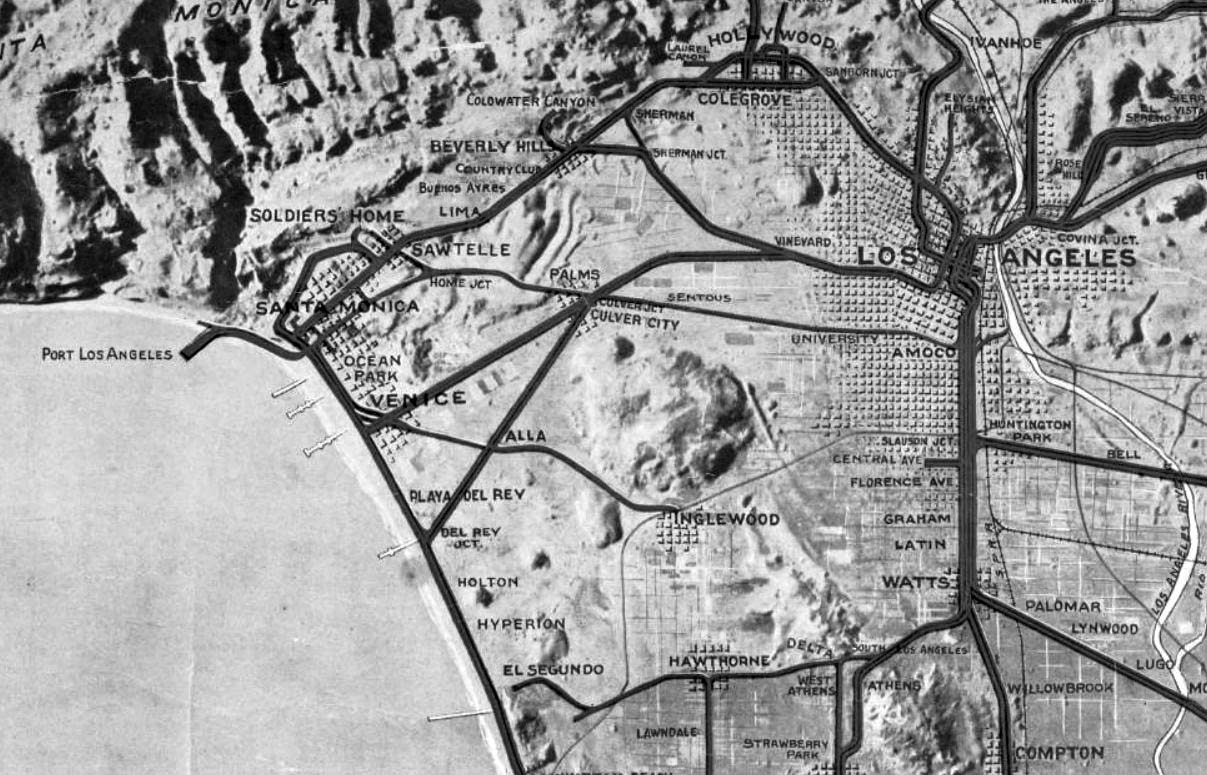 |
|
| (ca. 1920)#^# - Relief map of territory served by lines of the Pacific Electric Railway in Southern California. At the time of the photo it was the largest electric railway system in the world. Note the line heading to the Port of Los Angeles (The Long Wharf). |
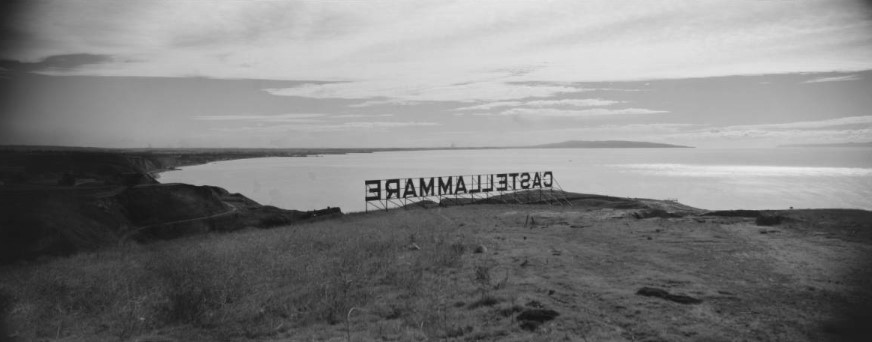 |
|
| (1926)#^^ - A panorama view of the California coastline at the Castellammare development area in Pacific Palisades in Los Angeles. The land is still undeveloped, with only a sign spelling out the development name perched on a hill. The land was under development by Frank Meline. |
Historical Notes Castellammare (Castle by the sea) is located along the Pacific Coast Highway on small bluffs much closer to sea-level, just north of where Sunset Boulevard meets the PCH. This is the home of the Getty Villa and the narrow, winding streets in this neighborhood have Italian names and ocean breezes.*^ |
Bel-Air Bay Club
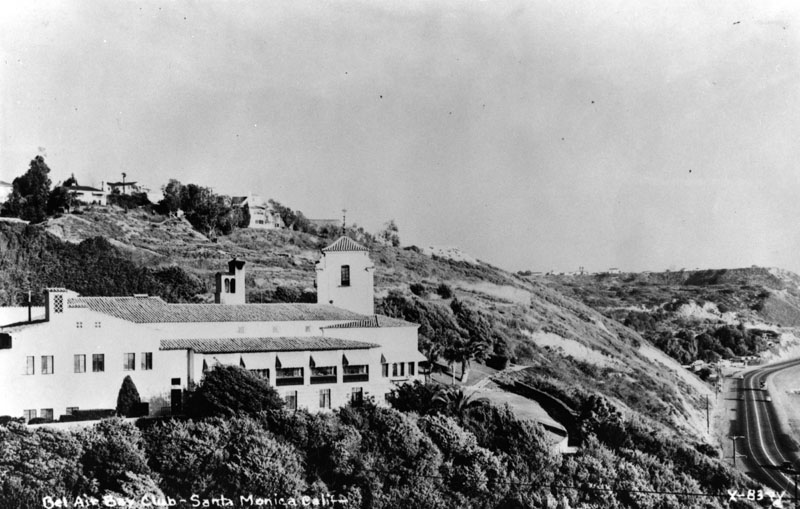 |
|
| (ca. 1927)* - The Bel-Air Bay Club in Pacific Palisades, although “Santa Monica” is present on the print. To the right can be seen a portion of the Roosevelt Highway (Pacific Coast Highway). |
Historical Notes In 1927, Alphonzo Bell built the Spanish Colonial Revival style Bel Air Bay Club located at 16801 Pacific Coast Highway, Pacific Palisades. The club is still standing today, although modified.* Alphonzo Bell was an American oil multi-millionaire, real estate developer, philanthropist, and champion tennis player. The westside Los Angeles residential community of Bel-Air is named after him. Bell was a native and lifelong resident of Los Angeles whose family had deep financial and historical ties to the area, and played a key role in the history and development of Southern California. He was the son of James George Bell, who established Bell Station Ranch (now the site of the City of Bell), in the Santa Fe Springs area in 1875, and of Susan Albiah Hollenbeck. His uncle, Ed Hollenbeck, who arrived in California in the 1850s, founded the First National Bank, created Los Angeles's public transportation trolley system, and developed eastern portions of Los Angeles County.*^ |
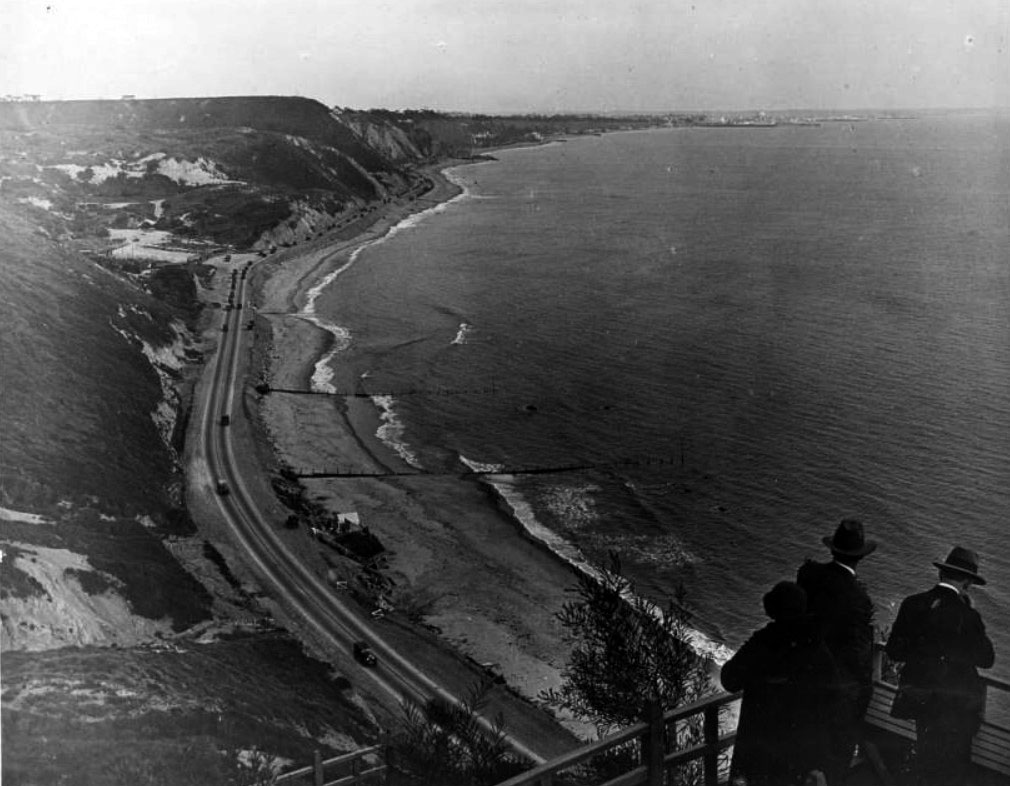 |
|
| (1927)#^^ – People overlooking the Santa Monica Bay and beach from the site of the upper clubhouse of the Bel-Air Bay Club site, with the lower clubhouse building under construction in the foreground on the beach in Pacific Palisades. Automobiles can be seen along the Beach Road (later the Roosevelt Highway and Pacific Coast Highway), and Santa Monica and the Santa Monica Pier are visible in the distance. |
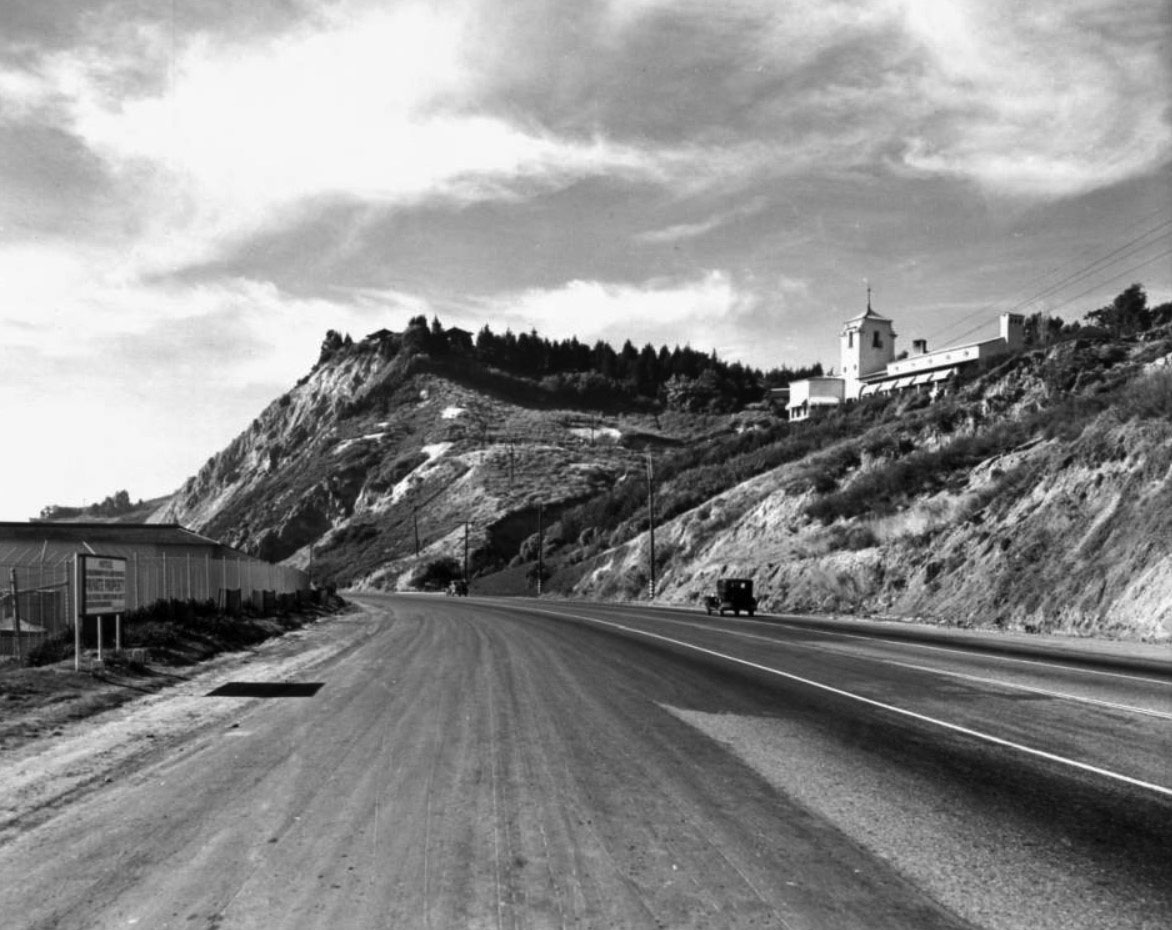 |
|
| (1930s)** – View looking north on Pacific Coast Highway showing the two facilities of the Bel-Air Bay Club. One facility is on the left along the beach and the other is the Spanish Colonial Revival-style building on the hillside at upper-right. Also seen in the distance, on top of the hill, is the famed Bernheimer Japanese Gardens. |
Historical Notes Bel-Air Bay Club consists of two facilities separated by the Pacific Coast Highway. The grounds are located on one-quarter mile of beachfront, with a total of 14 acres including picturesque bluffs overlooking the sea. |
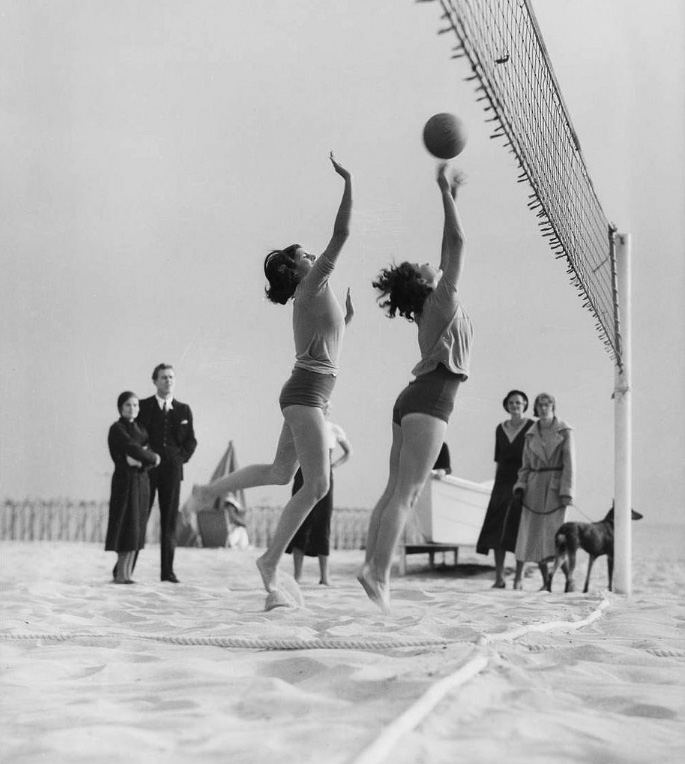 |
|
| (1931)* – View showing beach volleyball in front of the Bel-Air Bay Club. |
Historical Notes The Club was such a center of social activity during the 1920s, 1930s and 1940s that many celebrities frequented Club functions. |
* * * * * |
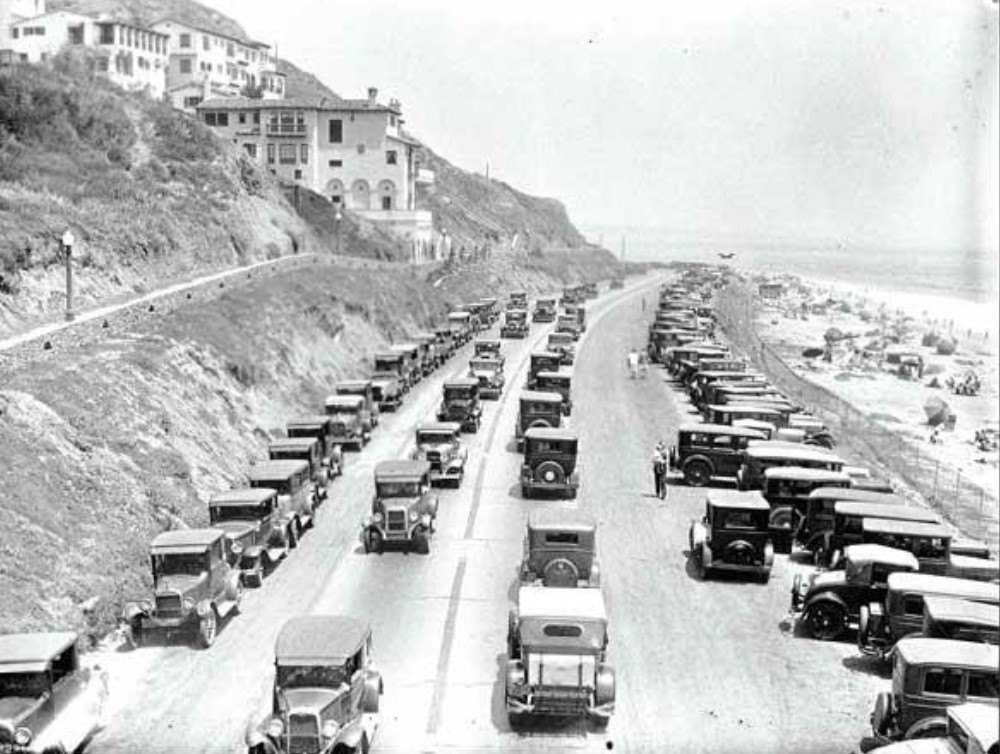 |
|
| (1920s)* – View looking south on Roosevelt Highway (later PCH) showing a busy day at the beach with parking spaces hard to come by. |
* * * * * |
Toed Inn
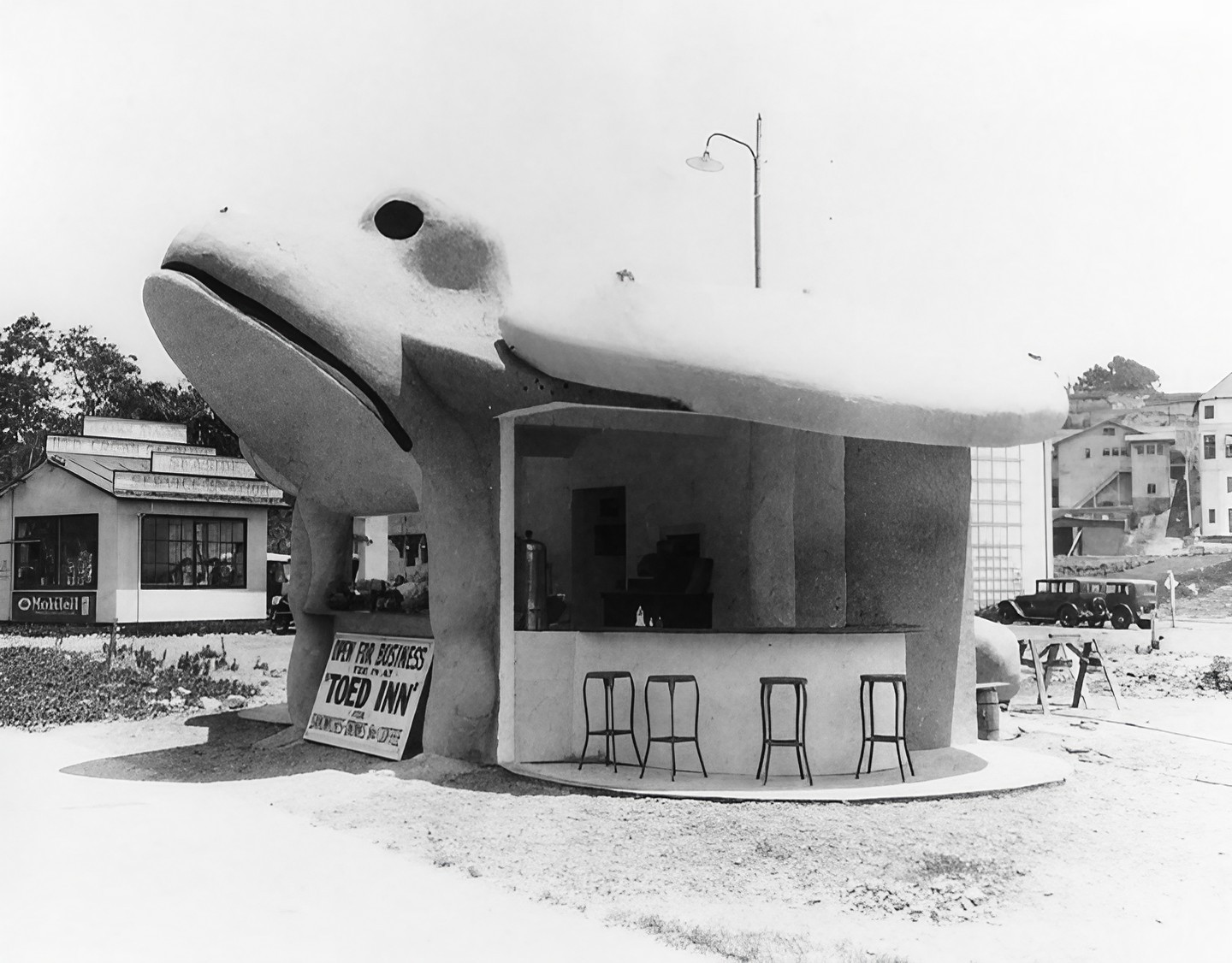 |
|
| (1929)* - The Toed Inn, was a stand in the shape of a toad, located on Channel Road in Santa Monica. Behind can be seen the Seaside Service Station. |
Historical Notes Opened in 1929 at 124 West Channel Road in Santa Monica Canyon, the original Toed Inn was a charming example of programmatic architecture—designed in the shape of a giant frog, with customers entering through its open mouth. Owned by Roger C. McGinn and designed by architect Jacob Lee Schimmer, the whimsical structure quickly became a roadside attraction for beachgoers and motorists alike. In 1931, the building was moved to a larger adjacent lot and expanded, but it met disaster in 1938 when a catastrophic flood damaged and partially buried the restaurant in mud, forcing it to close. |
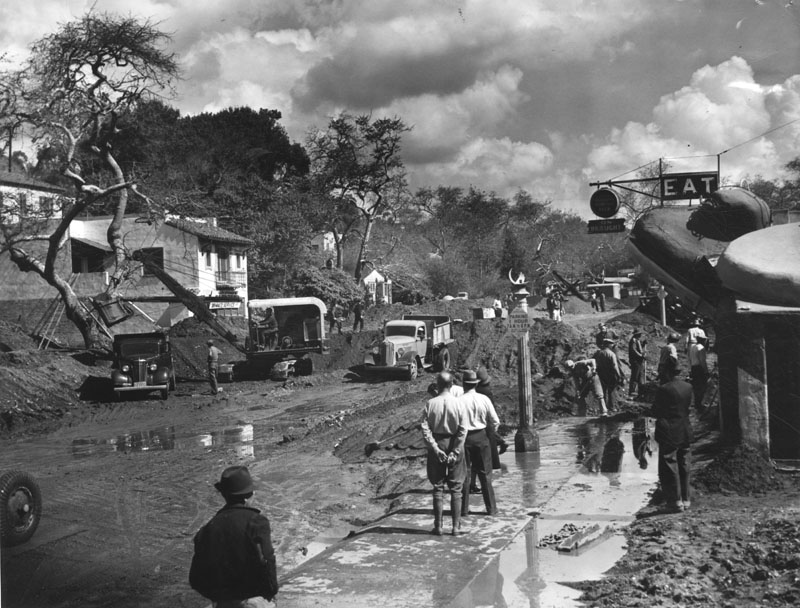 |
|
| (1938)* - Photo shows the cleanup of Channel Road in Santa Monica Canyon. Tons of mud and silt were deposited from the flood waters which raced down the canyon. The Toed Inn is on the right. |
Historical Notes In 1938, the Toed Inn structure was damaged by a flood caused by one of wettest seasons ever to hit Southern California. That same year the Toed Inn was relocated to West Los Angeles, at 12008 Wilshire Boulevard. |
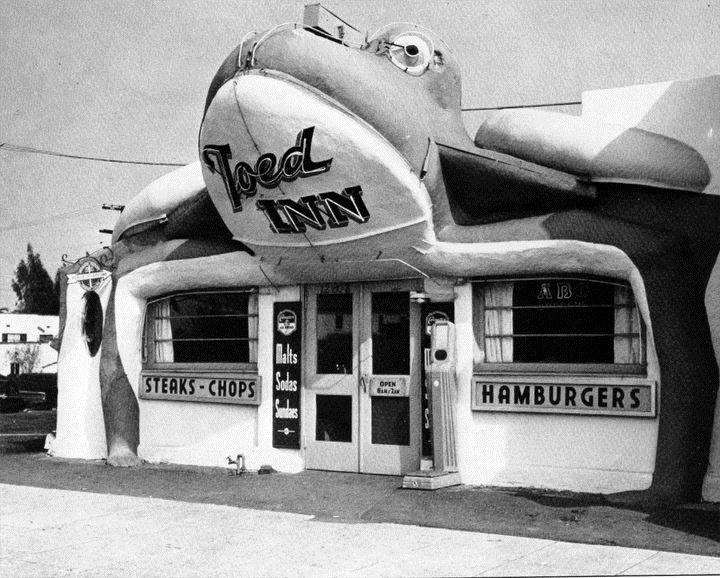 |
|
| (ca. 1939)* - The Toad Inn at it's new location at 12008 Wilshire Boulevard in West Los Angeles.. |
Historical Notes In early 1939, McGinn relocated the damaged frog structure several miles inland to 12008 Wilshire Boulevard, near Saltair Avenue in West Los Angeles. The front was rebuilt using accordion-style doors, and the restaurant reopened in a more enclosed and modernized form while still retaining its signature amphibian charm. The move positioned the Toed Inn along a major urban corridor, where it continued to draw attention with its fanciful design and playful theme. It was eventually sold to Benjamin Rosenfeld, who made further enhancements including neon signage and a new front façade. |
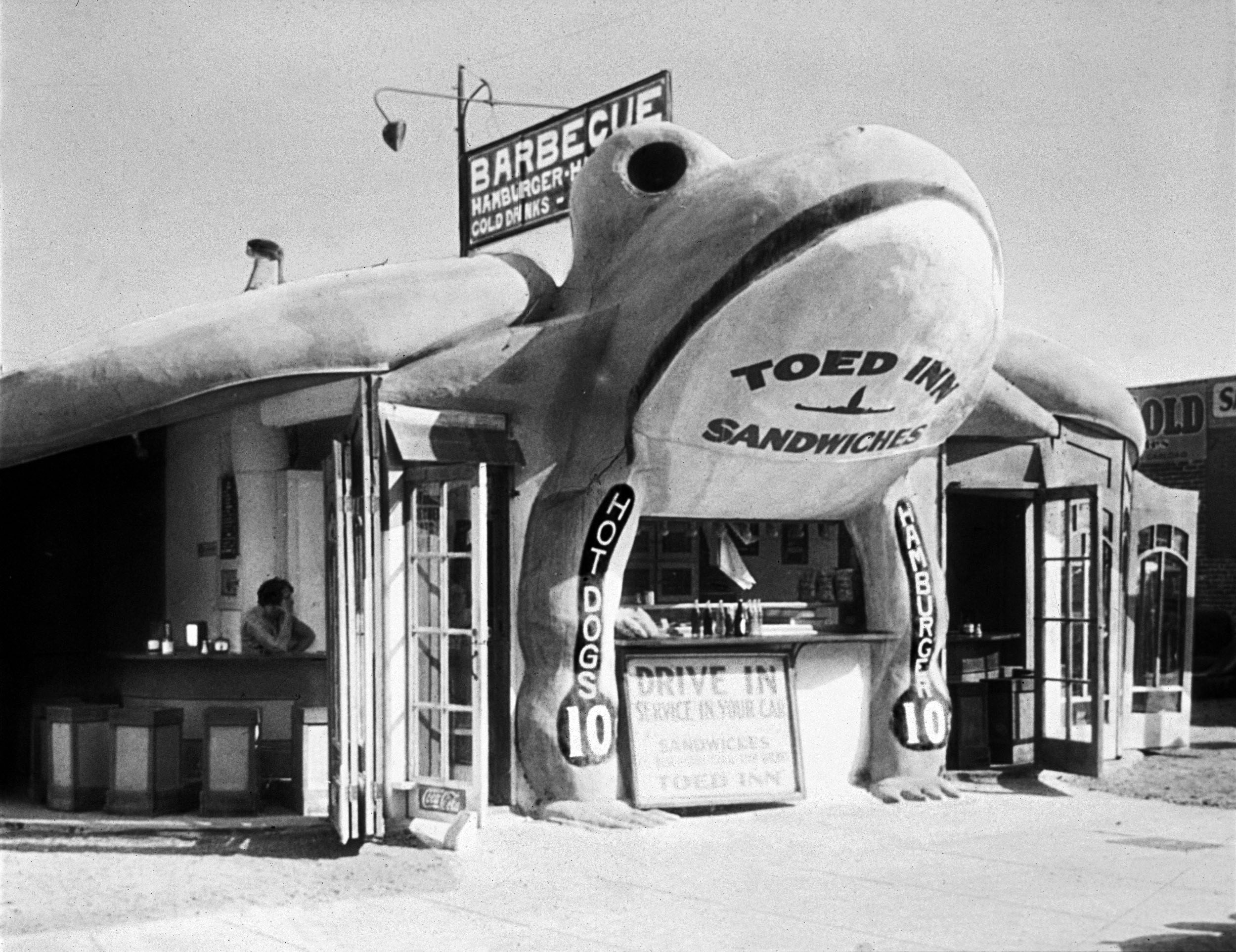 |
|
| (1940)* - Toed Inn located at 12008 Wilshire Boulevard after it became a drive-in restaurant. Click HERE to see more Early LA Drive-in restaurants. Photo from the Jim Heimann Collection. |
Historical Notes During the 1940s, the Toed Inn thrived as a drive-in restaurant, fitting perfectly into the car-centric culture of postwar Los Angeles. Known for hearty meals—steaks, barbecue, fried chicken, and even frog legs—it became a local favorite and was featured in publications like the Saturday Evening Post. However, by the early 1950s, novelty architecture began to fall out of favor, and the restaurant closed in 1953. The building was replaced with a more conventional establishment called Ben’s, but the giant frog lives on in L.A. lore as one of the city’s most endearing roadside oddities. Click HERE to see more examples of Programmatic Architecture. |
* * * * * |
Flooding (1938 Storm)
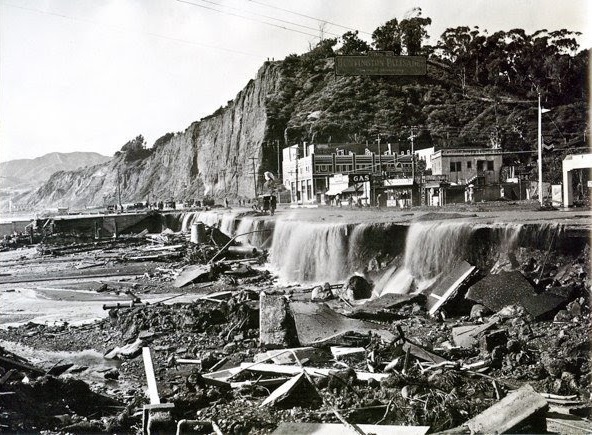 |
|
| (1938)^ - View showing the Santa Monica Canyon flood of 1938. The sign on top of the hill reads: HUNTINGTON PALISADES. |
Historical Notes Between February 27 and 28, 1938, a storm from the Pacific Ocean moved inland into the Los Angeles Basin, running eastward into the San Gabriel Mountains. The area received almost constant rain totaling 4.4 in from February 27-March 1. This caused minor flooding that affected only a few buildings in isolated canyons and some low-lying areas along rivers. Fifteen hours later on March 1, at approximately 8:45 PM, a second storm hit the area, creating gale-force winds along the coast and pouring down even more rain. The storm brought rainfall totals to 10 inches in the lowlands and upwards of 32 inches in the mountains. When the storm ended on March 3, the resulting damage was horrific. |
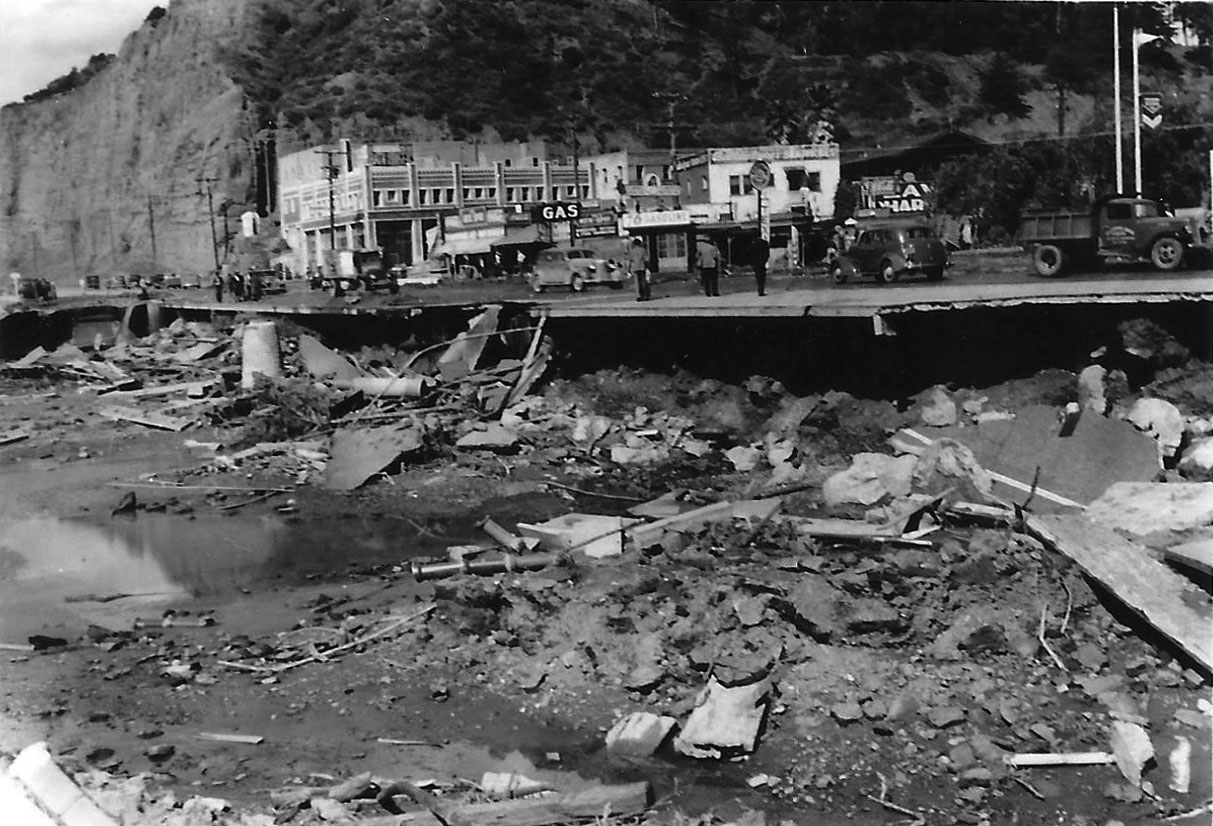 |
|
| (1938) – Aftermath of the Santa Monica Canyon flood. Photo courtesy of Sarah Marinelli |
.jpg) |
|
| (1938) – Santa Monica Canyon flood aftermath. Photo courtesy of Sarah Marinelli |
.jpg) |
|
| (1938) – Channel Road in Santa Monica Canyon after the great flood. Photo courtesy of Sarah Marinelli |
 |
|
| (1938)* - Photo shows the cleanup of Channel Road in Santa Monica Canyon. Tons of mud and silt were deposited from the flood waters which raced down the canyon. The Toed Inn is seen on the right. |
Historical Notes After the 1938 Santa Monica Canyon flood, the Toed Inn was relocated to Westwood, at 12008 Wilshire Boulevard. |
* * * * * |
Pacific Palisades
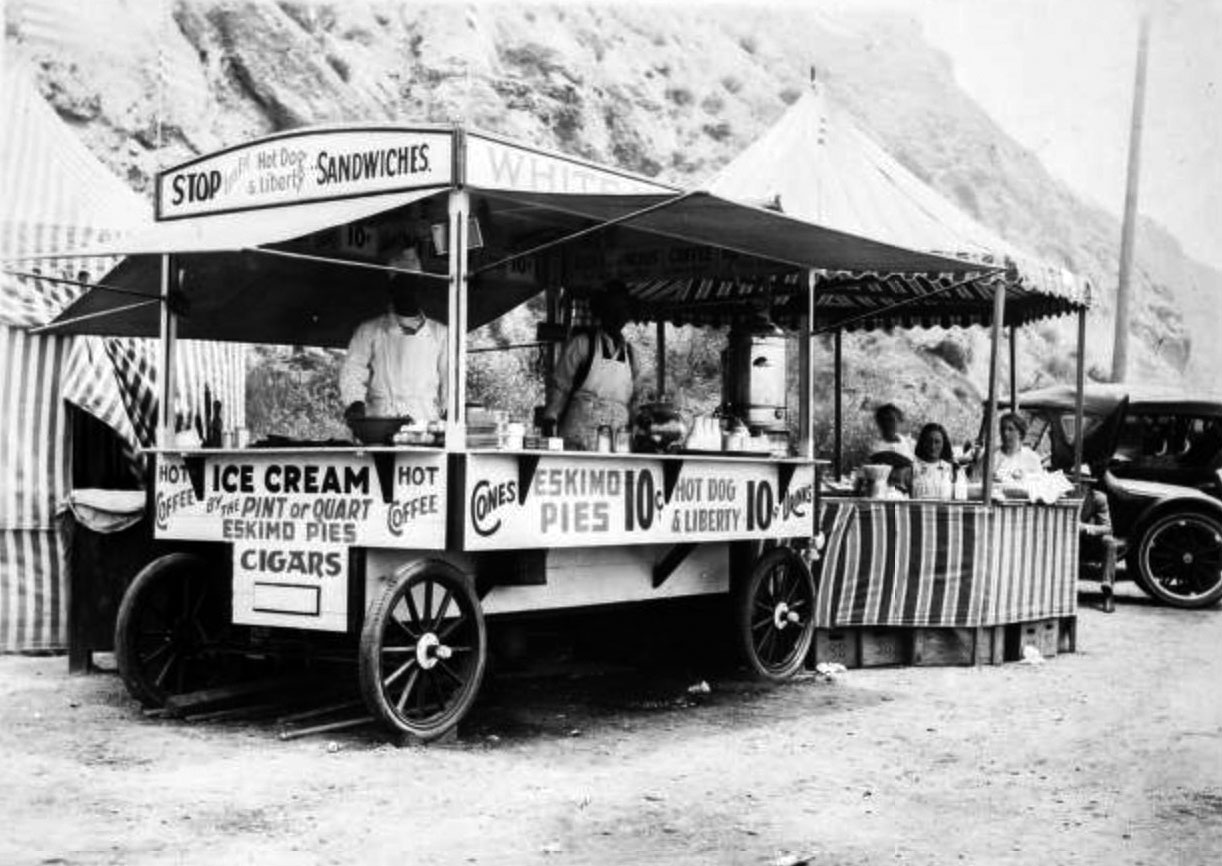 |
|
| (ca. 1918)* - Image of a food stand on the beach, with vendors behind counter in Pacific Palisades. The cart may say "White House" above the awning (the sign is partially obscured). The cart has signs including "Stop, Let's Eat Hot Dog & Liberty Sandwiches" and "Hot coffee, Ice Cream by the pint or quart, Eskimo Pies, Cigars, Cones... Drinks." |
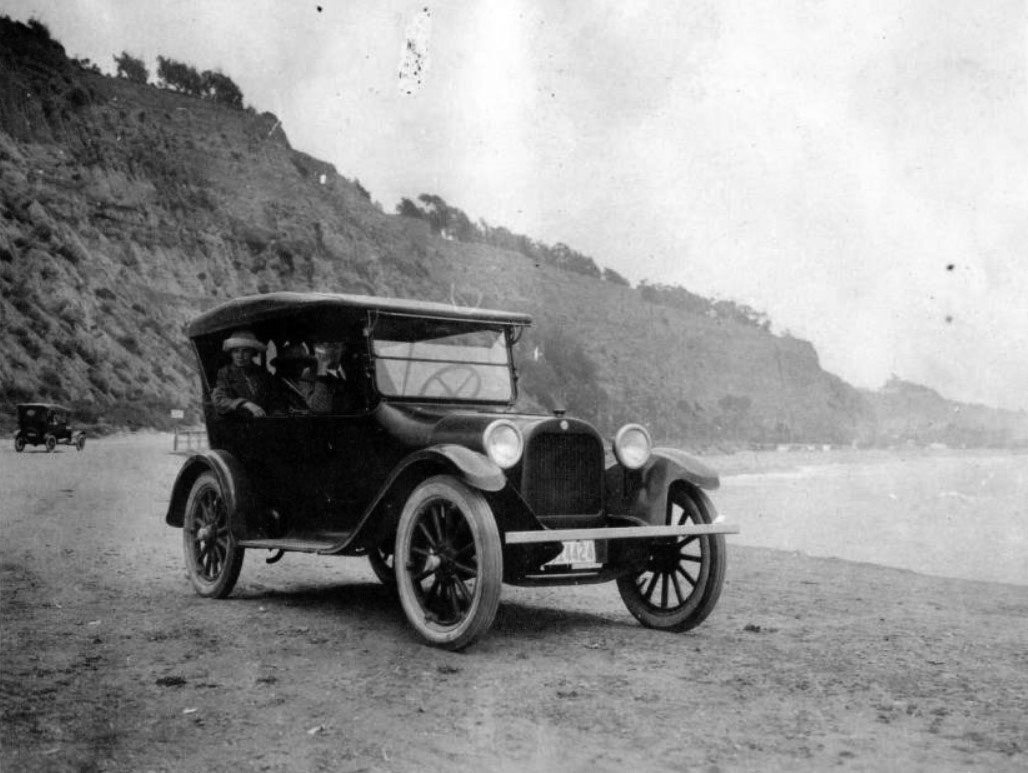 |
|
| (1922)* - A 1918 Dodge Brothers touring car on the beach just south of the Long Wharf location in Pacific Palisades. |
* * * * * |
Santa Monica Palisades
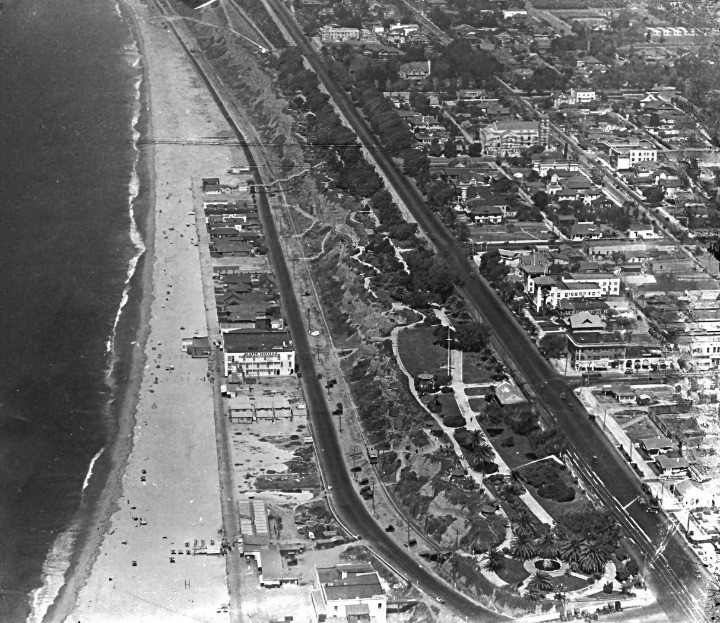 |
|
| (1922)*– Aerial view looking north from above the Santa Monica Pier, showing the Pacific coastline with beach houses lining the shore, the Roosevelt Highway (now Pacific Coast Highway), and the terraced bluffs of Palisades Park. Ocean Avenue runs parallel to the bluffs, bordered by early residential neighborhoods and palm-lined streets. Several civic and institutional buildings can be seen near Arizona Avenue. This image captures Santa Monica’s coastal development during the early automobile era. |
Historical Notes Roosevelt Highway, visible hugging the coastline, was part of a larger coastal route proposed in the 1910s and officially named in 1921 to honor President Theodore Roosevelt. It was later incorporated into Pacific Coast Highway (PCH) in the 1930s.
|
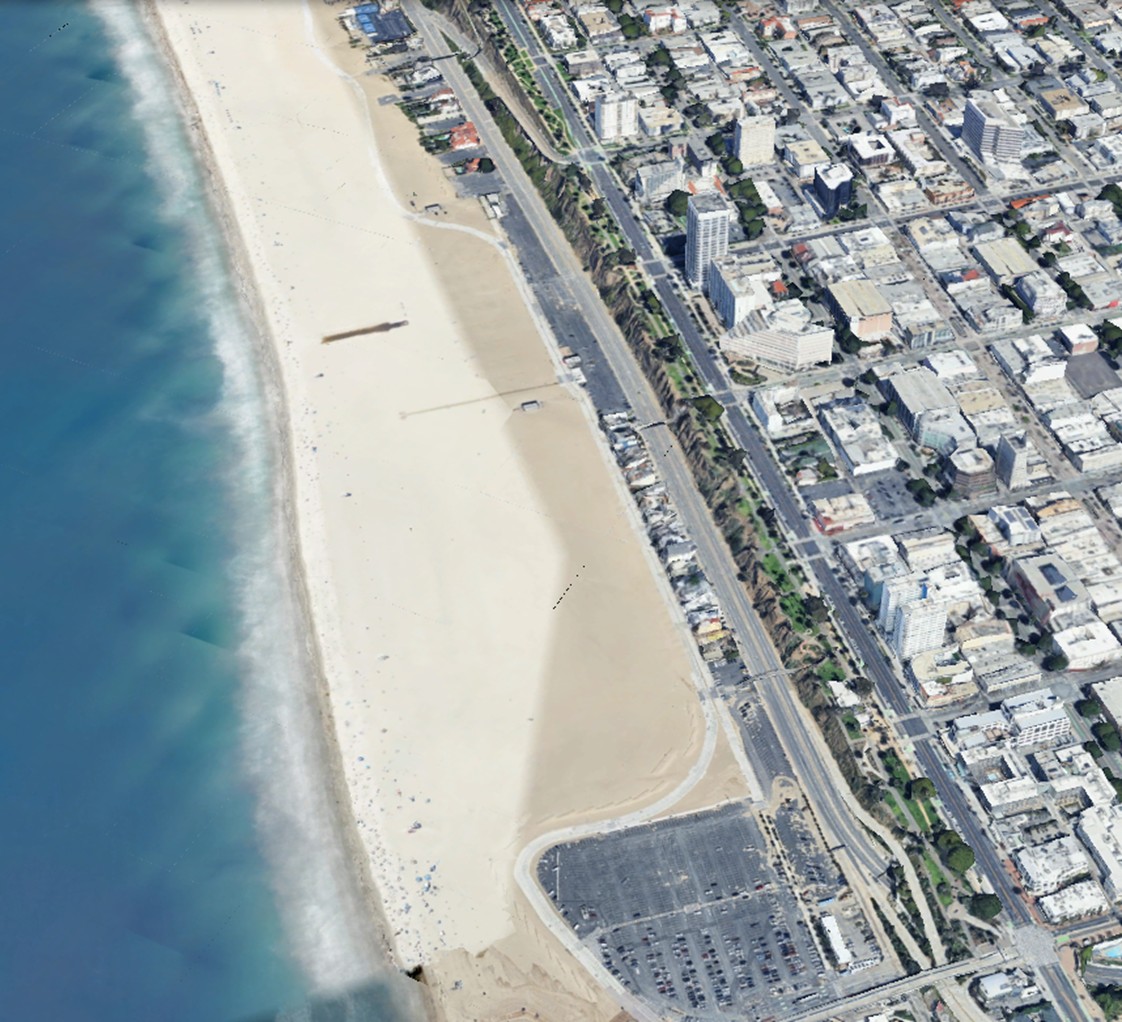 |
|
| (2022)* - Contemporary View – A Century of Change Along Santa Monica’s Coastline |
Historical Notes This modern Google Earth view, looking north from above the Santa Monica Pier area, reveals the dramatic transformation of the coastal landscape since 1922. The once dense row of beach houses seen in the earlier aerial has been replaced by wide, open sand and uninterrupted public beach access. Roosevelt Highway is now Pacific Coast Highway (PCH)—modernized and expanded to accommodate heavy traffic. Ocean Avenue still runs parallel to the bluffs, though it is now lined with mid- and high-rise buildings, reflecting Santa Monica’s evolution into a vibrant urban center. The terraced bluffs and pathways of Palisades Park remain a constant, offering a preserved stretch of green between city and sea. Note on the Widened Beach: |
.jpg) |
|
| (1922)* - Aerial view of the Palisades and various residential homes in Santa Monica. Ocean Avenue and Palisades Park runs parallel to the cliffs. Roosevelt Highway and Santa Monica beach can be seen below the cliffs. |
Historical Notes The nationwide prosperity of the 1920s was felt in Santa Monica. The population increased from 15,000 to 32,000 at the end of the decade. Downtown saw a construction boom with many important buildings going up such as Henshey's Department Store (destroyed) and the Criterion Theater. Elegant resorts were opened, including the 1925 Miramar Hotel and the 1926 Club Casa del Mar. The Los Angeles firm of Walker & Eisen designed the art deco Bay City Building, a 13-story skyscraper topped with a huge four-faced clock that was finished in 1930. |
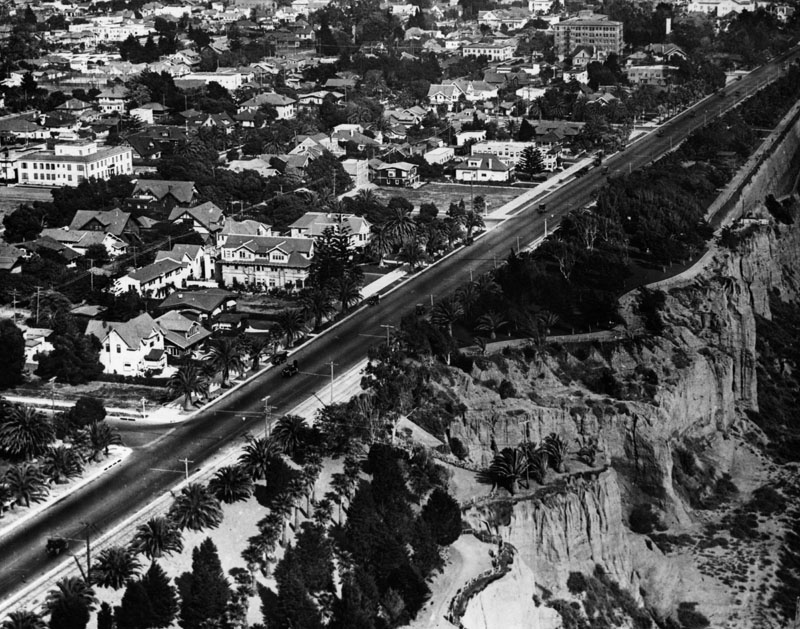 |
|
| (1922)* - Closer view of the Palisades in Santa Monica. Ocean Avenue runs parallel to Palisades Park (right). Palm trees can be seen in the lower part of the park and throughout the city. |
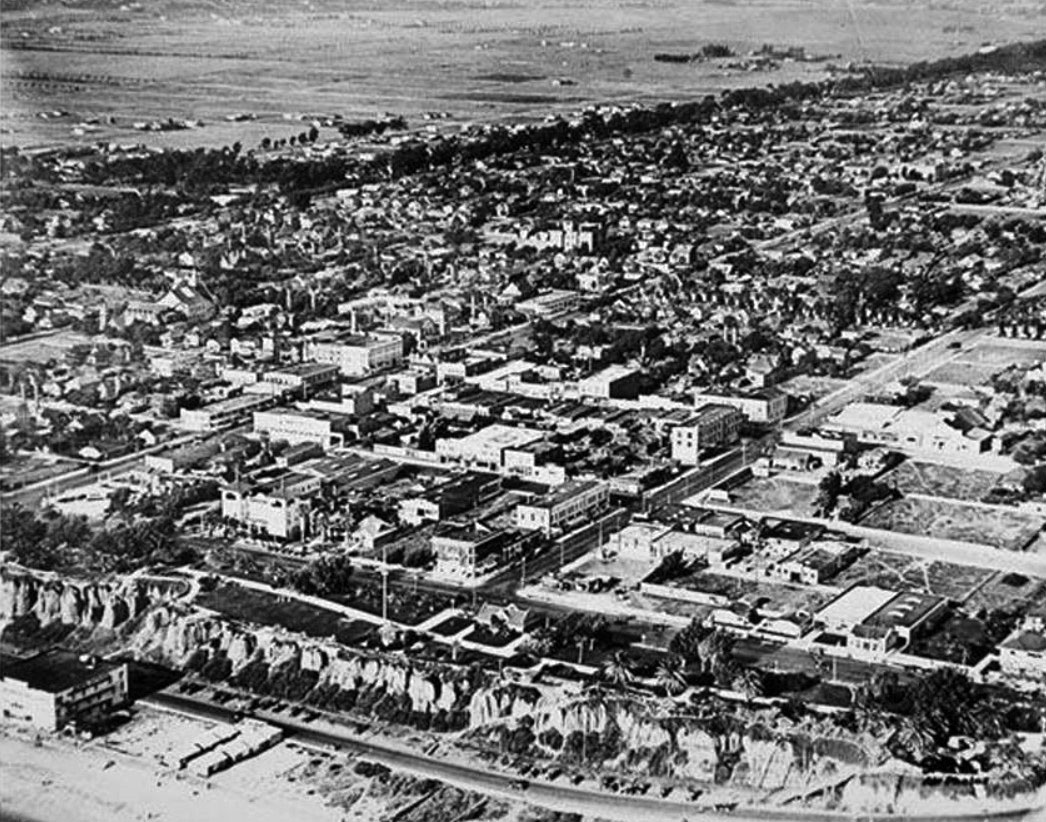 |
|
| (1919)* - Aerial view of Santa Monica, north of Wilshire showing the wooded diagonal virtually undeveloped. |
* * * * * |
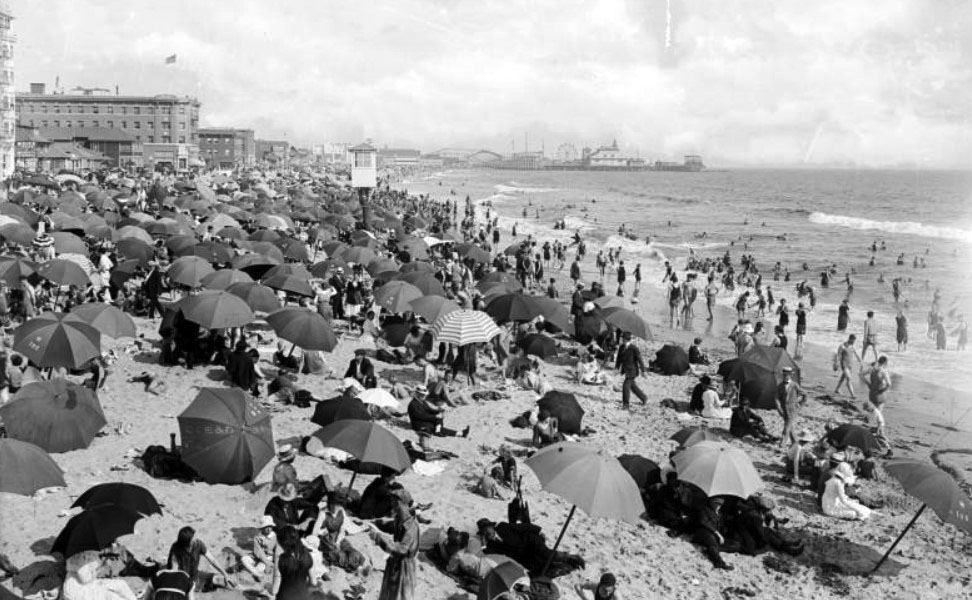 |
|
| (ca. 1920)* - View of Ocean Park Beach in Santa Monica crowded with bathers. The beach and most of the people sitting on it have umbrellas, creating a sea of various patterns and colors. The ocean at right is also full of people wading in the waves. The pier is visible in the background at center. There are several rides visible on the pier, including a Ferris Wheel and a roller coaster. |
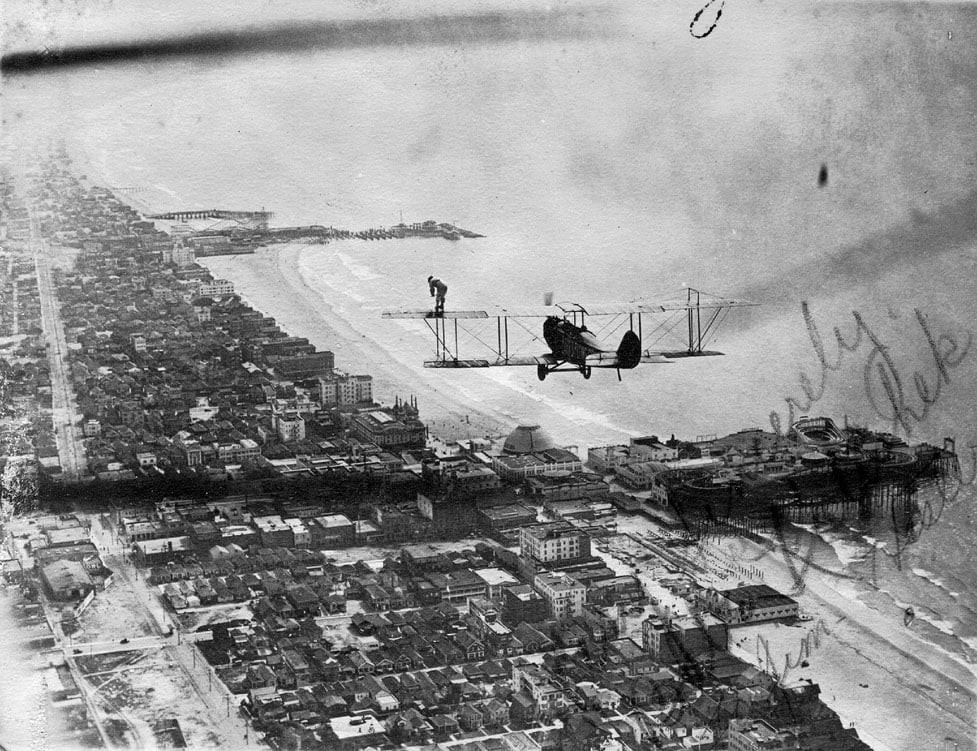 |
|
| (1918)* - Walking over Santa Monica. Aerial view of a bi-plane flying over Santa Monica. A woman is standing on the wing looking down. Ocean Park Pier with its amusement park appears just below the plane and Venice Pier is seen in the distance. |
Historical Notes The above photo was taken August 14th, 1918. The wing walker was the fabulous and seriously talented Babe Kalishek. The Curtiss JN is piloted by the early ace aviator Jim Hester. |
 |
|
| (1920)* - Aerial view of Ocean Park Pier showing it's large roller coster. The long pier to the north (top of photo) is the Santa Monica Pier. It too had its own amusement park starting in 1916. |
Historical Notes Pleasure piers were a big draw for Santa Monica in the 1920s. They featured carnival-like games and roller coasters. The Santa Monica Pier opened on September 9, 1909, however, it didn't officially become an amusement park until 1916. |
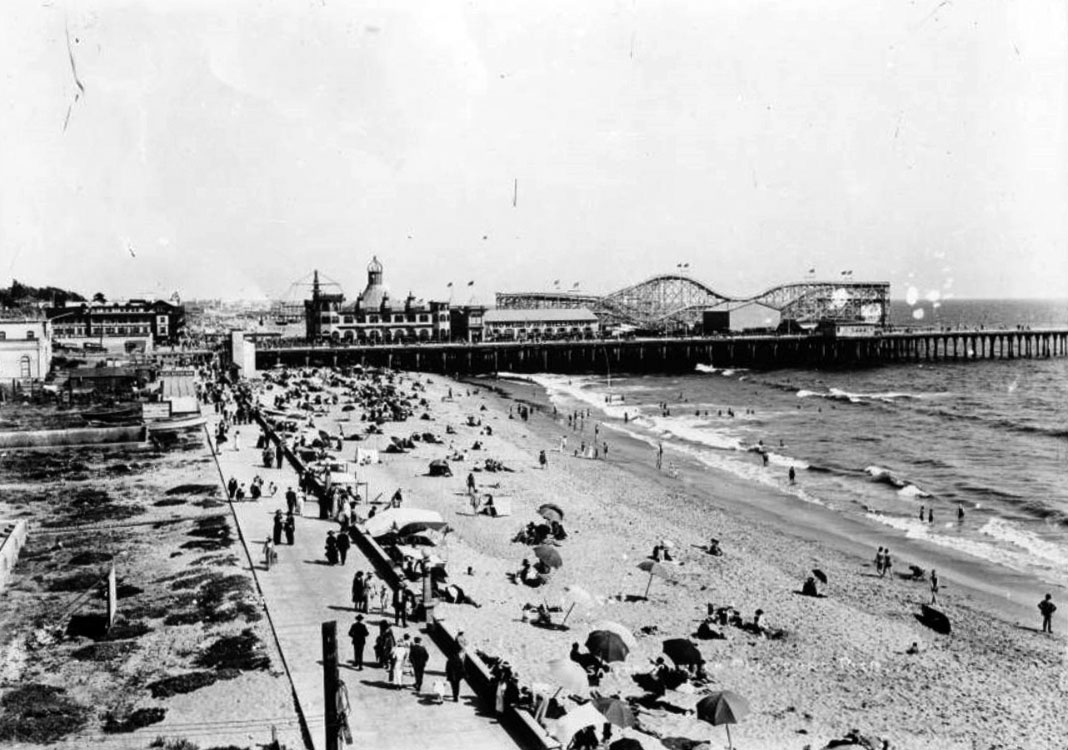 |
|
| (ca. 1920)* - View of Santa Monica beach looking south toward the pier. The beach is crowded with people resting under umbrellas or playing in the waves. There is a wide sidewalk bordering the beach at left. The left side of the walkway is lined with empty lots in the foreground and buildings in the distance. The pier is in the background at right center and several structures are built on it, including a billiards and bowling hall and a large wooden rollercoaster. Another pier is visible further down the beach at center. |
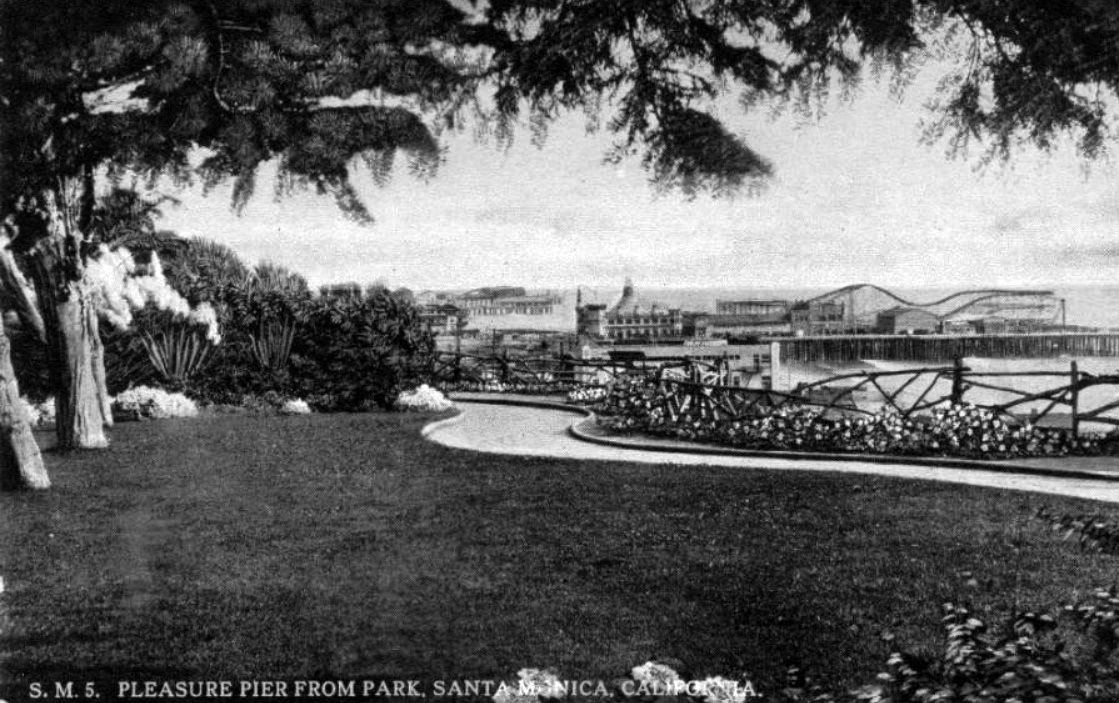 |
|
| (1922)* – Postcard view showing the Santa Monica Pleasure Pier from Palisades Park. Part of Ocean Park Pier can also be seen in the background. |
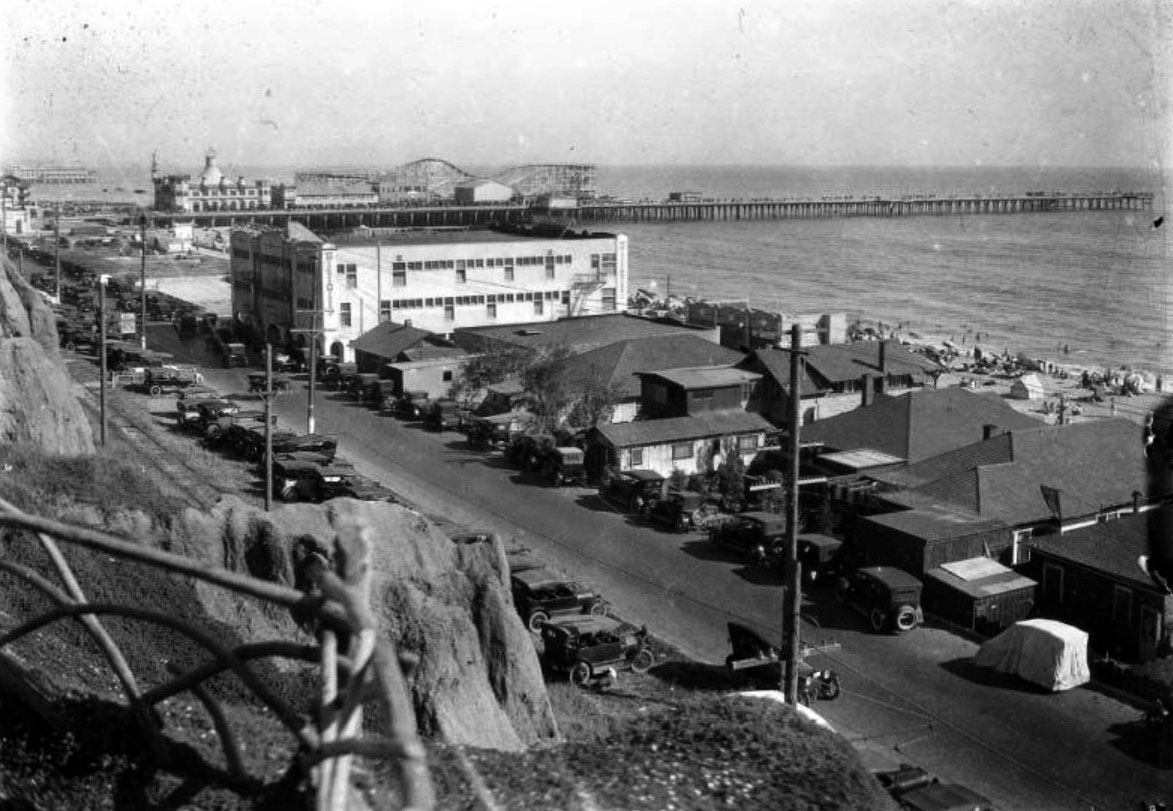 |
|
| (ca. 1922)* - View of Ocean Park beach and the Santa Monica Pier looking south from Palisades Park. The Pacific Coast Highway runs from the foreground at right into the distance at left and is lined with early-model automobiles. The right side of the road also has several beach houses and a large, two-story bath house. The beach is visible beyond the buildings at right and is full of bathers and other beach-goers. The pier is in the background and stretches across the entire image. At left are several amusement park structures, including a roller coaster and a bowling and billiards hall. |
* * * * * |
Santa Monica Pier (Loof Pleasure Pier and Santa Monica Municipal Pier Combined)
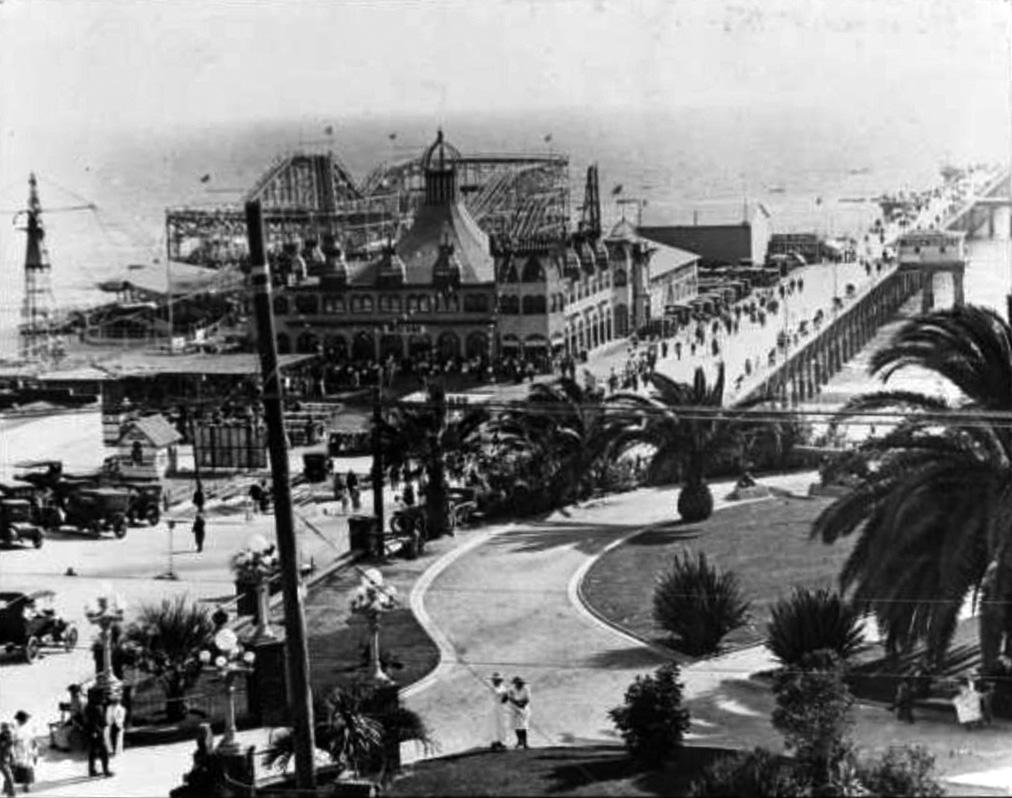 |
|
| (1917)#^^ - View showing the Santa Monica Municipal Pier at right and the Looff Pleasure Pier at left including the Looff Hippodrome (with "Welcome" sign) and Blue Streak roller coaster. Both piers combined were also known as Santa Monica Pier. Automobiles are seen parked on along the pier as well as signs for "Fish market bait and tackle" and "Pure California orange juice." Palm trees and cannon and cannon balls can be seen in the foreground in Palisades Park. |
Historical Notes From the time the Municipal Pier was conceived, the community wished to add an amusement park to compete with the neighboring Ocean Park and Venice Piers. In 1916 Charles Looff, a famous carousel carver turned amusement entrepreneur, answered that wish by building a new, wider pier with an amusement park along the south side of Municipal Pier. Both piers combined were often referred to as Santa Monica Pier. Looff's opening day, July 4, 1917, drew over 100,000 people; the biggest crowd in the city's history.* |
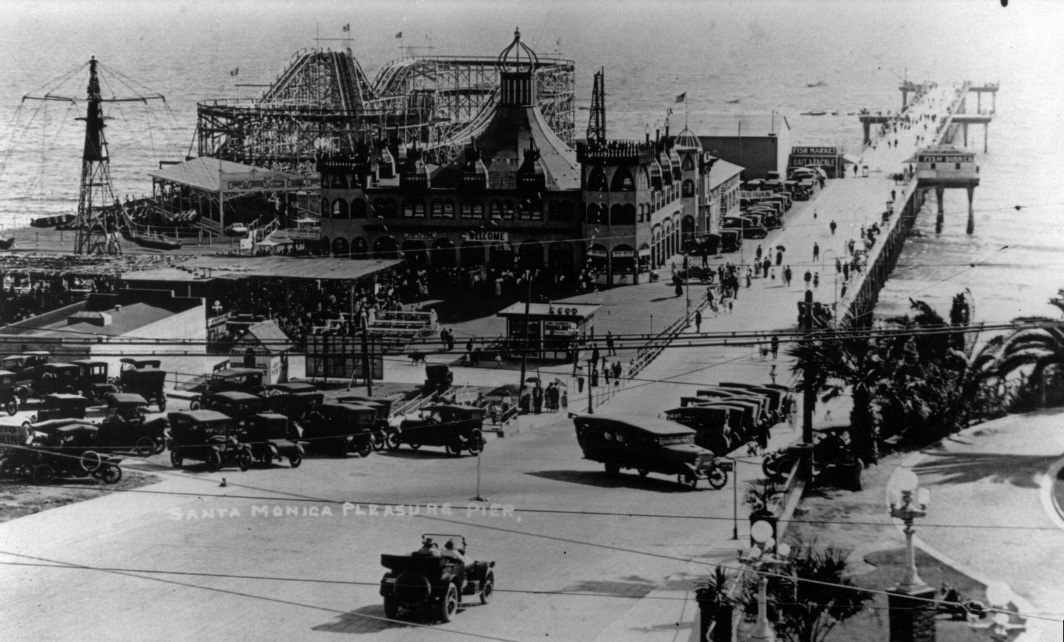 |
|
| (ca. 1922)* - View showing the Santa Monica Pier with parking lot in the foreground. The largest two structures are the wooden roller coaster and the Looff Hippodrome. |
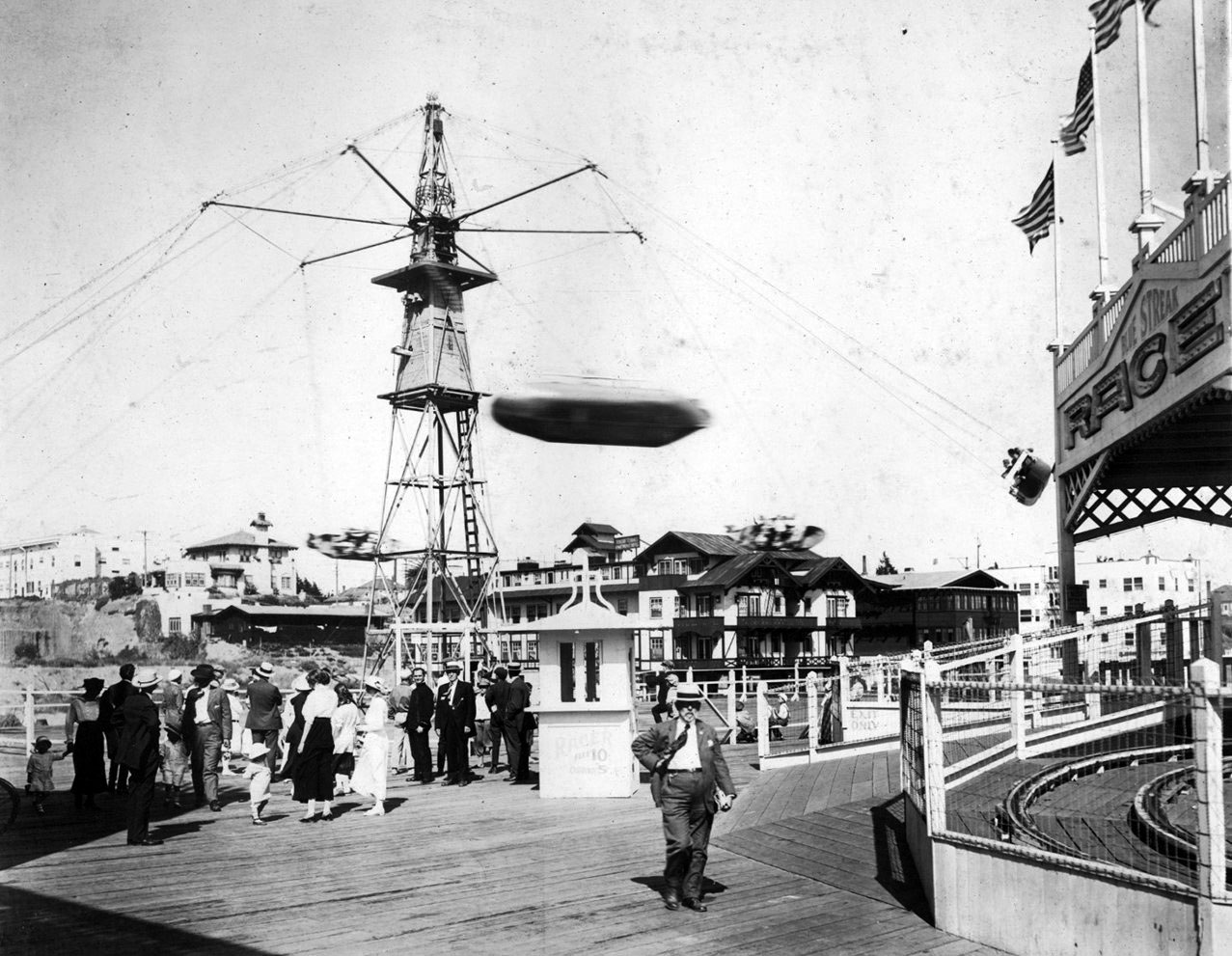 |
|
| (1920s)* - The Aeroscope ride on the Looff Pier in Santa Monica, to the right is the entrance to the Blue Streak Racing Coaster |
Historical Notes The Aeroscope had six boats, each boat holding six passengers. When the ride reached thirty-five miles per hour, the centrifugal force prevented its passengers from falling out. Sixty feet high and decorated with colored lights hanging from its crown and down its cables, the Aeroscope was visible at night from miles around.* |
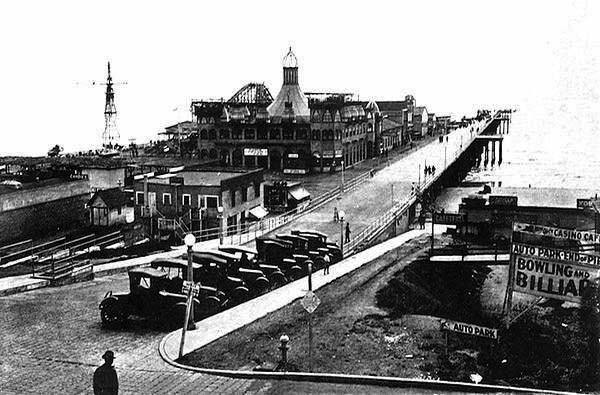 |
|
| (ca. 1922)^*## - View showing a man crossing the street heading toward Santa Monica Pier. Sign on right reads: CASINO CAFE - AUTO PARK - BOWLING AND BILLIARDS. |
Historical Notes Santa Monica has had several piers over the years; however, the current Santa Monica Pier is actually two adjoining piers that long had separate owners. The long, narrow Municipal Pier opened September 9, 1909, primarily to carry sewer pipes beyond the breakers, and had no amenities. The short, wide adjoining Pleasure Pier to the south, a.k.a. Newcomb Pier, was built in 1916 by Charles I. D. Looff and his son Arthur, amusement park pioneers. Attractions on the Pleasure Pier eventually included the Santa Monica Looff Hippodrome building (which now houses the current carousel and is listed on the National Register of Historic Places), the Blue Streak Racer wooden roller coaster (which was purchased from the defunct Wonderland amusement park in San Diego), the Whip, merry-go-rounds, Wurlitzer organs, and a funhouse.*^ |
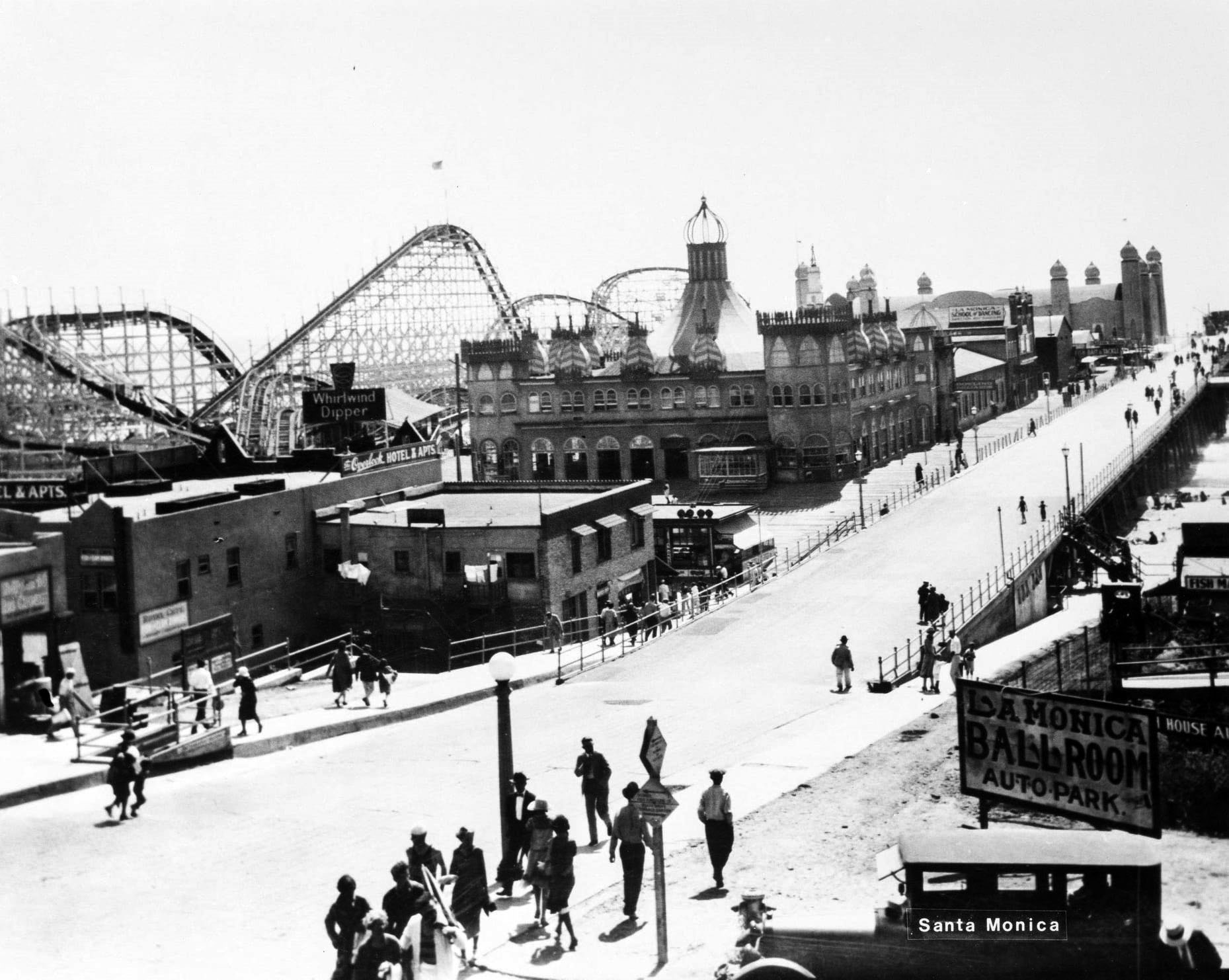 |
|
| (1924)* – Image of people walking along the Santa Monica Municipal Pier at right and the Santa Monica Amusement Pier at left. Visible on the pier are the Whirlwind Dipper roller coaster, Looff Hippodrome, and the La Monica Ballroom. With visible signs including "Whirlwind Dipper," "The Overlook Hotel & Apts., "La Monica Ballroom Auto Park," and "La Monica School of Dancing." Photo Ernest Marquez |
Historical Notes The above photo was taken shortly after the La Monica Ballroom was built at the end of the pier. Click HERE to see more. |
Santa Monica Looff Hippodrome
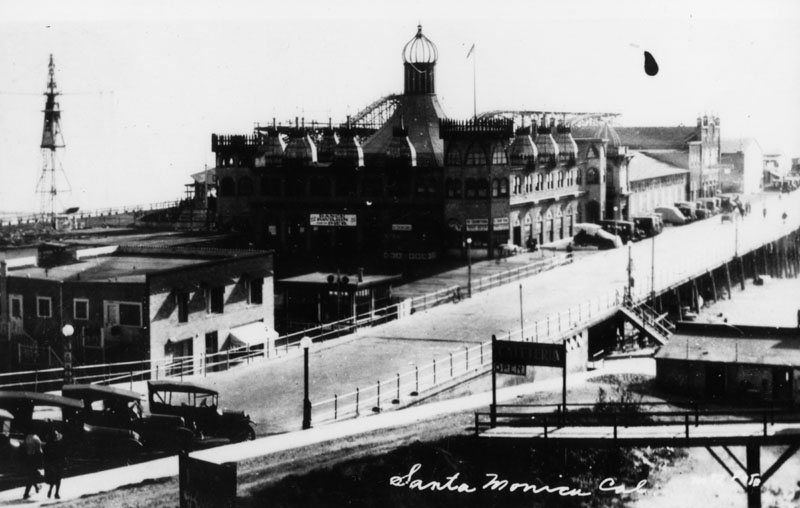 |
|
| (ca. 1924)* - Closer view of the combined Municipal Pier and Loof Pleasure Pier showing the impressive Looff Hippodrome at center. |
Historical Notes TIn 1916, Charles I.D. Looff constructed a Moorish-Byzantine hippodrome on the Santa Monica Pier. It housed a merry-go-round with 44 hand-crafted horses.* In ancient Greece, the hippodrome was is an open-air stadium with an oval course for horse and chariot races or an arena for equestrian shows. |
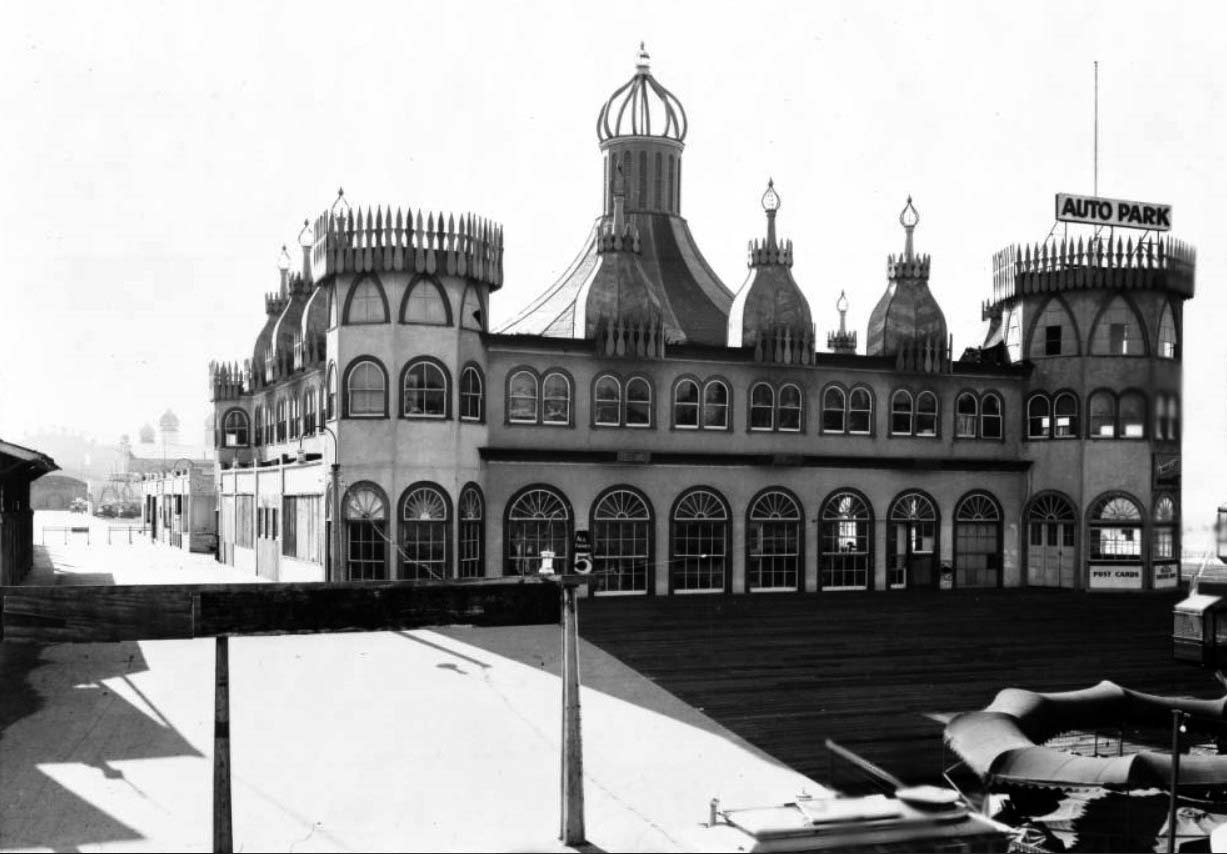 |
|
| (ca. 1920s)** - View of the Santa Monica Pier Merry-go-round. The ride is housed within a large building that resembles a castle with round turrets on the corners and domes along the tops of the walls. Arched windows run along the perimeter on both the first and second stories. A large tower that looks like the top of a circus tent rises from the middle of the building. A sign on one of the castle turrets reads "Auto Park". |
Historical Notes Charles Looff is renowned for innovating a noteworthy style of carousel horse. The moving horses were slender and graceful and inferred motion. The manes featured "cut through" openings, which looked dramatic, but where very time consuming to carve. Around 1905, Looff designed a saddle that resembled a scoop, a design that is still found on carousel horses today. +^ |
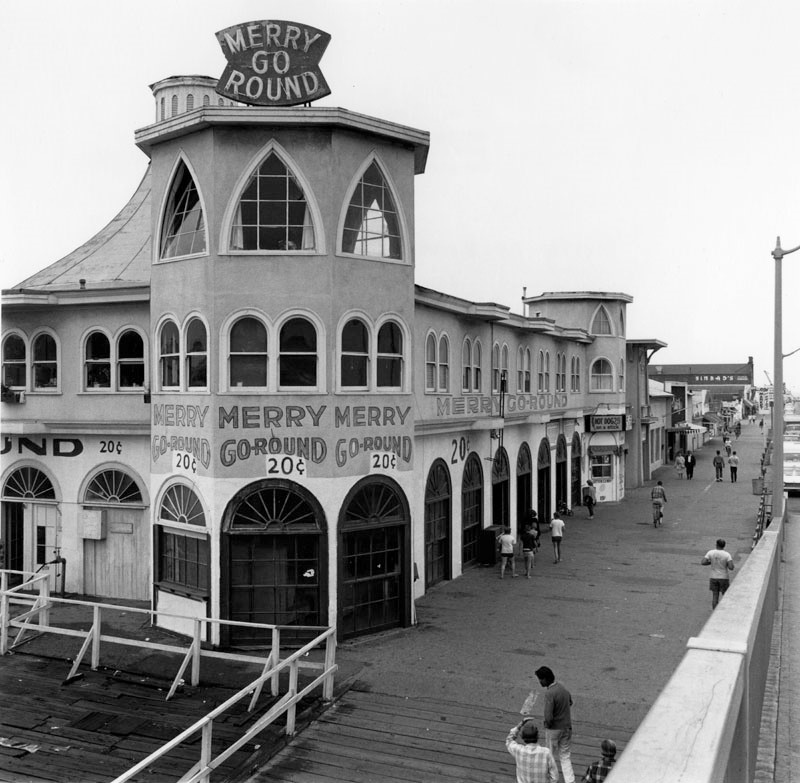 |
|
| (1966)* - Merry-Go-Round (Looff Hippodrome) on the Santa Monica Pier. Photo by William Reagh |
Historical Notes In 1987, the Santa Monica Looff Hippodrome was added to the National Registry of Historic Places. |
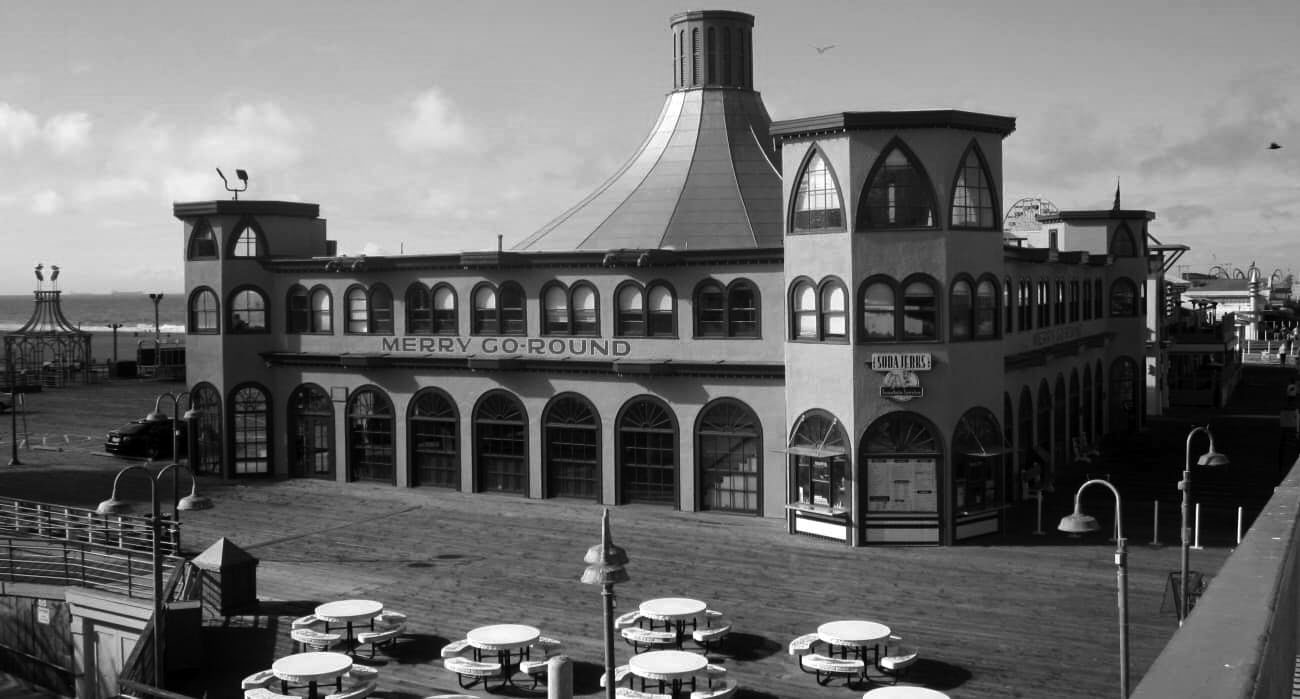 |
|
| (2020)^ - Santa Monica Looff Hippodrome as it appears today. Photo courtesy of Terry Krell Reynolds-Gallob |
Historical Notes Today, the Looff Carousel is the only original structure remaining on the Santa Monica Pier. Records do not indicate what happened to Looff's merry-go-round which was installed in the hippodrome. We do know that it was replaced by one from the old Ocean Park Pier in 1939. The current merry-go-round was built by the Philadelphia Toboggan Company in 1922; its original home was Nashville, Tennessee. The carousel arrived on the West Coast before World War II and in 1947 it was moved from Venice pier to the Santa Monica pier. It has been owned since 1977 by the City of Santa Monica. The 44 original hand-carved and painted wooden horses were restored in 1981-1984. +^ |
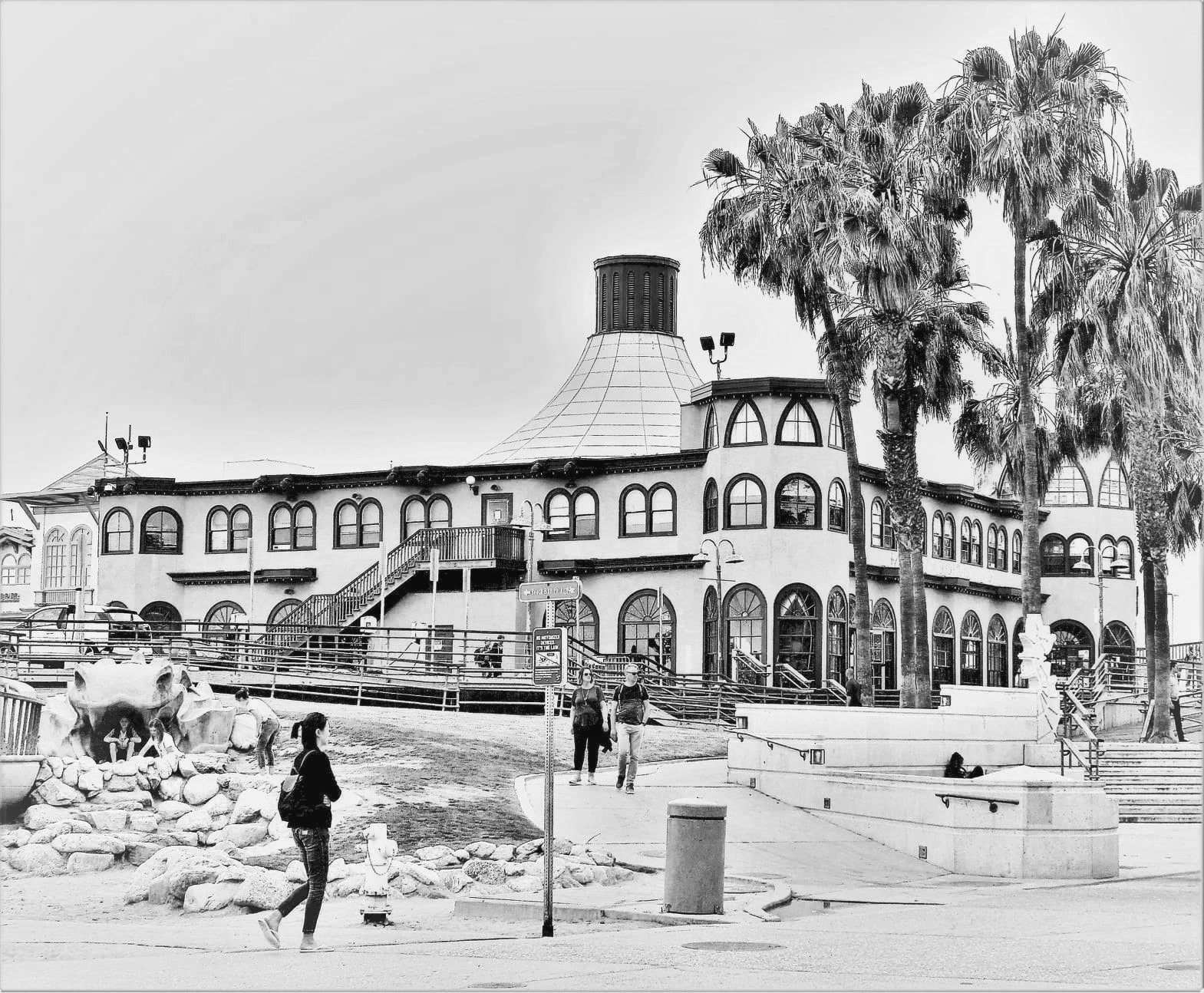 |
|
| (2021)* - Contemporary view of the Merry-Go-Round (Looff Hippodrome) on the Santa Monica Pier. Photo by Howard Gray |
* * * * * |
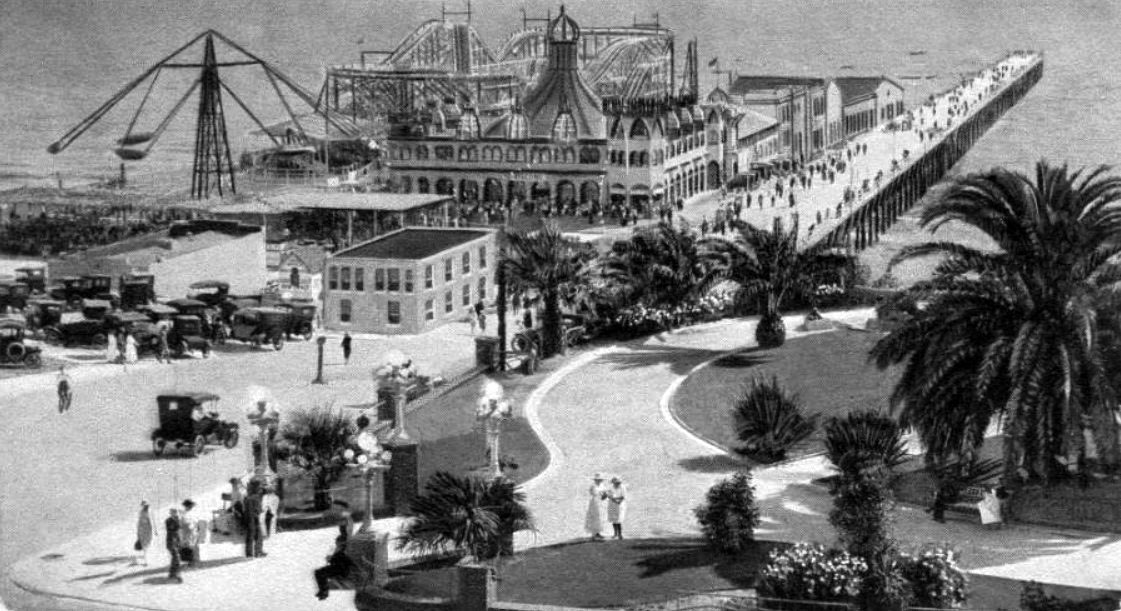 |
|
| (1922)#^# – Postcard view showing Pleasure Pier in Santa Monica. Various rides can be seen on the pier including a large roller coaster. The building with the large circus-like tent on top houses the Merry-go-round. |
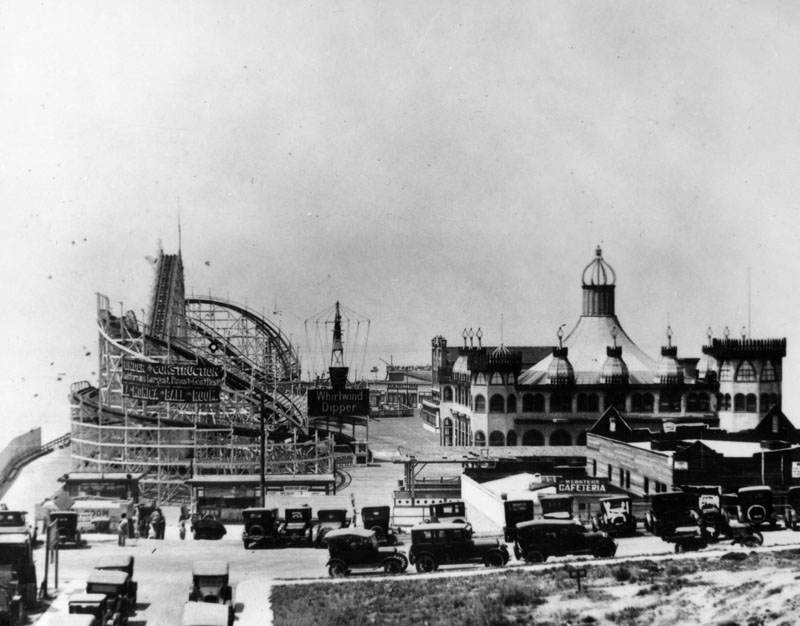 |
|
| (ca. 1924)* - View shows the amusement park, complete with wooden roller coaster, on the Santa Monica pier. |
Historical Notes In additon to the hippodrome, the pier included a billiards and bowling hall, a two-track Blue Streak Racer wooden roller coaster along with The Whip and the Aeroscope thrill rides, a "What Is It?" maze, and several smaller rides.* |
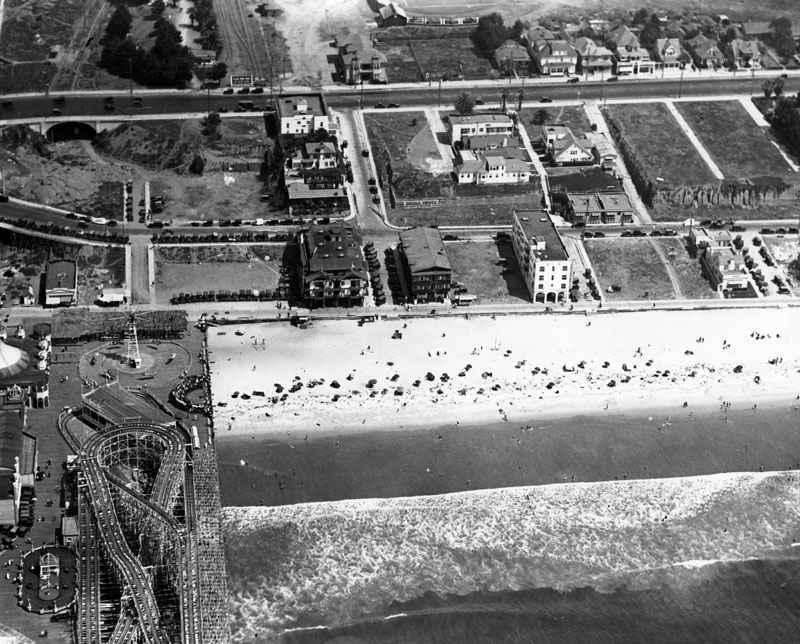 |
|
| (1924)* - Aerial view of the Santa Monica pier located on the beach in Santa Monica. An amusement park with several amusement rides is located on the pier, including a large roller coaster. Several hotels can be seen on the oceanfront of Santa Monica beach. |
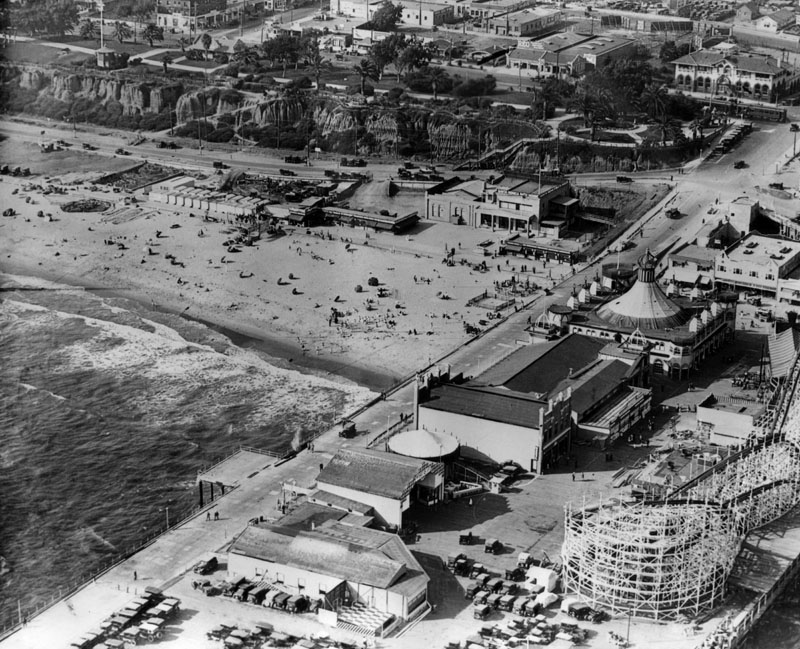 |
|
| (1924)* - Aerial view of the Santa Monica pier. Beach and buildings can be seen on the north side of the pier. |
Historical Notes Looff called this the perfect location for an amusement park, since the area was easy to access via the popular Pacific Electric Air Line as well as an electric trolley that ran from Santa Monica to Venice.*^*^* |
Pacific Electric Stations
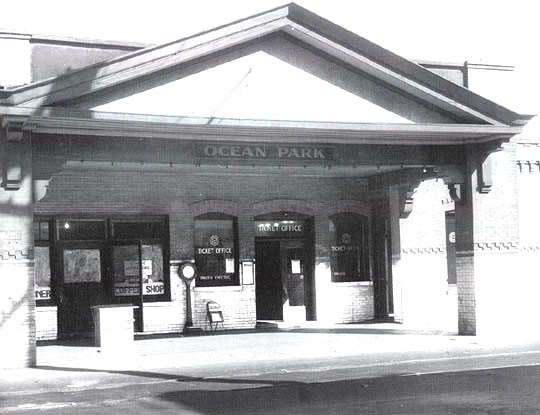 |
|
| (1920s)**#* - In the 1920s the Santa Monica line — then called the Venice via Sawtelle line — stopped at this station in Ocean Park, at Pier St. |
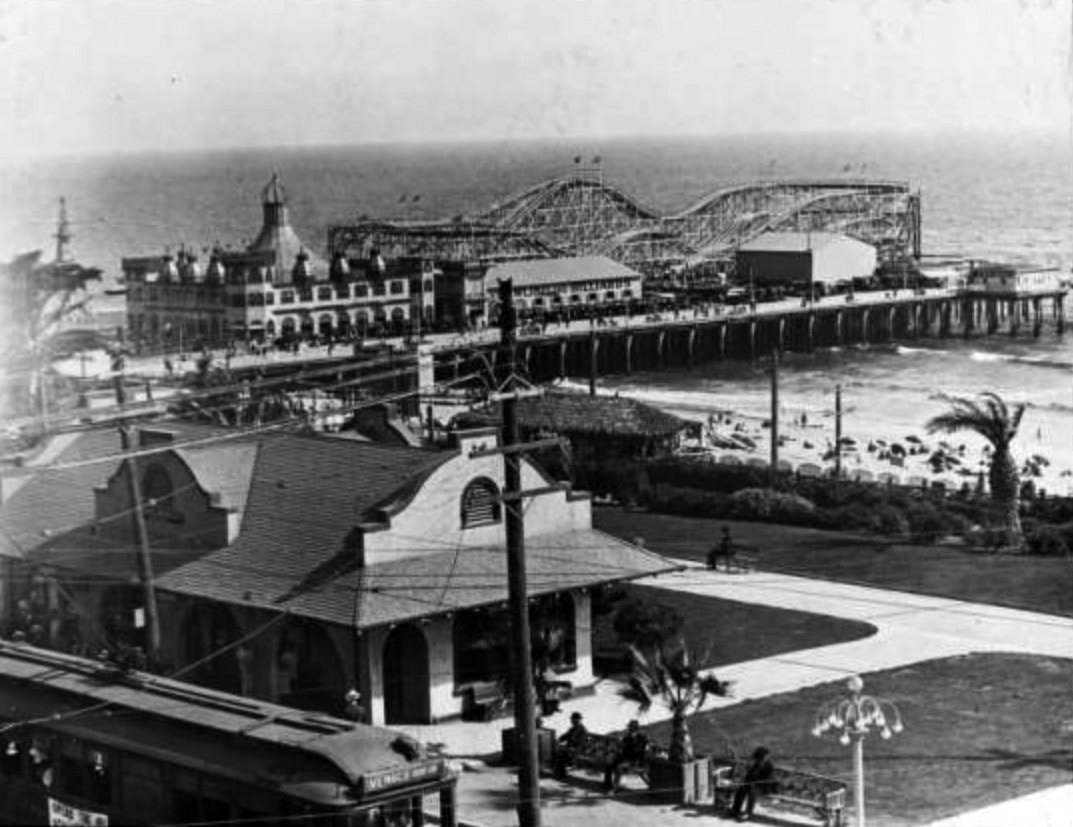 |
|
| (ca. 1917)+^^ – View showing the Pacific Electric Railway Ocean Avenue depot in the foreground, with a streetcar marked "Venice" and the Looff Pleasure Pier, Santa Monica Municipal Pier and beach in distance. The Looff Hippodrome (with "Welcome" sign), "Bowling and Billiards" building, the Blue Streak Racer roller coaster, and Aeroscope rides are visible on the pleasure pier. |
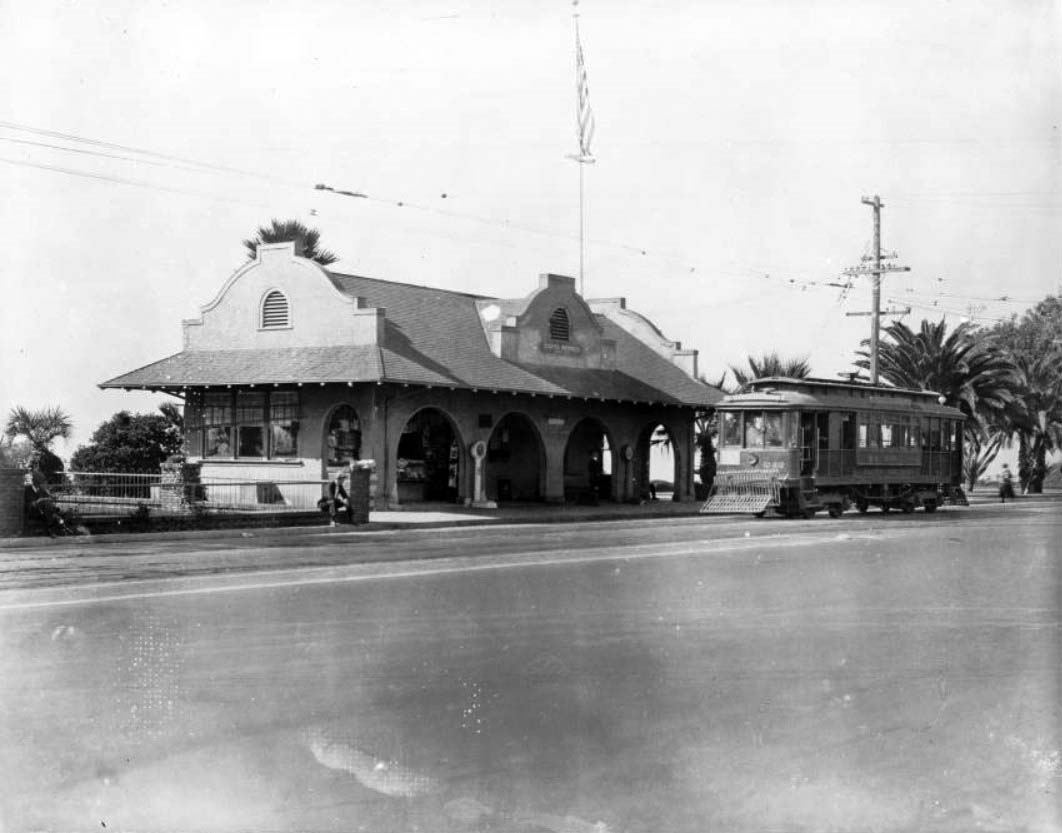 |
|
| (ca. 1922)** - Exterior view of the Pacific Electric Station in Santa Monica. The small station is at center and is a single-story Spanish-style building. Several large archways provide access to a small porch in front of the building, and tall stucco walls project out of the roof. A streetcar is visible on the tracks in front of the station. A metal fence encloses a small yard at left, and several palm trees are visible in the distance at right. A massive American flag is hanging from a pole near the train station. |
.jpg) |
|
| (1920s)#^ – View showing a Pacific Electric Railway train passing Linda Vista Station on Ocean Avenue. Banners hang from a dual-lamp light post. Click HERE to see more Early LA Streetlights. |
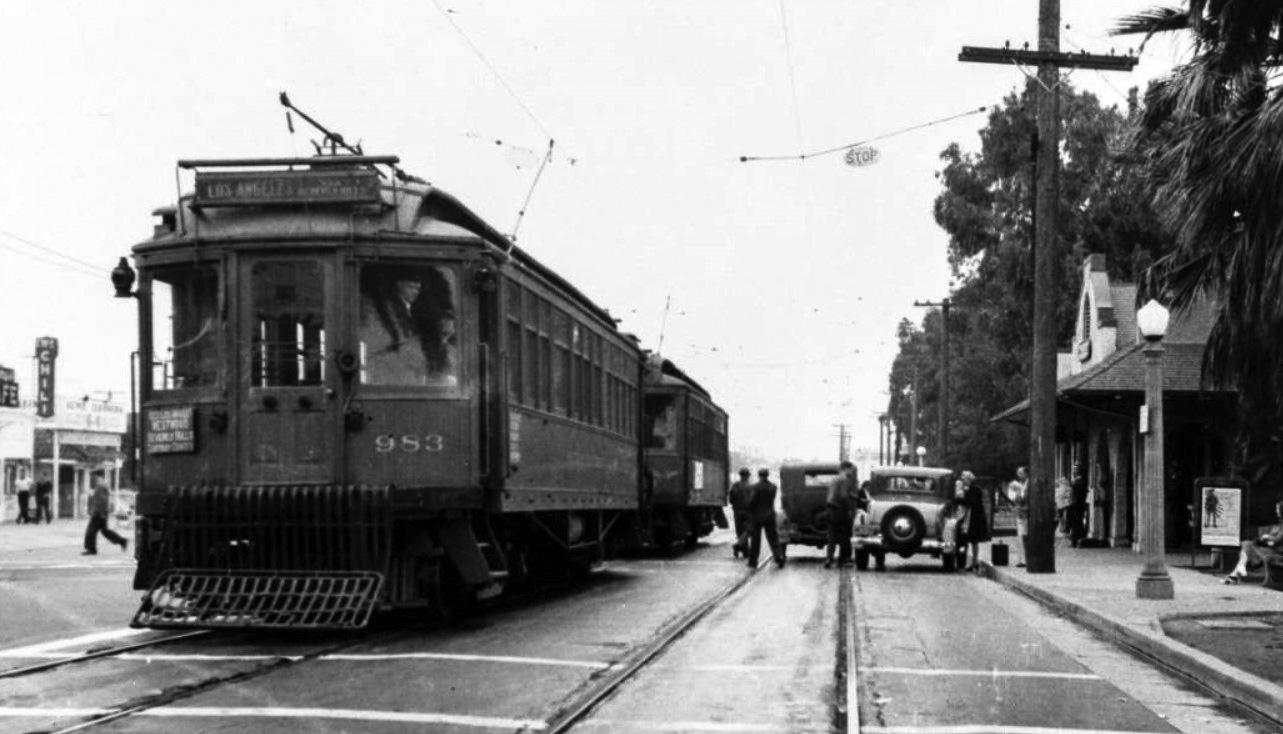 |
|
| (ca. 1930s)*– View showing Pacific Electric streetcar no. 983 at the Ocean Avenue depot in Santa Monica. Signs on the front of the streetcar read "Los Angeles vis Beverly Hills" and "West Los Angeles Westwood Beverly Hills Carthay Center." |
Historical Notes In the 1930s the Santa Monica via Beverly Hills line had the highest patronage of any inter-city or suburban line of the Pacific Electric Railway. Yet it was converted to bus operation in 1940, unlike the various PE suburban lines that survived World War II. |
* * * * * |
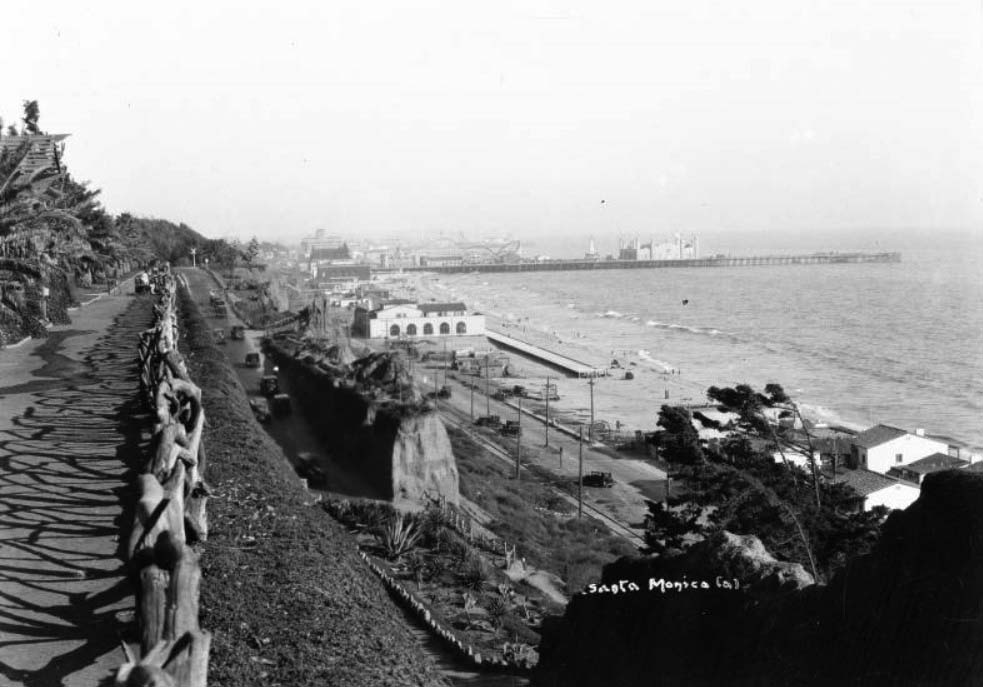 |
|
| (ca. 1924)* - View of the Santa Monica Pier looking south from the Palisades Park cliff path. The pier is in the distance at center and stretches out into the ocean at right. There are several large buildings and a roller coaster on the long wooden walkway. There are several early-model automobiles making their ways up and down the incline. |
* * * * * |
La Monica Ballroom
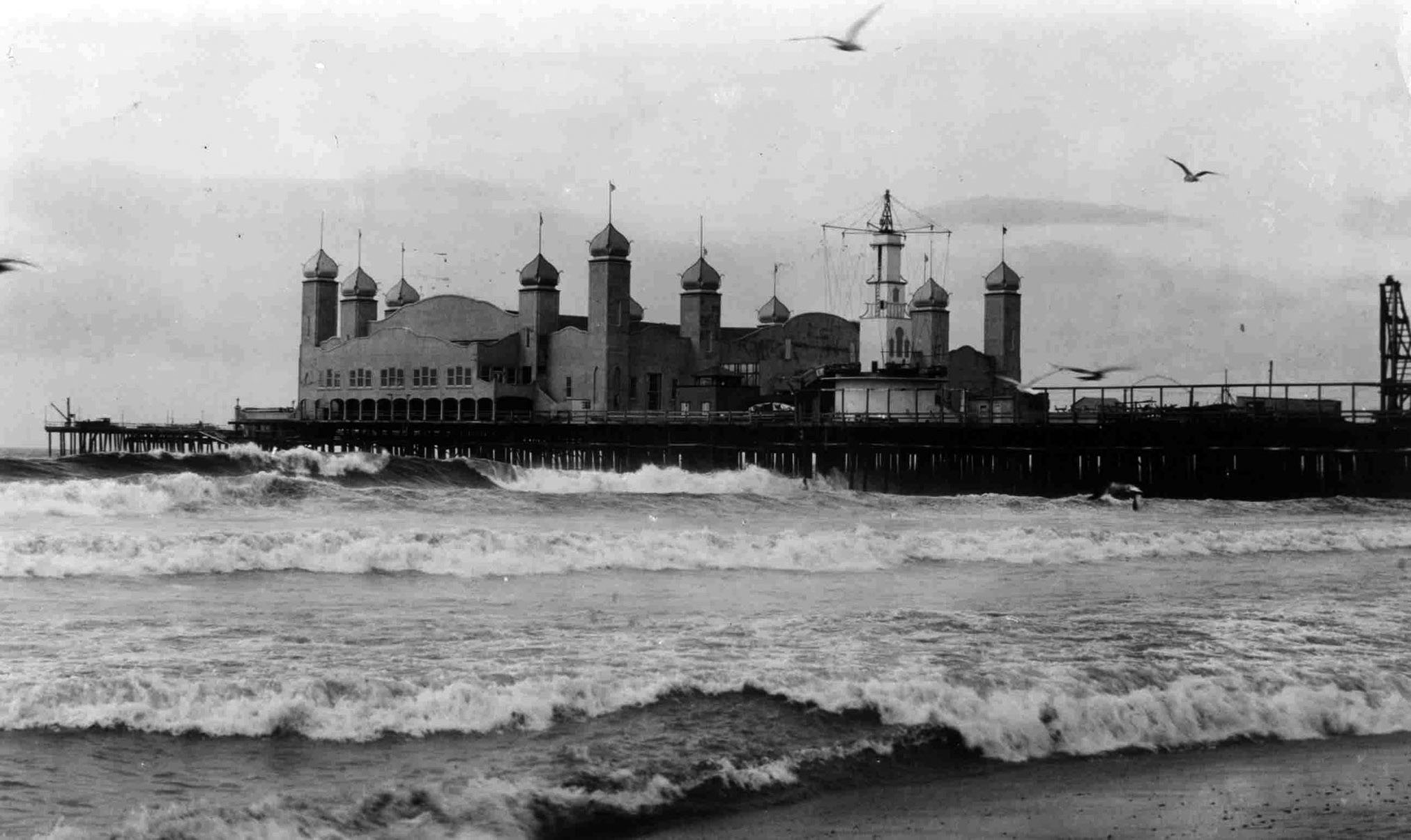 |
|
| (1926)*- Looking out toward the Santa Monica Pier, with the exotic La Monica Ballroom extending over the ocean at its western end. Designed in a blend of Spanish Colonial and French Renaissance styles, it was once the largest ballroom on the West Coast. |
Historical Notes Opened in July 1924 and designed by amusement architect T.H. Eslick, the La Monica Ballroom quickly became one of the most iconic dance venues on the West Coast. With domed corner towers and curvilinear gables, it evoked a seaside palace hovering above the waves. |
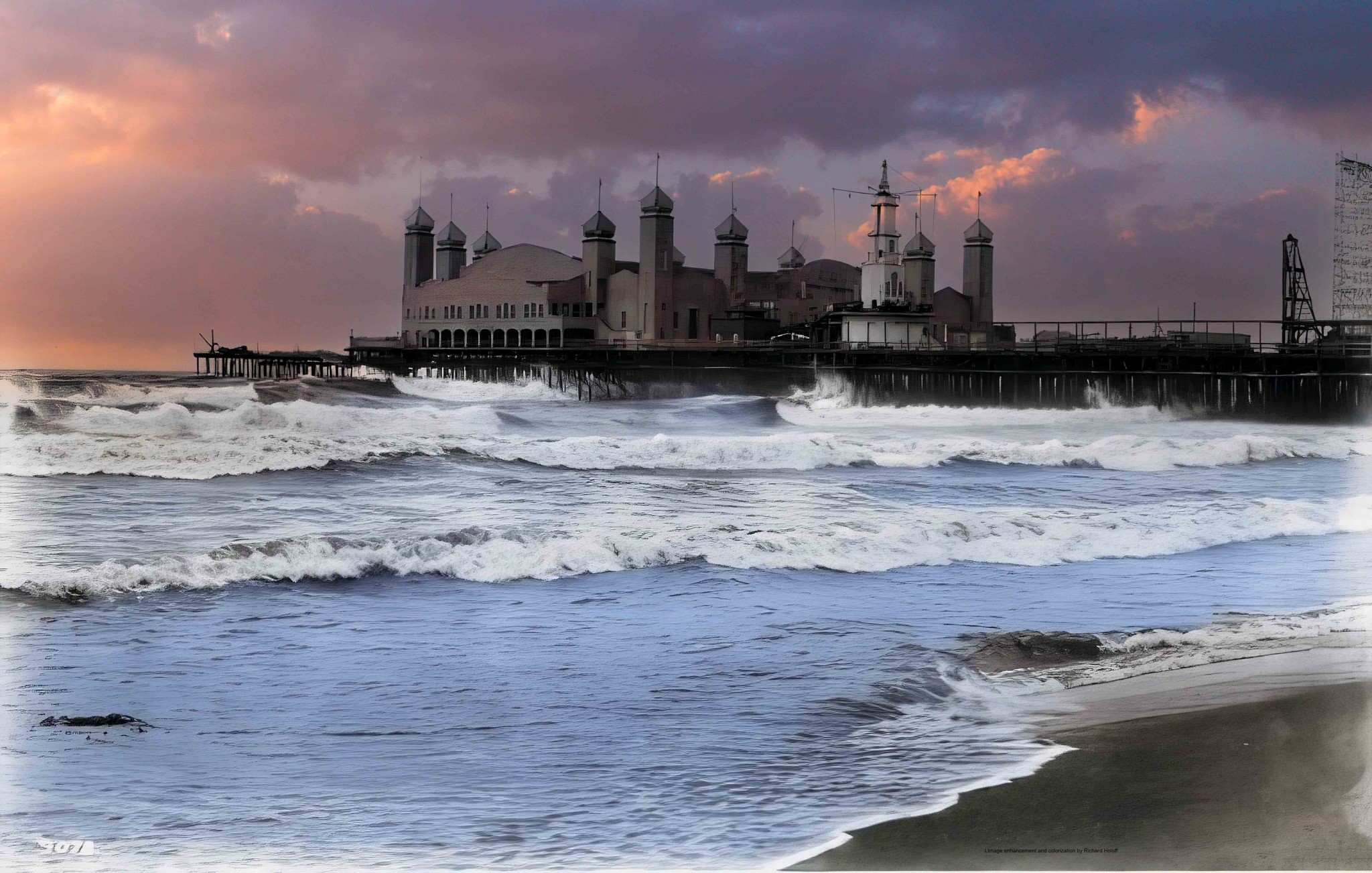 |
|
| (1926)* - Colorized view of the Santa Monica Pier, showing the La Monica Ballroom with its dramatic domed towers rising above the waves. Photo by C.C. Pierce; colorization by Richard Holoff. |
Historical Notes This enhanced photo captures the exotic silhouette of the La Monica Ballroom, whose rooftop minarets and arches made it a standout along the coastline. The ballroom could accommodate up to 5,000 dancers on its massive maplewood floor, drawing crowds nightly in the 1920s. |
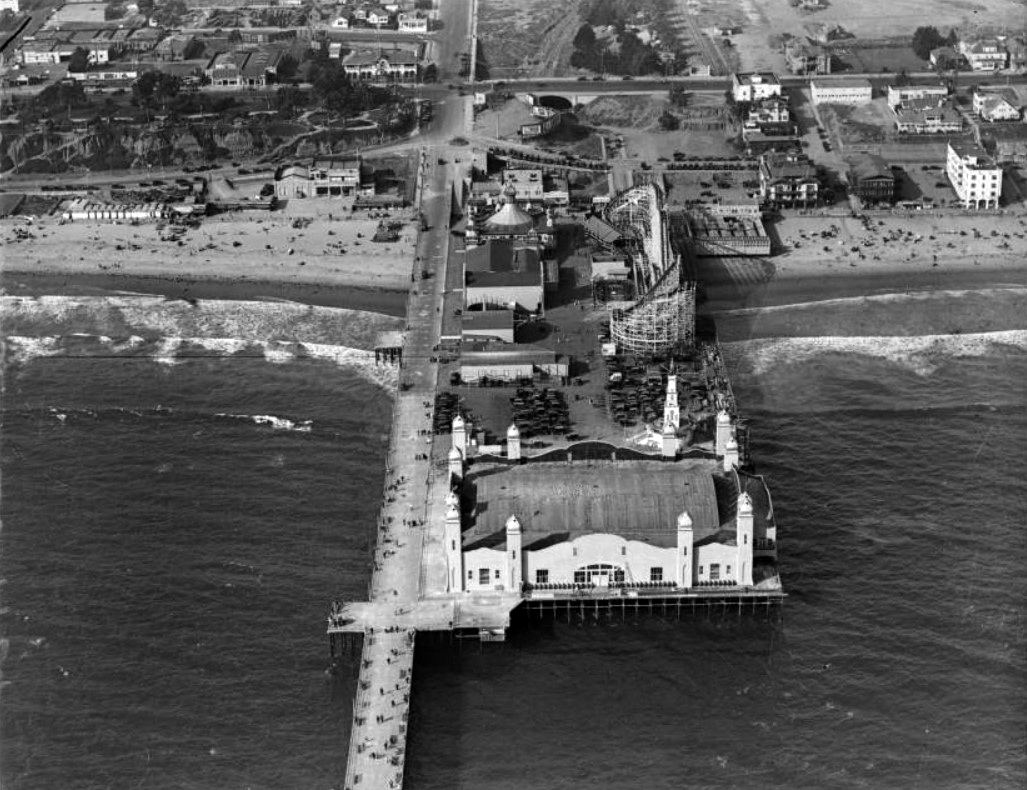 |
|
| (1924)* - Early aerial looking east over the Santa Monica Pier, showing the Whirlwind Dipper, Looff Hippodrome, and the La Monica Ballroom nearing completion at the pier’s end. |
Historical Notes This 1924 photo shows the Santa Monica Amusement Pier in its prime, shortly before the La Monica Ballroom opened to 50,000 eager attendees. At the time, the ballroom was one of the largest in the world and would soon redefine nightlife along the California coast. |
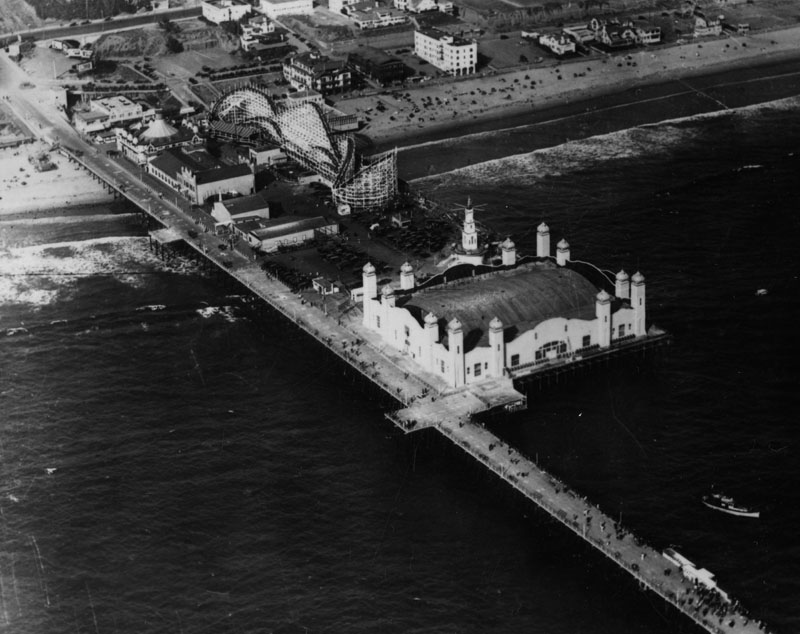 |
|
| (1924)* - Overhead view of the newly completed La Monica Ballroom sitting at the end of the Santa Monica Pier. |
Historical Notes Seen here shortly after completion, the La Monica Ballroom’s footprint dominated the western end of the pier. Its elaborate façade and rooftop domes added a new architectural grandeur to the Santa Monica shoreline. |
 |
|
| (1924)* - View looking northwest toward the Santa Monica Pier. In the foreground is the "Municipal Community Service Playground No. 2. Beyond that, crowds of people are seen looking out toward the surf. In the background stands the pier with its roller coaster and the newly constructed La Monica Ballroom. |
Historical Notes This image captures the pier during a bustling beach day in 1924, with the whimsical La Monica Ballroom rising in the distance like a Moorish castle above the Pacific. |
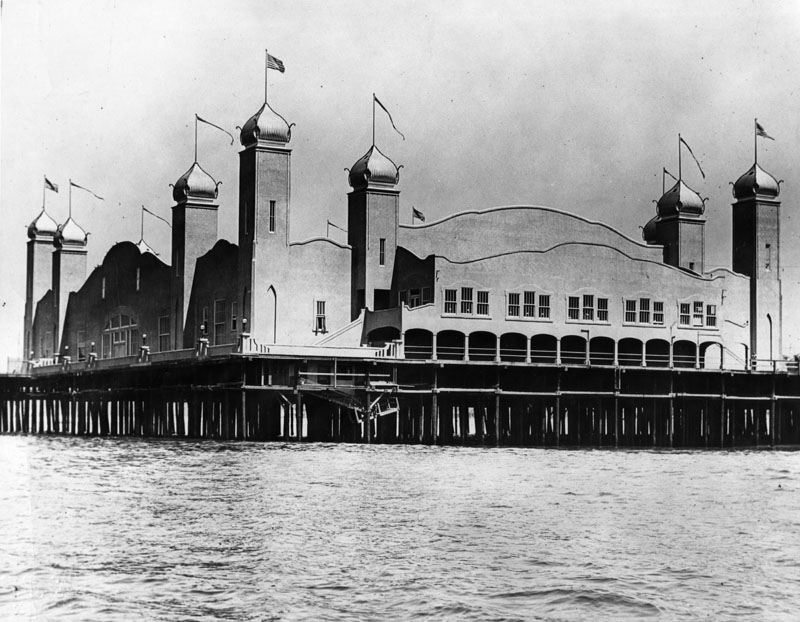 |
|
| (1924)* - The elegant La Monica Ballroom perched over the ocean at the western edge of the Santa Monica Pier. |
Historical Notes The 15,000-square-foot ballroom featured a "submarine garden" interior theme and open windows for ocean breezes—creating a fantasy-like atmosphere for dancing couples above the sea. |
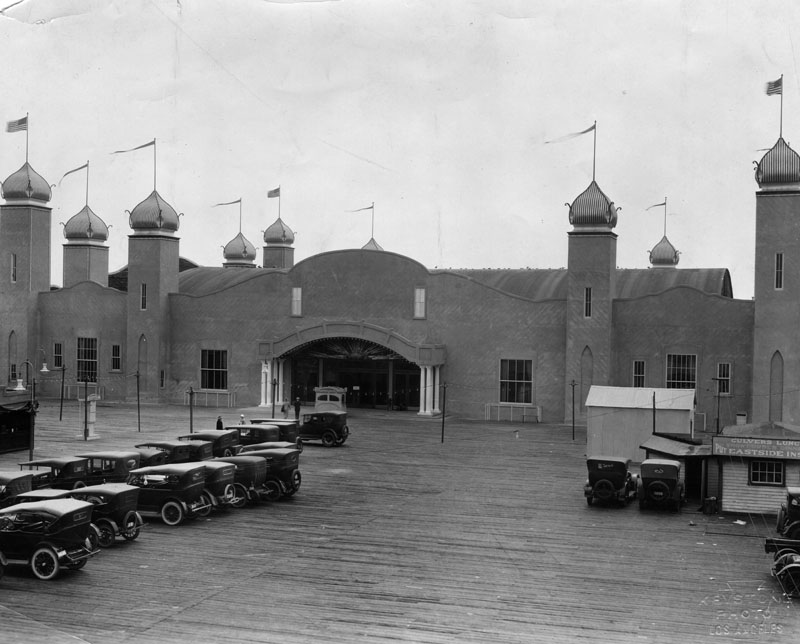 |
|
| (1924)* - Autos crowd the pier during the grand opening of the La Monica Ballroom on July 23, 1924. |
Historical Notes The ballroom’s debut drew over 50,000 people, resulting in the first recorded traffic jam in Santa Monica history. The interior’s marine motif and spacious dance floor made it a sensation nearly overnight. |
 |
|
| (ca. 1920s)* - Looking back toward the Santa Monica coastline from the end of the pier, with the La Monica Ballroom in the foreground and the city’s beachside hotels rising behind. |
Historical Notes This view illustrates how the ballroom functioned as both a social and visual anchor for the pier. It served as a glamorous contrast to the stately hotels lining Ocean Avenue. |
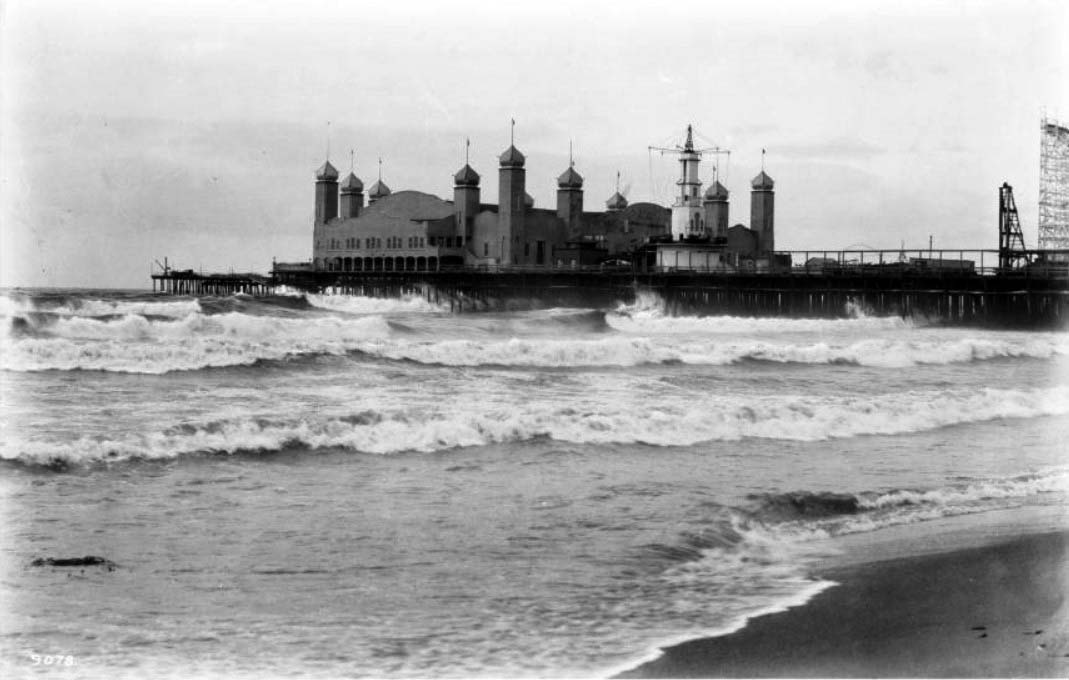 |
|
| (ca. 1926)*- Heavy surf crashes along the shore as the ornate La Monica Ballroom looms above the waves at the end of the pier. |
Historical Notes While the La Monica Ballroom is often described as having four minaret-topped corner towers, historical photographs show that it also featured several smaller domed cupolas along the roofline. These secondary turrets enhanced the building’s symmetry and gave it the exotic silhouette of a Moorish palace, especially when viewed from the beach or bluffs. |
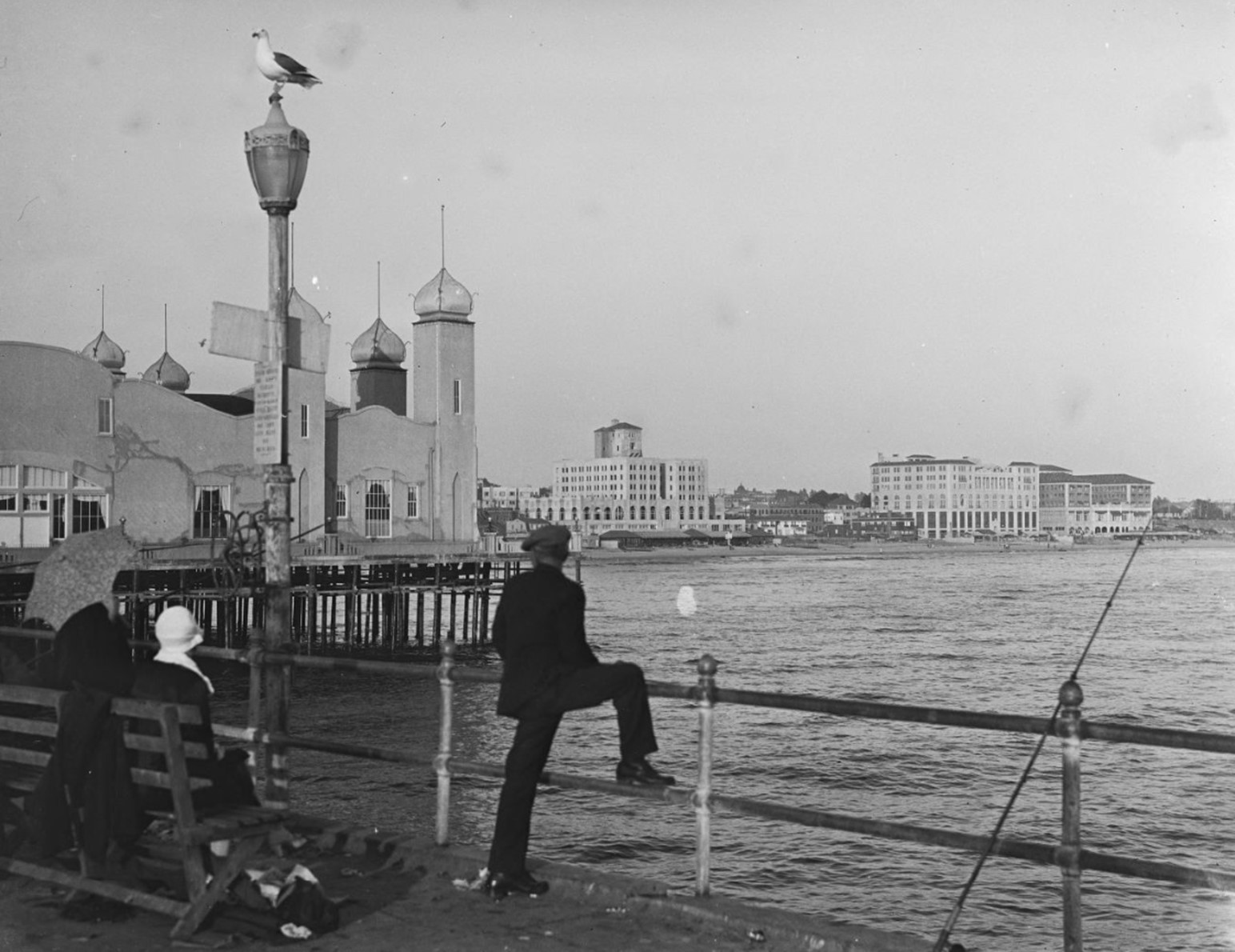 |
|
| (ca. 1927)* - Looking out to the shoreline from the Santa Monica Pier with the La Monica Ballroom seen at left. |
Historical Notes As the centerpiece of the pier, the ballroom’s massive frame offered sweeping views of both sea and shore, making it an attraction not just for dancers, but also for sightseers. |
Then and Now
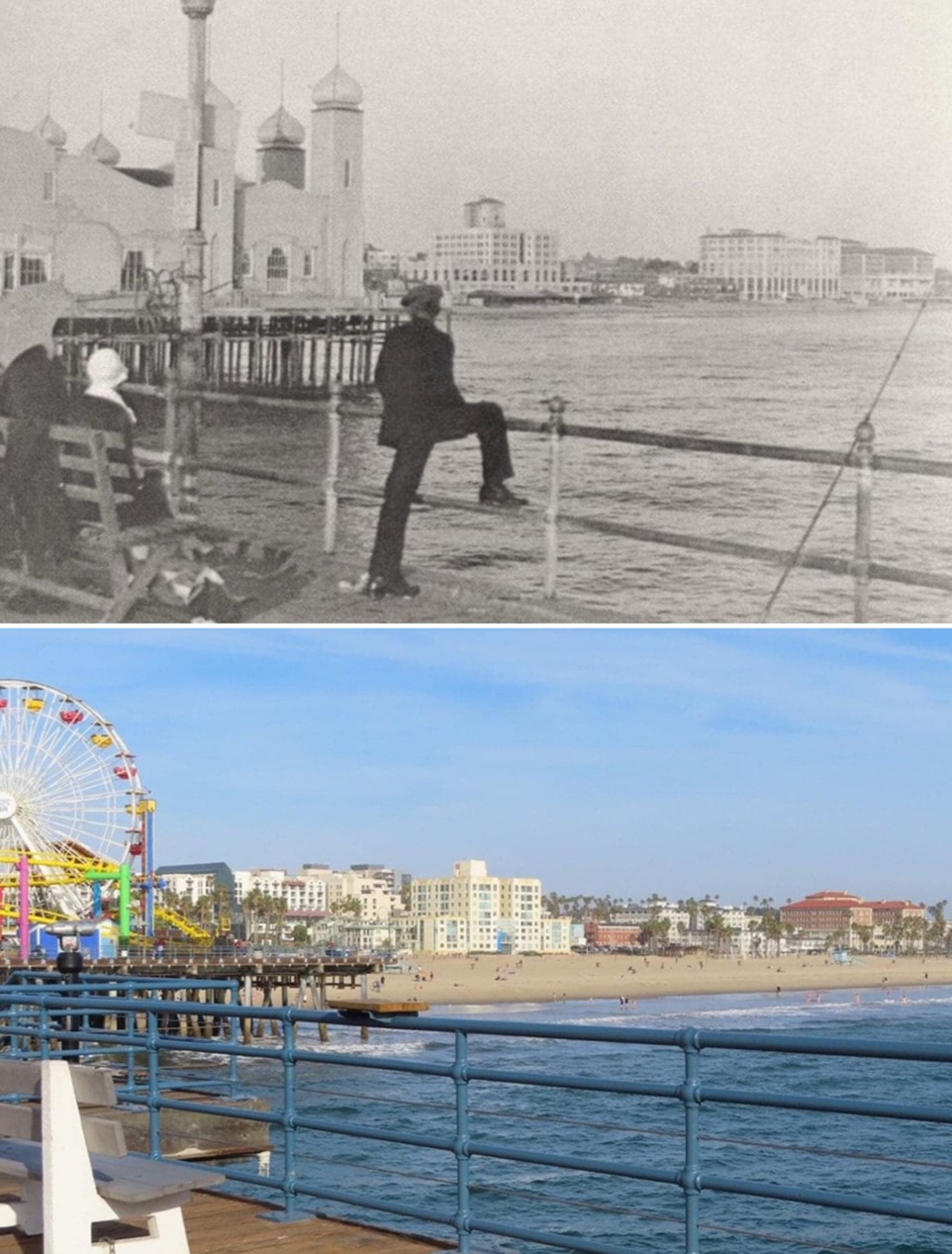 |
|
| (1927 vs Now)* - Santa Monica Pier showing the LA Monica Ballroom where the Ferris wheel is today. Contemporary photo by Lorie Vignolle-Moritz. Photo comparison by Jack Feldman. |
Historical Notes Though demolished in 1963, the legacy of La Monica lives on. The footprint once covered by its maple dance floor is now part of a modern amusement park that still entertains crowds above the surf. |
 |
|
| (ca. 1937)* - Looking out from Palisades Park towards the La Monica Ballroom on the Santa Monica Pier. Beachgoers cover the beach and many boats are docked in the bay. |
Historical Notes Though the ballroom’s dance heyday faded during the Depression, the building remained a dominant feature on the coastline, serving multiple functions including a lifeguard HQ and convention center. |
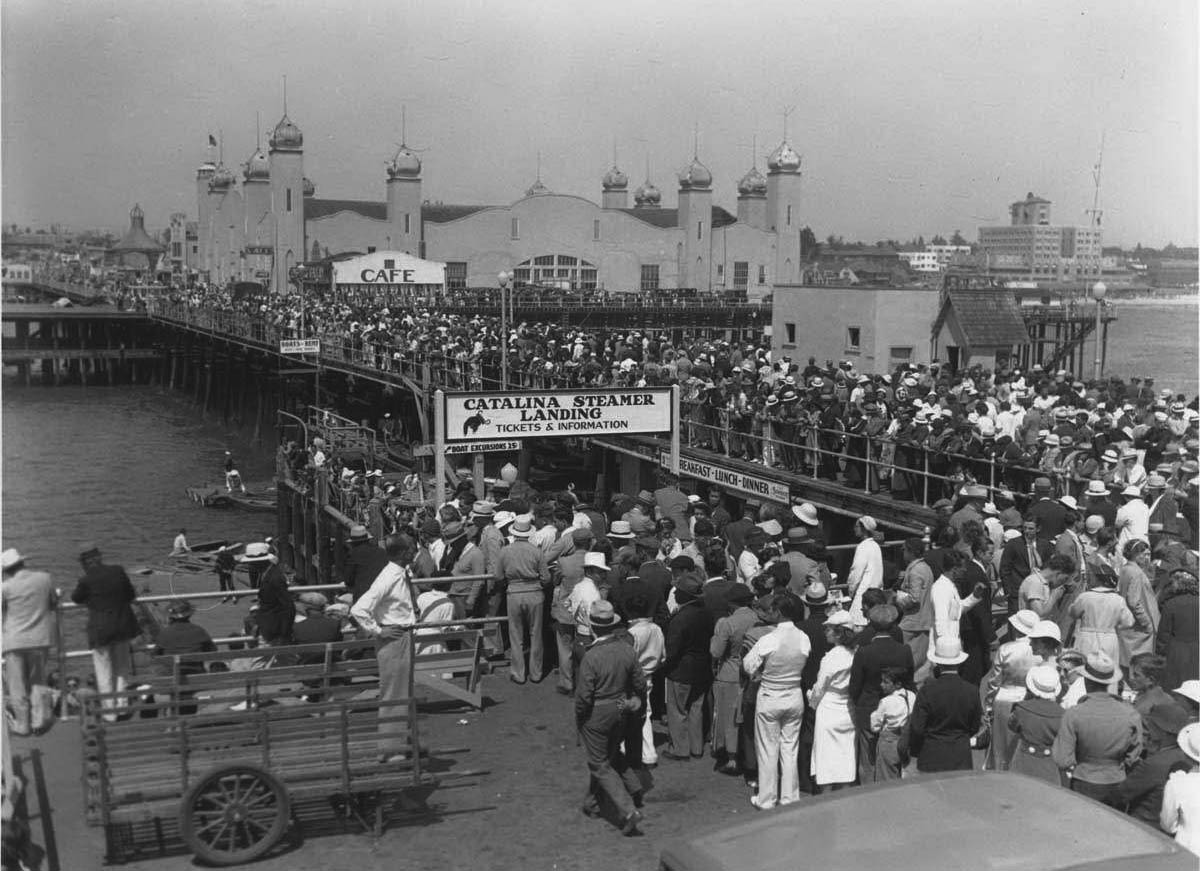 |
|
| (1936)* - Crowds of people standing in line at the Catalina Steamer Landing on Santa Monica Pier across from the La Monica Ballroom. |
Historical Notes During the 1930s, the pier also served as a passenger terminal and yacht harbor. La Monica, now repurposed, witnessed the shift from dance hall to multipurpose waterfront facility. The Thirties saw the rise of the Santa Monica Yacht Harbor. A breakwater was constructed so boats could be safely moored and to also protect the pier. A collection of yachts, fishing boats and a cruise liner to Catalina made the yacht harbor their home base. However, the breakwater was poorly engineered and began to sink into the sandy ocean floor and it is almost completely submerged today. With Marina del Rey, the worlds' largest man-made pleasure boat harbor opening in 1965 just a few miles south of the pier, signaled the end of boating activities at the Santa Monica Pier. |
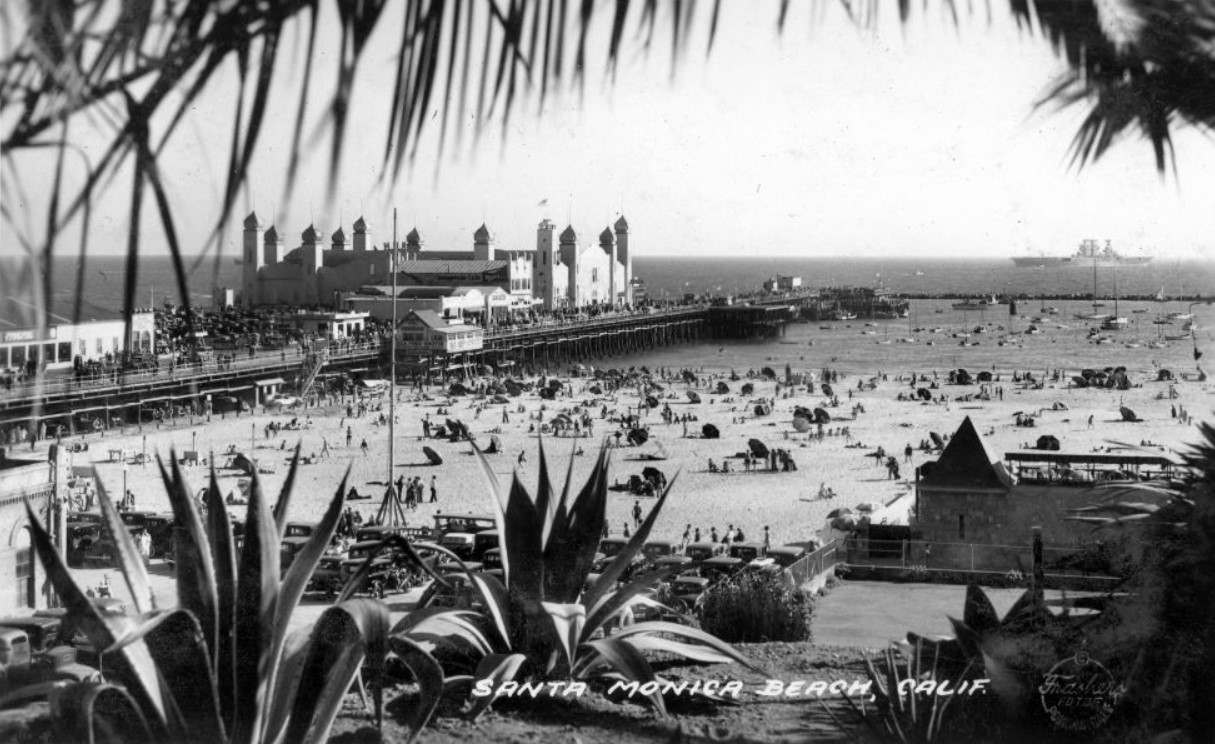 |
|
| (1936)* – Postcard view of Santa Monica Beach showing the La Monica Ballroom on the pier. A portion of the Deauville Club can be seen in lower right (opened in 1927). |
Historical Notes By this time, the ballroom was no longer hosting nightly dances but remained a landmark structure amid the evolving beachscape and social clubs along the coast. |
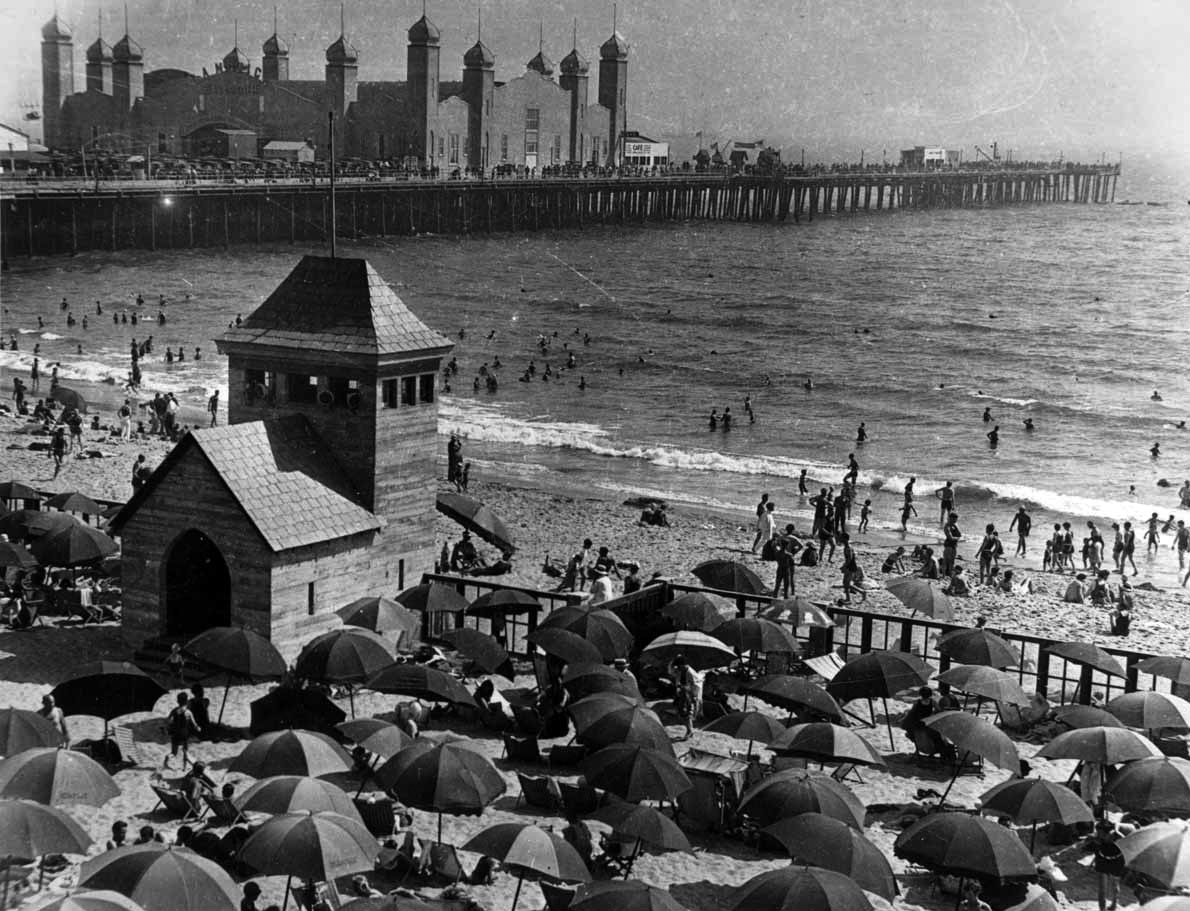 |
|
| (ca. 1930)* – The Santa Monica Deauville Club in the foreground, with the La Monica Ballroom rising in the distance above the pier. |
Historical Notes As elite beach clubs sprang up along the coast in the late 1920s, La Monica continued to be a popular public venue—bridging the divide between exclusive leisure and mass entertainment. |
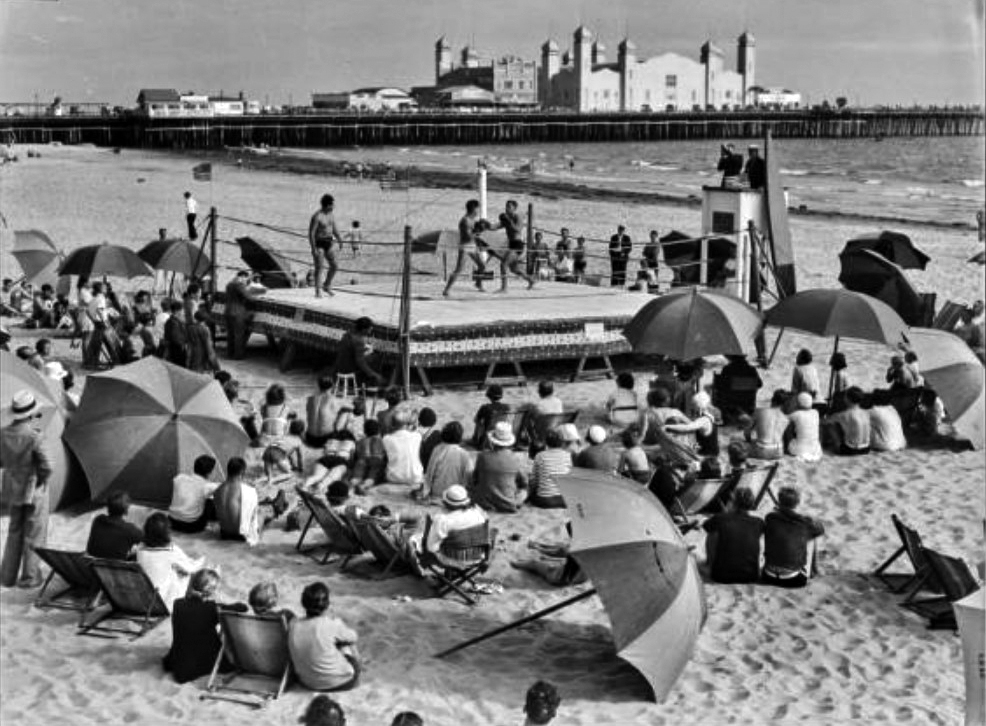 |
|
| (ca. 1934)* - Image of a crowd amid beach umbrellas watching two pugilists boxing in an outdoor boxing ring on the beach in front of the Santa Monica Athletic Club. The Santa Monica Pleasure Pier with the La Monica Ballroom and Municipal Pier are in the background. |
Historical Notes As its dance hall fame declined, the La Monica Ballroom stood witness to a new era of beachside attractions, civic events, and sports exhibitions—all reshaping Santa Monica’s identity during the Depression. |
* * * * * |
Venice Trams (Between Venice and Santa Monica)
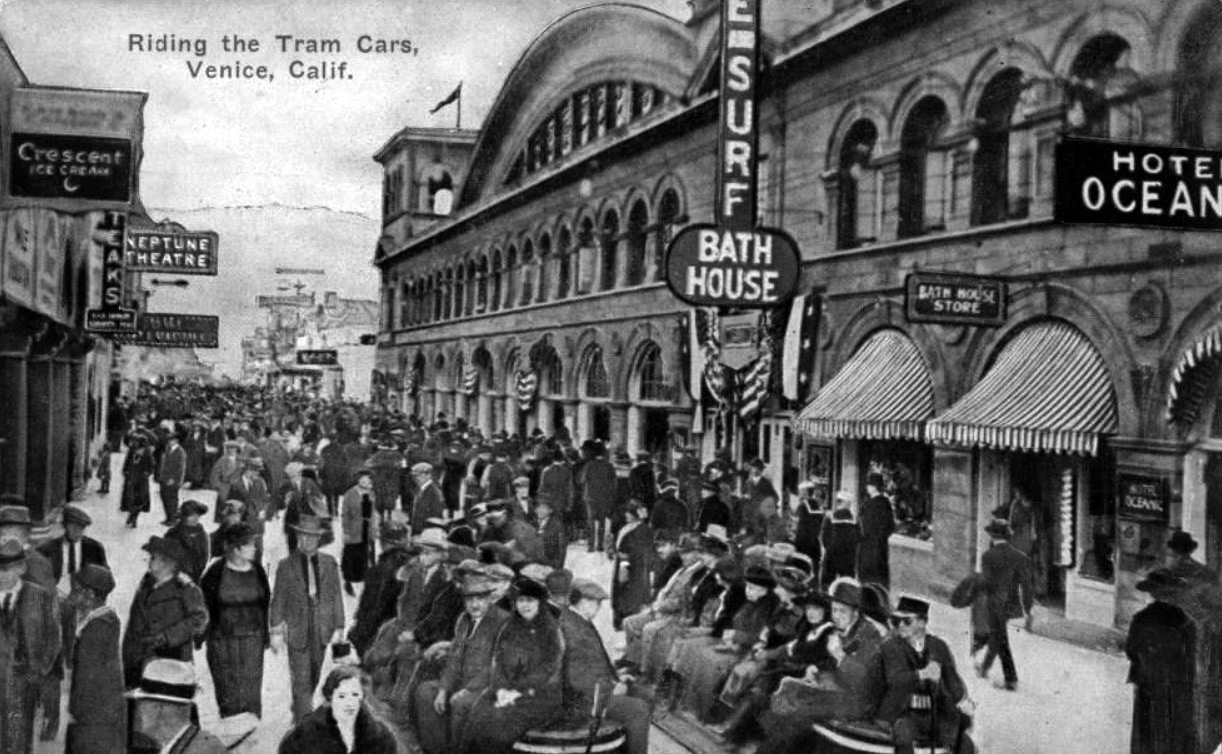 |
|
| (1910s)* – Postcard view of ‘Riding the Tram Cars’, Venice, Calif. |
Historical Notes The Venice trams were operated by a uniformed motorman along a north and south route on the concrete boardwalk between Santa Monica and Venice. These trackless electric trams amounted to battery powered upholstered wicker benches with lever type hand controller and mechanical brake at one end. The electric trams operated between 1916-1929. By the 1930s, the trams had 4 cylinder, Ford model A engines. |
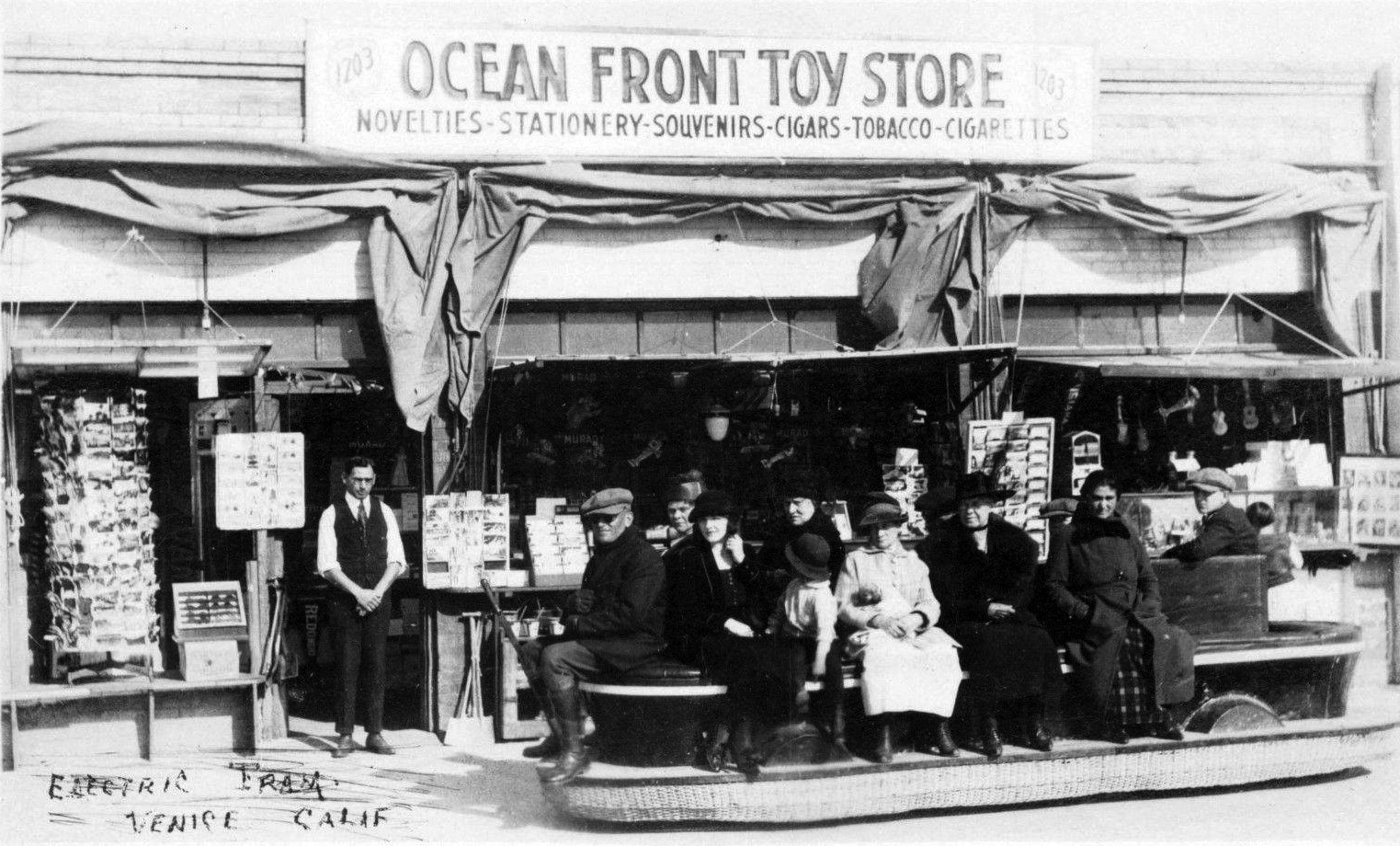 |
|
| (ca. 1916)* - Electric tram ride on the Ocean Front with Ocean Front Toy Story in the background. |
Historical Notes The conductor of this tram would switch end positions at Santa Monica to drive it back to Venice. There was no feature that allowed for turnaround. And there was also nothing to protect passengers from the hot sun overhead. |
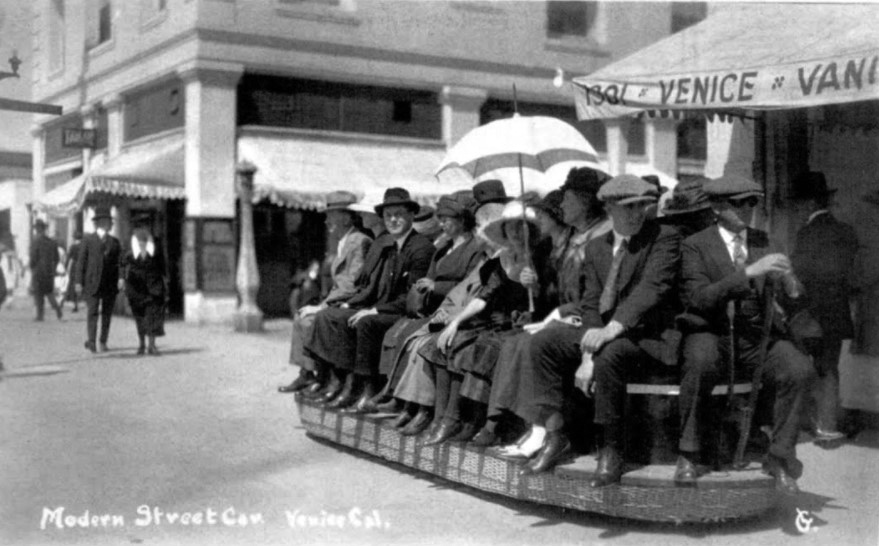 |
|
| (ca. 1910s)* – Postcard view showing one of the first generation electric trams that ran from Venice to Santa Monica. Photo courtesy of Sarah and John Schacht. |
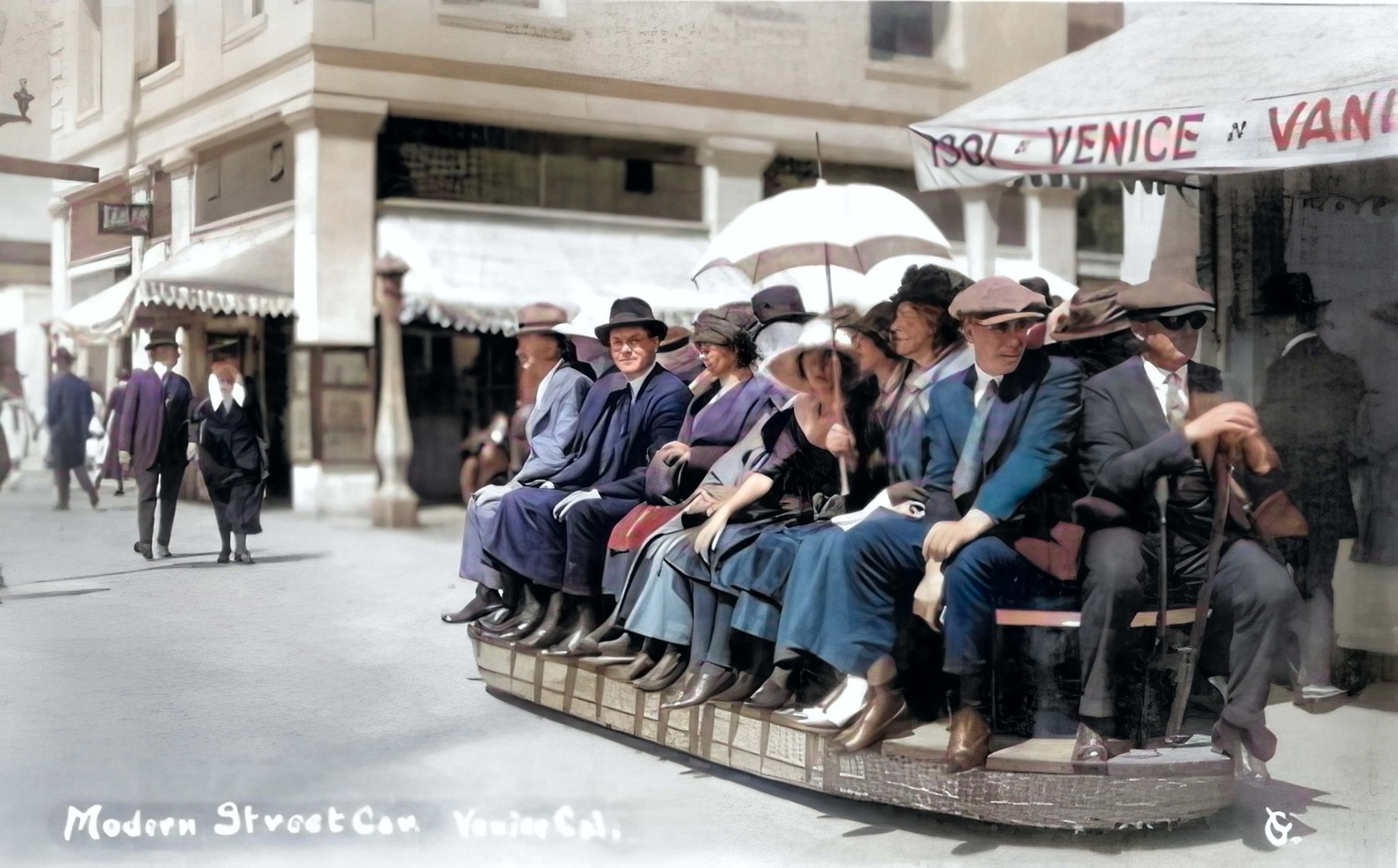 |
|
| (ca. 1910s)* – Postcard view showing one of the first generation electric trams that ran from Venice to Santa Monica. Photo courtesy of Sarah and John Schacht. Image enhancement and colorization by Richard Holoff. |
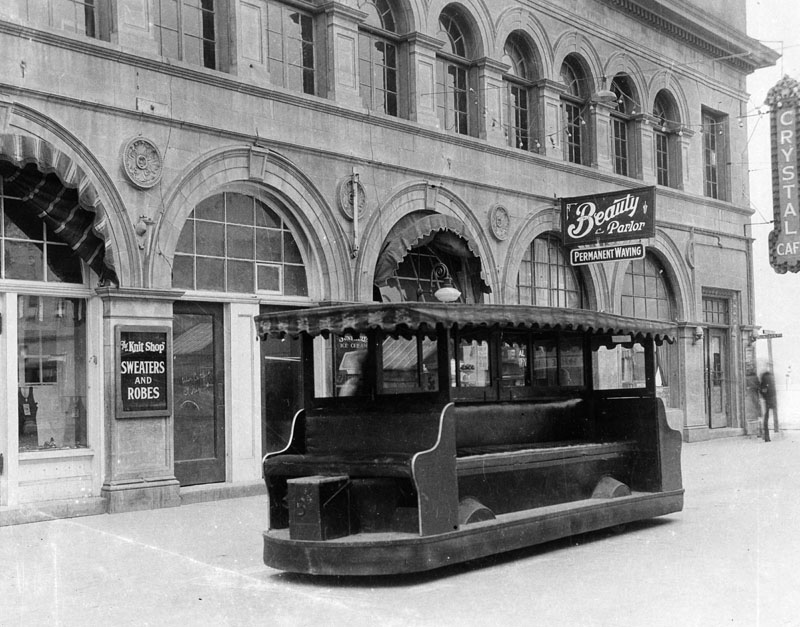 |
|
| (1920s)* - View showing a 2nd generation tram sitting on the Venice sidewalk/street, This open sided electric tram had an awning above and room for seating on all sides. |
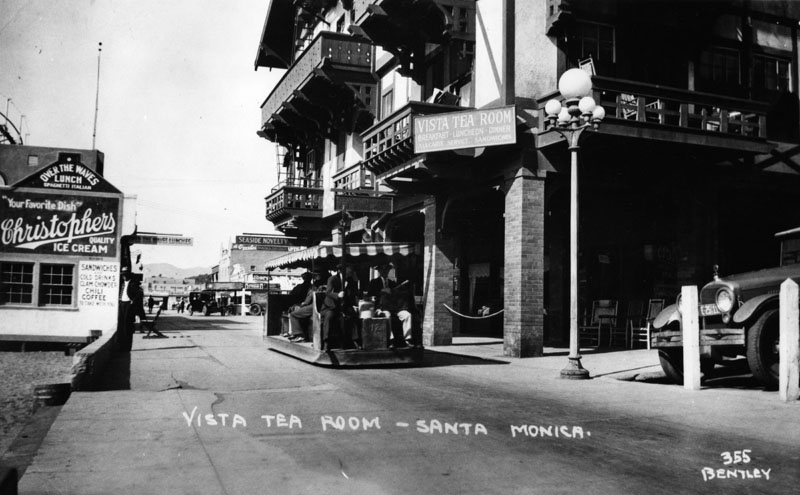 |
|
| (1920s)* - Exterior view of the Vista Tea Room in Santa Monica. On the left is a small building called Over the Waves Lunch, and the Seaside Novelty can be seen in the background. An electric tram moves people along the walkway. |
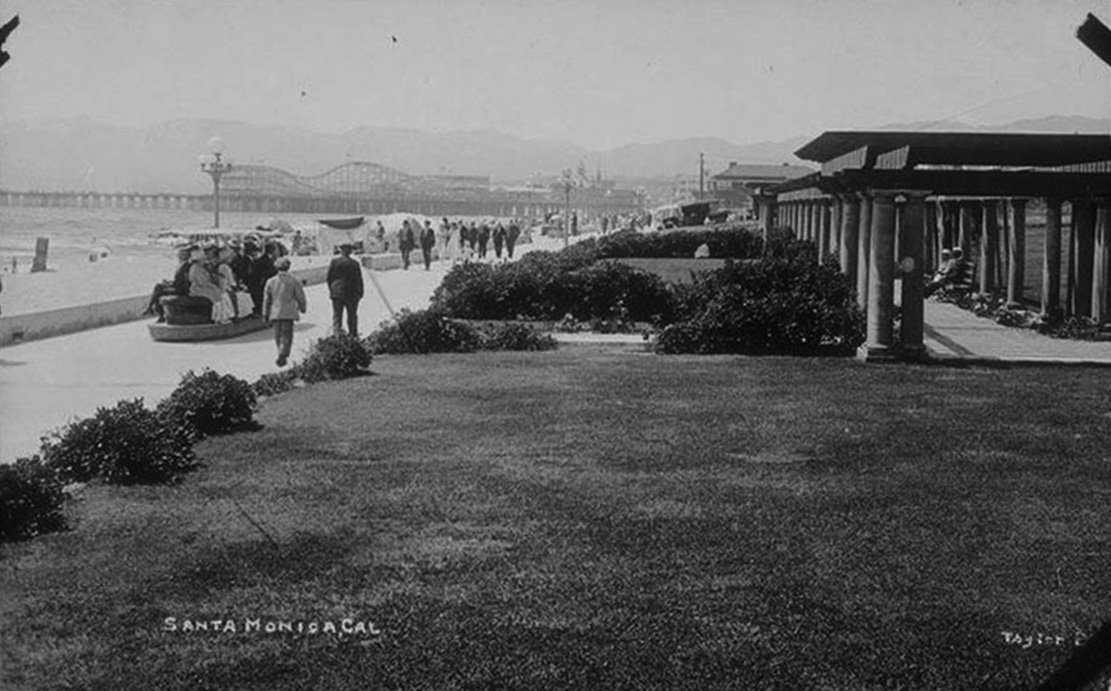 |
|
| (1920s)* – View showing an electric tram heading north on Ocean Front Walk in front of Seaside Park (present day Crescent Bay Park). |
Historical Notes Electric tram service on Ocean Front Walk between Venice and Ocean Park began operation in 1916. By 1920 the trams were electric battery powered. They ran from Windward Ave. and the Venice Pier, to the Ocean Park Pier, and then to the Santa Monica Pier, and back. In 1923, the Venice Tram Company was formed. |
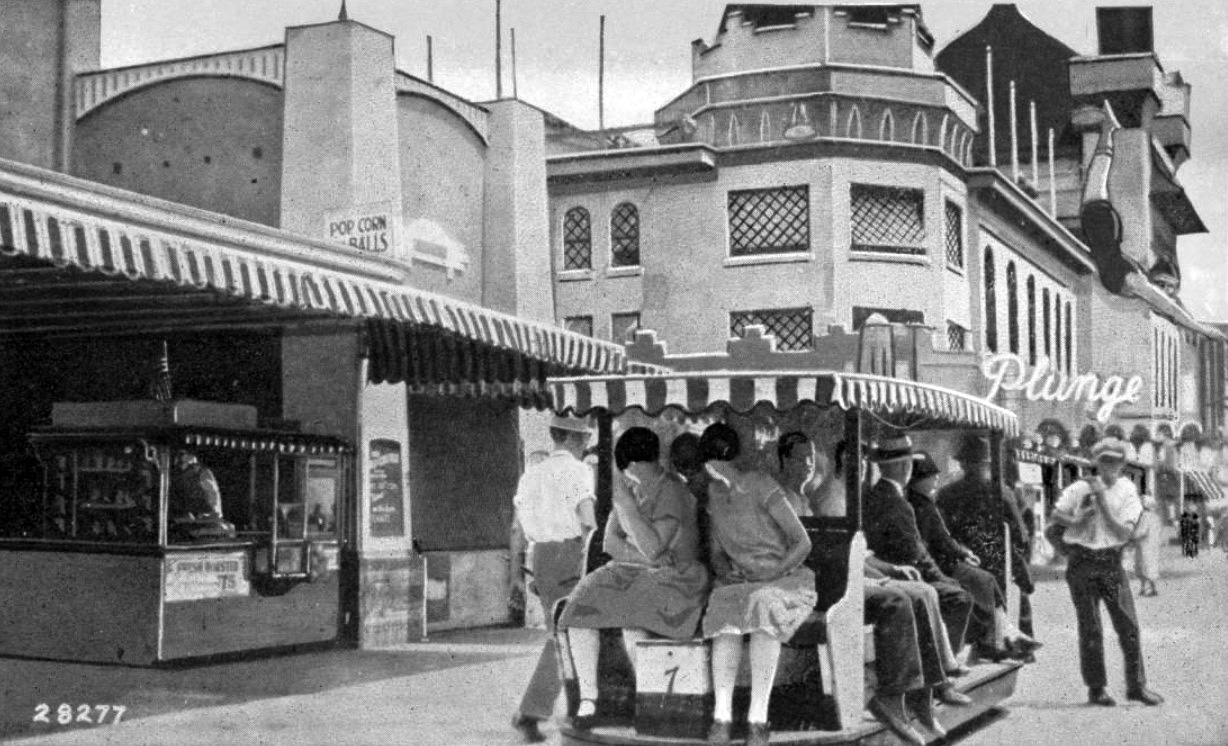 |
|
| (1930s)* - Postcard of a tram running between Venice, Ocean Park, and Santa Monica. The Ocean Park Plunge can be seen in the background. |
Historical Notes By the 1930s, the trams had 4 cylinder, Ford model A engines and canopy tops. There were also similar 4 cylinder, Chevy engines. The seats faced toward the ocean or shops plus it had a back seat. |
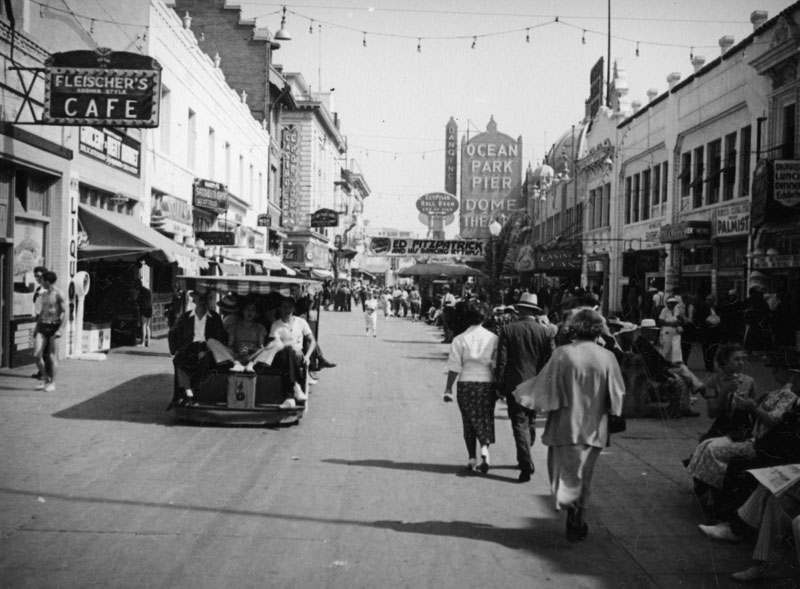 |
|
| (1920s)* - Crowds of people and an electric tram are seen in the fun section of the pier. A large sign hangs at far end of the street announcing Ed Fitzpatrick and his Dancing Rhythms. Also seen are signs for Feisher's Cafe (left) and the Dome Theatre (far back on the right). An electric tram can be seen transporting a full load of passengers down the walkway. |
* * * * * |
1st Dome Theatre
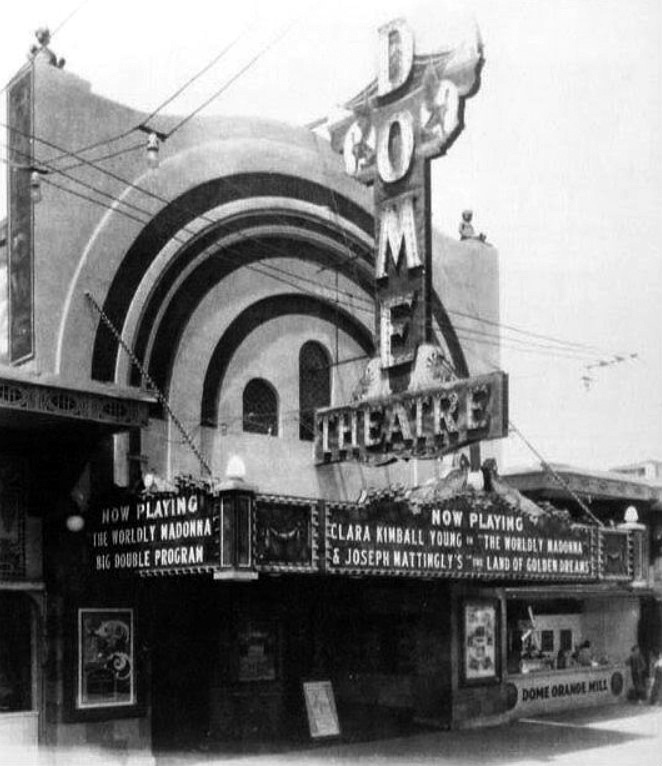 |
|
| (ca. 1922)^ – View showing the original Dome Theatre located on Ocean Front Walk in Venice. |
Historical Notes The first Dome Theatre was originally a dance hall that had opened on July 4, 1916. The building was constructed on the Great Western pier at Ocean Front Walk. The location at the northwest corner of Ocean Front Walk and Navy Ave. is just south of the Santa Monica city limits. In the 1923-24 directory it's listed as 3034 Ocean Front Promenade, Venice. The main space was a 100 foot concrete dome. It was converted into a theatre in 1922 when the Lick Pier was constructed. The Lick Pier was constructed seaward of the dance hall, just south of the Fraser/Pickering Pier (aka Ocean Park Pier) that was the original location of the Rosemary Theatre. |
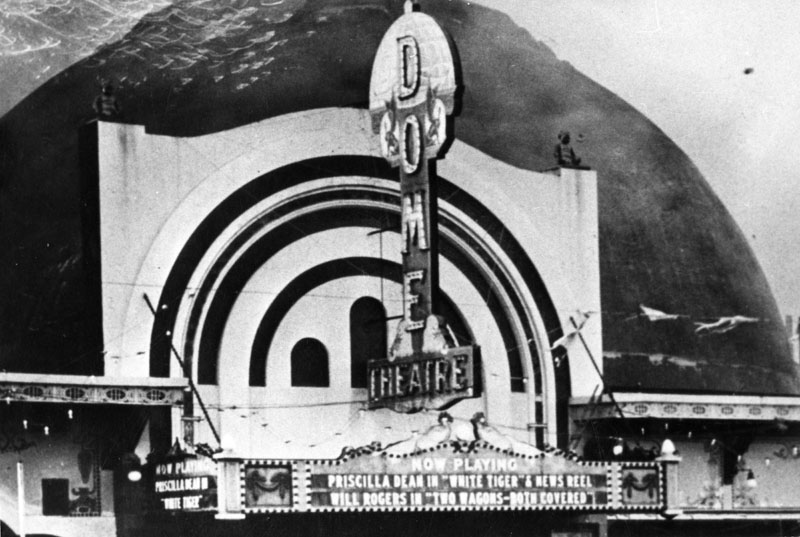 |
|
| (1923)* - View showing the marquee and dome of the first Dome Theatre. The show playing is Priscilla Dean in "White Tiger." The theater burned down in 1924, but was rebuilt a year later. |
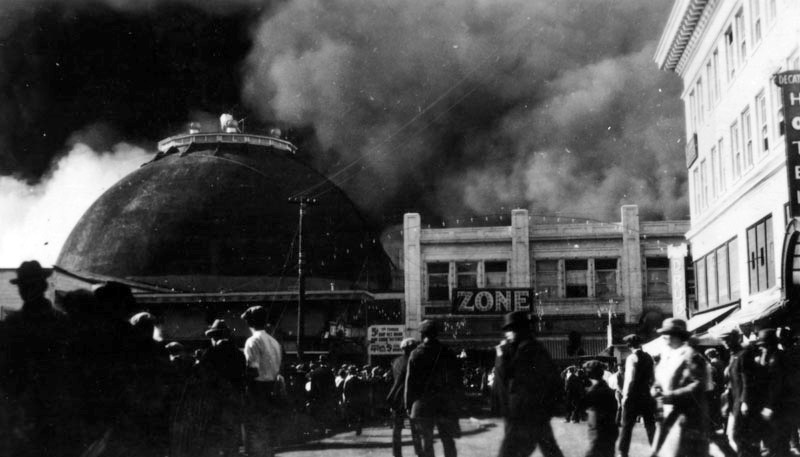 |
|
| (1924)^ – View of the first Dome Theatre burning. |
Historical Notes Demolished after a fire on January 6, 1924. The building was a total loss except for the entrance portion of the structure. This was used with a new building behind and became the new Rosemary Theatre. In addition to the Dome Theatre, the fire consumed the adjacent Ocean Park and Lick Piers. |
2nd Dome Theatre and Entrance to Ocean Park Pier
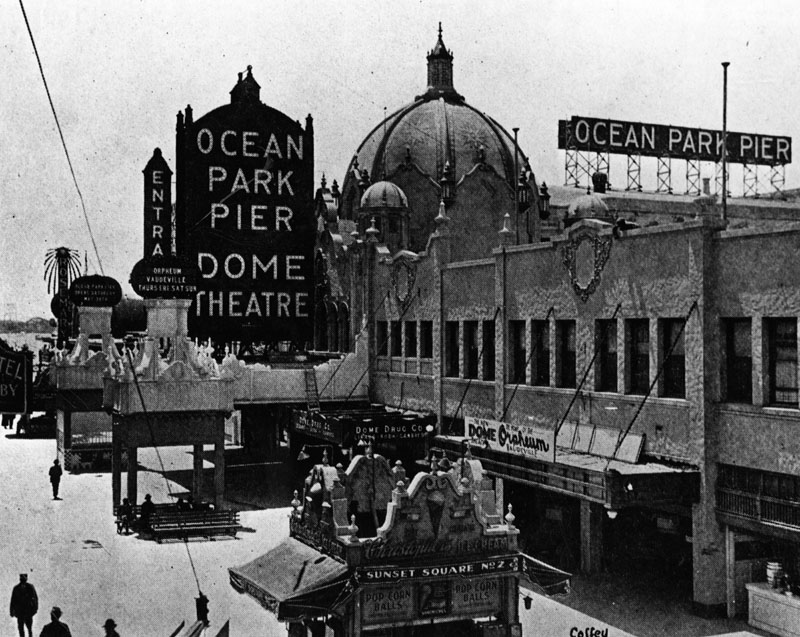 |
|
| (1925)* - View showing the newly completed 2nd Dome Theatre with signage advertising Orpheum Vaudeville on the Weekends. The big dome straddled the entrance to the pier and was not part of the theatre itself. |
Historical Notes West Coast Theatres and the Venice Investment Co. acquired the assets of the Pickering and Lick Pier Pier operating company two weeks after the 1924 fire. After difficult negotiations with the city of Santa Monica, they rebuilt the pier including a new Dome Theatre. The new Dome Theatre was just a few doors north of the original location. |
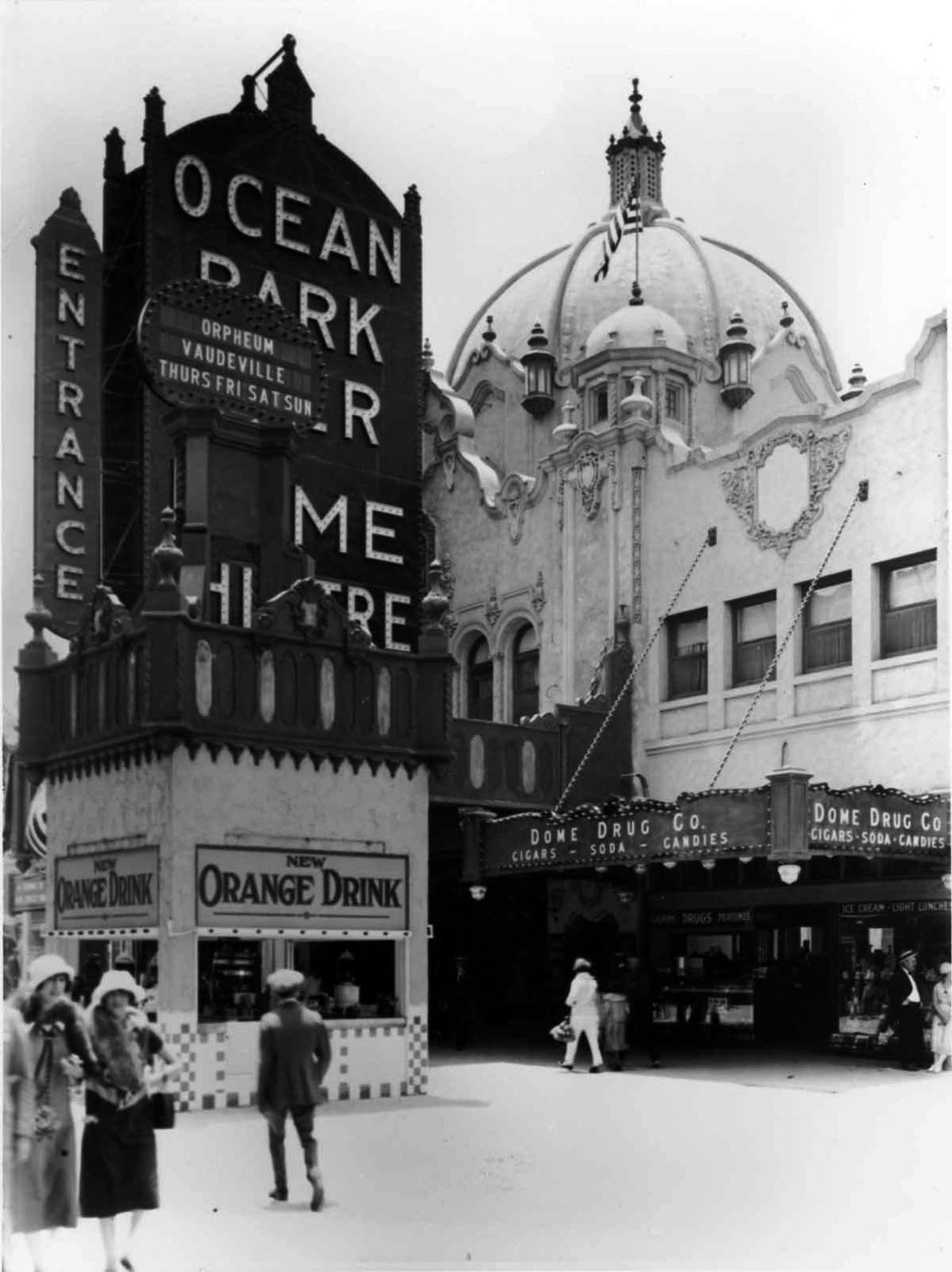 |
|
| (ca. 1925)* - Close-up view showing the newly constructed 2nd Dome with the Dome Theatre to the left out of view. Also seen here is the Dome Drug Co. store. |
Historical Notes Note that the prominent decorative dome in the new construction is not the theatre, but the entrance to Ocean Park Pier. The theatre itself was just to the south of the dome. |
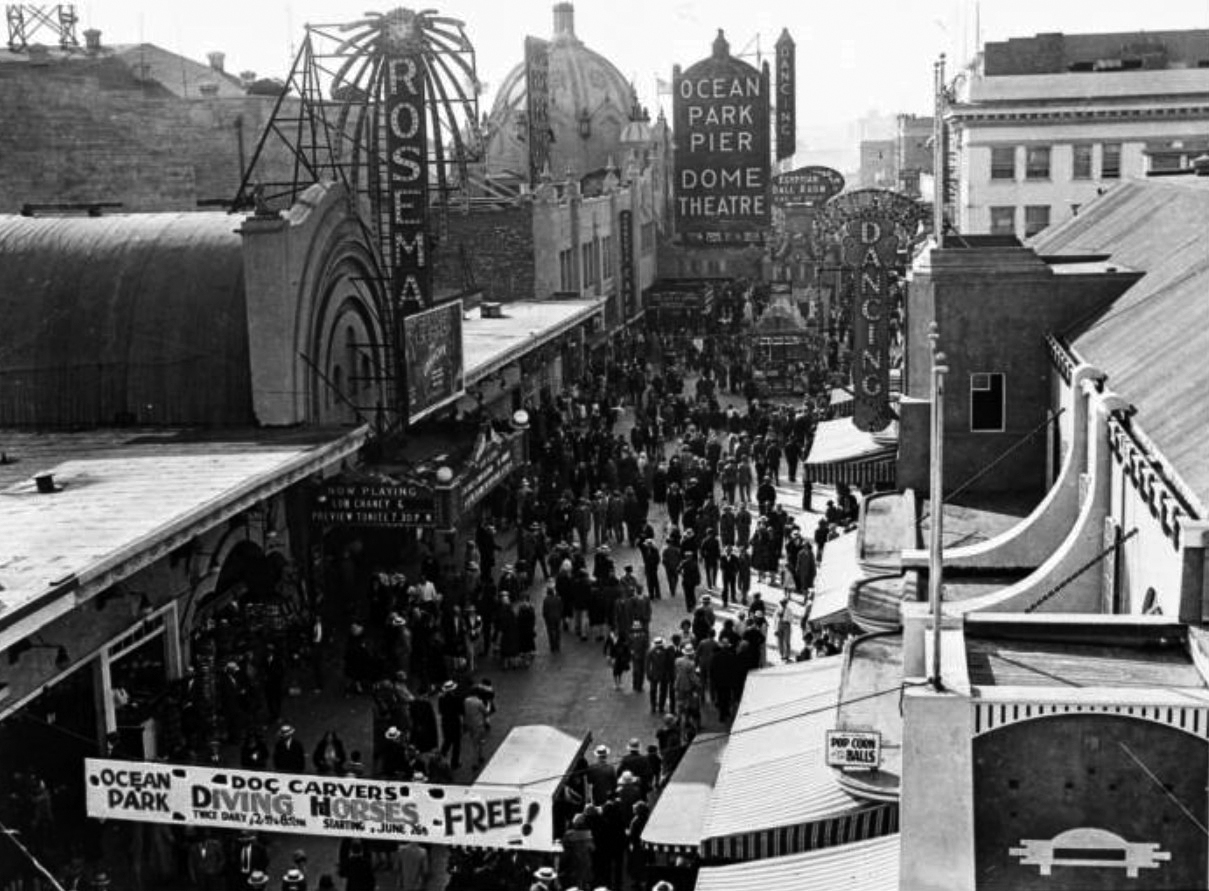 |
|
| (1927)^ - Image of a crowd of people on the Ocean Front Walk next to the Ocean Park Pier in Santa Monica, California. There is a banner in the foreground for "Ocean Park Doc Carvers Diving Horses- Free staritng June 26" and the marquee on the Rosemary Theater at left reads "Now playing Lon Chaney & Preview Tonite" with a poster for the movie "The Unknown." Additional signs include "Dancing", "Ocean Park Pier Dome Theatre", and "Egyptian Ball Room." |
Historical Notes The Dome's place in history is assured as it is the theatre where the Mickey Mouse Club fad began there in 1929. It was part of a matinee promotion by manager Harry Woodin. |
 |
|
| (ca. 1925)^ – Policemen walk the beat on Ocean Front Walk with the Ocean Park pier entrance and Dome Theatre in the background. Further in the distance can be seen the Ocean Park Bath House with its Moorish-style domes. |
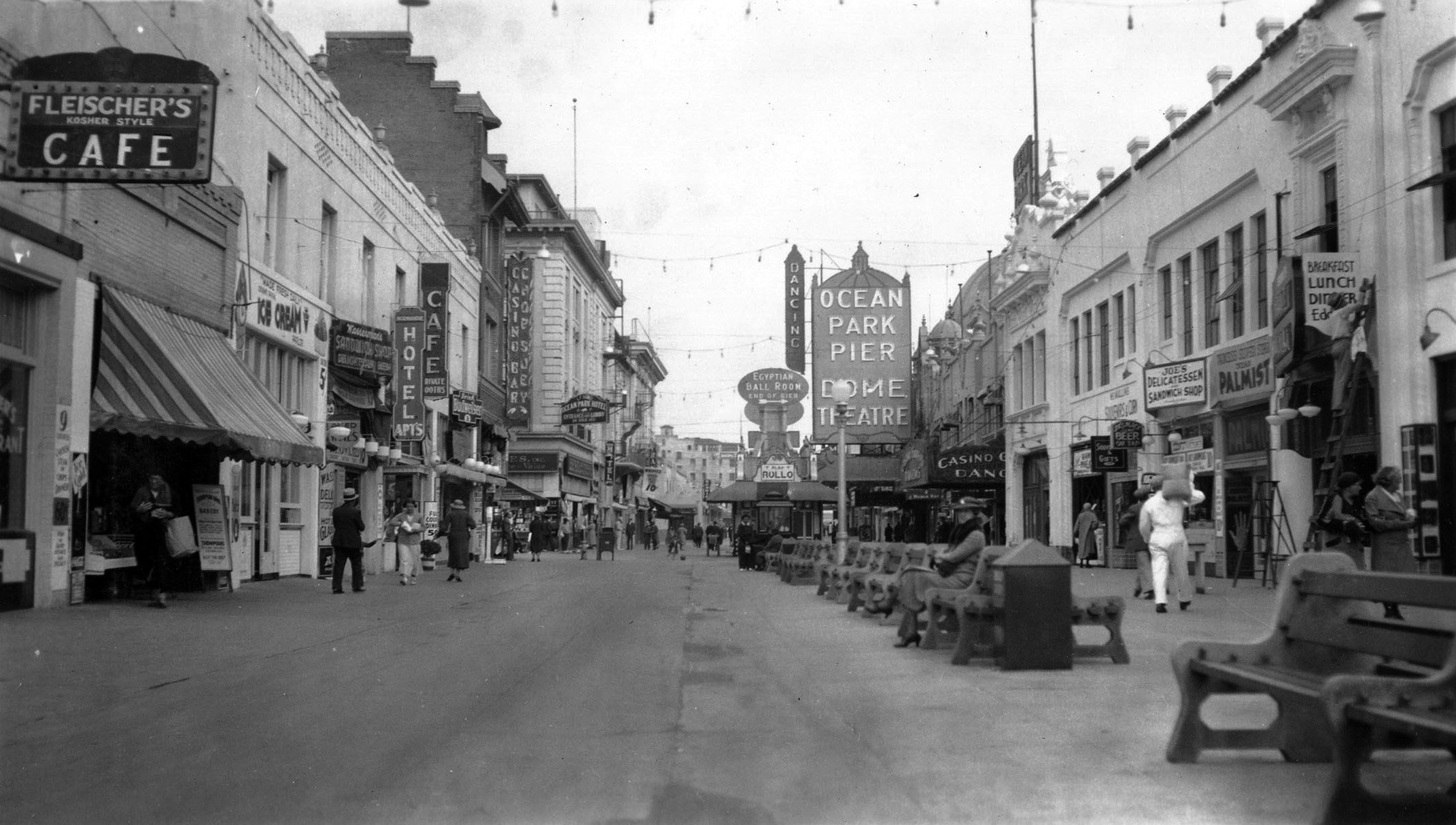 |
|
| (ca. 1935)* – Photo titled Ocean Park Pier amusement zone in Santa Monica, with the Dome Theatre seen in the background. William M. McCarthy Photograph Collection |
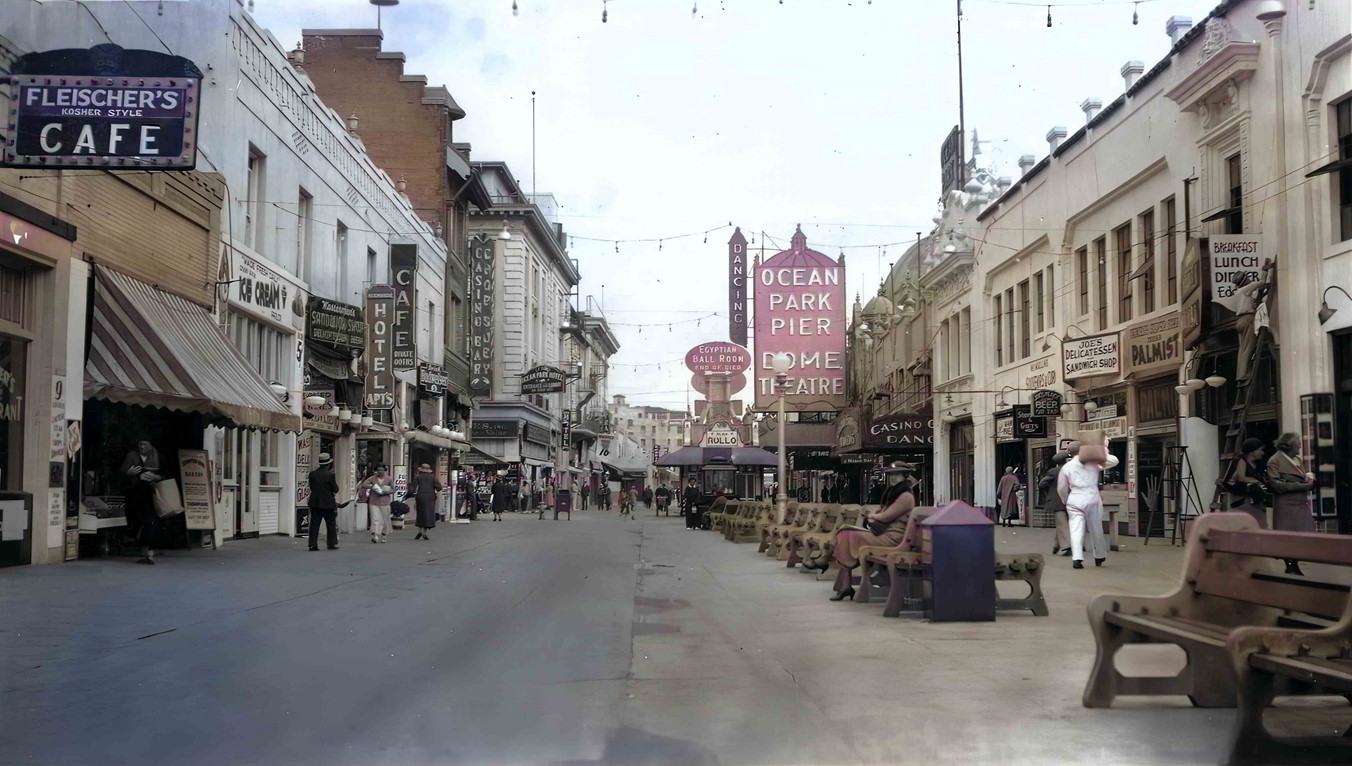 |
|
| (ca. 1935)* – Looking down Ocean Front Walk with the Ocean Park pier entrance and Dome Theatre in the background. Fleischer’s Kosher Style Café is seen on the left. Photo credits: California State Archives, William M. McCarthy Photograph Collection; AI image enhancement and colorization by Richard Holoff |
Piers of Santa Monica Bay (1920s - 1930s)
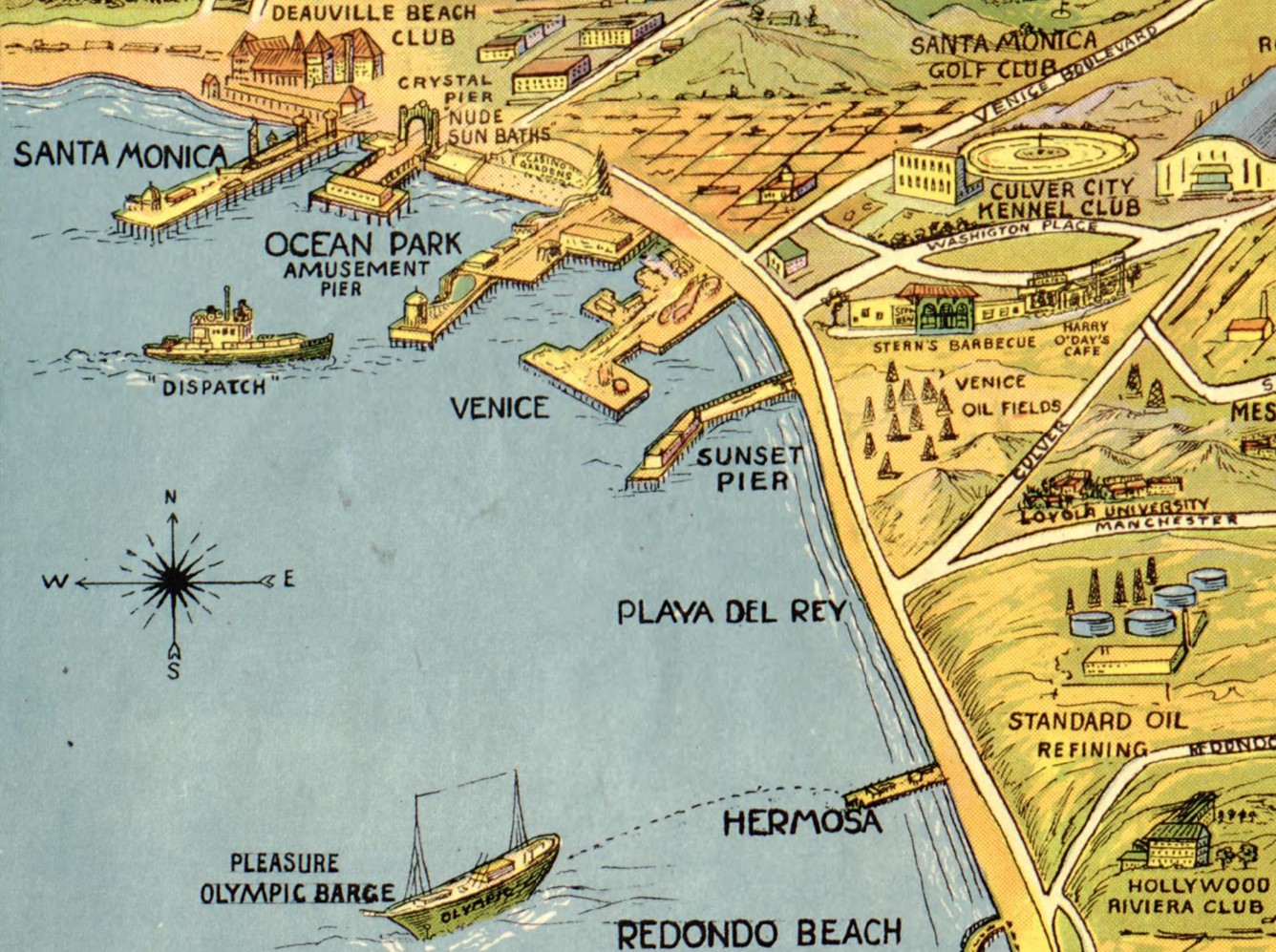 |
|
| (1932)* - Map showing the Piers of Santa Monica Bay. Note: Manhattan Beach Pier is not shown for some unknown reason (It existed in 1932). |
Historical Notes In the 1920s and 1930s, Santa Monica Bay was lined with numerous piers due to the area's booming tourism, vibrant recreational activities, and strategic importance for transportation and commerce. The piers served as hubs for economic growth, attracting visitors with entertainment, dining, and amusement parks. Additionally, they enhanced real estate development by making coastal properties more attractive and served as key social and community gathering spots. |
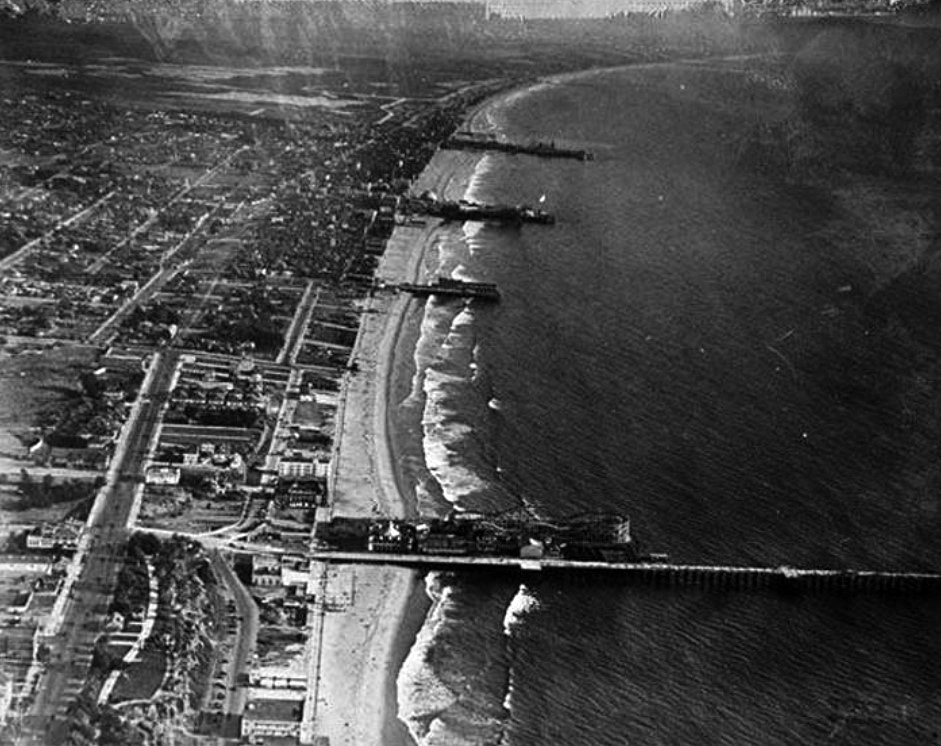 |
|
| (1919)* – Aerial view looking south showing four Santa Monica Bay piers (bottom to top): Santa Monica Pier, Crystal Pier, Ocean Park Pier and Venice PIer. |
Historical Notes Amusement piers became enormously popular in the first decades of the 20th century. The extensive Pacific Electric Railroad easily transported to the beaches people from across the Greater Los Angeles Area. Competing pier owners commissioned ever larger roller coaster rides. Wooden piers turned out to be readily flammable, but even destroyed piers were soon replaced. There were five piers in Santa Monica alone, with several more down the coast. |
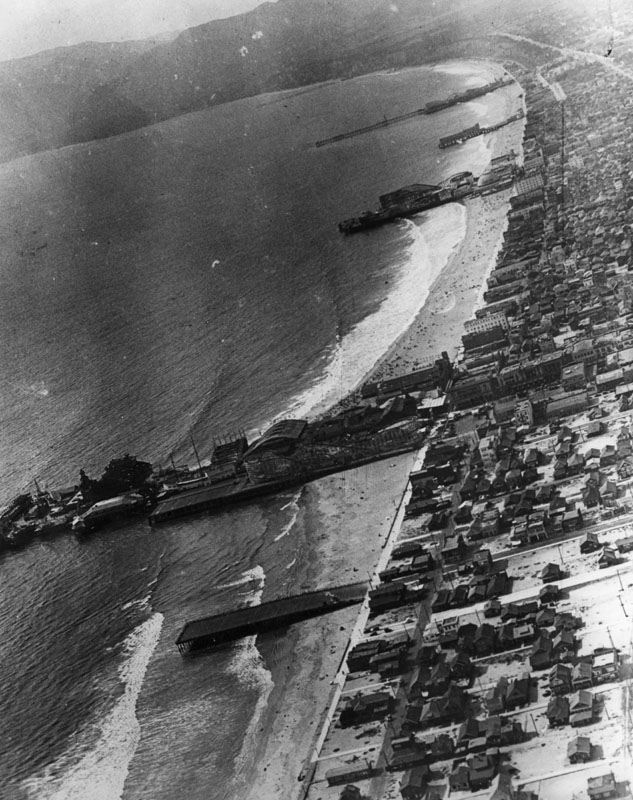 |
||
| (1920s)* - Aerial view looking north all along the coast of Venice and the whole Santa Monica Bay area. At least 6 or 7 piers can be seen extending out into the ocean. Venice Pier and amusement park can be seen in the foreground. Ocean Park Pier, with its own amusement park, is the next pier over. Beyond that, the long pier at the top of the photo, is the Santa Monica Pier. It also had an amusement park. |
Historical Notes The Venice, Ocean Park and Santa Monica amusement piers were within a mile and one half of each other and they competed directly with each other for the tourist's entertainment dollars. Fourteen coasters were built there from 1904 to 1925. |
 |
|
| (1920)* - Aerial view of Ocean Park Pier showing it's large roller coster. The long pier to the north (top of photo) is the Santa Monica Pier. It too had its own amusement park starting in 1916. In between the two longer piers is the shorter Crystal Pier (originally White Star Pier then Bristol Pier). |
Historical Notes The piers were primarily built to attract tourists and locals with entertainment options such as amusement parks, arcades, dining establishments, dance halls, and fishing spots. Popular piers like the Santa Monica Pier featured carousels, roller coasters, and other attractions that made them major recreational destinations. |
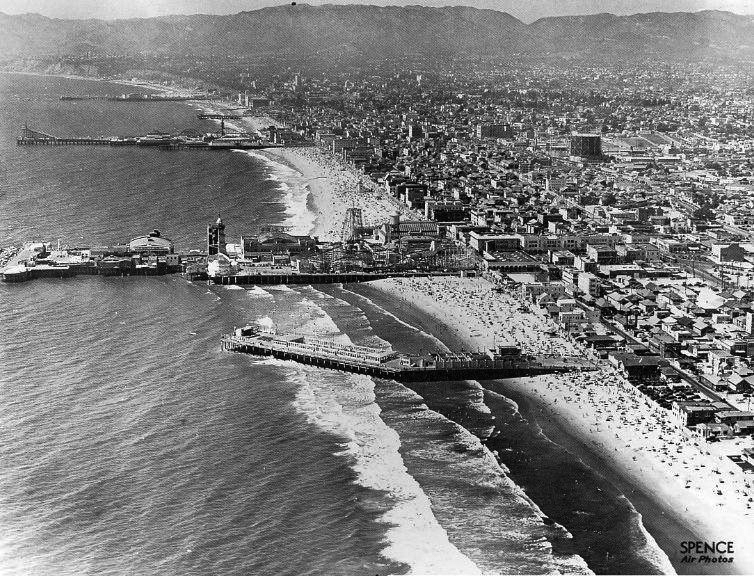 |
|
| (ca. 1930s)* – Aerial view showing the pleasure piers of Venice and Santa Monica. From bottom to top: Sunset Pier, Venice PIer, Ocean Park Pier, Crystal Pier, Santa Monica Pier…all that remains are the rocks of the breakwater behind the Venice Pier and the Santa Monica Pier. Photo taken by Spence Air Photos |
Historical Notes With the rise of Southern California as a tourist hotspot, the piers played a significant role in drawing visitors to the coast. They were designed to enhance the tourist experience by providing leisure activities and scenic views of the ocean. *Spence Air Photos was a one-man company ~ photographer, "Robert Earl Spence". He began shooting aerials in 1918. In the 1920s he had numerous clients hiring him to shoot homes and businesses. Spence would shoot images at an angle, not straight down, showing many additional building details. Spence was not a pilot, he hired an airplane pilot to fly him overhead while he leaned out from the cockpit with a bulky camera to get angled shots of the landscape. His method captured the details of the homes and their surroundings all the way to the horizon. He continued to photograph homes for 50 years. In 1971, Spence retired and donated his collection of 110,000 negatives to the University of California Geography Department. He passed away in 1974. At UCLA, the Spence Collection is part of The Benjamin and Gladys Thomas Air Photo Archives. |
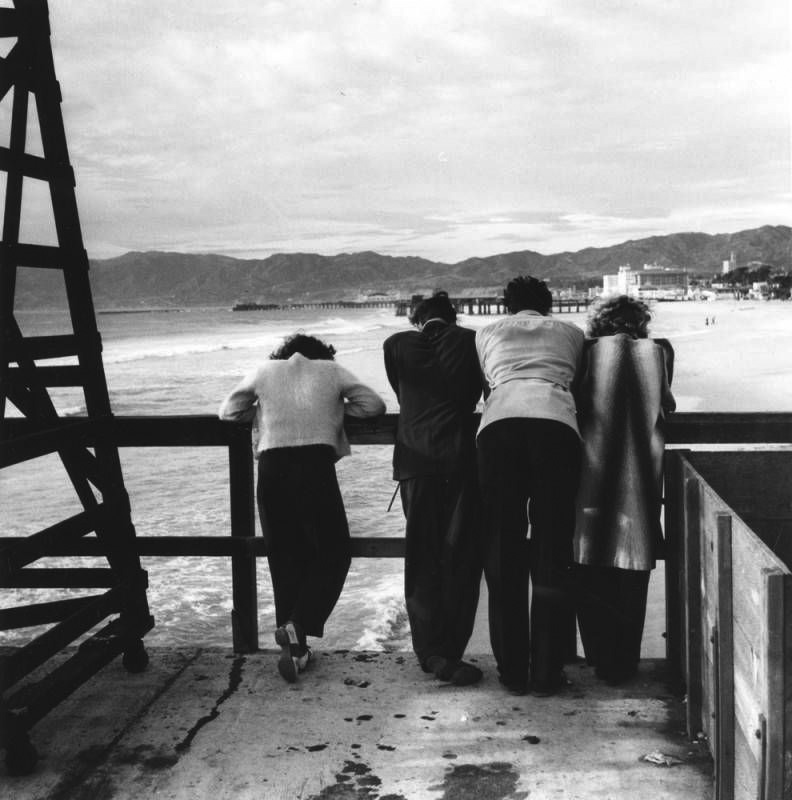 |
|
| (ca. 1940)* - Four people are seen on Ocean Park Pier, looking north towards the heart of Santa Monica and both Crystal Pier and Santa Monica Pier. Photo by Ansel Adams. |
* * * * * |
Venice Pier
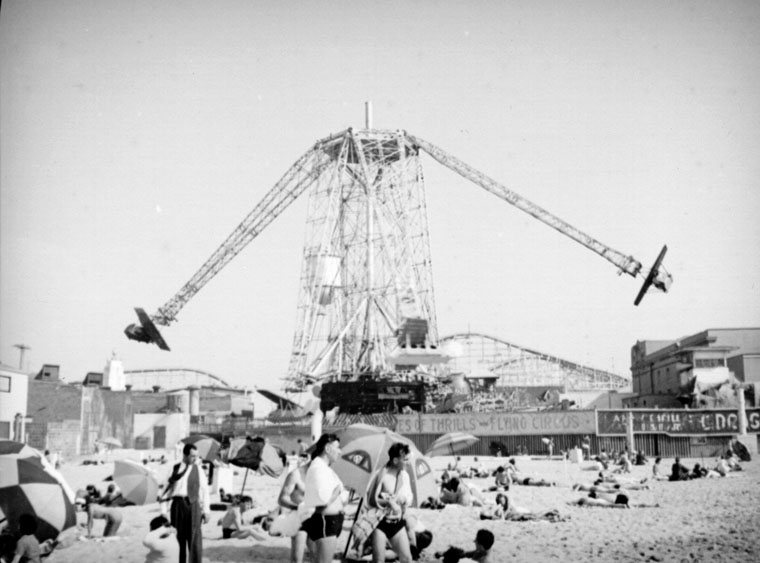 |
|
| (ca. 1925)* - Two airplanes rotating around the center tower on the Venice amusement park ride are visible. This ride, called the Flying Circus has 6 to 8 passenger cars circling the main tower 65 feet above the peer. Seen here from the sandy beach in the foreground. |
Historical Notes Click HERE to see more Early Views of Venice Amusement Pier. |
Ocean Park Pier
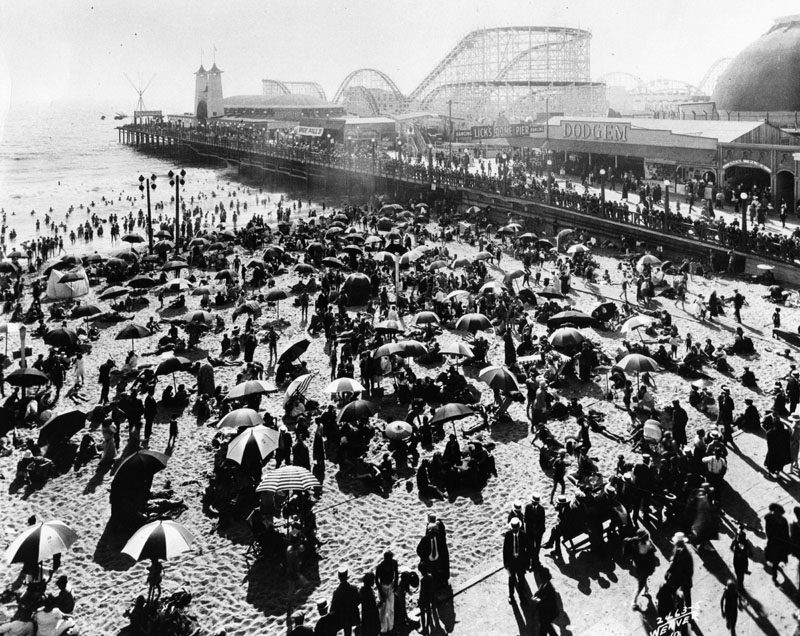 |
|
| (ca. 1920)* - Crowds enjoying a sunny day at the beach alongside Ocean Park Pier. The amusement park can be seen on the pier. |
Historical Notes The original Million Dollar Pier opened in 1911 but burned down just 15 months later in September 1912. It was quickly rebuilt and reopened as the Ocean Park Pier on May 30, 1913, becoming a popular regional attraction. In 1924, another devastating fire destroyed the pier, prompting new owners to rebuild it entirely out of reinforced concrete and steel as a fireproof structure. In 1925 Ocean Park Pier reopened. The new 960-foot long, 275-foot wide concrete Ocean Park Pier celebrated its grand opening on August 29, 1925 with a 10-day festival attended by 100,000 people on opening day. |
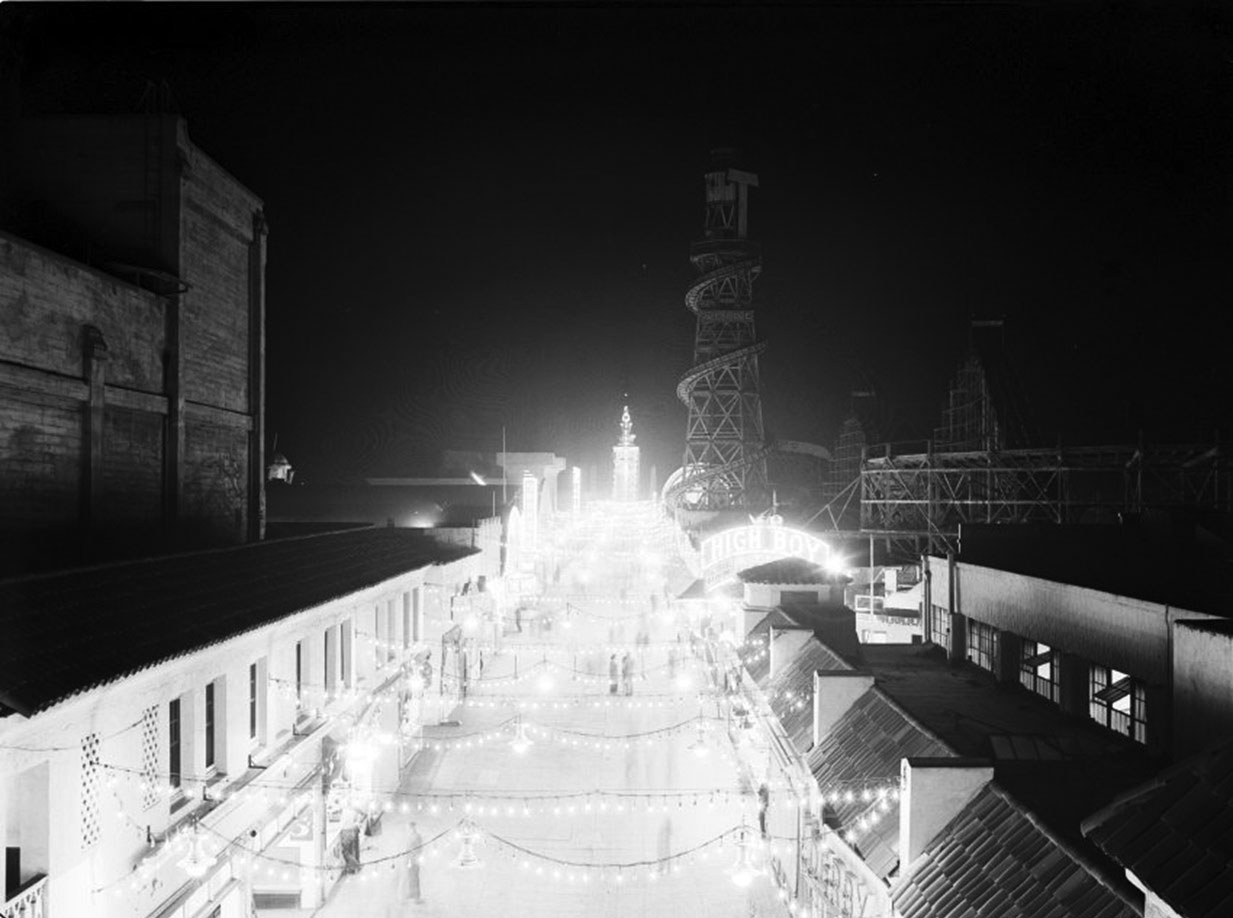 |
|
| (1924)* - Ocean Park Pier at night. |
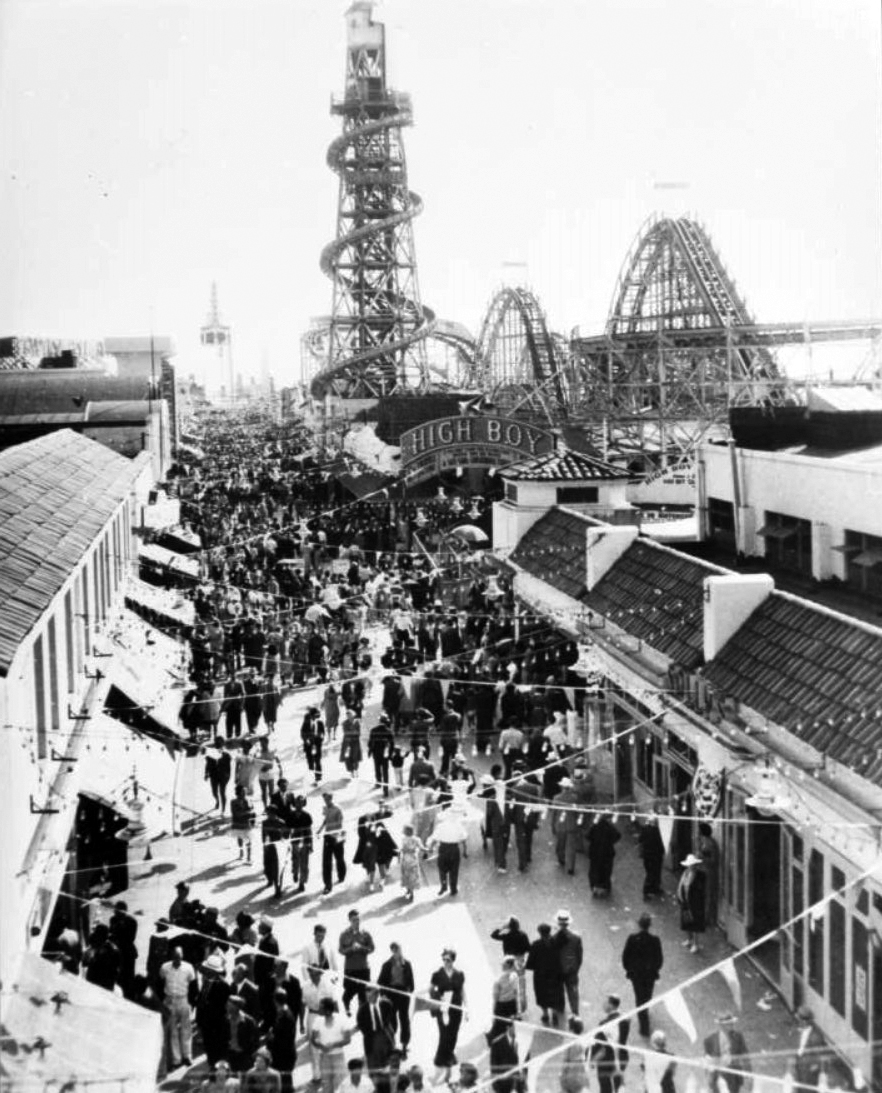 |
|
| (1929)* – View showing the Lighthouse Slide, High Boy roller coaster and Chute the chutes ride on the Ocean Park Pier at Ocean Park in Santa Monica. |
Historical Notes Click HERE to see more Early Views of Ocean Park and Other Santa Monica Amusement Parks. |
* * * * * |
Please Support Our CauseWater and Power Associates, Inc. is a non-profit, public service organization dedicated to preserving historical records and photos. Your generosity allows us to continue to disseminate knowledge of the rich and diverse multicultural history of the greater Los Angeles area; to serve as a resource of historical information; and to assist in the preservation of the city's historic records.
|
More Historical Early Views
Newest Additions
Early LA Buildings and City Views
History of Water and Electricity in Los Angeles
* * * * * |
References and Credits
* LA Public Library Image Archive
^^The California History Room, California State Library
^*LMU Digital Collection: Arcadia Hotel
#^ Santa Monica Public Library Image Archive
+# Santa Monica Mirror: Statue of Santa Monica
+^ Santa Monica Landmarks: Looff Hippodrome
## Library of Congress: Santa Monica Bay ca. 1908; Ferris Wheel
***Cinema Treasures: El Miro Theatre; Criterion Theatre and Thrid Street; Criterion Theatre
^x^Facebook.com: Venice, Ca, Ocean Park, & Santa Monica in the 20th Century
**^Noirish Los Angeles - forum.skyscraperpage.com; Deauville Club; Palisades Park Cannon
^^*Deviantart-Studio5: Santa Monica Beach
^^#University of California Digital Library: The Deauville Club
^^+Stanford University Revs Digital Library
*^#Nuestra Señora la Reina de los Ángeles: losangelespast.com
*#*KCET: A Historical Look at SoCal's Beaches
*#^Santa Monica Public Library
^#*Santa Monica History Museum
^#^Framework.latimes.com: Santa Monica Beach, 1936; Santa Monica Aerial, 1937; McClure Tunnel
^##The Malibu Times: Historic Las Flores Canyon
+##Facebook.com: Vintage Los Angeles
*#*KCET: A Historical Look at SoCal's Beaches; Arch Rock and Castle Rocks; When L.A.'s Most Famous Streets Were Dirt Roads
**#The Central Tower Building - City Landmark Assessment and Evaluation Report
#**MTA Transportation and Research Library Archives
#^^Huntington Digital Library Archive
#*^Electric Railway History: Venice Trams
#+#Facebook.com: Photos of Los Angeles
^^^California State Library Image Archive
****Life.time.com: Stoked-Life Goes Surfing
^^^^Pinterest/Santa Monica Past: Santa Monica Canyon Flood; Santa Monica Airport/Clover Field; Douglas Aircraft
*^*^Santa Monica Beach Stories
^**^California Legends: Santa Monica at the End of Route 66
*^^*Discoverlosangeles.com: Santa Monica
*^^^NonPhotography.com-Nika: Santa Monica Pier
***^History of the Fairmont Miramar Hotel and Bungalows
^***Southern California Beaches: Santa Monica Beach
**#*Santa Monica via Beverly Hills Line - uncanny.net
*#**Los Angeles Westerners Corral: Venice Miniature Railway
*##*AkamaIdivers.com: Pacific Ocean Pier
*##^Santa Monica Conservancy; Henshey’s Tegner Building
*#*#Los Angeles Then and Now: Douglas' Dream Took Wing in Santa Monica
*#^#Flickr.com: Walking Over Santa Monica
^#*#Venice History: Roller Coasters and Carousels
^^*#Oceanpark.wordpress.com: Ocean Park Time Line
*^*#Santa Monica Municipal Airport
*^^#LAistory: The Santa Monica Pier
#*^*Cardcow.com: Marion Davies' Mansion
#***California 2012 - Travel w/ Terry: Annenberg Beach House
#*#*Flickr.com: Michael Ryerson
#^#*Denver Public Library Image Archive
#^^^Survey LA: Brentwod-Pacific Palisades Community Plan Area
#^*^Santa Monica Landmark Properties
#^^*Pinterest.com: Old Hollywood
#^#^Paslisades Park: smgov.net
##*^Facebook.com: Hollywood's Garden of Allah Novels, Martin Turnbull
##^^MartinTurnbull.com: Gables Beach Club
****^Facebook.com: West San Fernando Valley Then And Now
^*^*^Wehadfacesthen.tumblr.com
*^*^*SantaMonicaPier.com
*#*#*Venice Miniature Railroad - Jeffrey Stanton
*^ Wikipedia: California State Route 1; History of Santa Monica; Alphonzo Bell; Venice; California Incline; Route 66; Third Street Pomenade; Santa Monica Pier; Casa del Mar Hotel; Pacific Palisades - Castellammare; Parkhurst Building; Venice Canal HIstoric District; Annenberg Community Beach House; Santa Monica High School; Jack Dempsey; Muscle Beach; Wilshire Boulevard
< Back
Menu
- Home
- Mission
- Museum
- Major Efforts
- Recent Newsletters
- Historical Op Ed Pieces
- Board Officers and Directors
- Mulholland/McCarthy Service Awards
- Positions on Owens Valley and the City of Los Angeles Issues
- Legislative Positions on
Water Issues
- Legislative Positions on
Energy Issues
- Membership
- Contact Us
- Search Index